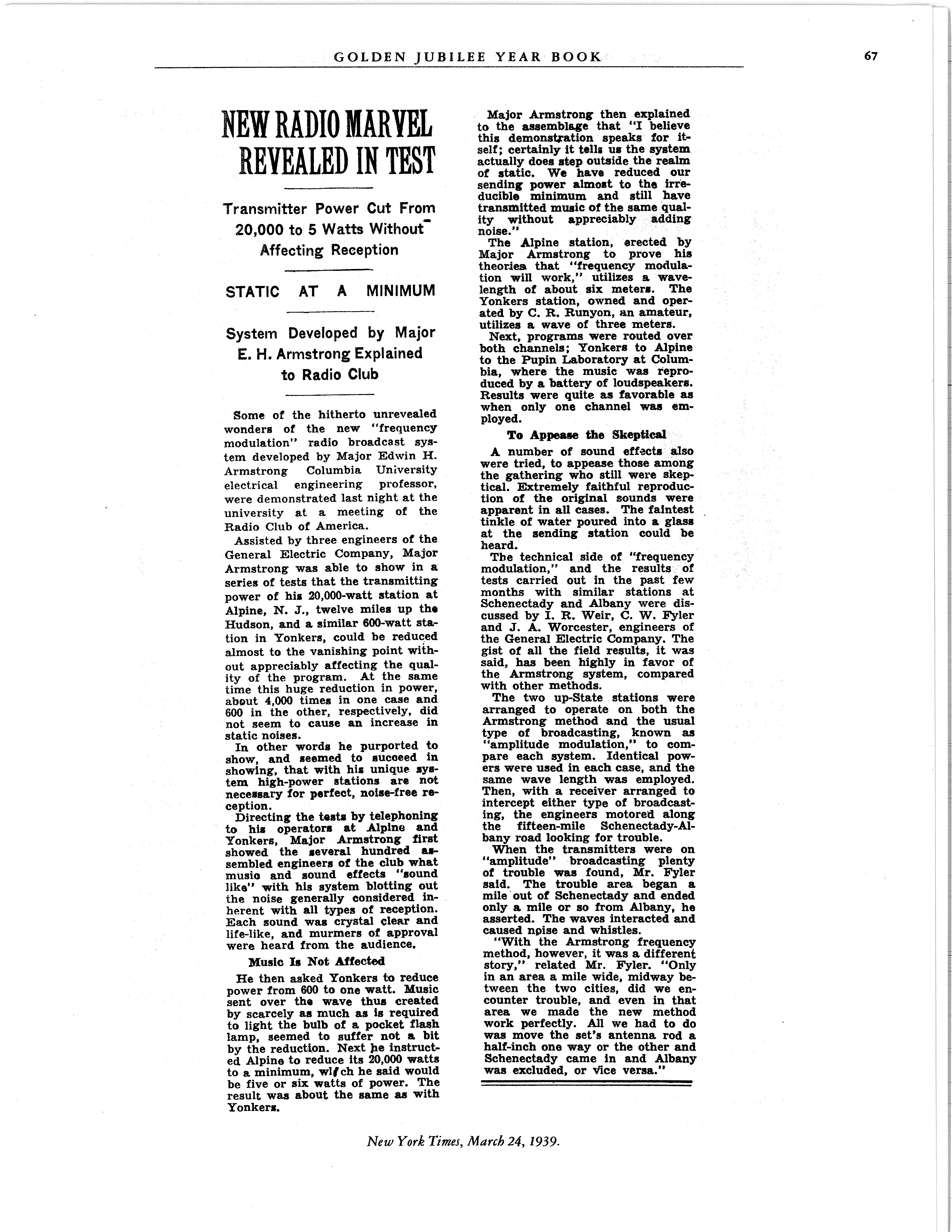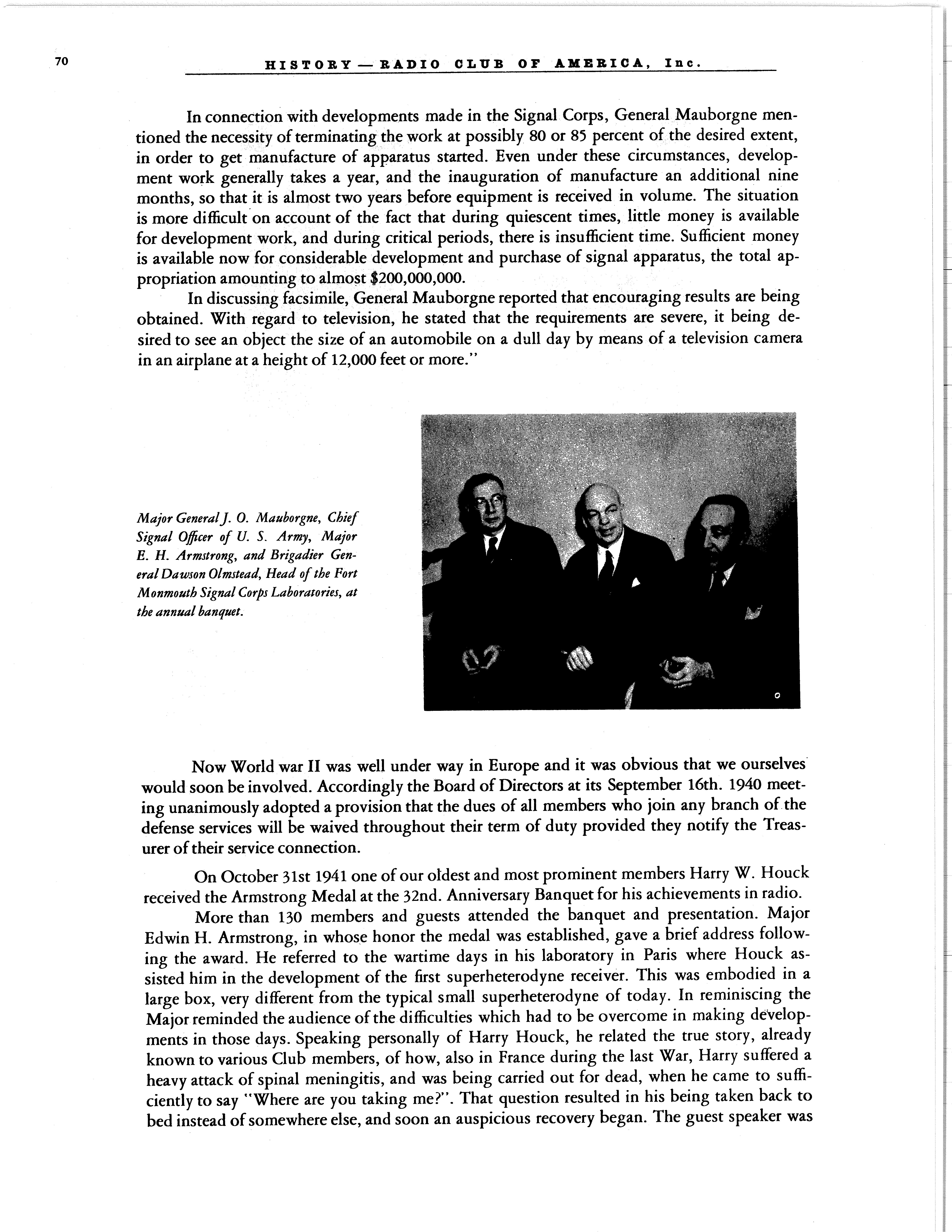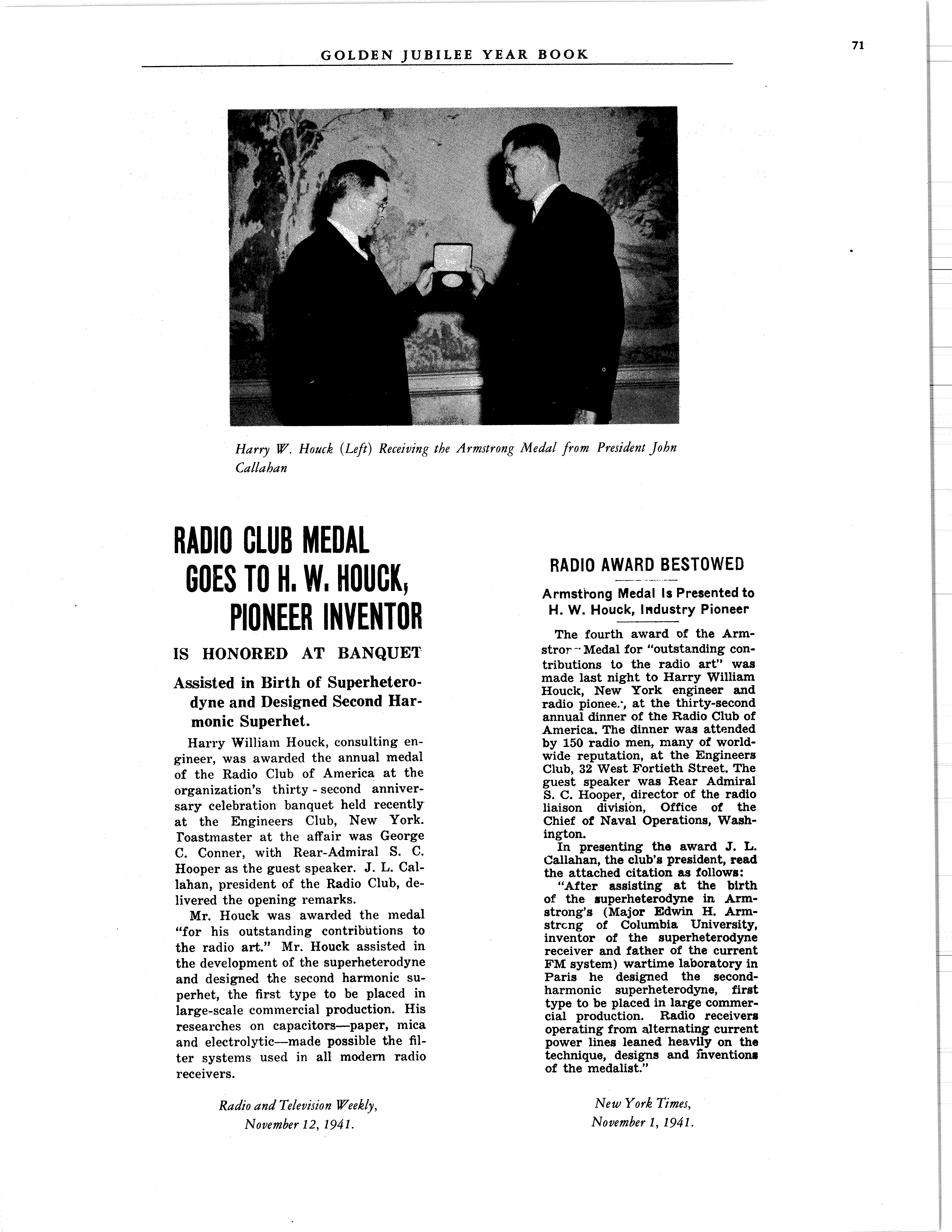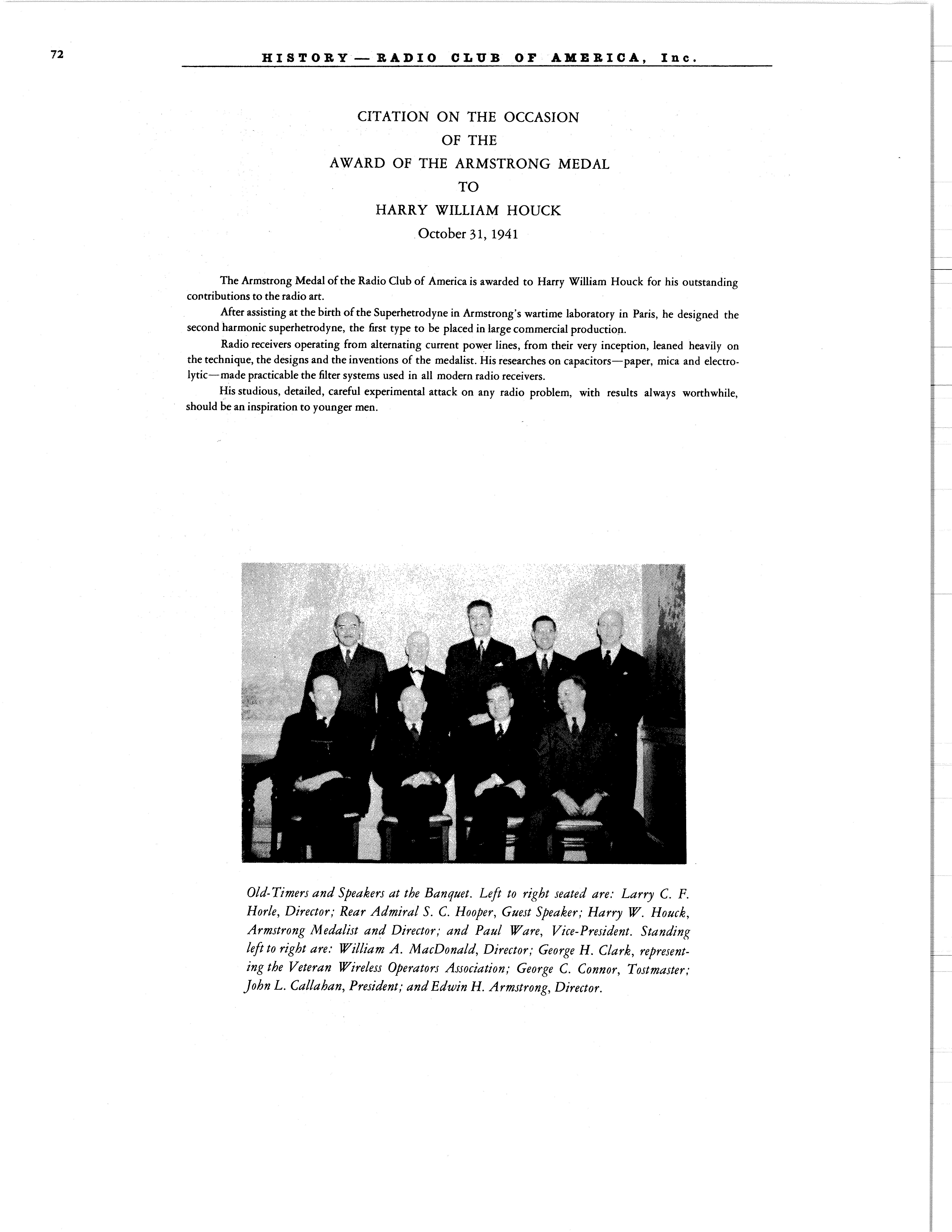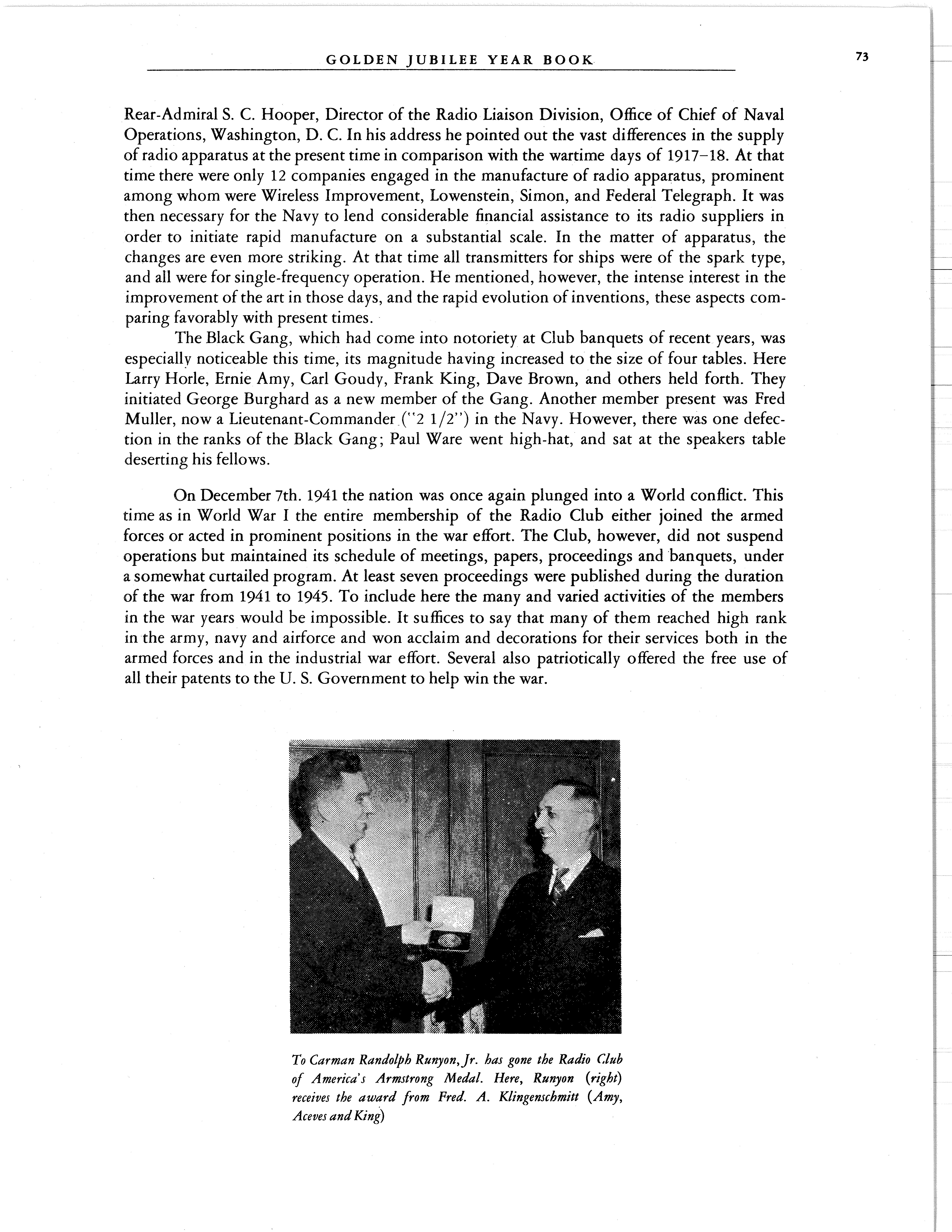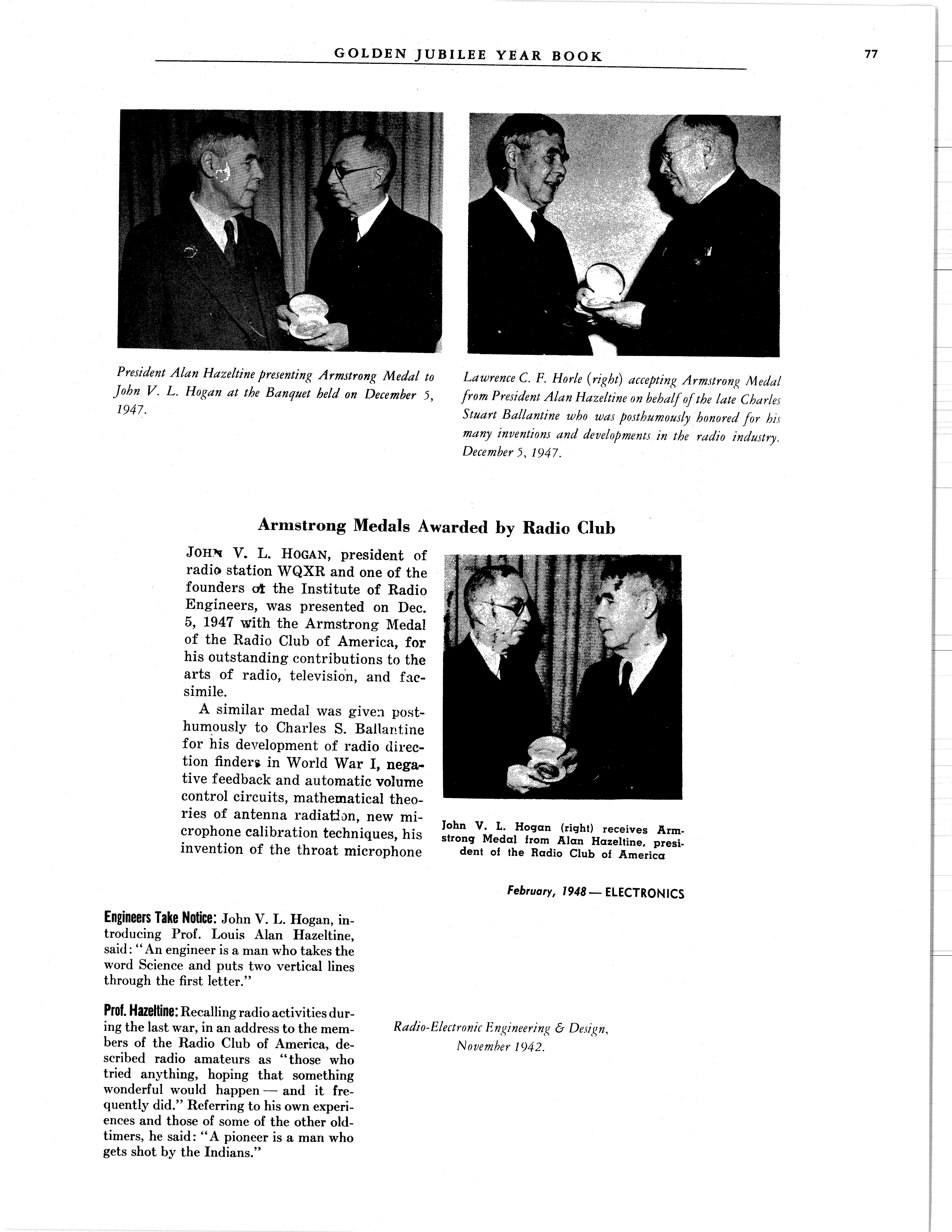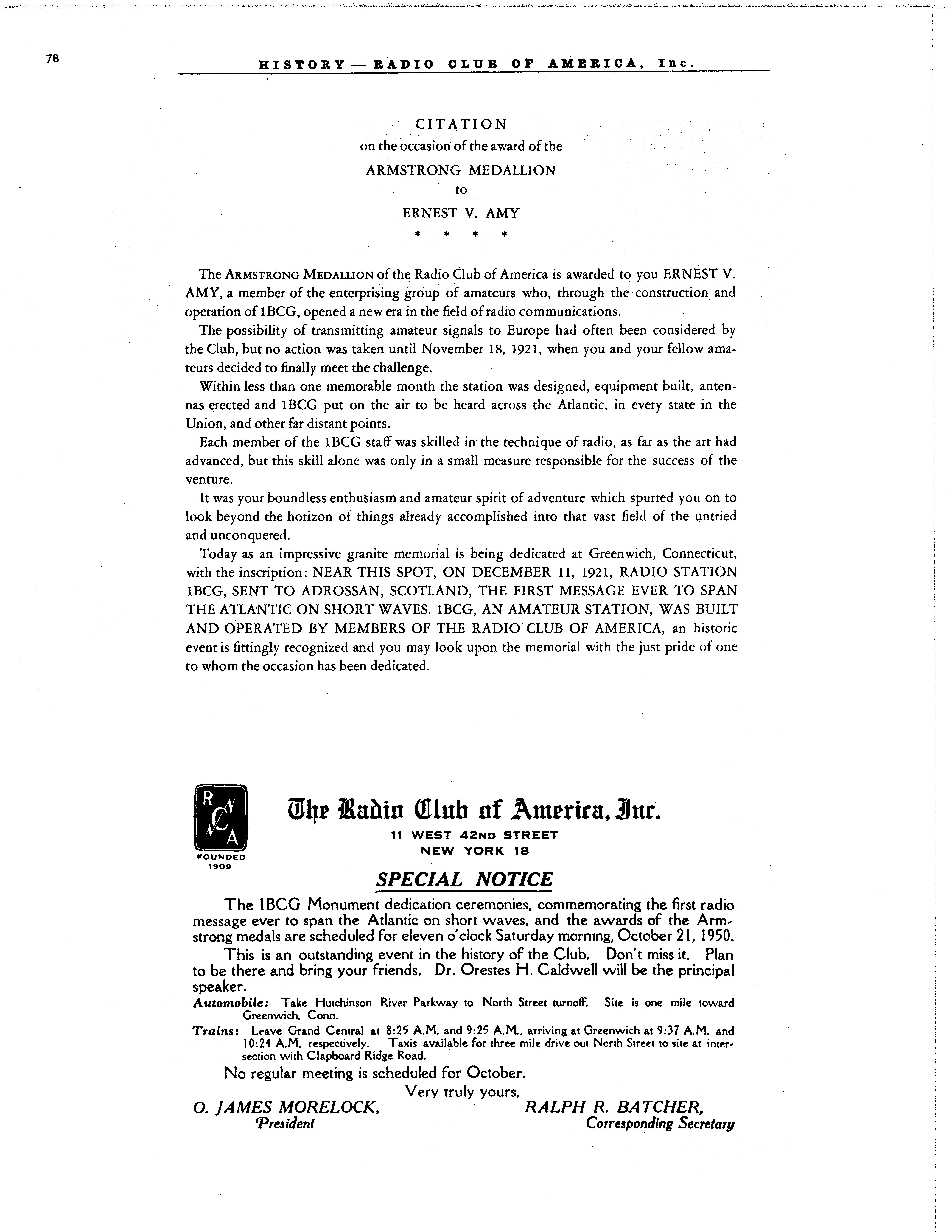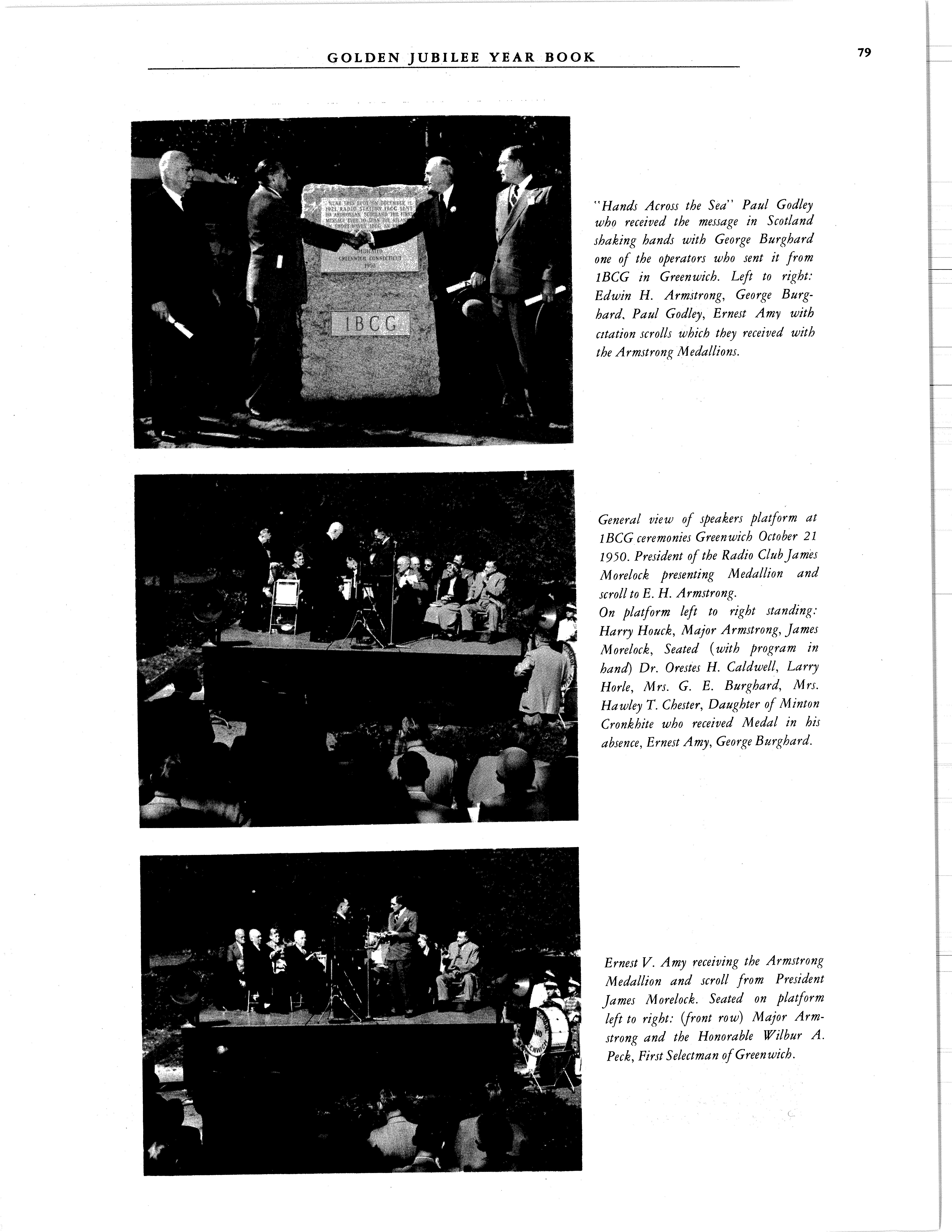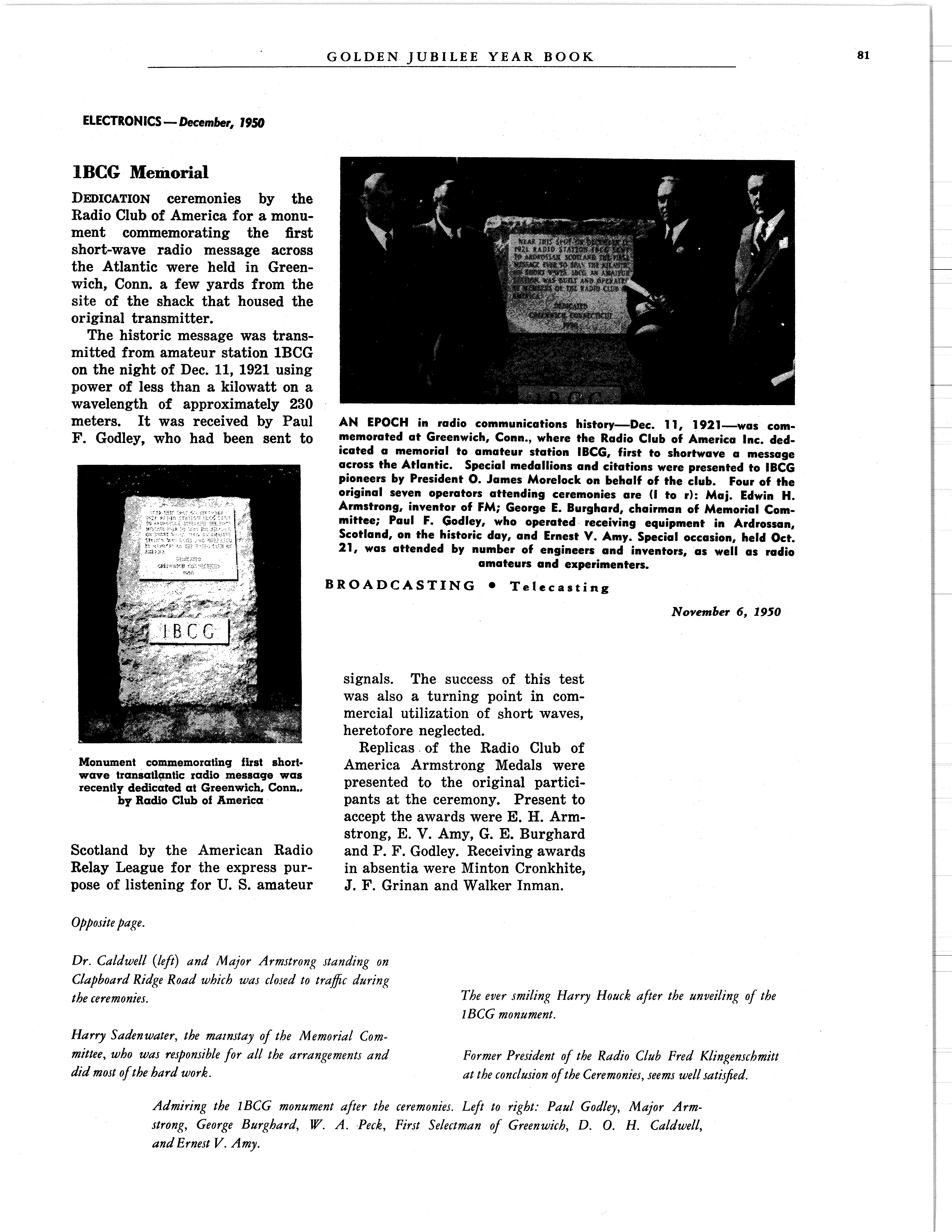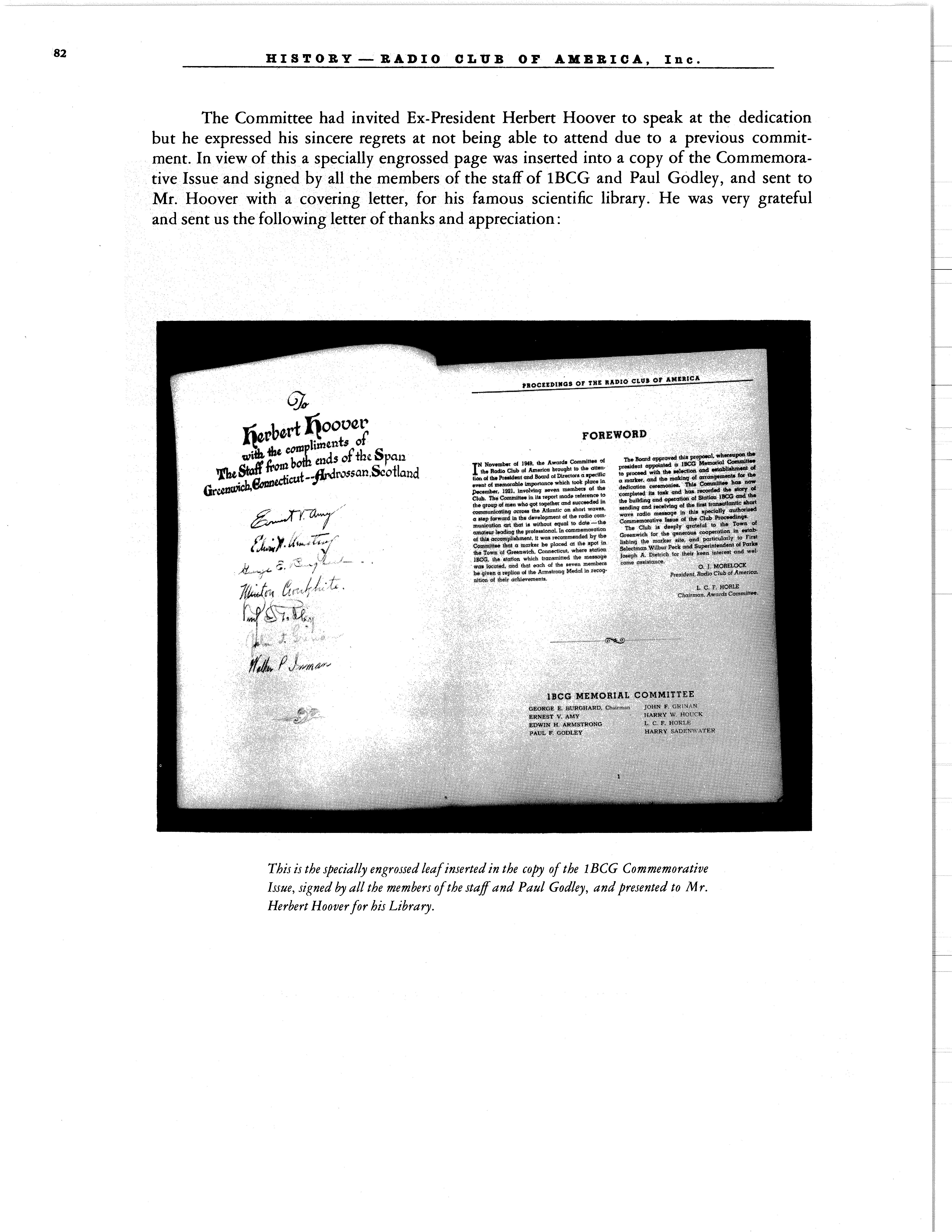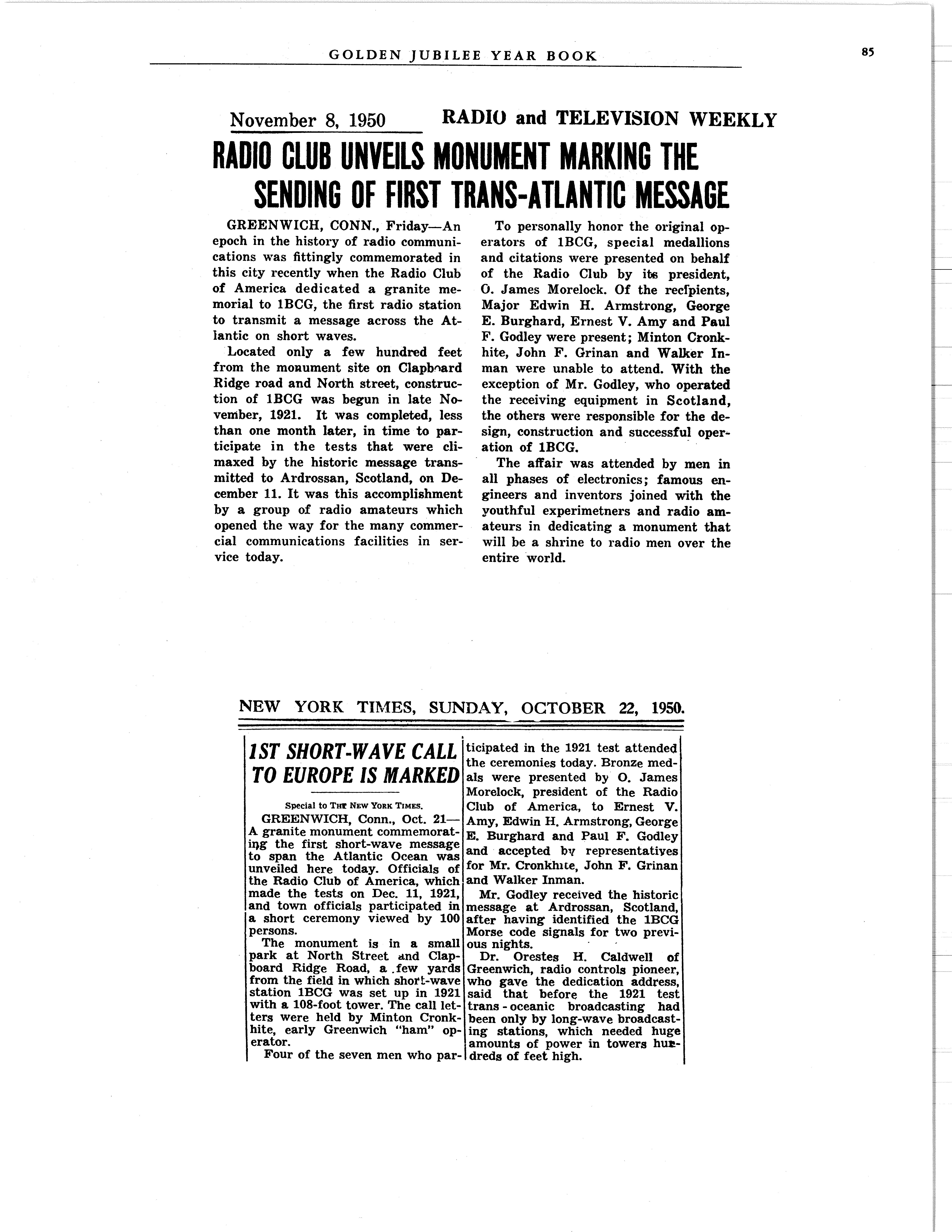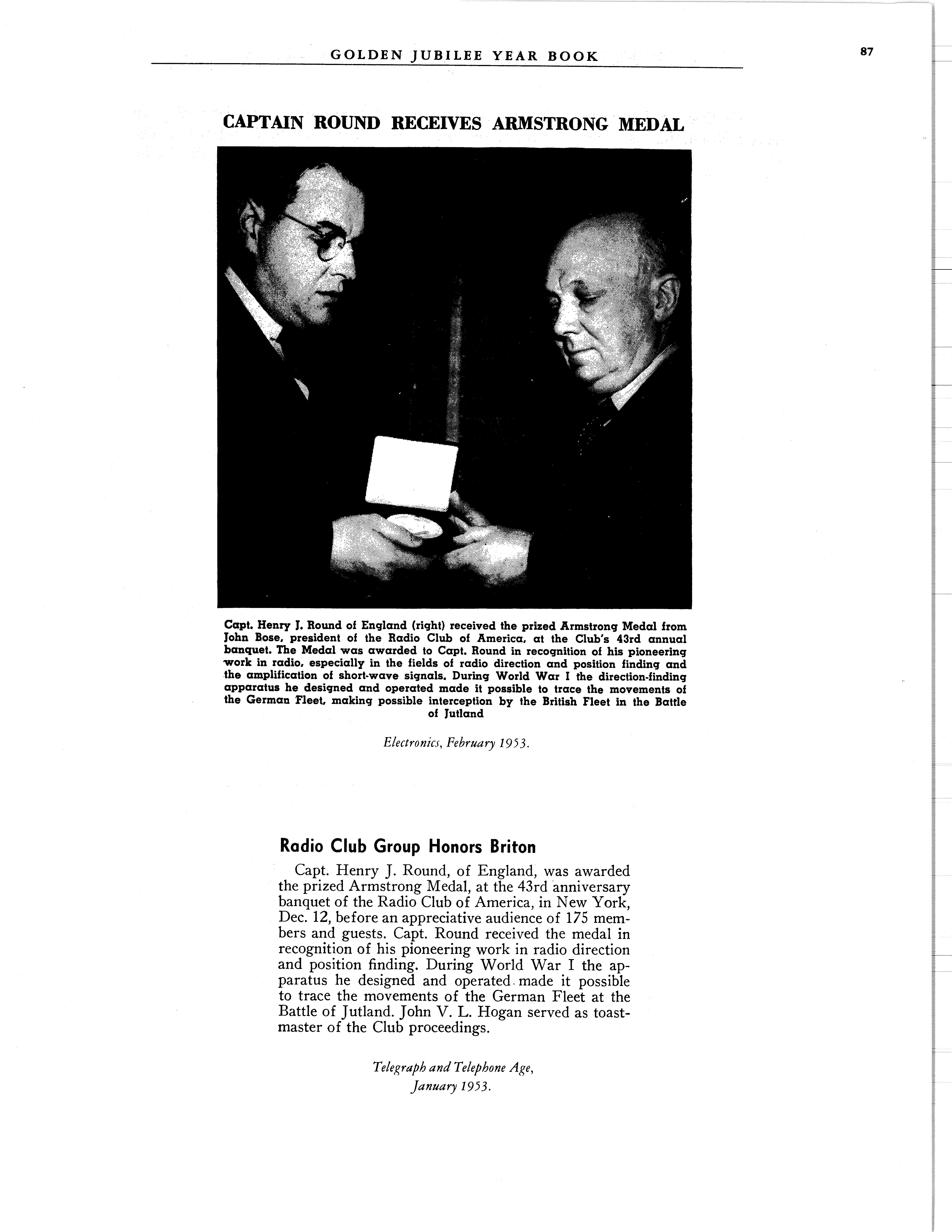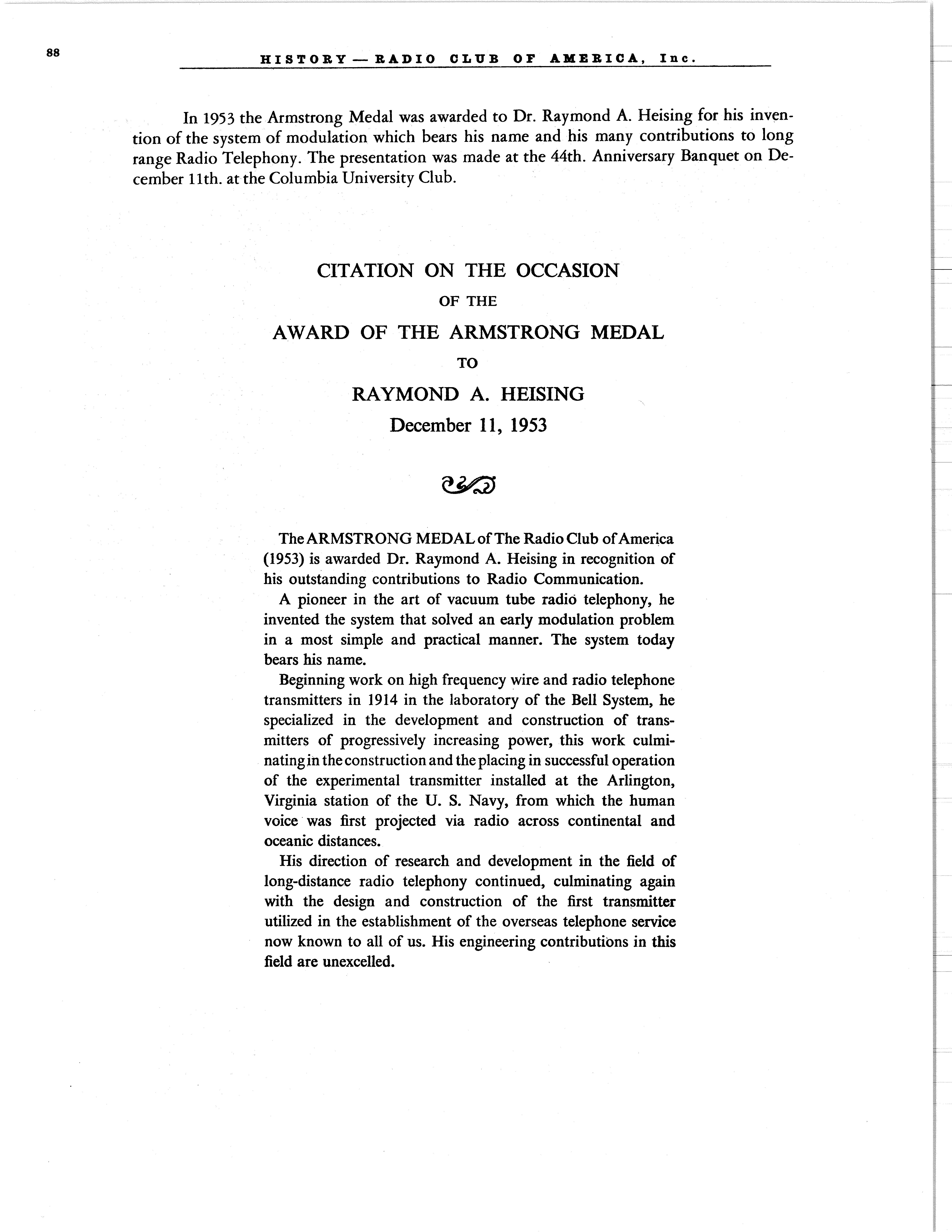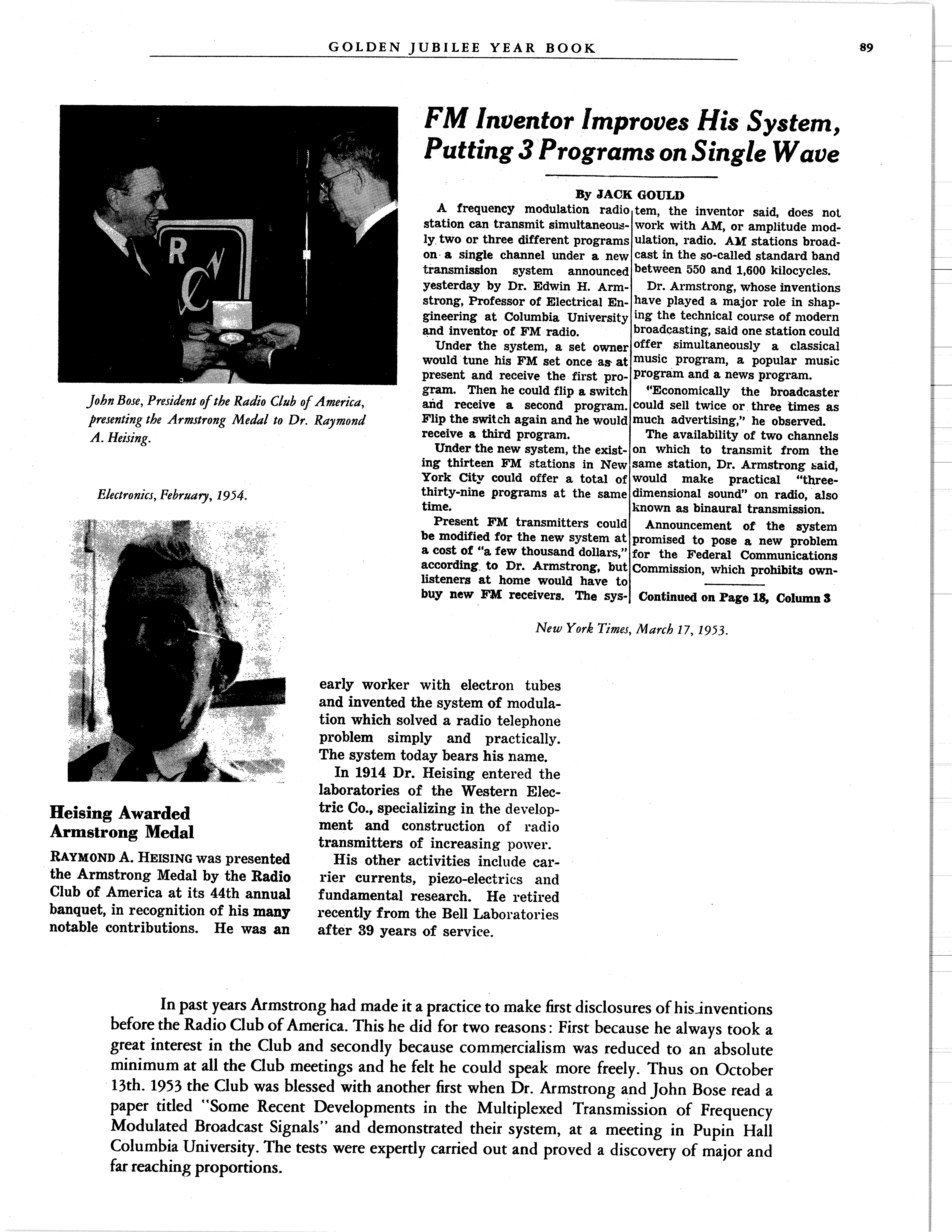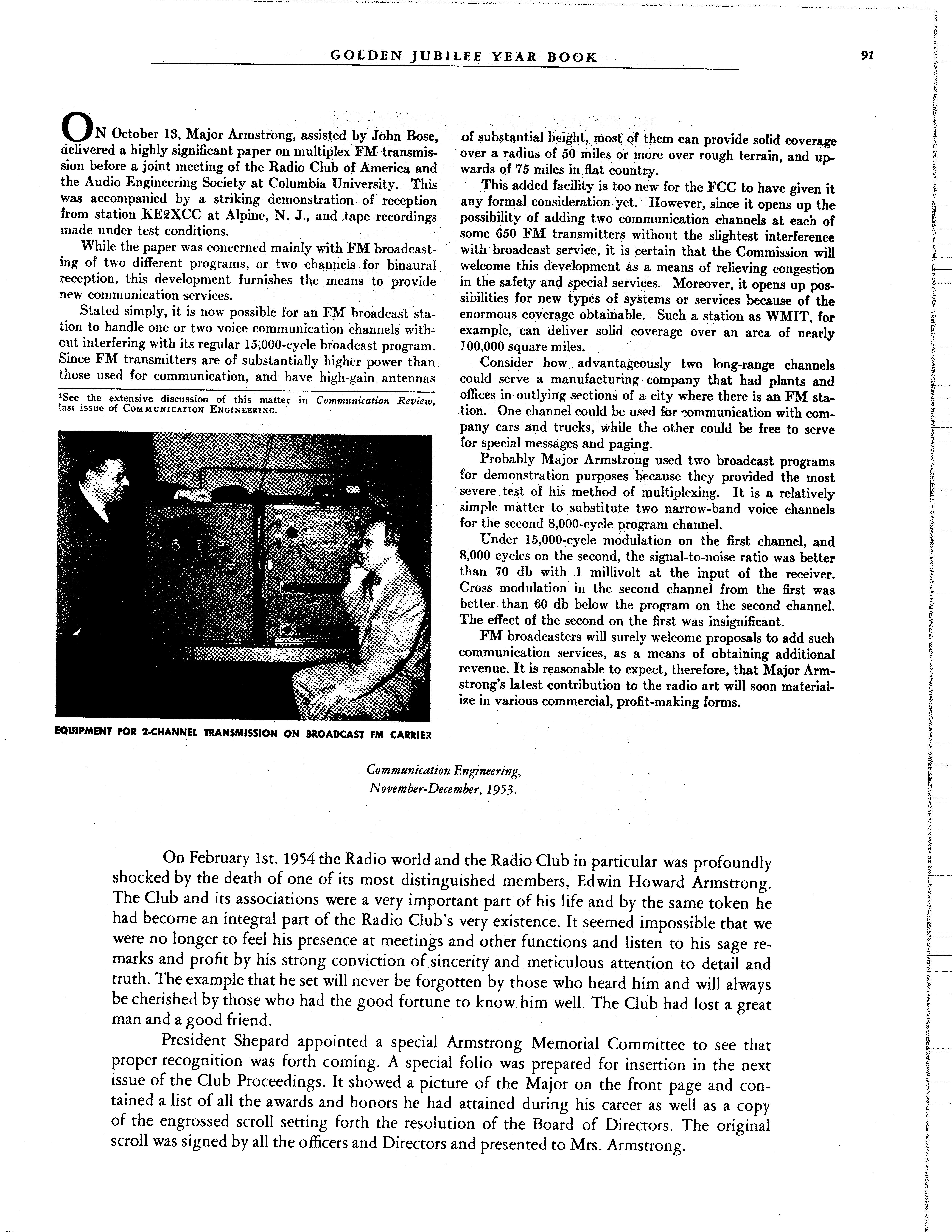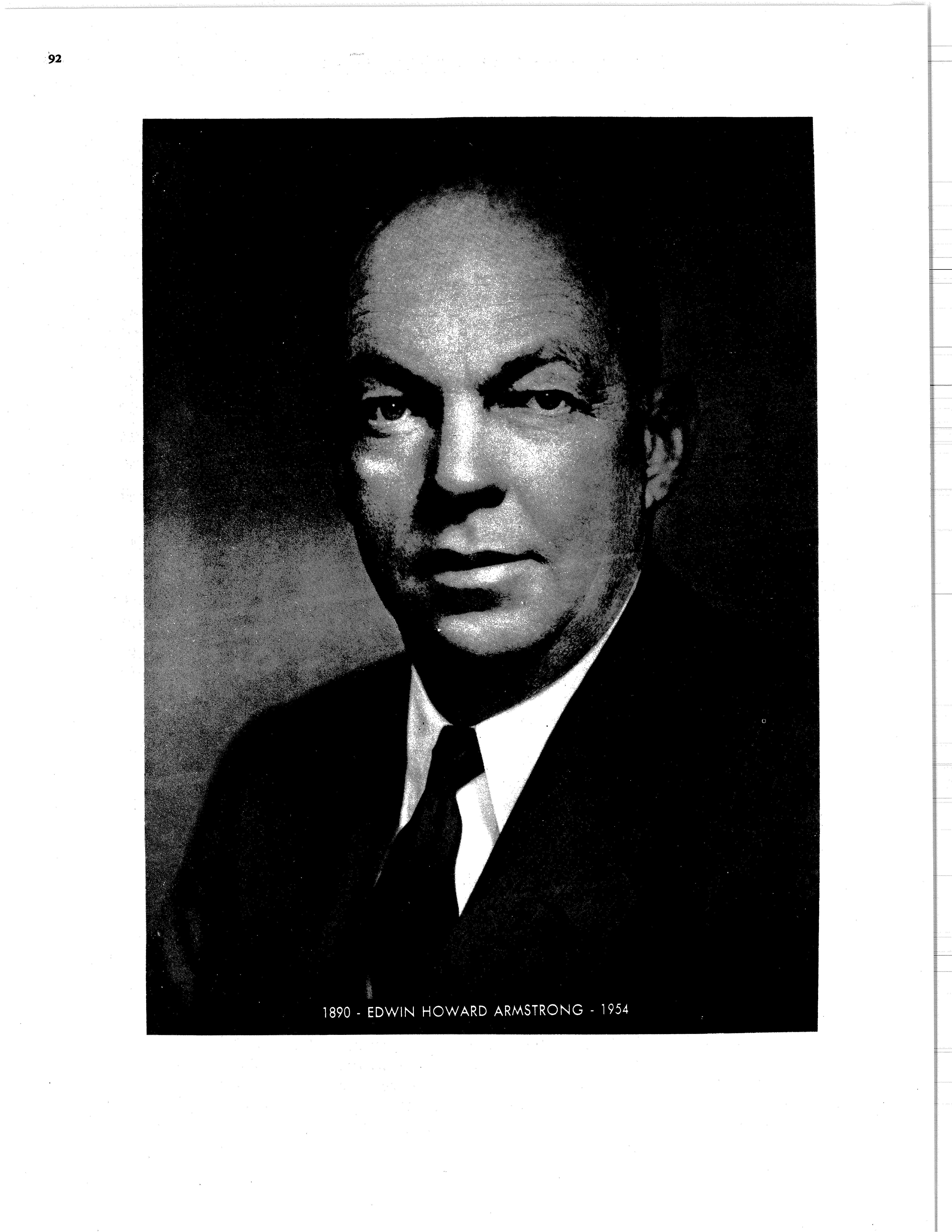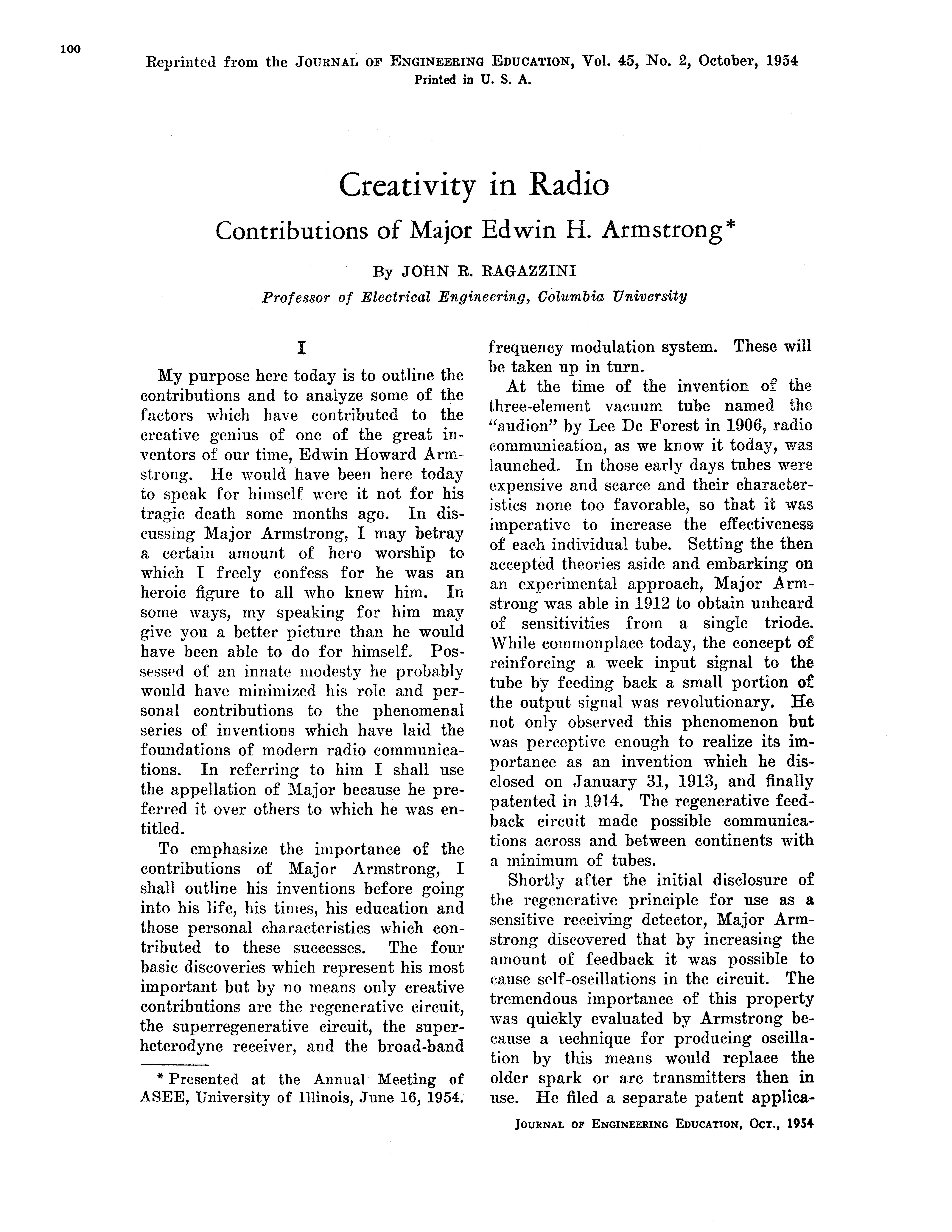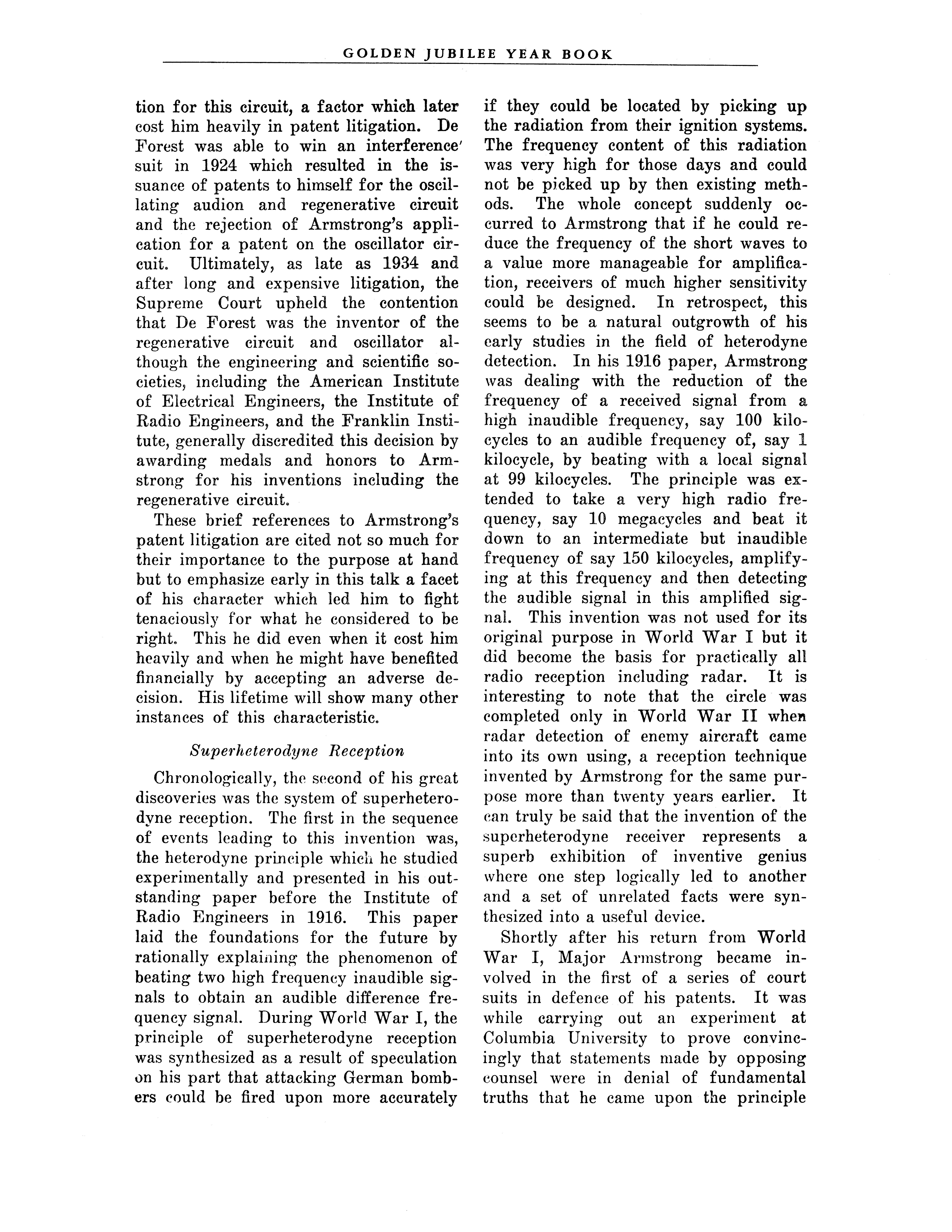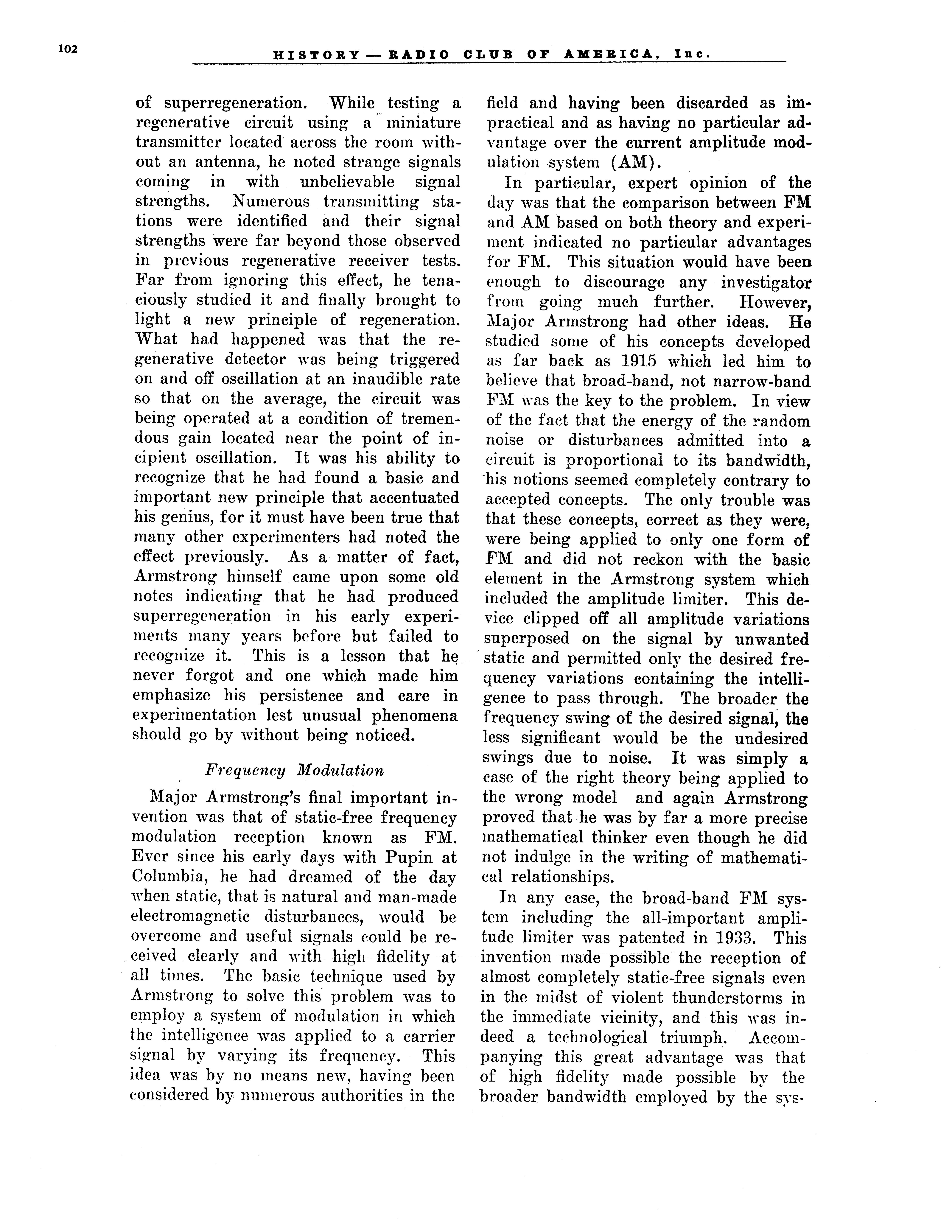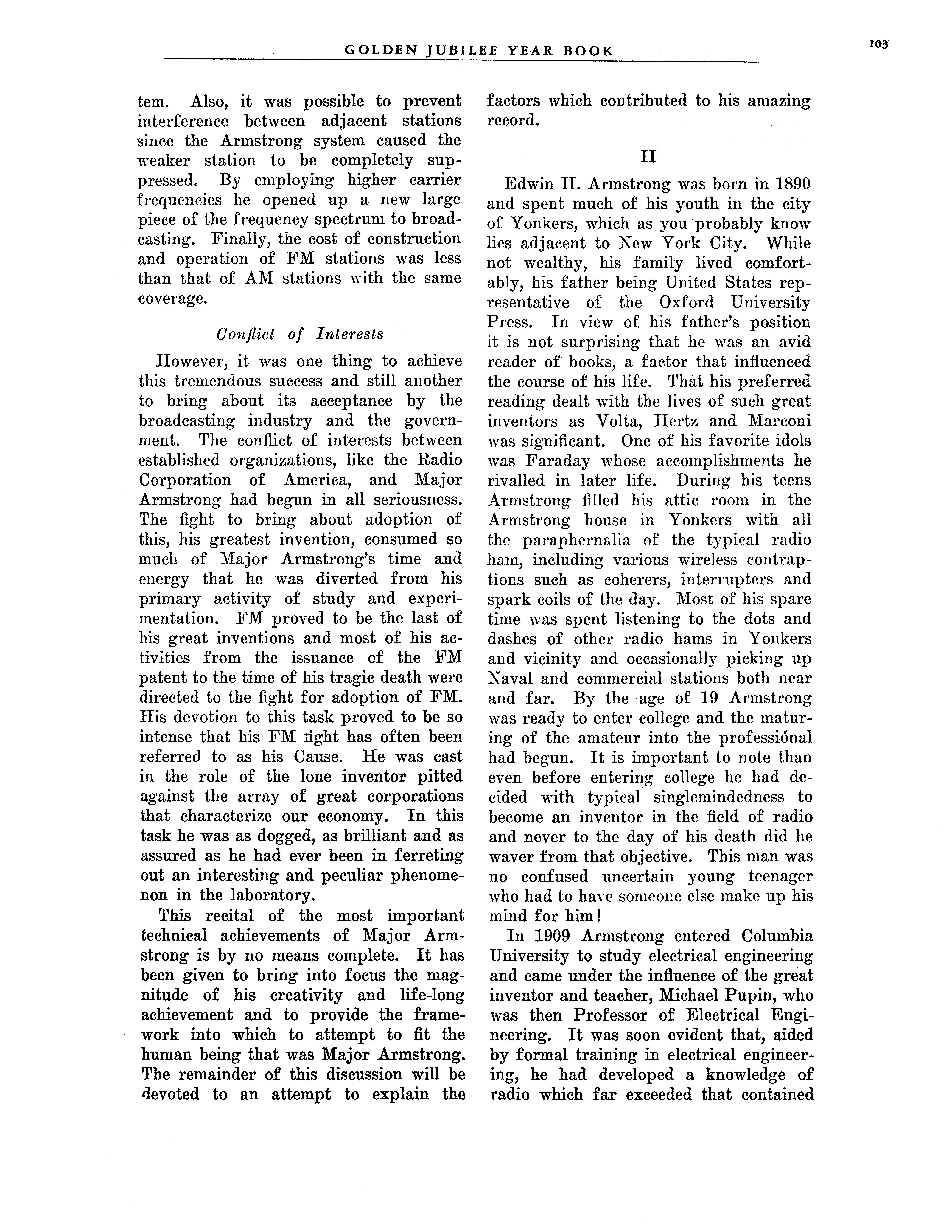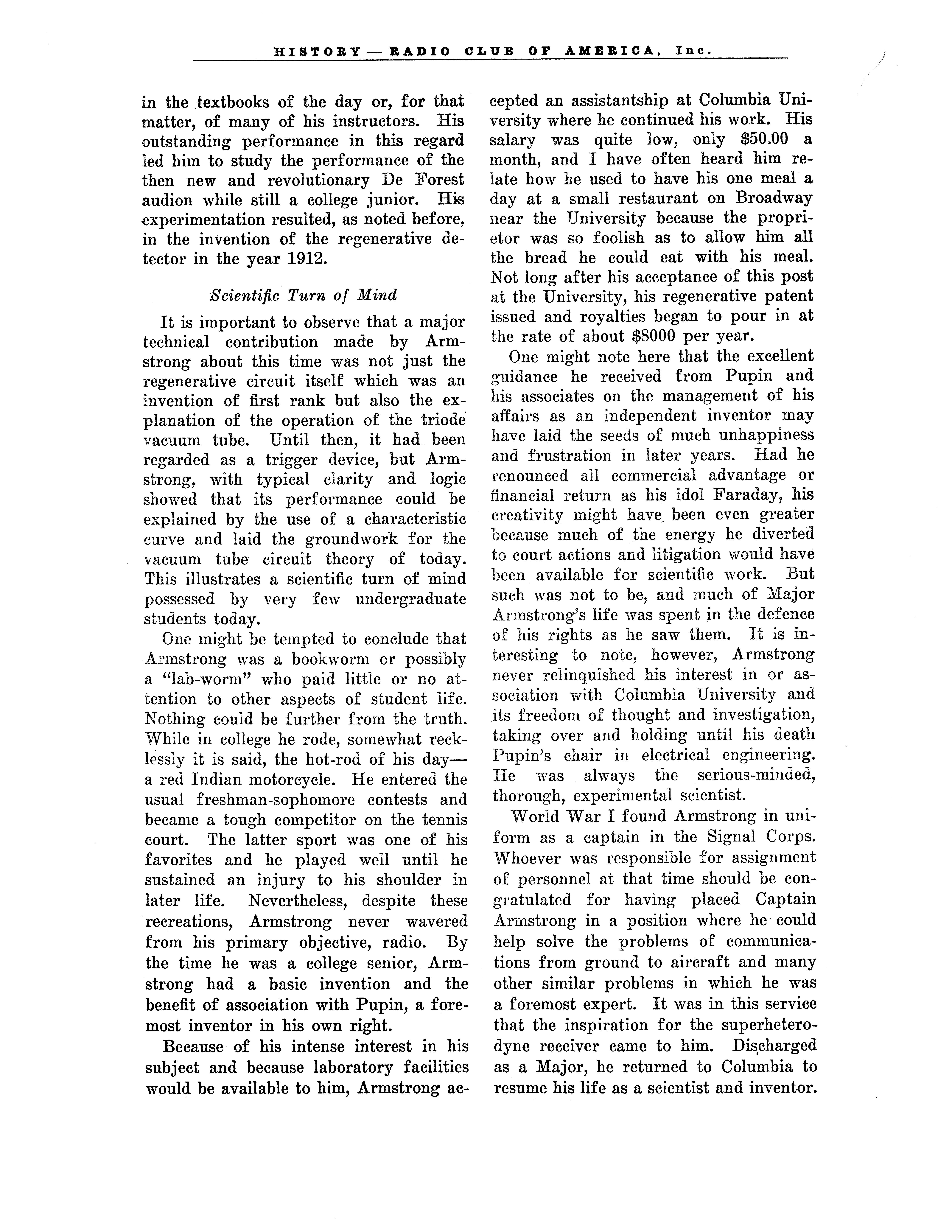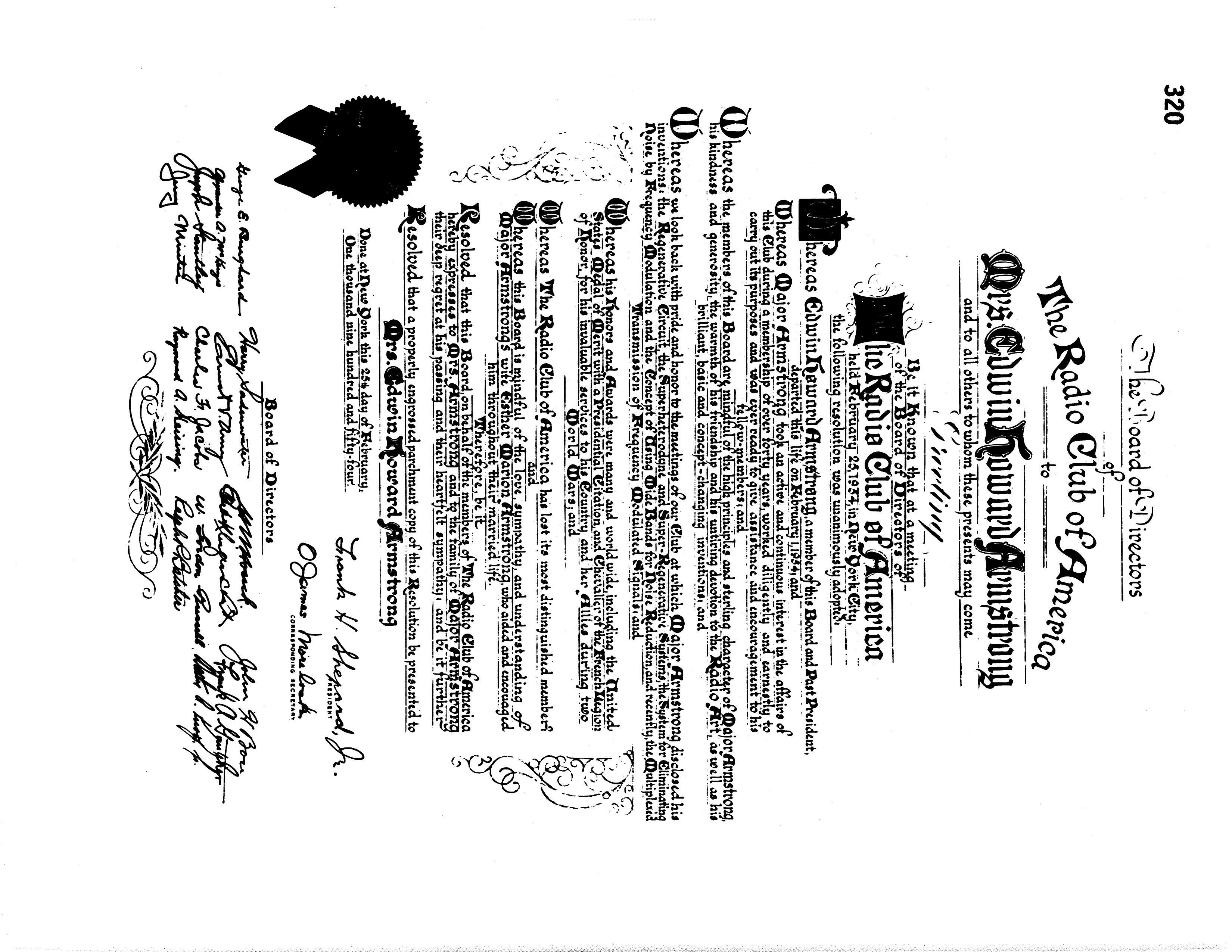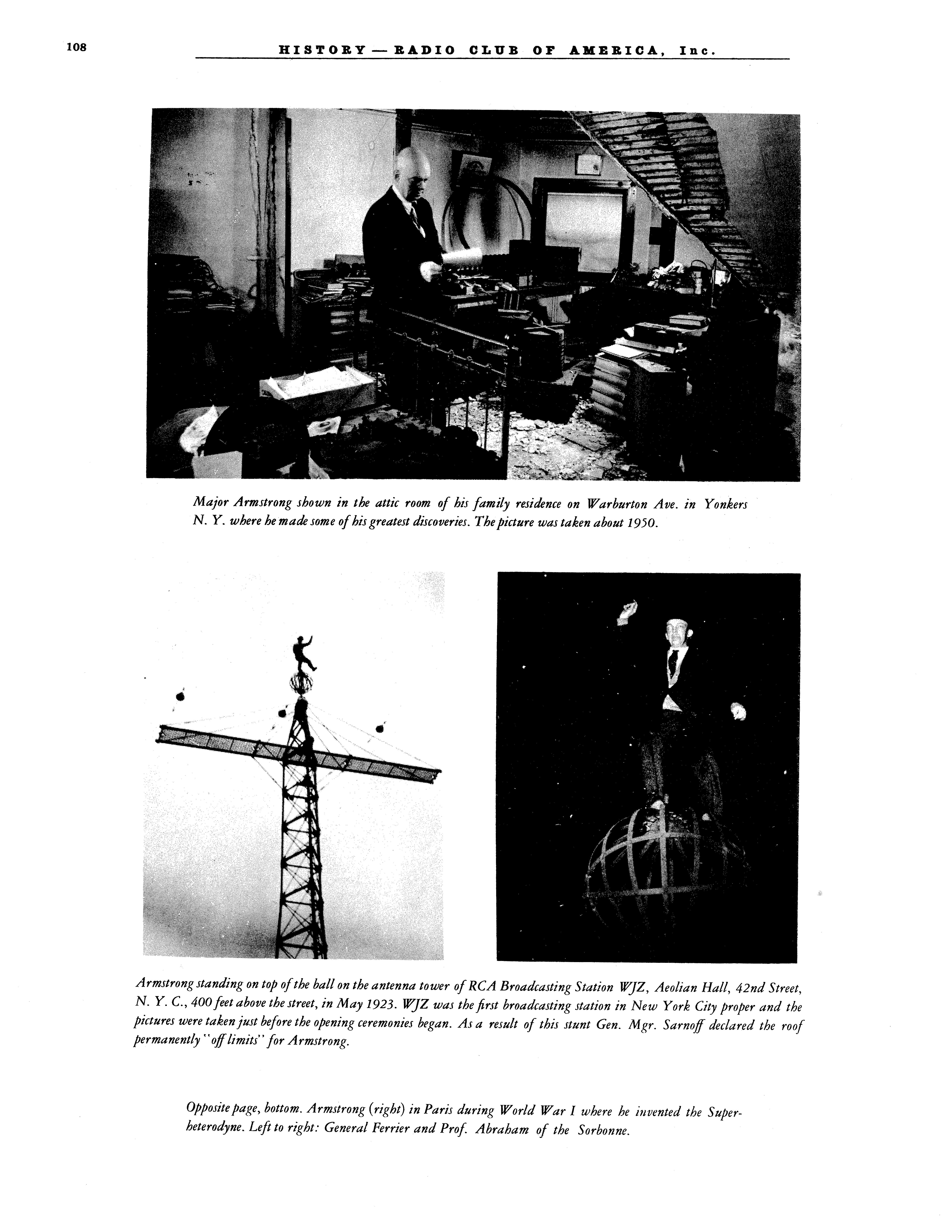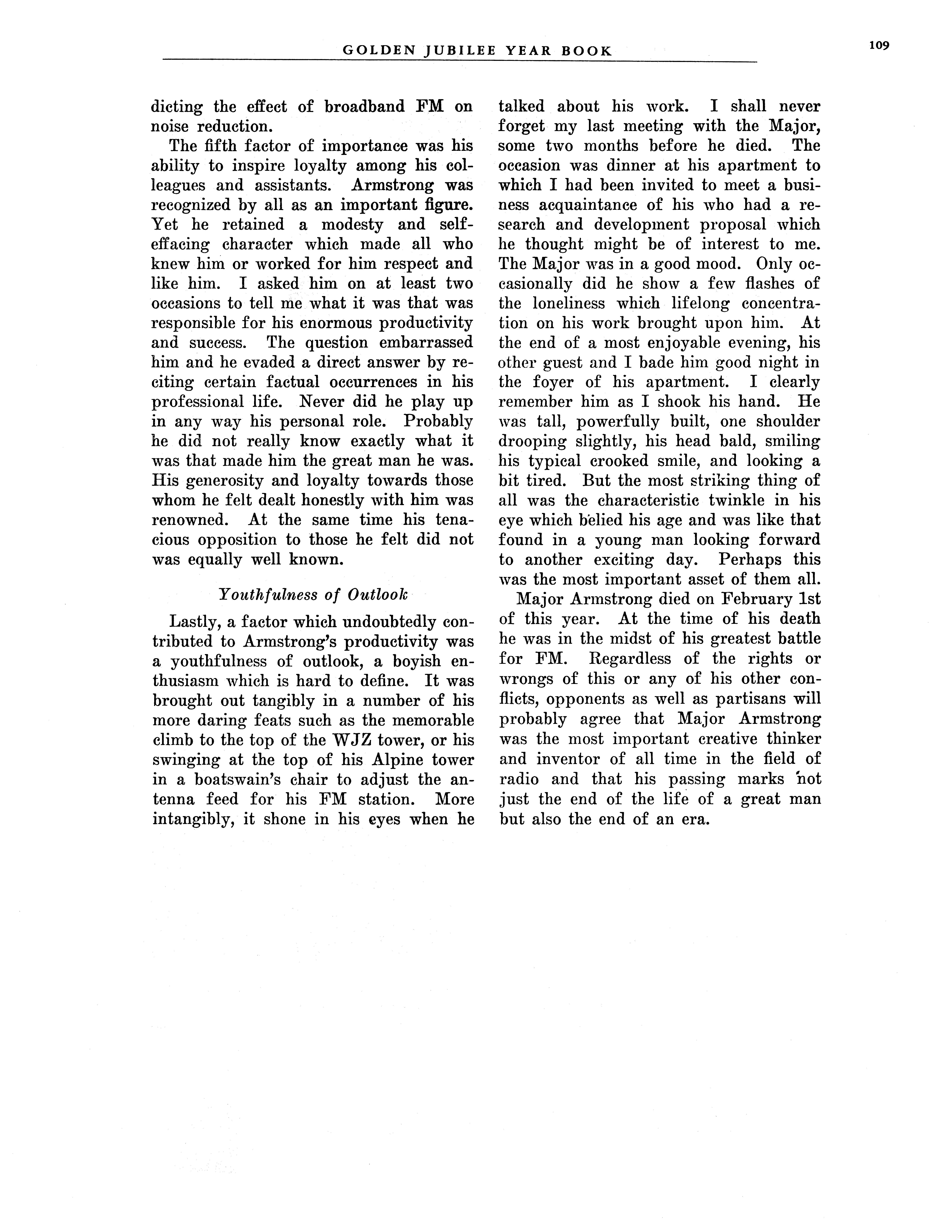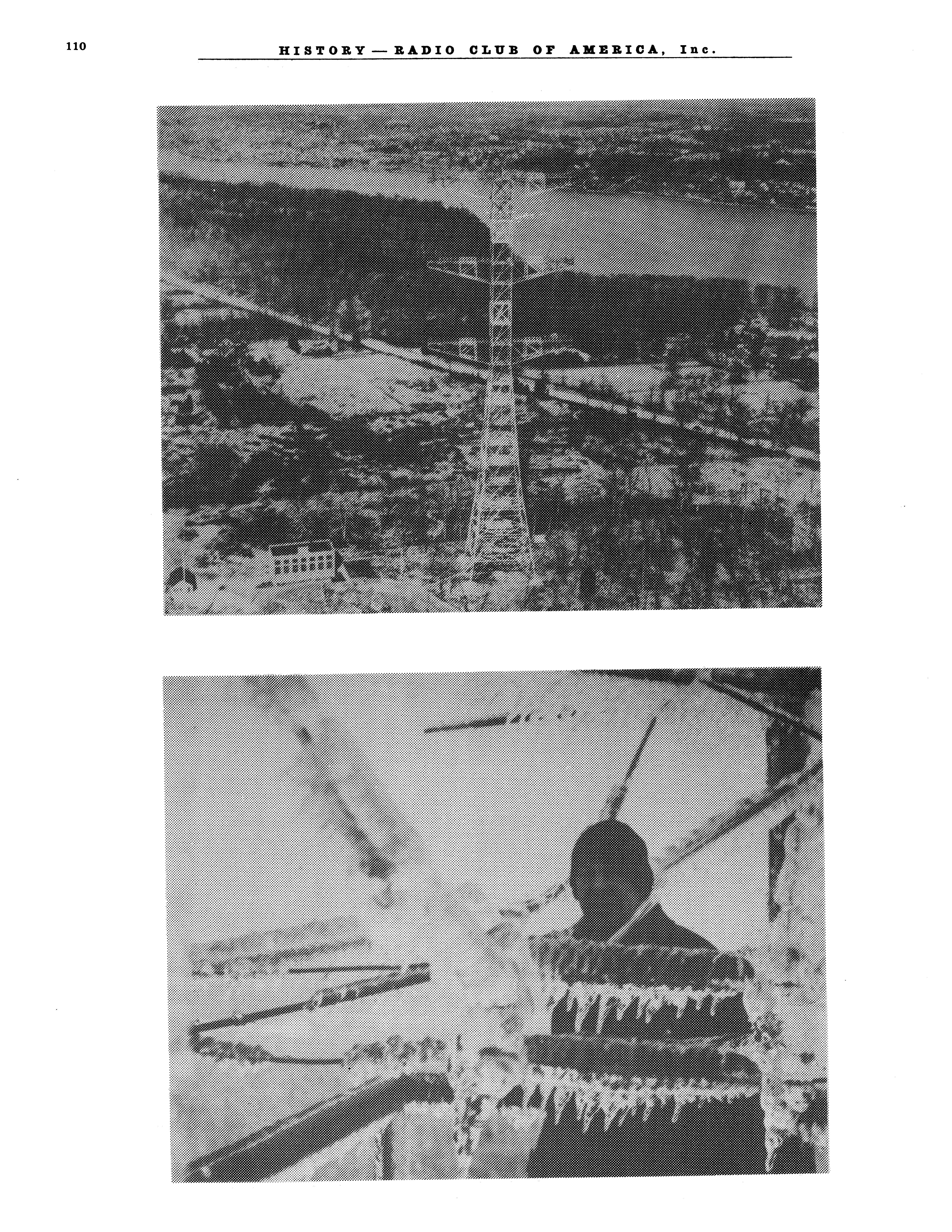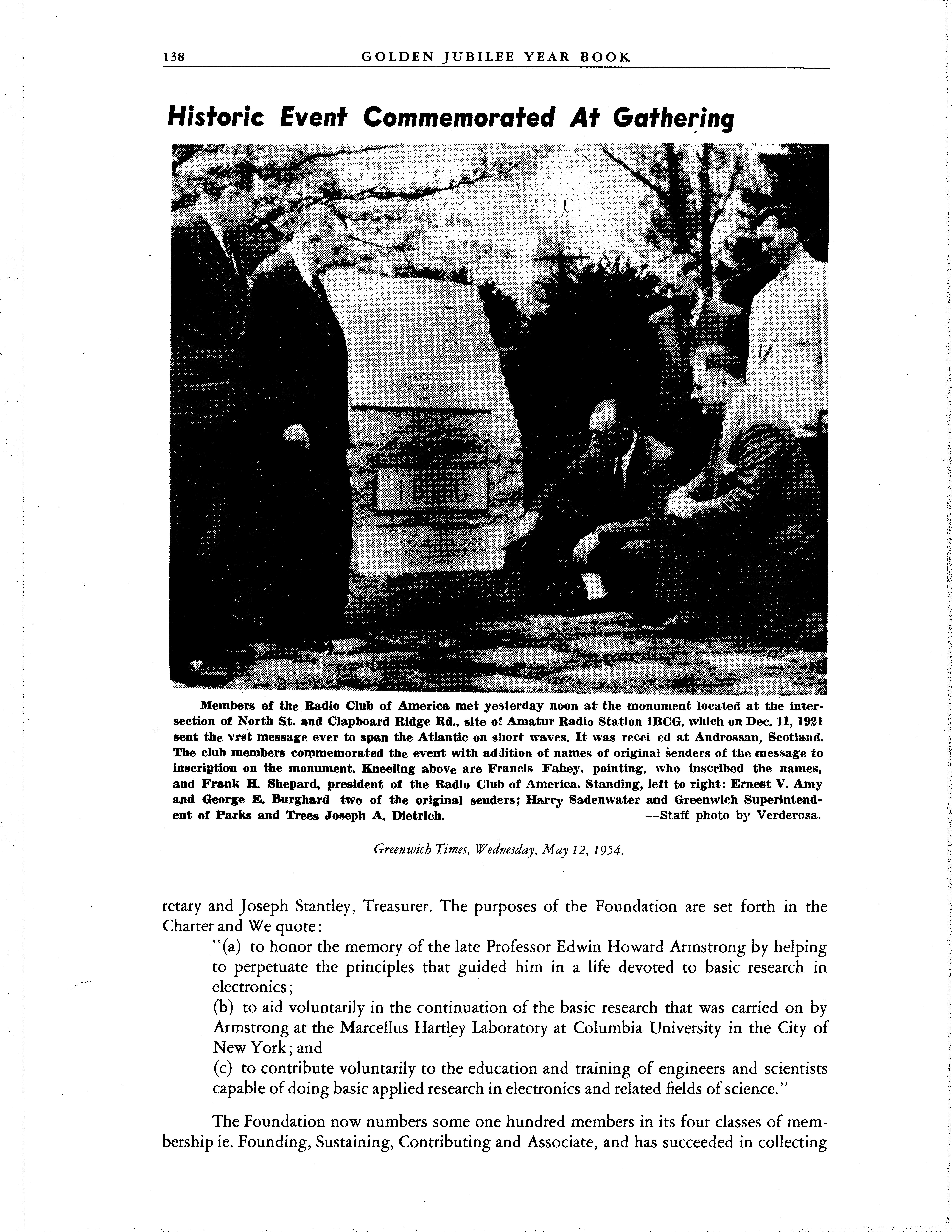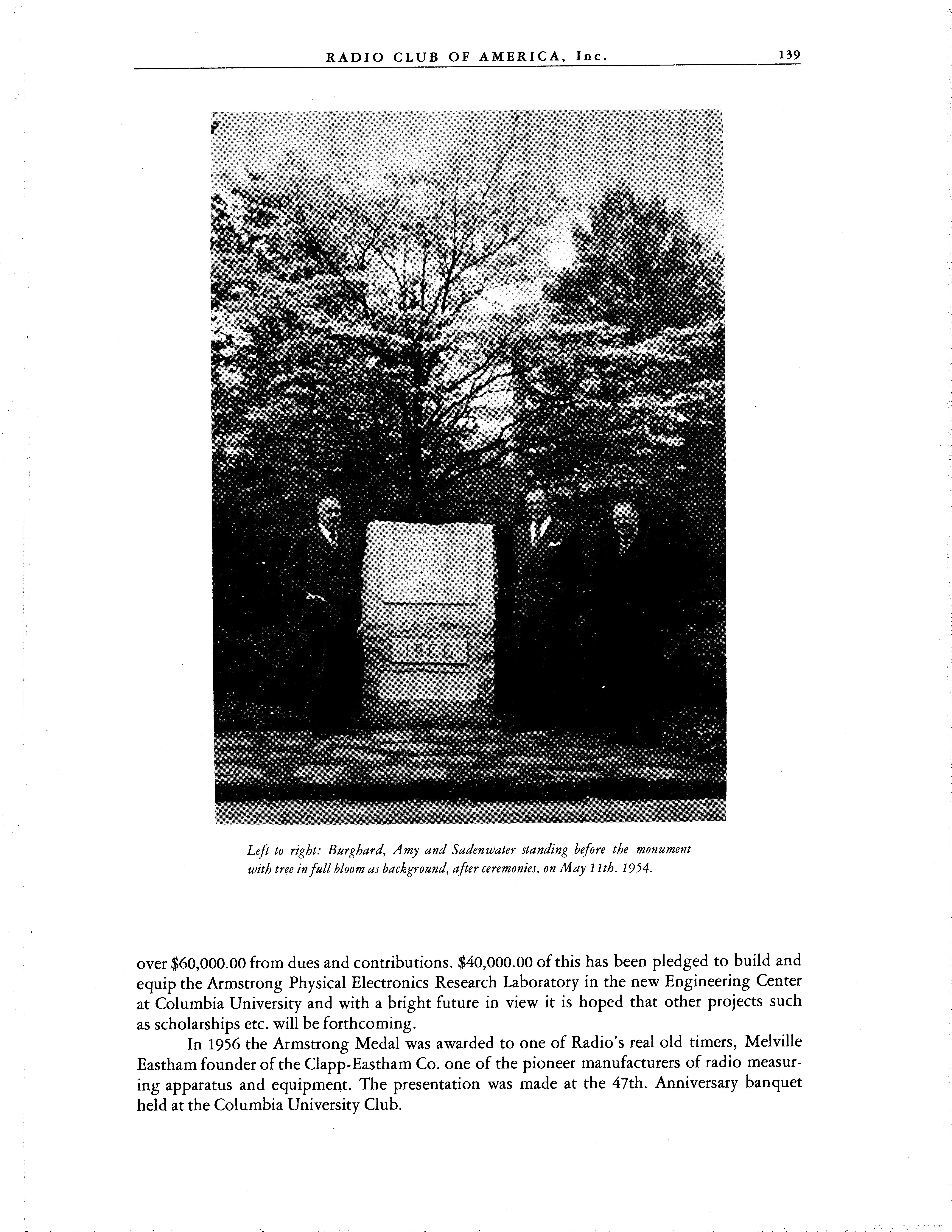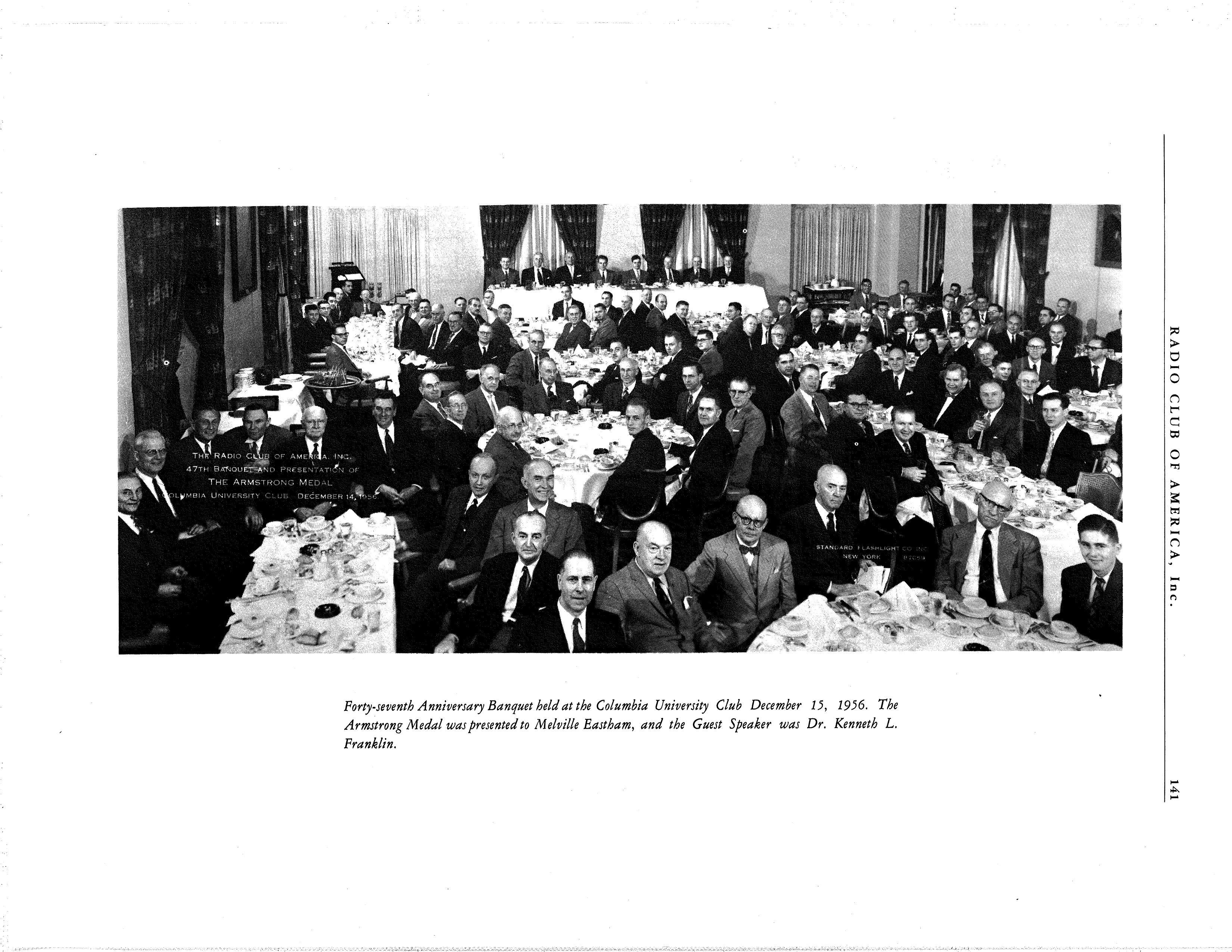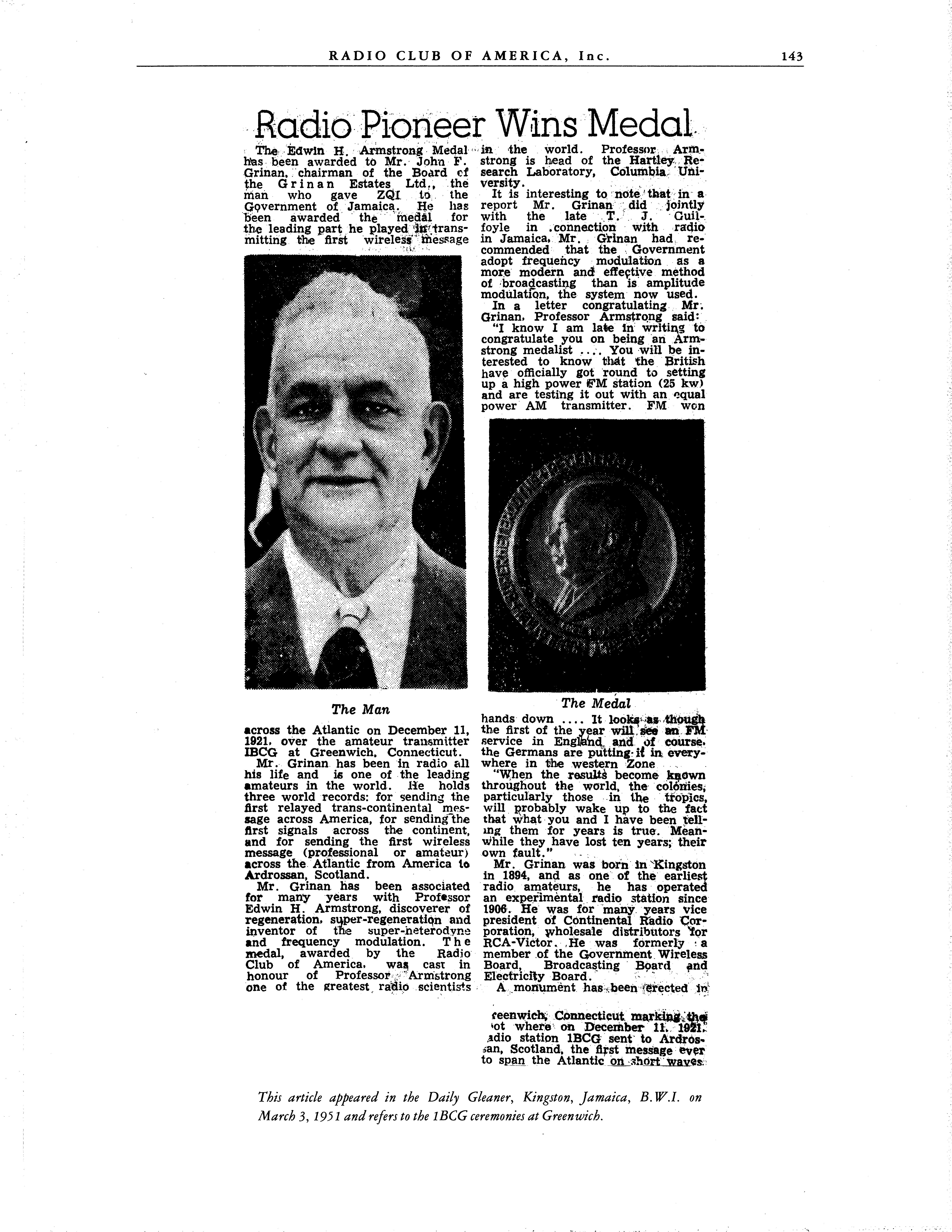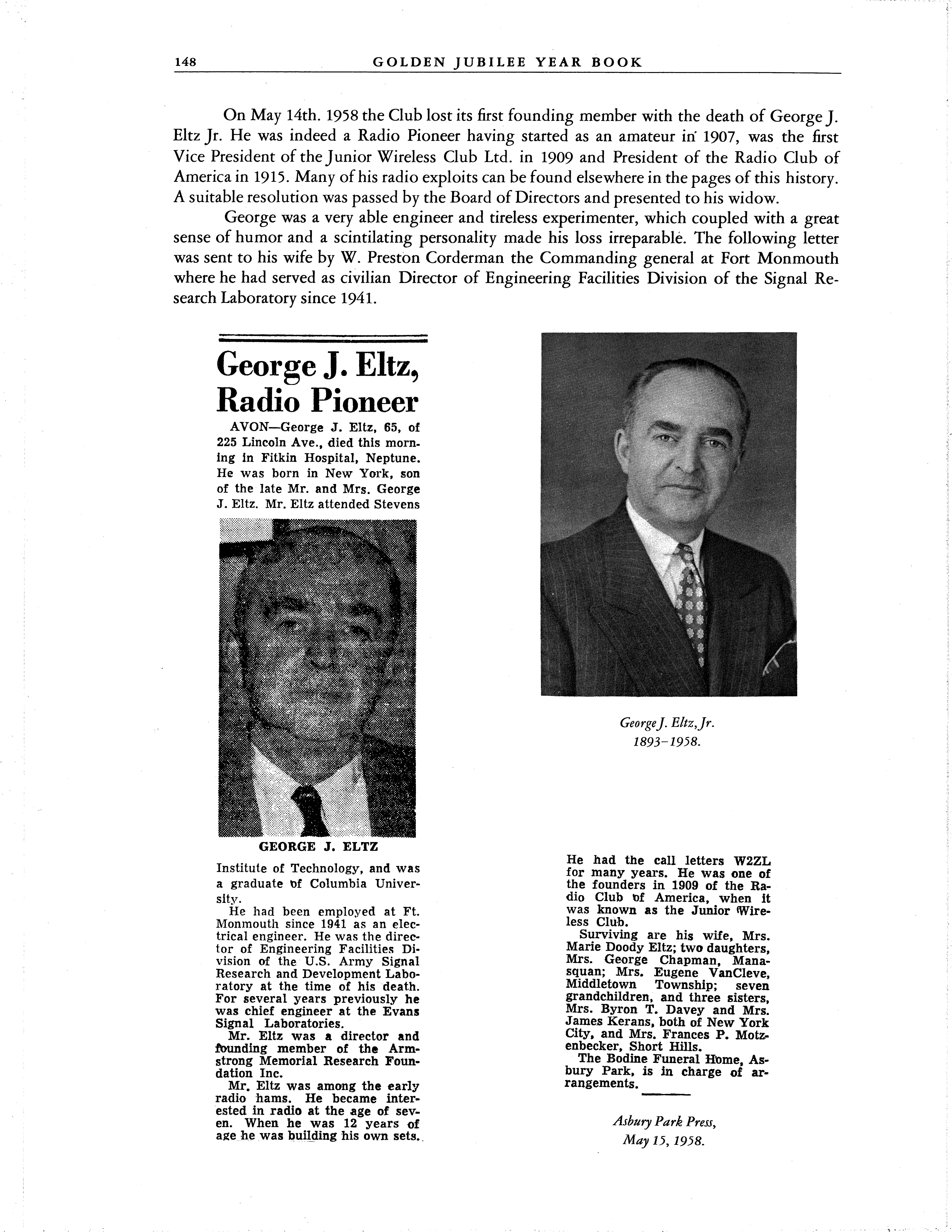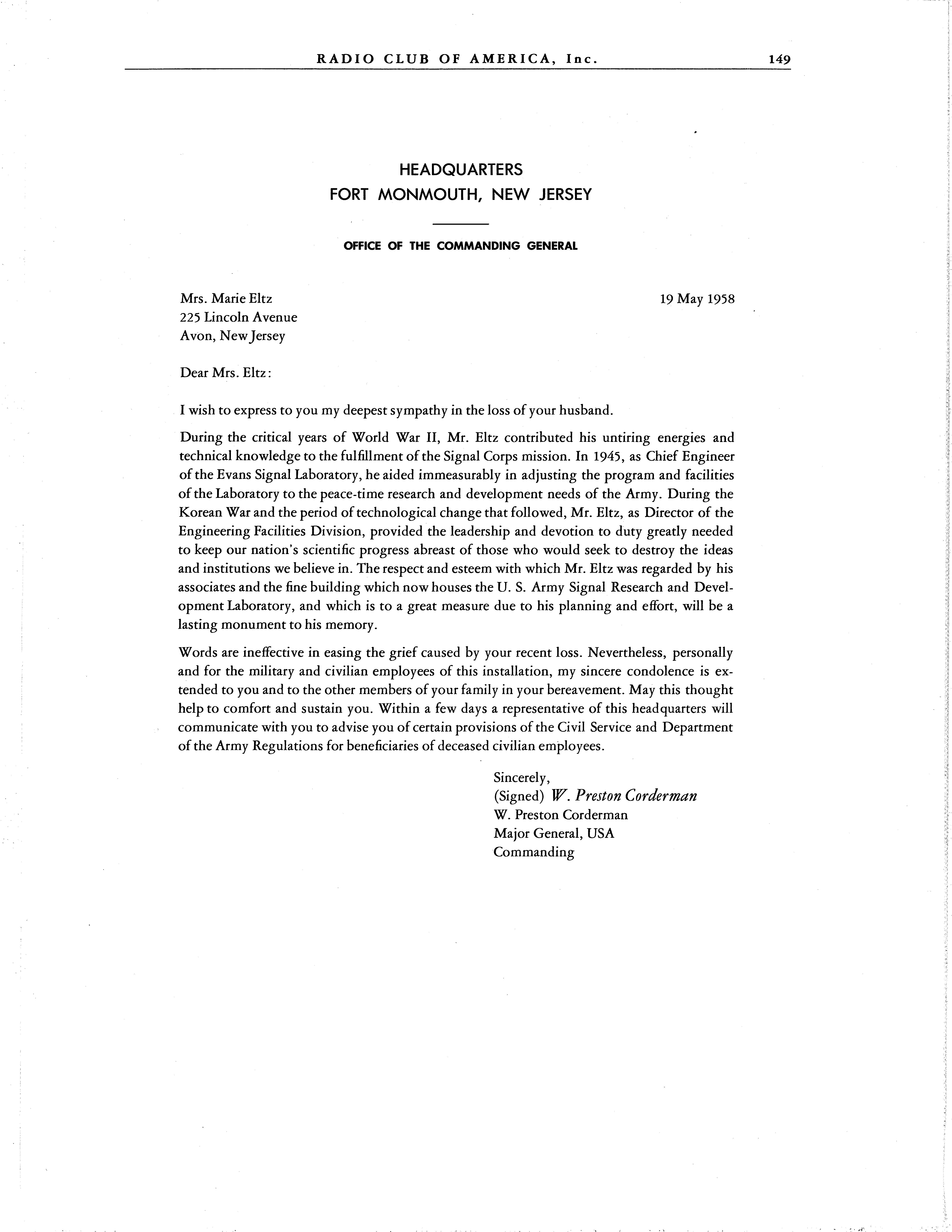HEADQUARTERS FORT MONMOUTH, NEW JERSEY
OFFICE OF THE COMMANDING GENERAL
19 May 1958
I wish to express to you my deepest sympathy in the loss of your husband
During the critical years of World War II, Mr Eltz contributed his untiring energies and technical knowledge to the fulfillment of the Signal Corps mission In 1945, as Chief Engineer of the Evans Signal Laboratory, he aided immeasurably in adjusting the program and facilities of the Laboratory to the peace-time research and development needs of the Army During the Korean War and the period of technological change that followed, Mr Eltz, as Director of the Engineering Facilities Division, provided the leadership and devotion to duty greatly needed to keep our nation’s scientific progress abreast of those who would seek to destroy the ideas and institutions we believe in. The respect and esteem with which Mr. Eltz was regarded by his associates and the fine building which now houses the U S Army Signal Research and Development Laboratory, and which is to a great measure due to his planning and effort, will be a lasting monument to his memory
Words are ineffective in easing the grief caused by your recent loss Nevertheless, personally and for the military and civilian employees of this installation, my sincere condolence is extended to you and to the other members of your family in your bereavement May this thought help to comfort and sustain you Within a few days a representative of this headquarters will communicate with you to advise you of certain provisions of the Civil Service and Department of the Army Regulations for beneficiaries of deceased civilian employees.
Sincerely,
(Signed) W Preston Corderman
W. Preston Corderman Major General, USA Commanding
: RADIO CLUB OF AMERICA, Inc. 149
I
The present administration of the Club is very much aware of the effect of the great change in our way of life on the future of the club. Accordingly President Knoop has recently appointed a special committee to search into every phase of this complex situation and come up with recommendations as to the proper procedure to insure the future welfare of the oldest Radio Club in continuous existence in the World
President Frank Gunther in 1957 appointed a special 50th. Anniversary Committee to make proper arrangements for the Golden Jubilee celebration in 1959- This Committee has been hard at work ever since. The plans are, to publish a Golden Year Book along the same lines as the 25th. Anniversary Silver Book, and to hold a grand Banquet on December 4th. 1959 to which, for the first time in Radio Club history the ladies will be invited. It should be a very festive affair indeed and well under way by the time these lines are printed and the Golden Year Book is ready for distribution.
This brings our story to an end Again we must express our regrets that due to lack of space it has been impossible to write about the many excellent contributions of the Radio Club of America members to the Radio Art. If you will take the time, however to carefully read the other sections of this Book we feel sure that their magnitude will become increasingly apparent. Now that our first fifty years have been successfully accomplished we sincerely hope that the Club will live for many years to come in the same spirit and with the same high ideals upon which it was founded.

! GOLDEN JUBILEE YEAR BOOK 150 1
Fiftieth Anniversary Committee of the Radio Club of America. Left to right , seated: Harry Houck
Pierre Boucheron, Frank King , W . E. D. Stokes Jr., Standing: George Burghard, C R Runyon Jr
Ralph Batcher, Harry Sadenwater, Ernest Amy, Walter Knoop. Not present: Frank Gunther, Frank Shepard, and George WashingtonJr

THE
PROCEEDINGS OF THE RADIO CLUB OF AMERICA, INC.
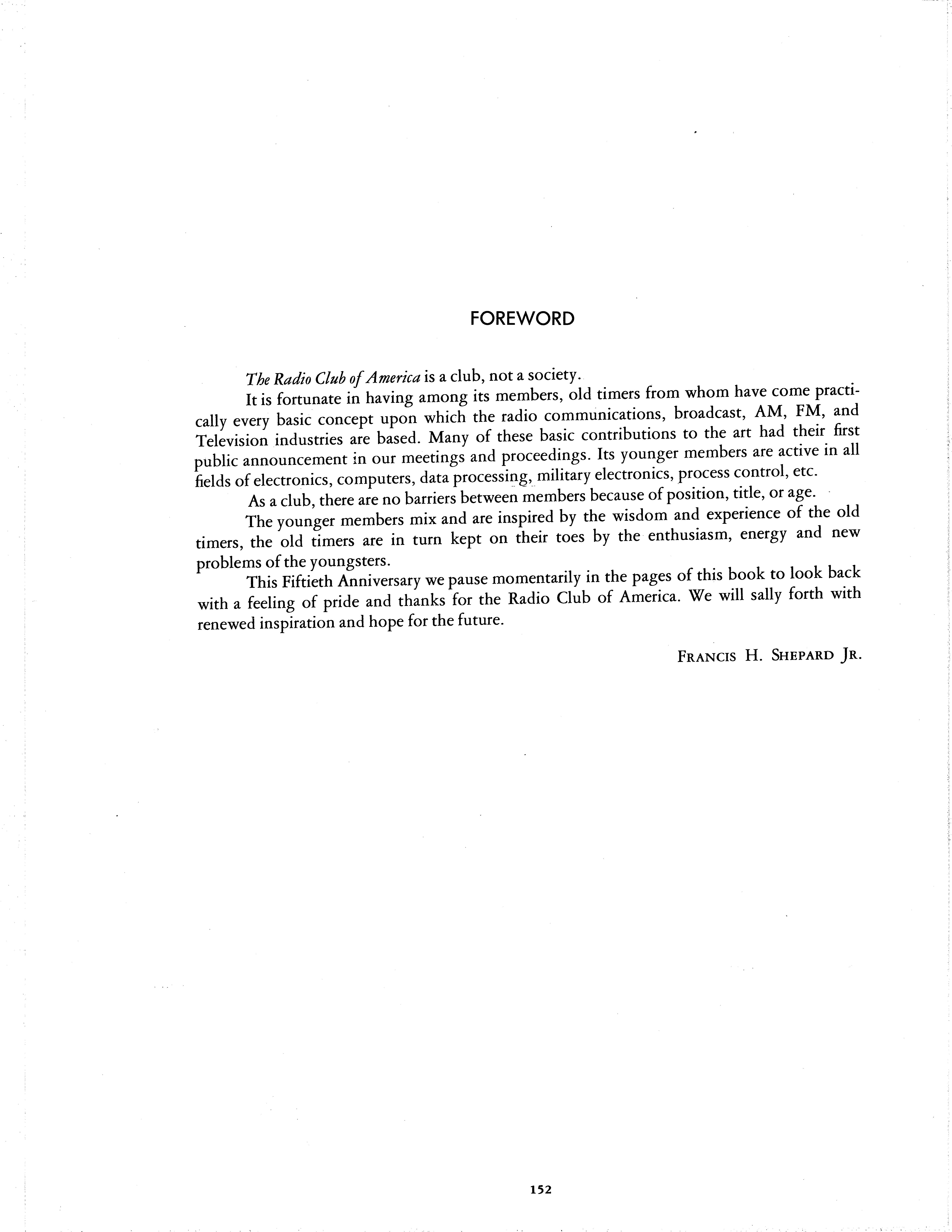
FOREWORD
The Radio Club of America is a club, not a society
It is fortunate in having among its members, old timers from whom have come practically every basic concept upon which the radio communications, broadcast, AM, FM, and Television industries are based Many of these basic contributions to the art had their first public announcement in our meetings and proceedings. Its younger members are active in all fields of electronics, computers, data processing, military electronics, process control, etc.
As a club, there are no barriers between members because of position, title, or age.
The younger members mix and are inspired by the wisdom and experience of the old timers, the old timers are in turn kept on their toes by the enthusiasm, energy and new problems of the youngsters.
This Fiftieth Anniversary we pause momentarily in the pages of this book to look back with a feeling of pride and thanks for the Radio Club of America. We will sally forth with renewed inspiration and hope for the future
FRANCIS H. SHEPARD JR
152

THE PROCEEDINGS OF THE
RADIO CLUB OF AMERICA, INC.
Prior to 1913:
Author Date
Title of Paper
A Square Law Condenser (Straight Line Capacity)
Thermionic Vacuum Tube
A Telephone Relay Amplifier (an original loud speaker designed by him)
Radio Arc Telephony
Directional Radio Transmission
Selenium as a Photoelectric Element
1913 to 1934:
May 1913 Theory of Tuned Circuits
Dec 1913 Theory of Tuned Circuits.
Feb 1914 A Device for Minimizing Interference.
Mar 1914 The Construction of a Sensitive Galvanometer
Apr 1914 Working Principles of a Wavemeter.
May 1914 (1) Telegraphone (2)An Audio-Frequency Amplifier
Nov 1914 The Heterodyne Receiving System.
Nov. 1914 The Development of the Hudson Audion Filament
Dec. 1914 The Kolster Direct-Reading Decrement and Wavemeter
Feb. 1915 Distributed Capacity and Dead End Effect
Apr 1915 The Regenerative Circuit.
May 1915 Foreign Radio Apparatus
Oct. 1915 Quenched Spark Sets
Nov. 1915 Discussed expert testimony tending to show that Marconi’s was a genuine invention and not merely a development of Hertzian waves.
Dec 1915
Jan 1916
Mar 1916
May 1916
The Development of Radio Sets for Aeroplanes Portable Aeroplane and Trench Radio Sets.
The Efficiency of Radio Sets
Fundamental Considerations in Oscillating and Resonance Circuits.
June 1916 Applications of the Audion.
Sept. 1916 A Modern Experimental Radio Telegraph and Telephone Station
Dec. 1916 Radio Laboratory Measurements and the Elimination of Radio Losses.
Jan. 1917
Feb 1917
Mar 1917
Apr 1917
Inductance and Capacity Phenomena.
Losses and Capacity of Multi-Layer Coils
Motional Impedance Circle of the Telephone Receiver
Army and Navy Signaling Systems.
GeorgeJ Eltz,Jr.
Ernest V Amy
Dr Walter G Hudson
GeorgeJ Eltz.Jr and Frank King
Frank King
George Burghard
Edwin H. Armstrong
Edwin H. Armstrong
Walter S. Lemmon
GeorgeJ Eltz,Jr
Louis Gerard Pacent
Charles V Logwood
John V. L. Hogan,Jr.
Dr. Walter G. Hudson
Robert H Marriott
Harry Sadenwater
E. H. Armstrong
Dr. A. N. Goldsmith
Fritz Lowenstein
EmilJ Simon
L J Lesh
William Dubilier
Fritz Lowenstein
Dr.John Stone
Paul F Godley
Alfred H Grebe
L. W. Stevens
Prof J H Morecroft
Louis A Hazeltine
Hawley O Taylor
David S. Brown and Walter S. Lemmon
f
:
:
:
153
Date
May 1917
Dec 1919
Jan 1920
Feb 1920
Mar 1920
Apr 1920
May 1920
Sept 1920
Oct 1920
Nov 1920
Dec. 1920
Jan. 1921
Feb. 1921
Mar 1921
Apr. 1921
May 1921
Sept. 1921
Oct. 1921
Nov 1921
Dec 1921 Jan 1922 Feb 1922 Mar. 1922
Apr. 1922
June 1922 Oct 1922

Title of Paper
This represents the period of the World War, and no record exists of any papers read before the Club.
A New Method of Receiving Weak Signals for Short Waves.
The Vacuum Tube as a Detector and Amplifier.
Recent Development of Radio Telephones
Navy Receiving Equipment
Bulb Oscillators for Radio Transmission
2ZM’s Radiophone and C W Transmitter
The Bureau of Standards A R R L Tests of Short Wave Radio Signal Fading.
Determination of Resistance, Inductance and Capacity by the Wheatstone Bridge Method
The Resonant Convertor
Amateur C. W. Set at 2ZL.
Design of Loop Antenna.
Modulation in Radio Telephony.
Some Operating Notes on the Larger Sizes of Transmitting Tubes
Notes on Design of Vacuum Tube Transmitters.
Commercial Radio Telephony
Description of Radio Station 8XK
Audio and Radio Frequency Amplification
Methods of Modulation in Radio Telephones.
Station 1BCG
Radio Central
Trans-Atlantic Reception
The S-Tube Rectifier.
Multi-Stage Amplifiers.
The Super-Regenerative Circuit.
The Armstrong Super-Regenerative Circuit: its Operation and Construction
Vacuum Tube Amplification
Author
Nov 1919
Edwin H. Armstrong
L. M. Clement
Walter S. Lemmon
L. C. F. Horle
Louis A Hazeltine
L Spangenberg
S Kruse
Julius G Aceves
Walter S Lemmon
J O Smith
David S Brown
R. A. Heising
William C. White
A W Kishpaugh
Francis M. Ryan
Frank Conrad
GeorgeJ Eltz,Jr
L. C. F. Horle
George E Burghard
Pierre Boucheron
Paul Godley
HowardJ Tyzzer
M C Batsel
Edwin H. Armstrong
GeorgeJ. Eltz,Jr.
S E Anderson
Louis A Hazeltine Dec 1922 Mar 1923
Apr. 1923 May 1923 June 1923 Sept 1923
Nov 1923 Jan
Tuned Radio Frequency Amplification with Neutralization of Capacity Coupling.
Eighteen Years of Amateur Radio.
The Thoriated Tungsten Filament.
How to Build a Super-Heterodyne Receiver
The Fundamentals of Loud Speaker Construction
Why No Receiver Can Eliminate Spark Interference.
George Burghard
William C. White
GeorgeJ Eltz,Jr
A Nyman
Louis A. Hazeltine
1924 Oct. 1924 Dec. 1924
1925
1925
1924 1926
1926
1926 May 1926
A New Method of Radio Frequency Amplification
The Story of the Super-Heterodyne
Solving the Problems of the Neutrodyne
A Single Control Receiver.
An Induction Loud Speaker.
Anti-Radiation Devices
Influence of Wiring in Resonant Circuit Design. Modern Radio Reproduction
Loud Speakers.
Electrical Instruments and Their Adaption to Radio. Tendencies in Modern Radio Receivers.
Transformer Coupled Amplifiers for Radio Receivers
Problems of Three Broadcasting Stations.
A Short-Wave Superheterodyne Receiver.
C L Farrand
Edwin H Armstrong
John F Dreyer,Jr
C. L. Farrand
Dr. C. W. Hewlett
R A Weagant
Oscar C. Roos
Arthur Van Dyck
C. L Farrand
A. F. Corby
Julius G. Aceves
A W Saunders
Harry Sadenwater
154 GOLDEN JUBILEE YEAR BOOK
Feb.
Apr
Feb
May
Dec
Jan. Feb.
Mar
Apr
GeorgeJ. Eltz,Jr. June
1924
1925
1926
1926

Date
Sept 1926
Oct 1926
Nov 1926
Dec 1926
Jan 1927
Feb. 1927
Mar. 1927
Apr 1927
May 1927
June 1927
Sept 1927
Oct. 1927
Dec. 1927
Jan 1928
Feb 1928
Mar 1928
Apr 1928
May 1928
June 1928
Oct 1928
Dec. 1928
Jan. 1929
Feb. 1929
Mar. 1929
Apr 1929
May 1929
June 1929
Sept 1929
Nov 1929
Dec 1929
Jan. 1930
Feb. 1930
Mar. 1930
Apr. 1930
May 1930
June 1930
Sept 1930
Oct. 1930
Title of Paper
A New System of A C Power Supply and its Application to a Commercial Broadcast Receiver
The Theory and Application of the Constant-Coupled, NonReactive Plate Circuit Radio-Frequency Amplifier.
Development, Design and Operation of an S. W. Receiver in which Regeneration is Practically Constant.
A Fundamental Analysis of Loud Speakers.
A Combination Power Amplifier and "B” Eliminator
Tubes and Methods of Measurement
Description of Radio Station 2AG.
Use of Tubes having High Amplification Factor.
Three-Element Vacuum Tube
Factors Governing the Service Area of the Broadcast Transmitting Station.
Characteristics and Performance of Rectifier Tubes.
Amplifier Circuits.
Experiences of a Radio Engineer.
Life Test Data on Paper Condensers.
Application of the Four-Electrode Receiving Tube.
Acoustics and Microphone Placing in Broadcasting Studios.
Practical Design of Direct Coupled Amplifiers and DetectorAmplifiers.
Overall Measurements on Broadcast Receivers
Overall Measurements on Broadcast Receivers
Radiotron UX250 A High Power Output Tube
High Frequency Experiments in Aircraft
Seasonal Variations in Short Wave Transmission
The Description of an Automatic Voltage Regulator.
Servicing Radio Receivers
The Characteristics of Audio Frequency Transformers as Modified by Design and Operating Conditions
The Grid Suppressor Circuit
A New Type of Precision Modulation Meter
Circuit Combinations that Provide Substantially Uniform Signal Selection
Sensitivity Measurements and Performance Test ' on Radio Receivers in Production
The Application of Shielded Grid Tubes to Audio Frequency Amplifiers.
The Pentode Tube, Theory and Possibilities
A Study of Disc Recordings
A Practical Television System. Automobile Radio Receivers.
The Development of the Equipotential Indirectly Heated Cathode as Applied to Receiving Tubes.
Design and Application of Adjustable Tone Compensating Circuits for the Improvement of Audio Amplifiers. Broadcast Program Protection. Kinematic Type Remote Control.
Author
B F Miessner
S Young White and E H Loftin.
W R Diehl and F B Ostman
J F. Nielsen
Daniel E Harnett
Keith Henney
C R Runyon,Jr.
Arthur V. Loughren
B F Miessner
Lloyd Espenschied
Roger M Wise
G C. Crom.Jr
Robert H. Marriott
A A Leonard
Alan C. Rockwood and B J Thompson
Carl Dreher
E. H. Loftin and S. Young White
Lewis M. Hull
Lewis M. Hull
K. S. Weaver
F. H. Schnell
H E. Hallborg
Claude F. Cairns
Julius G. Aceves
Prof. H. M. Turner
Sylvan Harris
Dr E. H Greibach
E. A. Uehling
N E Wunderlich
J. Glauber
Keith Henney and Howard E. Rhodes
C F Goudy and Prof W P Powers
D. E. Replogle
Arthur V. Nichol
V O Allen
Julius G Aceves
W. A. R Brown
James Millen and M B. Sleeper
RADIO CLUB OF AMERICA , Inc 155
Nov 1930 Dec 1930
Jan 1931
Feb 1931
Mar. 1931
Apr 1931
May 1931
June 1931
Sept 1931
Oct 1931
Nov. 1931.
Dec 1931
Jan. 1932
Feb. 1932
Mar 1932
Apr 1932
May 1932
June 1932
Sept 1932
Oct. 1932
Nov 1932
Dec 1932
Jan. 1933
Feb 1933
Mar 1933
Apr 1933
May 1933
May 1933
June 1933
Sept 1933
Oct 1933
Nov. 1933
Dec 1933
Jan. 1934
Feb. 1934
Mar 1934
Apr 1934
The Stenode Radio Receiver
Engineering Aspects of the Broadcast Antenna.
Development in the Art of Telegraphy.
The Multicoupler Antenna System for Apartment Buildings
The Design and Construction of Standard Signal Generators
Design of a Complete Television System Practical Operation of a Complete Television System
Test Methods and Equipment.
The Synchronization of Westinghouse Radio Stations WBZ and WBZA.
Condensers Past and Present
The Problem of Continuity Testing during Radio Service Week
Sound Absorption Balance in the Acoustics of Auditoriums.
Selectivity Limitations in Modern Radio Receivers Due to Modulation Distortion at the Transmitter.
Radio Communication on the International Air Lines of the United States.
Recent Development in Radio Frequency Control Practice.
The Application of Permeability Tuning to Broadcast Receivers
Man and His Contracts
Notes on Receiver Design
Remote Pickup Equipment for Broadcast Service.
Recent Development in Direct Sound Recording
Measurement of Resistance as the Basis of Service Analysis.
Short Wave Transoceanic Telephone Receiving Equipment
Antenna Transmission Line Systems for Radio Reception
Recent Developments in Cathode Ray Tubes and Associated Apparatus.
Development of Air Transportation
The Emission Valve Modulator for Superheterodynes.
Radio, Electrons and Stars
The Problems of Economic Reconstruction.
The Design of instruments for Radio Testing and Servicing. Inter-Channel Noise Suppression in Sensitive AVC Receivers.
The Micro-Ray System of the I. T. & T Corp
The Correlation of Practical and Theoretical Data in the Operation of R F Amplifiers
Recent Development in the Guidance of Aircraft by Radio.
The Application of Electronics to the Piano
Behavior of Gaseous Discharge Television Lamps at High Frequencies.
The Design of Resistance Attenuators for Radio Frequency Measurements
Symposium on Remote Controlled Radio Receivers.
Symposium on Remote Controlled Radio Receivers.
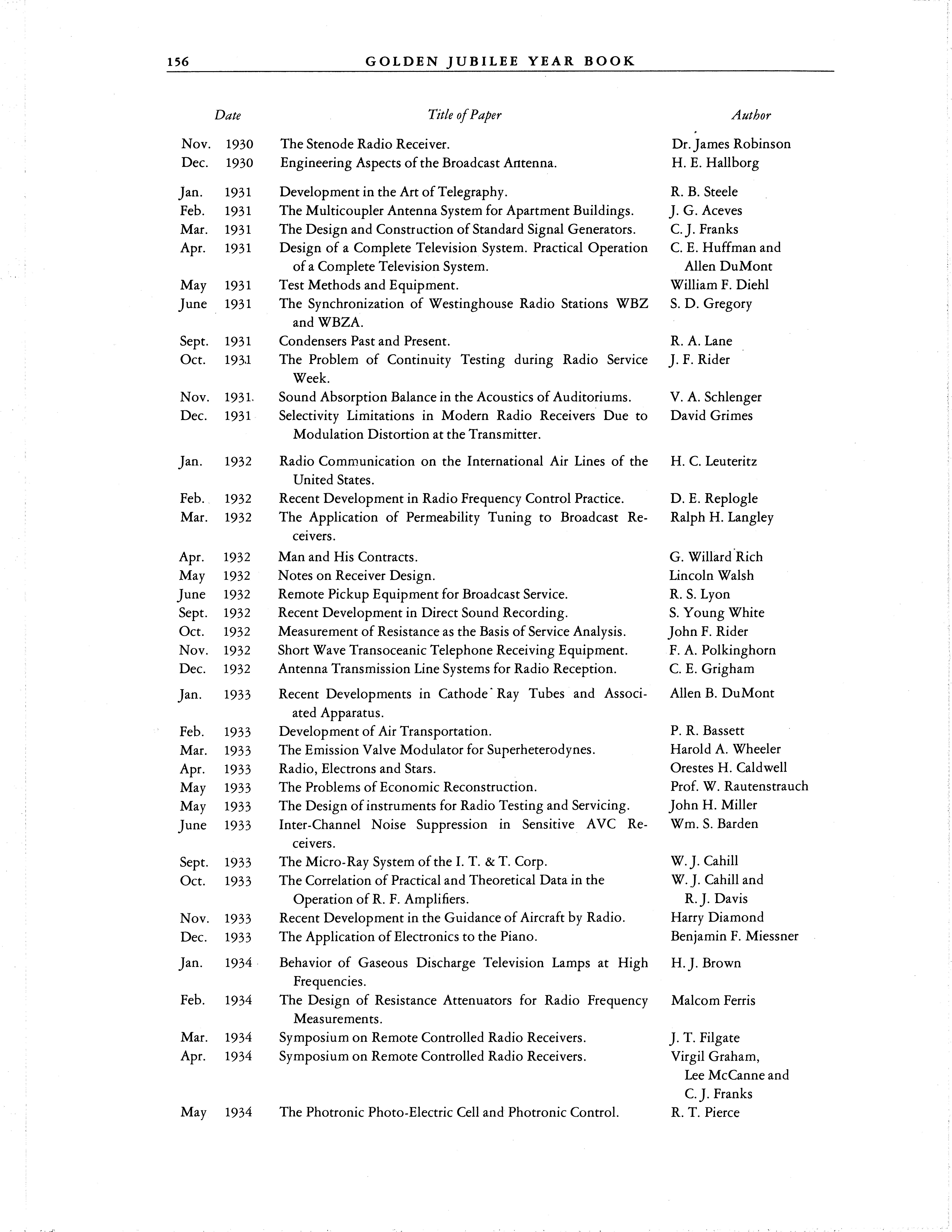
May 1934
The Photronic Photo-Electric Cell and Photronic Control
Dr James Robinson
H. E Hallborg
R. B. Steele
J G Aceves
C J Franks
C E Huffman and Allen DuMont
William F Diehl
S D Gregory
R A Lane
J F Rider
V. A. Schlenger
David Grimes
H. C. Leuteritz
D. E. Replogle
Ralph H Langley
G Willard Rich
Lincoln Walsh
R. S. Lyon
S. Young White
John F. Rider
F A Polkinghorn
C E Grigham
Allen B. DuMont
P R Bassett
Harold A Wheeler
Orestes H Caldwell
Prof. W. Rautenstrauch
John H. Miller
Wm. S. Barden
W J Cahill
W J Cahill and R.J. Davis
Harry Diamond
Benjamin F Miessner
H.J. Brown
Malcom Ferris
J. T. Filgate
Virgil Graham, Lee McCanne and C J Franks
R T Pierce
GOLDEN JUBILEE YEAR BOOK 156
Title of Paper Author Date
Date
June 1934 Sept. 1934
Oct. 1934
Nov 1934 Dec. 1934

Multiple Address Radio Printer Systems.
The Importance and Technique of Performance Measurements on Radio Telephone Transmitters
All-Wave Receiver Problems.
The Broadcasting Antenna
Author
W. G. H'. Finch
W C Lent
Murray G Clay
A. B. Chamberlain and W. B. Lodge
Broadcast Antennae and Transmission Lines as used by the J. A. Chambers Crosley Stations, WLW, WSAI and W8XAL.
3
1
2
3
Experiments
Author
F H. Shepard,Jr
L A Kelley
I G Maloff
J G Aceves
Vesper A Schlenker
Harlan True Stetson, Ph D
Leslie F Curtis
JamesJ Lamb
Allen W. Hawkins
C. M.
Lincoln Walsh
Charles R Burrows
Paul Zottu
G
RADIO CLUB OF AMERICA , Inc. 157
Title
of Paper
to 1958 Title of Paper 1 Miscellaneous Applications of Vacuum Tubes 2 An Analysis of Coupled Tuned Circuits at Radio Frequencies
1935
The Cathode
Reception
Problems
All-Wave Noise
Soundproofing Apartment Houses
Radio
Cosmic Cycles and Radio Transmission
Ray Tube in Television
4
of
Reducing Antenna Design 1
for
2
Vol No. Date s
June, 1935 12 Sept 12
:
Oct. 12 Nov. Feb., 1936 12 | 13 >ly 13 3 Ignition Disturbances 4 Some Aspects of Interference and Noise Reduction in Communication Type Receivers Radio Interference
Factors
Relating to Faithful Reproduction
High Fidelity Radio Reception
The Surface Wave in Radio Propagation
Meter Wavelengths
in Generation, Detection and Measurement at one
the Broad Band Crystal Filter to Broadcast Receivers
A New Inductance Tuning System
The Application of the Automatic Radio Direction Finder to Aerial Navigation 3 The Present State of Development of Radio Instrument Airplane Landing Systems in this Country and Abroad 4 An Analysis of All-Wave Receiving Antenna Systems New Paths to Guide Centimeter Radio Waves Television and the Radio Engineer 5 Unbending the Ginks The Finch System of Home Facsimile Oct. Nov. 13 I 13
The Application of
1
2
Sinnett
Mar., 1937 14 Aug 14 Alexis Guerbilsky Dec. 14 Feb., 1938 Paul Ware H Busignies 15 Feb. 15 E. N. Wendell Mar. 15 May J. G. Aceves G C Southworth
F Murray J N Whitaker Described by R. H. Marriott Garrard Mountjoy R E Mathes 15 Sept. 15 Dec 6 Push-Button Tuning Organization of Plant in a Central Radio Telegraph Office 1 An Automatic Spectral-Sensitivity Curve Tracer Transmitter Circuit Design for Frequencies above 100 Megacycles 2 Frequency Modulation in Radio Broadcasting A New Armstrong Frequency-Modulated-Wave Receiver 15 16 T. B Perkins O. E. Dow Apr., 1939 July 16
Albert
W Fyler and J A Worcester
2

3
2
3
4 High-Q Coils at Audio Frequencies
5 The Television Picture Tube
6 Recent Improvements in Master Antenna Systems
7
on Radio Equipment in Aviation
Irwin R Weir
H H Scott
M. Katzin
Donald G Fink
A. E. Frost
H B Martin
J B Schaefer
R C Hergenrother
J. G. Aceves
F. X. Rettenmyer
J R Poppele
J F Morrison
E J Content
J. P. Maxfield
Harry F. Olson
Jerry Minter
Frank W Stellwagen
Henry P Thomas
W. R. Ferris
H M. Wagner
O E Dow
J. H. Nicholson
P. Deforrest McKeel
L E Packard
James R Hancock
Frank T. Turner
J M Van Beuren
Jerry B Minter
Allen B DuMont
Thomas T Goldsmith,
Jr -
Henry E. Hallborg
Dr. P. S. Christaldi
I. E Lempert
John R Ragazzini
Jerry Minter
Eugene R. Shenk
Dr. L. Grant Hector
Oswald G Villard,Jr.
D. A Griffin
Dr. P. C. Goldmark
Dr I G Maloff
Paul Ware
Dr Harner Selvidge
Thurlow M Gordon,Jr.
A H Stillman
Jerry Minter
GOLDEN JUBILEE YEAR BOOK 158 Author
Title of Paper
Comparative Field Tests of Frequency Modulation and Amplitude Modulation Transmitters Electrical Wave Analyzers
Ultra-High-Frequency Propagation 1 Recent
Television
Progress in
Technique
Intercontinent Telegraphy via Long Ocean Cables
Motorboat Ship-Shore Radio-communication System
FM
Economic
Audio Facilities
FM Studio Acoustics
Fidelity 1 Extending the Range of Acoustic Reproducers 2 Signal-Measuring Devices
Crystal Cutter and Channel
Lateral Recording 4 Measurement of Carrier Deviation and Average Value in Frequency-Modulation Transmitters The Orbital-Beam Multiplier Tube for 500-Megacycle Amplification Applications of the Inductive Output Tube 5 Communication Circuits of the Federal Airways Radio Teletype Transmission to Ground Stations and Aircraft 1 Impedance Measurements Over a Wide Frequency Range 2 Wire Transmission of News Pictures Vol. No Date July 16
Bibliography
and its
Advantages New Transmitter Circuit for FM
for
for High
3
for
Sept. 16 Feb., 1940 17 Mar. Apr , 1940 May June 17 17 17 17 July 17 Oct 17 Jan , 1941 18 Feb 18 Apr 18 j Aug. 18
Dec. 18
Apr , 1942 19
Dec. 19 Dec , 1943 1 Taming the High Frequency Signal Generator 20 1 Television Broadcast Coverage Jan , 1944 21
Dec 2 Sun, Earth, and Short-Wave Propagation 1 Application Techniques for Cathode Ray Tubes 21 Nov., 1945 22 Dec 2 Fluctuation Voltages in Receiver Input Circuits 1 Audio Distortion in Radio Reception 2 Controlled and Uncontrolled Multivibrators 2 The Radio Proximity Fuze Radio Countermeasures: The Science of Immobilizing Enemy Radar 4 Frequency Deviation Reception 5 Color Television Projection Television Inductive Tuning System for FM-Television Receivers 6 Guided Missiles in World War II 1 Top-Loaded Antennas Summary of: Facsimile Communications Measurements on FM Receivers 22 Jan , 1946 23 Feb. 23 Mar. 23
Apr. 23 May 23 Oct Jan , 1947 23 24
2
3
1
2
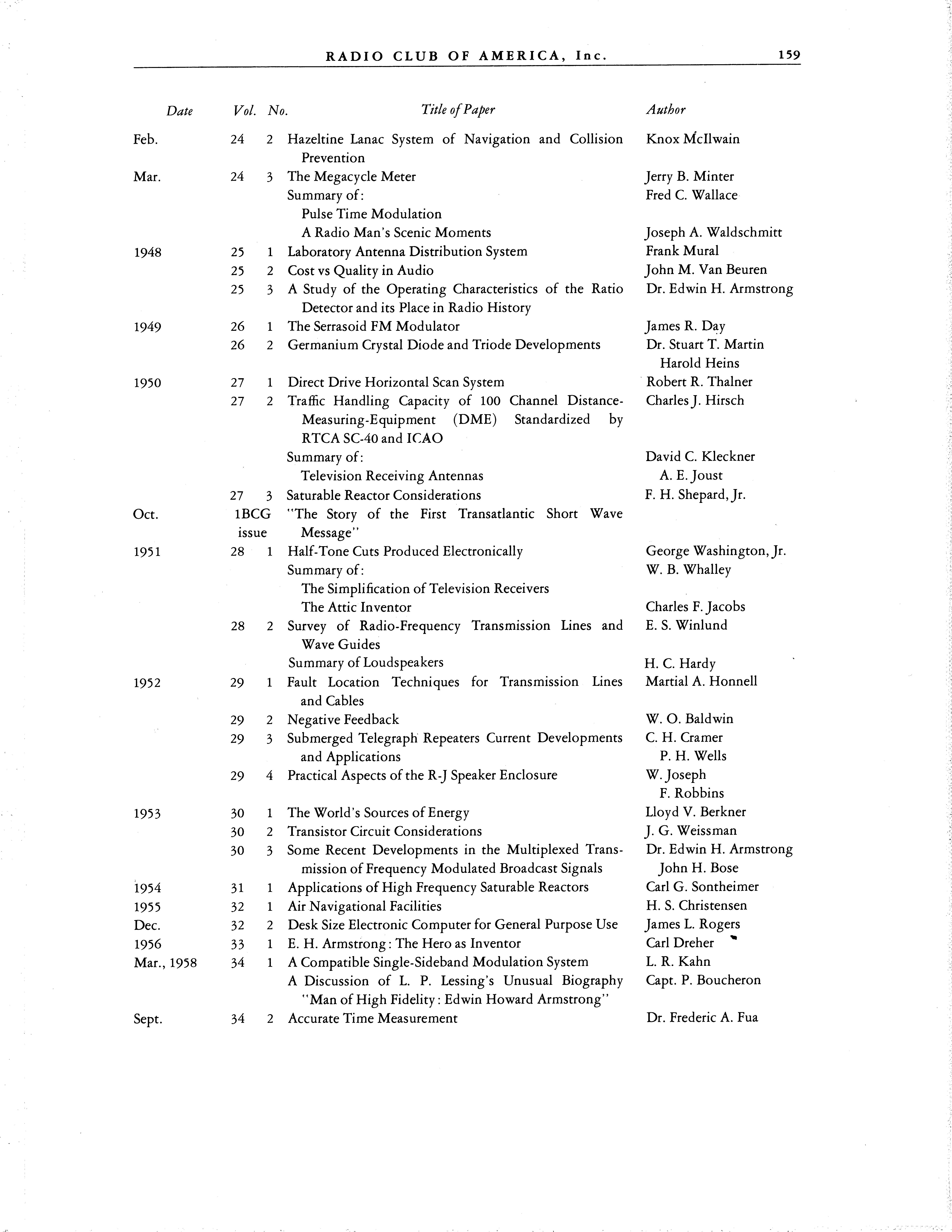
3
2
Author
Knox
Jerry B Minter
Fred C. Wallace
Joseph A. Waldschmitt
Frank Mural
John M Van Beuren
Dr. Edwin H Armstrong
James R. Day
Dr. Stuart T. Martin
Harold Heins
Robert R Thalner
CharlesJ Hirsch
David C.
F. H. Shepard,Jr.
George
Charles F.Jacobs
E. S. Winlund
H. C. Hardy
Martial A Honnell
W. O. Baldwin
C. H. Cramer
P. H. Wells
W Joseph
Robbins
Lloyd V Berkner
J G Weissman
Dr. Edwin H. Armstrong
John H. Bose
Carl G Sontheimer
H S Christensen
James L Rogers
Carl Dreher *
L. R. Kahn
Capt. P. Boucheron
RADIO CLUB OF AMERICA , Inc. 159 Title of Paper 2 Hazeltine Lanac System of Navigation and Collision Prevention 3 The Megacycle Meter Summary of : Pulse Time Modulation A Radio Man’s Scenic Moments 1 Laboratory Antenna Distribution System
Cost vs Quality in Audio
A Study of the Operating Characteristics of the Ratio Detector and its Place in Radio History
The Serrasoid FM Modulator
Germanium Crystal Diode and Triode Developments
Vol No Date
Mcllwain Feb 24
Mar 24
1948 25 25 25
1949 26 26 1 Direct Drive Horizontal Scan System 2 Traffic Handling Capacity of 100 Channel DistanceMeasuring-Equipment (DME) Standardized by RTCA SC-40 and ICAO Summary of : Television Receiving Antennas
Saturable Reactor Considerations 27 1950 27
Kleckner
A E Joust
27 1BCG "The Story of the First Transatlantic Short Wave issue Oct. Message” 1 Half-Tone Cuts Produced Electronically Summary of: The Simplification of Television Receivers The Attic Inventor
Washington,Jr
28 1951
W. B. Whalley
Survey of Radio-Frequency Transmission Lines and Wave Guides Summary of Loudspeakers
Fault Location Techniques for Transmission Lines and Cables 2 Negative Feedback 3 Submerged Telegraph Repeaters Current Developments and Applications 4 Practical Aspects of the R-J Speaker Enclosure 28
1
1952 29
F
29 29 ' 29 1 The World’s Sources of Energy 2 Transistor Circuit Considerations 3 Some Recent Developments in the Multiplexed Transmission of Frequency Modulated Broadcast Signals 1 Applications of High Frequency Saturable Reactors 1 Air Navigational Facilities 2 Desk Size Electronic Computer for General Purpose Use 1 E H Armstrong: The Hero as Inventor 1 A Compatible Single-Sideband Modulation System A Discussion of L. P. Lessing’s Unusual Biography "Man of High Fidelity: Edwin Howard Armstrong” 2 Accurate Time Measurement 1953 30 30 30 1954 31 1955 32 Dec 32 1956 33 Mar., 1958 34 Dr Frederic A Fua Sept 34
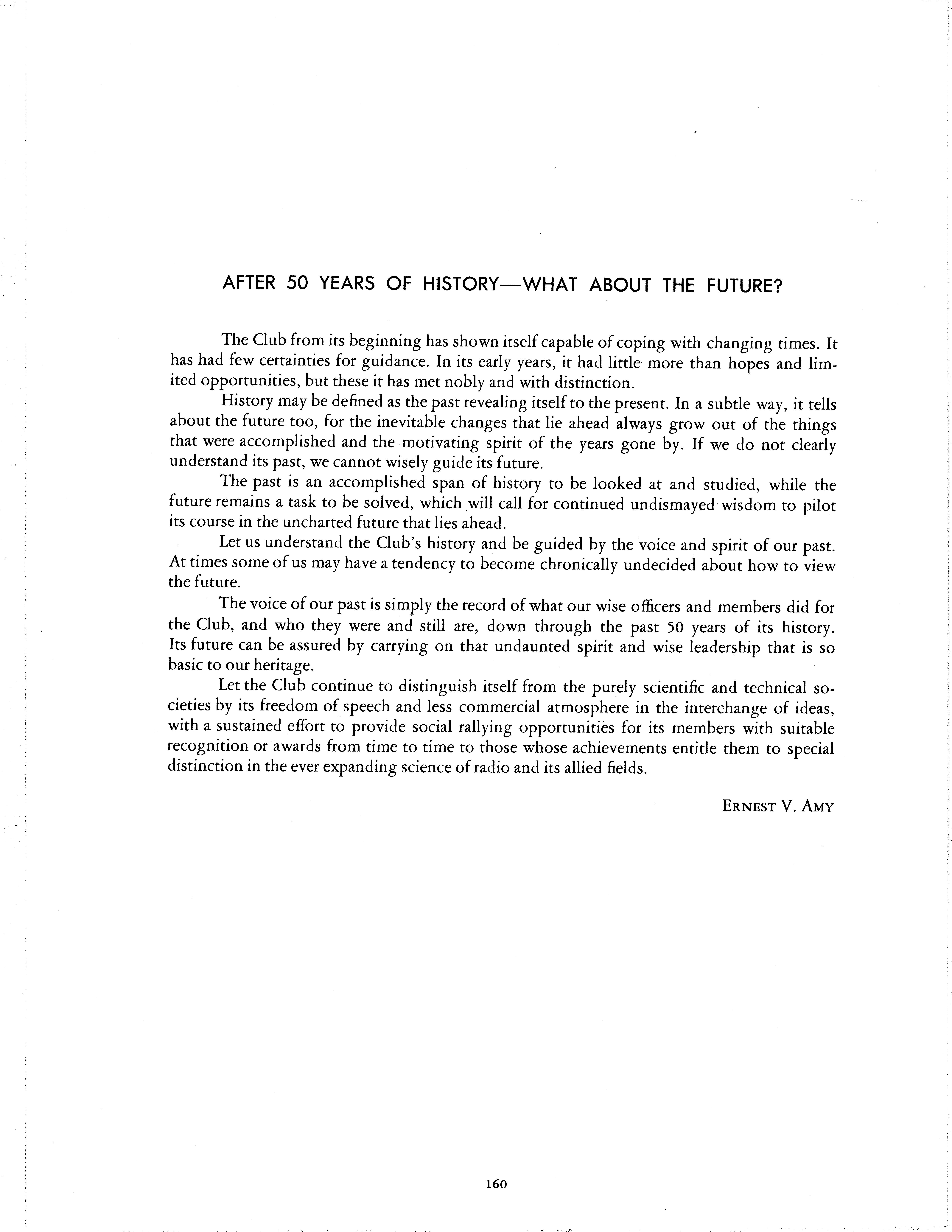
AFTER 50 YEARS OF HISTORY WHAT ABOUT THE FUTURE?
The Club from its beginning has shown itself capable of coping with changing times. It has had few certainties for guidance In its early years, it had little more than hopes and limited opportunities, but these it has met nobly and with distinction.
History may be defined as the past revealing itself to the present In a subtle way, it tells about the future too, for the inevitable changes that lie ahead always grow out of the things that were accomplished and the motivating spirit of the years gone by If we do not clearly understand its past, we cannot wisely guide its future.
The past is an accomplished span of history to be looked at and studied, while the future remains a task to be solved, which will call for continued undismayed wisdom to pilot its course in the uncharted future that lies ahead.
Let us understand the Club’s history and be guided by the voice and spirit of our past At times some of us may have a tendency to become chronically undecided about how to view the future
The voice of our past is simply the record of what our wise officers and members did for the Club, and who they were and still are, down through the past 50 years of its history Its future can be assured by carrying on that undaunted spirit and wise leadership that is so basic to our heritage
Let the Club continue to distinguish itself from the purely scientific and technical societies by its freedom of speech and less commercial atmosphere in the interchange of ideas, with a sustained effort to provide social rallying opportunities for its members with suitable recognition or awards from time to time to those whose achievements entitle them to special distinction in the ever expanding science of radio and its allied fields ERNEST
160
V AMY
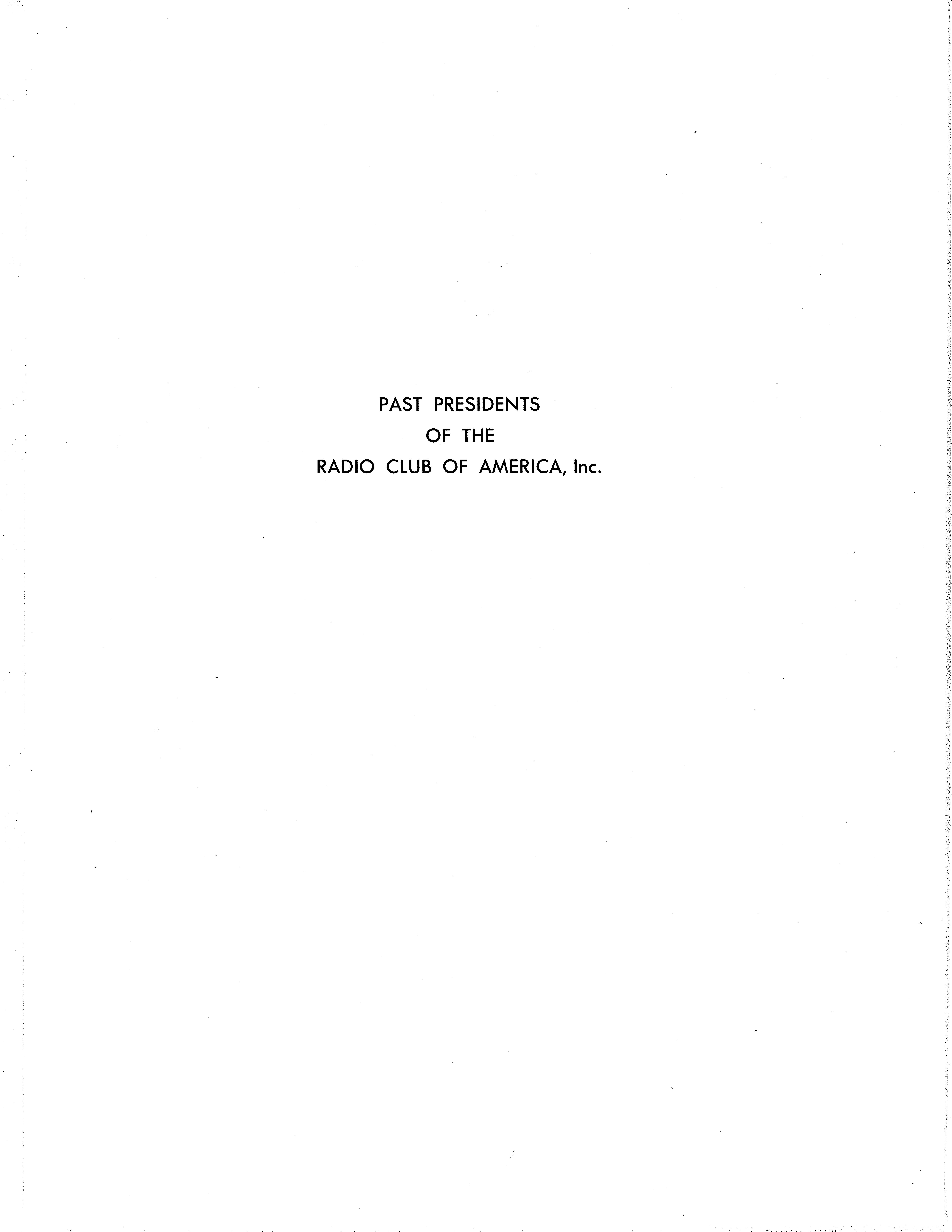
PAST PRESIDENTS OF THE RADIO CLUB OF AMERICA, Inc.
: ; :

GOLDEN JUBILEE YEAR BOOK 162
Frank King 1911-1914
W. E. D StokesJr. 1909-1911*
:
GeorgeJ. Eltz.Jr 1915
Edwin H. Armstrong 1916-1920
George E Burghard 1921-1925
Ernest V Amy 1926-1928
‘President,Junior Wireless Club, Ltd.

RADIO CLUB OF AMERICA , Inc. 163
Harry Sadenwater 1931
Lewis M Clement
Louis G Pacent 1930 1929
Harry W. Houck 1934
Lawrence C F Horle
Charles W Horn 1933 1932

GOLDEN JUBILEE YEAR BOOK 164
Ralph H. Langley 1935-1936
John H. Miller 1937-1938
V *>#
Paul F Godley 1939
Keith Henney 1940
John L. Callahan
Paul Ware 1942-1943 1941
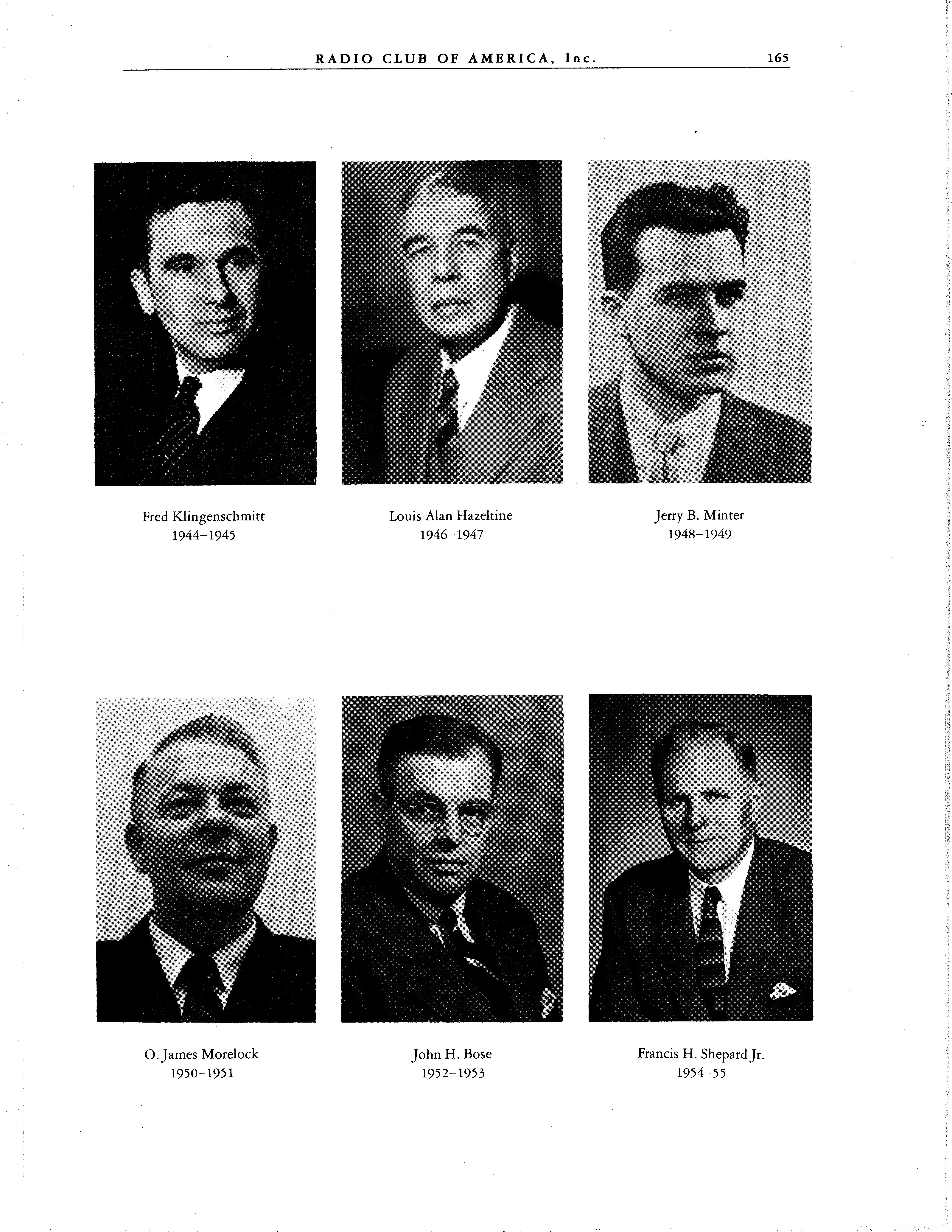
: RADIO CLUB OF AMERICA, Inc 165 } 5 ft I 8 i {
Louis Alan Hazeltine 1946-1947
Fred Klingenschmitt 1944-1945
8 : ! I 8 is i > i
Jerry B Minter 1948-1949
O James Morelock 1950-1951
Francis H. ShepardJr 1954-55
John H Bose 1952-1953

GOLDEN JUBILEE YEAR BOOK 166:
Walter A Knoop 1958-59
-
Frank A Gunther 1956-57
GeorgeJ Eltz,Jr
TheophilusJohnson,Jr
Louis G Pacent
Davis S Brown,Jr
Lawrence C. F. Horle
Ernest V Amy
Paul F. Godley
John DiBlasi

PAST VICE PRESIDENTS
1909-14 (J.W.C.)
1916-18
1915 & 1920
1919
1921 & 1931
1922
1923-1925
1926
C. Randolph Runyon,Jr. 1927
Lewis M. Clement
Carl Dreher
Charles E. Maps
Harry W Houck
F. X Rettenmeyer
John H. Miller
W. Faitoute Munn
George E. Burghard
Louis G. Pacent
TheophilusJohnson,Jr.
ThomasJ. Styles
Walter S. Lemmon
Lewis M. Clement
Lawrence C F Horle
Pierre Boucheron
Arthur H Lynch
Davis S Brown,Jr
William T. Russell
Charles E Maps
Harry W. Houck
F. X. Rettenmeyer
1928
1929
1933
1934
1935
1936
John F Farrington
Fred A. Klingenschmitt
Keith Henney
John L. Callahan
Paul Ware
Charles E Dean
James O. Morelock
Robert M. Akin,Jr.
George C. Connor
John H. Bose
Ralph R. Batcher
Frank A. Gunther
Walter A Knoop,Jr
Renville H McMann,Jr
PAST RECORDING SECRETARIES
1909-11 (J.W.C.)
1911-13
1914
1915
1916
1917-20
1921
1922
1923
1924-26
1927
1928
1929
1930-32
1934-38
Charles E Dean
Carl F. Goudy
Elmar H. Lewis
Lucius E. Packard
John H. Bose
Perce B Collison
Bernard D. Loughlin
Frank H. Shepard,Jr
Virgil M Graham
William G. Russell
Albert F Toth
John H. Bose
John H Bose
C. R. Runyon, III
1937
1938
1939
1940
1941
1942-43
1944-45-46-47
1948
1949
1950
1951-52-53
1954-55
1956-57
1958-59
1939
1940
1941
1942-43
1944-48
1949
1950
1951
1952-53
1954
1955
1956
1957
1958-59
RADIO CLUB OF AMERICA , Inc. 167
Frank King
David S Brown,Jr
ThomasJ Styles
Renville H. McMann
J L Bernard
Wille K. Wing
R H Langley

PAST TREASURERS
Frederick Seymour
Ernest V Amy
John DiBlasi
1909-10 (J.W.C.)
1911-20
1921-25
C Randolph Runyon,Jr 1926
JosephJ. Stantley
1927 to Date
PAST CORRESPONDING SECRETARIES
1909-1911 (J.W.C.)
1912-1916
1917-20 & 1925-27
1921-24
Lincoln Walsh
James O Morelock
Milton B. Sleeper
Harry Sadenwater
1941
1942-43
1944-45
1946-47
1948 1928
George C. Connor
1949 1929-32
1933
Fred A. Klingenschmitt 1934-35-36-37
Fred Muller
John L Callahan
Charles E Dean
1938
1939
1940
John H Bose
Ralph R Batcher
Bernard D. Loughlin
Francis H Shepard,Jr
O.James Morelock
1950
1951
1952-53 1954-to date
GOLDEN JUBILEE YEAR BOOK 168
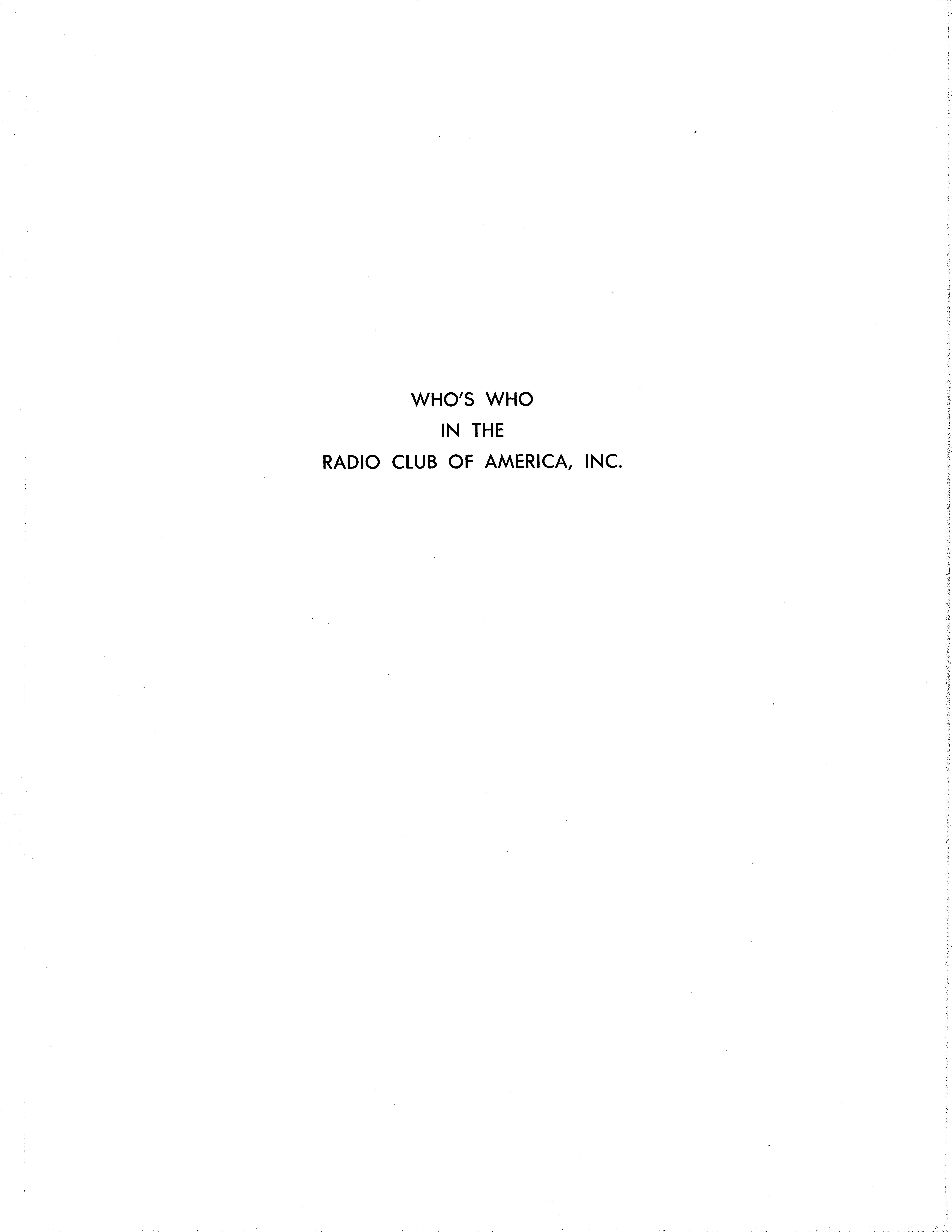
WHO'S WHO IN THE RADIO CLUB OF AMERICA, INC
!
: ; : ; : ;
HONORARY MEMBERS
DR. ALFRED N GOLDSMITH
JOHN V L HOGAN
ROBERT H MARRIOTT
*
PROF MICHAEL I. PUPIN*
HENRY J ROUND
BRIGD. GEN. DAVID SARNOFF
*
JOHN STONE STONE

Editor’s Note: It is our extreme pleasure to present the following articles by four of our Honorary Members, and we wish officially to thank them for their generous and splendid contribution toward thesuccess of this our Golden Anniversary Year Book
i
f
I
PROF. JONATHAN ZENNECK* :
*Denotes Deceased

RADIO CLUB OF AMERICA , Inc 171
Michael I Pupin Honorary Member 1926
Robert H Marriott Honorary Member 1913
John StoneStone Honorary Member 1915

Radio is More Fun Than Ever
Alfred N Goldsmith Honorary Member 1915
If you my readers are expecting a serious, analytic, highly technical, and ultra-scientific article, please turn quickly to the next article in this Golden Year Book. My purpose, in addressing you, has been to re-live the days of old, to enjoy the present, and to taste the thrilling challenge of the future What I write is a young man ’ s reaction to radio then, now, and in the years to come.
Radio was always a young man ’ s game. There was no room in it for anyone but the vigorous, the determined, and the energetic And those who were not resourceful, enthusiastic, and creative people soon knew that radio was not for them. They left our field and doubtless became worthy but stodgy citizens in some other more prosaic activity
In the earliest days of radio, the favorite indoor sports were jumping over hurdles, crawling under obstacles, and rubbing bruised places Every known difficulty was experienced almost every day. We had limited knowledge, or even no knowledge at all, of the underlying laws and the basic facts. There were few suitable materials available for our equipment. Most of these materials were borrowed from the earlier electrical art And they usually were not too appropriate for the new purposes There was an almost complete lack of dependable components. There was no guarantee that equipment that worked yesterday would work today. And there was every doubt that it would work tomorrow And when it did work, it usually had plenty of bugs. Most of these little creatures were only imperfectly understood And we continuously bucked a Secrecy Curtain which was just about as high, thick, and tough as the present Iron Curtain. Most people "in the know” in those days, particularly among the professional engineers, knew how to keep silent in seven languages. But we did get quite a bit of rumor, hearsay, and even misinformation All of this added to the excitement of life as well as the difficulties.
Radio then was great sport for many reasons. We were often not sure what had happened. We never knew what would happen next But each of us had equally adventurous companions and colleagues. And each of us was a member of a very special club We were the people who could handle the mysteries of radio. And the rest of humanity could only look on and wonder
Our lives were full of all sorts of interesting things Many of these are now forgotten. Others have been the foundation stones of new arts We had rotary gaps and synchronous gaps We had quenched spark gaps And we knew that pounding brass had nothing to do with making ornaments for sale in antique shops We had coherers, barreters, magnetic detectors, and perikon detectors. We had pleasantly blue-glowing "soft” tubes and we fought balky and intermittent contacts We ranged from litzendraht to high-frequency alternators. We admired huge wave atennas for low-frequency transoceanic work. And we were nibbling at transoceanic high-frequency circuits.
GOLDEN JUBILEE YEAR BOOK 172
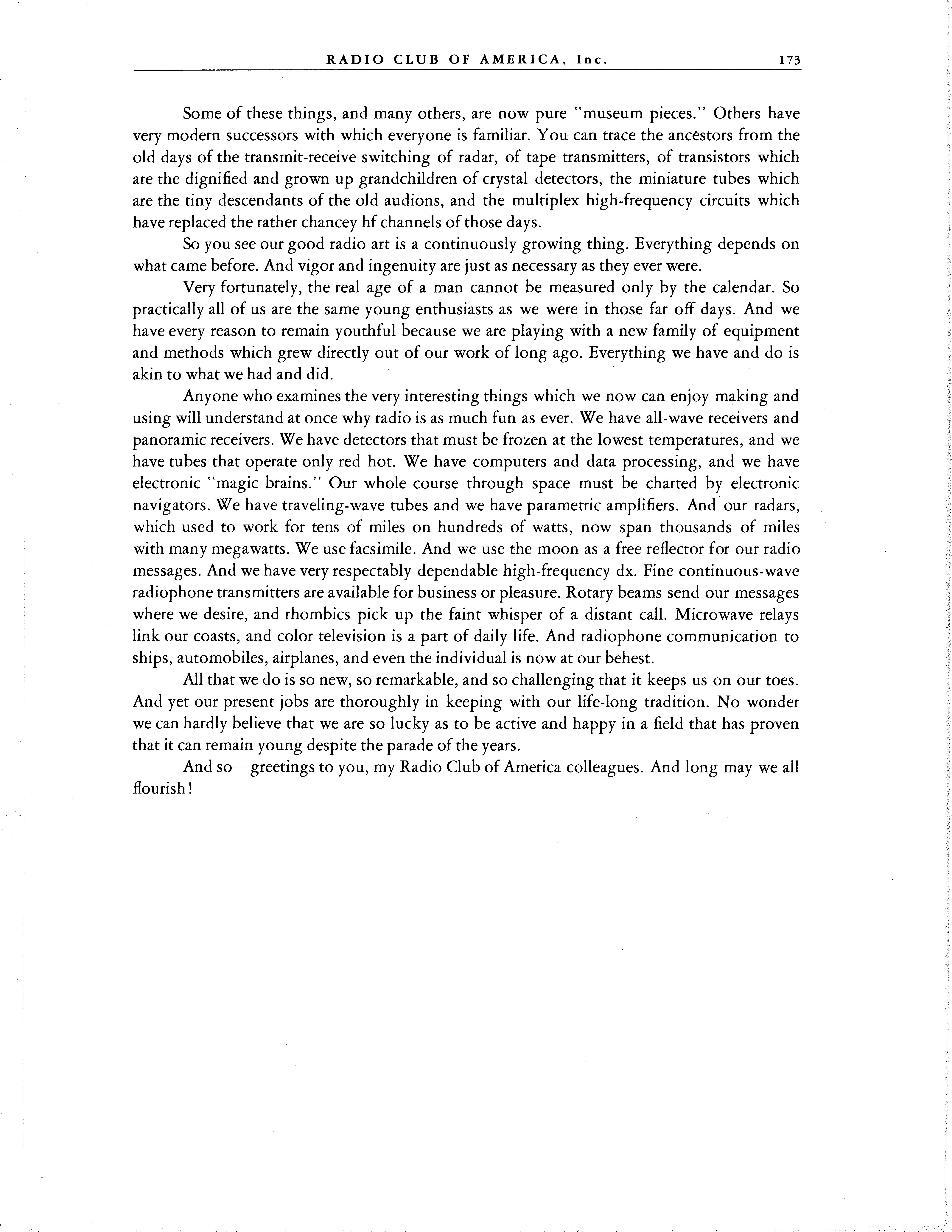
Some of these things, and many others, are now pure " museum pieces.” Others have very modern successors with which everyone is familiar You can trace the ancestors from the old days of the transmit-receive switching of radar, of tape transmitters, of transistors which are the dignified and grown up grandchildren of crystal detectors, the miniature tubes which are the tiny descendants of the old audions, and the multiplex high-frequency circuits which have replaced the rather chancey hf channels of those days
So you see our good radio art is a continuously growing thing. Everything depends on what came before. And vigor and ingenuity are just as necessary as they ever were.
Very fortunately, the real age of a man cannot be measured only by the calendar. So practically all of us are the same young enthusiasts as we were in those far off days. And we have every reason to remain youthful because we are playing with a new family of equipment and methods which grew directly out of our work of long ago. Everything we have and do is akin to what we had and did.
Anyone who examines the very interesting things which we now can enjoy making and using will understand at once why radio is as much fun as ever We have all-wave receivers and panoramic receivers. We have detectors that must be frozen at the lowest temperatures, and we have tubes that operate only red hot We have computers and data processing, and we have electronic "magic brains.” Our whole course through space must be charted by electronic navigators. We have traveling-wave tubes and we have parametric amplifiers And our radars, which used to work for tens of miles on hundreds of watts, now span thousands of miles with many megawatts We use facsimile And we use the moon as a free reflector for our radio messages. And we have very respectably dependable high-frequency dx Fine continuous-wave radiophone transmitters are available for business or pleasure. Rotary beams send our messages where we desire, and rhombics pick up the faint whisper of a distant call. Microwave relays link our coasts, and color television is a part of daily life And radiophone communication to ships, automobiles, airplanes, and even the individual is now at our behest.
All that we do is so new, so remarkable, and so challenging that it keeps us on our toes. And yet our present jobs are thoroughly in keeping with our life-long tradition. No wonder we can hardly believe that we are so lucky as to be active and happy in a field that has proven that it can remain young despite the parade of the years.
And so greetings to you, my Radio Club of America colleagues And long may we all flourish !
RADIO CLUB OF AMERICA , Inc 173
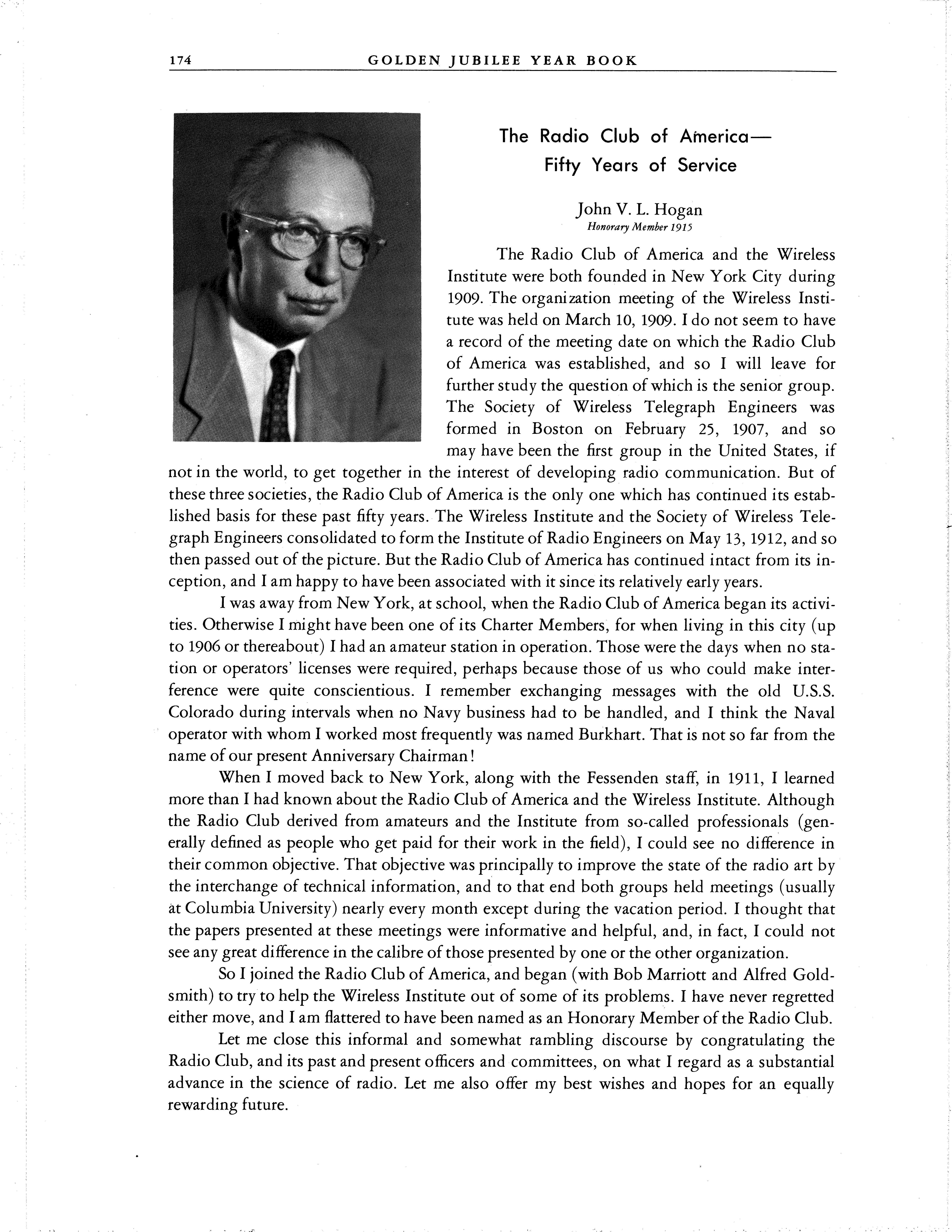
The Radio Club of Arnerica — Fifty Years of Service
John V. L Hogan Honorary Member 1915
The Radio Club of America and the Wireless Institute were both founded in New York City during 1909. The organization meeting of the Wireless Institute was held on March 10, 1909- I do not seem to have a record of the meeting date on which the Radio Club of America was established, and so I will leave for further study the question of which is the senior group. The Society of Wireless Telegraph Engineers was formed in Boston on February 25, 1907, and so may have been the first group in the United States, if not in the world, to get together in the interest of developing radio communication But of these three societies, the Radio Club of America is the only one which has continued its established basis for these past fifty years The Wireless Institute and the Society of Wireless Telegraph Engineers consolidated to form the Institute of Radio Engineers on May 13, 1912, and so then passed out of the picture. But the Radio Club of America has continued intact from its inception, and I am happy to have been associated with it since its relatively early years
I was away from New York, at school, when the Radio Club of America began its activities. Otherwise I might have been one of its Charter Members, for when living in this city (up to 1906 or thereabout) I had an amateur station in operation. Those were the days when no station or operators’ licenses were required, perhaps because those of us who could make interference were quite conscientious I remember exchanging messages with the old U.S.S. Colorado during intervals when no Navy business had to be handled, and I think the Naval operator with whom I worked most frequently was named Burkhart That is not so far from the name of our present Anniversary Chairman !
When I moved back to New York, along with the Fessenden staff, in 1911, I learned more than I had known about the Radio Club of America and the Wireless Institute Although the Radio Club derived from amateurs and the Institute from so-called professionals (generally defined as people who get paid for their work in the field), I could see no difference in their common objective. That objective was principally to improve the state of the radio art by the interchange of technical information, and to that end both groups held meetings (usually at Columbia University) nearly every month except during the vacation period. I thought that the papers presented at these meetings were informative and helpful, and, in fact, I could not see any great difference in the calibre of those presented by one or the other organization
So I joined the Radio Club of America, and began (with Bob Marriott and Alfred Goldsmith) to try to help the Wireless Institute out of some of its problems. I have never regretted either move, and I am flattered to have been named as an Honorary Member of the Radio Club
Let me close this informal and somewhat rambling discourse by congratulating the Radio Club, and its past and present officers and committees, on what I regard as a substantial advance in the science of radio Let me also offer my best wishes and hopes for an equally rewarding future.
174 GOLDEN JUBILEE YEAR BOOK

Things Past, and Things to Come
Henry J. Round Honorary Member 1952
I have had thegreat good fortune to live through a period of acceleration of human knowledge, the like of which may not be seen again
Furthermore, I have had the luck to be an observer standing fairly near the center of this terrific activity. Seventy years ago, the foundation of electrical and magnetic science had not long been laid. It was a new invisible and magic world outside the ordinary world of matter and force. It was then I started to read about these wonderful things and worship at the shrine of such great ones as Edison
The thrill I got when my first wet battery made some sparks and then rang my first electric bell. The electrophorus and its dancing figures, and finally a dry pile which produced a thousand volts or so, gave me many hours of pleasure. And then tumbling over themselves came the big discoveries
First in that line were X-Rays, and many and varied were the theories as to what they were.
The great Clerk Maxwell had a decade or so before established on paper that light was an electrical wave I think he must have had a moment of great exaltation when he found that the ratio of electrostatic and electromagnetic systems of units was the velocity of light, probably only equalled by Newton’s thrill when he found the moon behaved just like an apple.
Maxwell’s work was only on paper but then along came Hertz who made the first manmade electrical waves and really founded our great art. The work had not long been done when I began to take a real interest in things and every week I heard of something new, and that is when I first heard of Wireless Telegraphy.
Just at first little sensational bits of news in the morning papers: "Guglielmo Marconi sends messages without wires over three miles.” Then "Marconi wireless is sent to help in the South African war. ” The "Ships to have wireless sets and talk to one another and to the land ”
The scientists (professors at colleges mostly) were still buried in their ammeters, voltmeters, motors and dynamos and only condescended occasionally to step aside and explain things. They rather looked down on wireless and considered Marconi as a bit of a charlatan
After a normal college career, in which I have often wondered since what I learned, I had the great luck to join the Marconi people in England My own professors were very disgusted, and it was suggested by one of them, a very great engineer by the way, that I would do much better as an electricity station engineer, as electric lighting was the coming thing. But my instincts were right, and from the inside I started to see and help in the development of one of the most important arts in the world, and one which seems to open out into new fields every year We have established now world communication, not quite perfect perhaps but magical in its action and its effect on the human race
RADIO CLUB OF AMERICA , Inc . 175
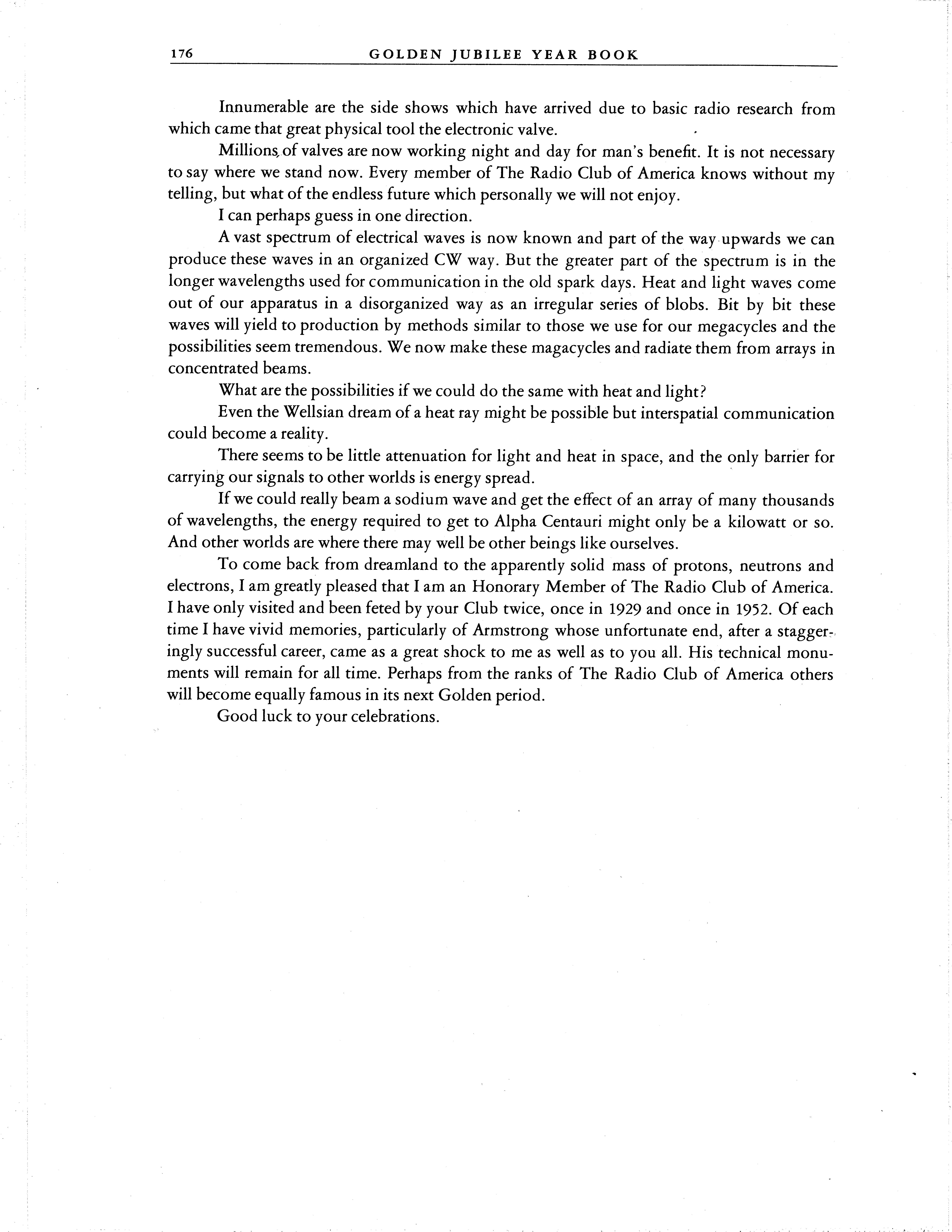
Innumerable are the side shows which have arrived due to basic radio research from which came that great physical tool the electronic valve
Millions,of valves are now working night and day for man ’ s benefit It is not necessary to say where we stand now. Every member of The Radio Club of America knows without my telling, but what of the endless future which personally we will not enjoy
I can perhaps guess in one direction.
A vast spectrum of electrical waves is now known and part of the way upwards we can produce these waves in an organized CW way. But the greater part of the spectrum is in the longer wavelengths used for communication in the old spark days Heat and light waves come out of our apparatus in a disorganized way as an irregular series of blobs. Bit by bit these waves will yield to production by methods similar to those we use for our megacycles and the possibilities seem tremendous. We now make these magacycles and radiate them from arrays in concentrated beams.
What are the possibilities if we could do the same with heat and light?
Even the Wellsian dream of a heat ray might be possible but interspatial communication could become a reality.
There seems to be little attenuation for light and heat in space, and the only barrier for carrying our signals to other worlds is energy spread.
If we could really beam a sodium wave and get the effect of an array of many thousands of wavelengths, the energy required to get to Alpha Centauri might only be a kilowatt or so. And other worlds are where there may well be other beings like ourselves.
To come back from dreamland to the apparently solid mass of protons, neutrons and electrons, I am greatly pleased that I am an Honorary Member of The Radio Club of America. I have only visited and been feted by your Club twice, once in 1929 and once in 1952. Of each time I have vivid memories, particularly of Armstrong whose unfortunate end, after a staggeringly successful career, came as a great shock to me as well as to you all His technical monuments will remain for all time Perhaps from the ranks of The Radio Club of America others will become equally famous in its next Golden period
Good luck to your celebrations.
176 GOLDEN JUBILEE YEAR BOOK
It All Began With Radio
David Sarnoff Honorary Member 1926
The adventurous men who founded the Radio Club of America were, in a very real sense, pioneers in a new age the Electronic Age
It all began with radio with spark coils and slide wire tuners Over the years, the principles of radio were applied to an ever widening area until, today, electronics permeates virtually every aspect of our daily lives.
It has profoundly transformed our concepts of defense, communications, transportation, entertainment, business and industrial operations, and has had a significant impact on our living.
During the past half-century, the Radio Club of America and its members have contributed importantly to the vast evolution from radio to electronics This evolution has manifested itself in five broad phases.
The first phase involved the application of radio principles to communications. This began with wireless telegraphy, and in later years grew into radio-telephone and telegraph communications by long wave, short wave and microwave.
The second phase of electronic development brought radio broadcasting as a service to the public. Over the years, this medium grew from an exciting novelty to a durable force possessing immense cultural and economic impact.
The third phase saw electronics turned with remarkable effect to military uses in World War II. Radar, sonar, loran, shoran and the infrared "sniperscope” were but a few of the devices that figured prominently in the Allied victory.
The fourth phase of electronic development brought television first in black-and-white and now in brilliant color to broaden and brighten the human horizon
The fifth phase of electronics is only just beginning, yet it seems likely to exercise the most profound influence upon our lives. This phase is perhaps most dramatically symbolized by the computer which monitors space explorations, guides missiles, operates automated factories and speeds up accounting and office work.
The crude attic radio devices have long since given way to highly complex and sophisticated instrumentation. But one thing has not changed over the past fifty years. The thrill of experimentation and the excitement of discovery that motivated the founders of the Radio Club of America are as fresh and vibrant today as ever.
It is this perennially youthful spirit of high adventure, and the new knowledge and the new tools with which we can work, which convince me that radio, television and electronics will make vastly greater progress in the next fifty years than they have in the last fifty
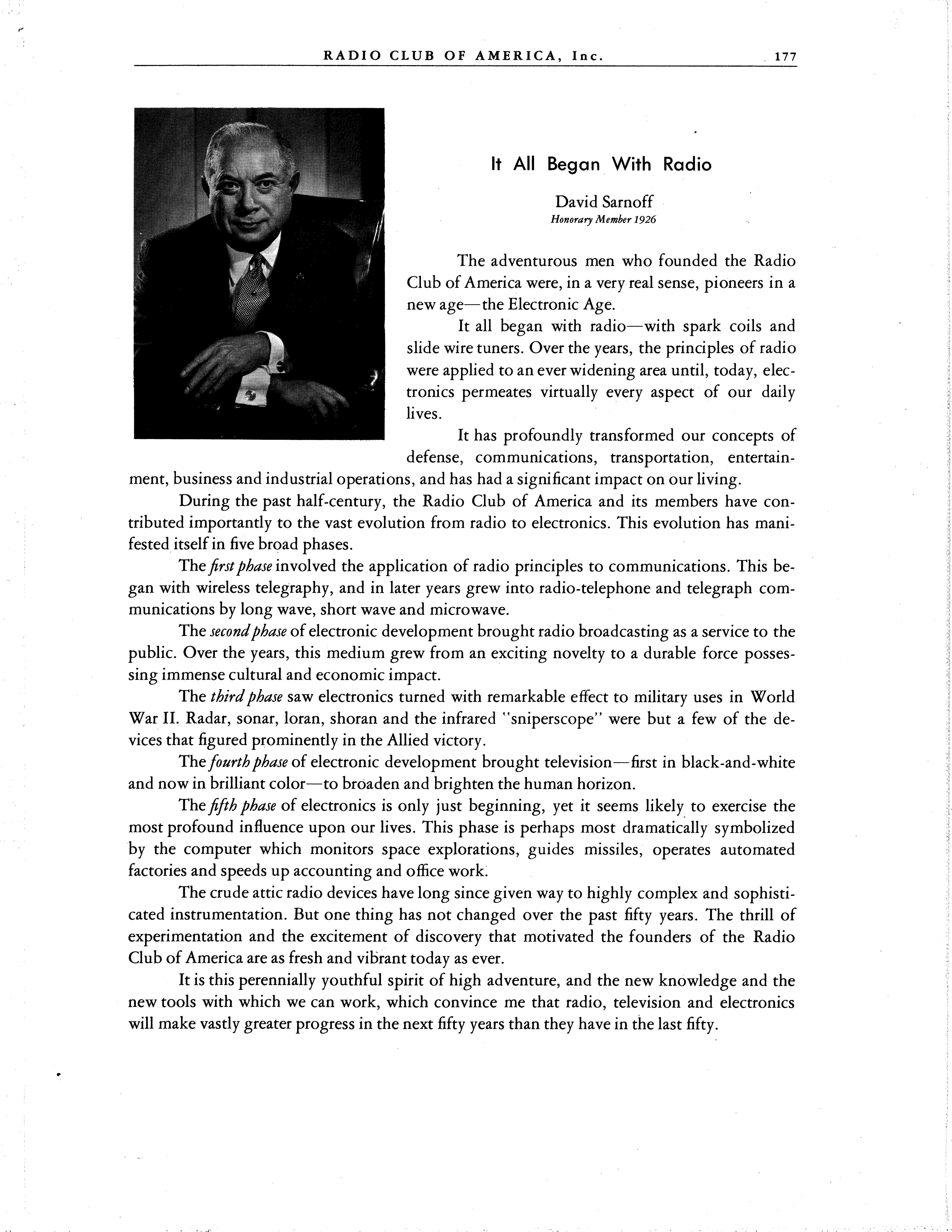
RADIO CLUB OF AMERICA , Inc. 177
The RADIO CLUB OF AMERICA
11 West 42nd Street NEW YORK CITY
Gentlemen,

Editor’s Note: Dr Zenneck was to have sent us an article for the Year Book but unfortunately and to the great regret of the Radio World he died in April 1959 In lieu of the article we print below a copy of his last letter to the Radio Club in 1948. It will no doubt prove of interest to our members, particularly the early pioneers whose studies always included Dr. Zenneck’s famous book, "Electromagnetic Oscillations and Wireless Telegraphy,” published in 1906
June 17, 1948.
Thank you very much for the YEAR BOOK of the RADIO CLUB of America which you kindly sent me
I was much impressed by the list of papers read before the club since 1913 and of their authors The high standard of scientific activity of the club could not be better demonstrated than by this list
The list of the deceased members of the club contains quite a number of scientists and engineers I have known personally or by their publications I am especially sorry to see from the list that John Stone died I used to know him very well and appreciated him very much. Up to the beginning of the last war I was in intermittent correspondence with him He certainly was an outstanding pioneer during the early time of radio telegraphy
Sincerely yours
(Signed)J Zenneck
Prof Dr J Zenneck
Allhegenberg 67
Uber Mering (13b)
Bayern Deutschland
U S Zone
GOLDEN JUBILEE YEAR BOOK 178
Jonathan Zenneck Honorary Member 1916
MEMBERSHIP OF THE RADIO CLUB OF AMERICA, INC.
ADAMS, ROBERT H. Ill (M) 1956 - Field Engineer, Electronic Instrumentation Manufacturers Rep.; education, B.S. Psychology, Rutgers University; Military Service USAF Auto Missile Tracting Officer,1st.Lt.USAF;amateur call letters K2BTC, 6 yrs; hobbies, amateur radio, flying, res. 7 Standish Ct., Tenafly, N. J. b. Feb. 4,1950, N.Y.C.

The Experimenter”; Technical Editor “Ra- tf it
ADELMAN, LEON L. (F) 1950 - Sales Representative,Leon L. Adelman Co., 25 Chittenden Ave , N Y C. 33; b. Russia, August 19th, 1903; married; ed. Syracuse Central High School, Brooklyn Polytech 1 year, Cooper Union1 year; Amateur since 1917; W2AFS since 1923; Charter Member - Syracuse Radio Amateur Club, 1917; Syracuse Central High Radio Club, 1921; Bronx Radio Club 1921; F.A.D. Andrea 1922/1923; Radio Editor “Science and Invention dio News”, Associate Editor “Amateur Radio”, “Radio World” 1923/1926, Assistant Advertising Manager of Chas. Freshman Co 1926/1927; Sales Manager for A M Flechtheim & Co.1927/1932,Sales Manager Cornell-Dubilier Corp 1934/1944; Manufactured “Supreme AF-100” All-band AM-FM Transmitters 1946/1948; Member Planning Committee for “ HugoGernsbackTestimonial Trophy” at Chicago, May 17th, 1953
AKIN, ROBERT M., JR. (F) 1925 - President, Hudson Wire Co., Ossining, N. Y.; res. Evergreen Way, North Tarrytown, N. Y.; ed. Morristown Preparatory; interested in radio since 1918; b.Ossining, N. Y., June 26,1904; Professional Experience - Westchester Radio Laboratories 1923/1929, Director of Research, Hudson Wire Co.1934; Radio Club of America Vice President 1948.
ALBERTSON, FRED (WOODWARD) (M) Munsey Bldg., Washington 4, D. C.; American lawyer and engineer; radio and communications legal counsel for radio, television, telegraph, telephone and broadcasting companies and stations since 1935; partner in Dow, Lohnes & Albertson (specializing in communications, radio and air law), Washington, D. C , and N.Y.C , since 1944 engaged in research on Dualex communications systems and products since 1948; Licensed radio operator since 1924; b. 1908; educ. University of Michigan (A.B.1931; LL.B. 1934); m.1942, Catherine Frances Dolan; s. Fred Woodward, Jr.; dau. Helen Dolan. Engineered construction and operation of several radio broadcast and radio telegraph stations 1925/27; radio equipped and handled communications with several remote meteorological expeditions and stations for University of Michigan 1927/34; Admitted to Michigan Bar 1934, District of Columbia Bar 1935, and Supreme Court of the UnitedStates1940; member, Board of Trustees and Director of Delta Theta Phi Foundation 1945/46; Registered Professional ElectricalCommunications Engineer in the District of Columbia; Senior Member, Institute of Radio Engineers (Chairman, Washington, D. C., Section 1946/47; Board of Editors of Proceedings of I.R.E. 1946/54); member, American Institute of Electrical Engineers and The Radio Pioneers:
President, American Federal Communications Bar Assn. 1953/54; Fellow, American Bar Foundation; member, House of Delegates of the American Bar Association 1953/54; Chmn., Standing Cttee. on Communications of the American Bar Association 1957—; member, District of Columbia Bar Association, The American Judicature Society, Delta Theta Phi Law Fraternity; Past VicePresident and Treasurer, Engineers Club of Washington; Past President, Washington Radio Club; co-founder and Past President, University of Michigan RadioClub;member, Congressional Country Club and The Capitol Hill Club (Washington, D. C.); Licensee amateur radio station W3FMC and W4FMC. Address: Munsey Building, Washington 4, D. C., and 3512 One Wall Street, New York City 5, and (home) 3753 Jenifer Street, N.W , Washington 15, D.C.
ALEXANDER, JAY R. (M) res. 29-01 Borden Ave., Long Island City, N. Y.
ALEXANDER, LOUIS (F) 1924 - Sales Engineer, Cornell Dubilier Elec. Corporation, South Plainfield, N. J.; res. 322 West 72nd St., New York 23, N.Y.; b. New York City, February 1, 1900; married; ed. High School of Commerce, evening courses at Cooper Union and CCNY; Purchasing Agent for DeForest Radio 1918/1921; Sales Engineer Dubilier Condenser Co. 1921/1926; Sales Engineer for Aerovox Corp. 1926/1946 and Sales Engineer for Cornell Dubilier Elec. Corp. 1946 to date; Member IRE and Elmwood Country Club, Elmsford, N. Y.
AMERMAN, EDWARD ANDREW (F) - Electronic Design Engineer, Kay Electric Company, 14 Maple Ave., Pine Brook, N. J.; res 59 Harrison Ave., Roseland, N. J.; b September 16, 1908 at Newark, N. J.; ed. Grammar School Miller Street, Newark; High School East Side Commercial and Manual Training, Newark; Two terms Newark College of Engineering; U.S. ArmySignalSchool, Fort Monmouth, N. J. Graduate U.S. Army Armor Officers Communication School, Fort Knox, Ky.; U.S. Army and New Jersey National Guard since 22nd December 1926, Present status Chief Warrant Officer, Communications Advisor on the Staff of Combat Command “C”, 50th Armored Division (Jersey Blues) at Paterson Armory; Married, two Sons; Sports - Hiking, Hunting,Fishing and Base Ball; Hobbies - Rifle and Hand Gun Shooting, Radio and mechanics; Societies - Member of Radio Club of America since 1938, National Guard Association of the U. S , U. S. Army Armor Association, Military Amateur Radio Society, Armed Forces Communication and Electronic Association, National Rifle Association, Roseland Rifle and Pistol Club, Communication Officers Club, Army and Navy Union of the U.S., National Guard Radio Amateurs Association, Past Post Commander, Post #4 Legion of Guardsman.
AMY, ERNEST V. (CM, LM, F) 1910 - President, Amy, Aceves & King, Inc., Consulting Engineers, organized 1928, 11 West 42nd St., N.Y.C.; res. 61 Bay Blvd., At-
179
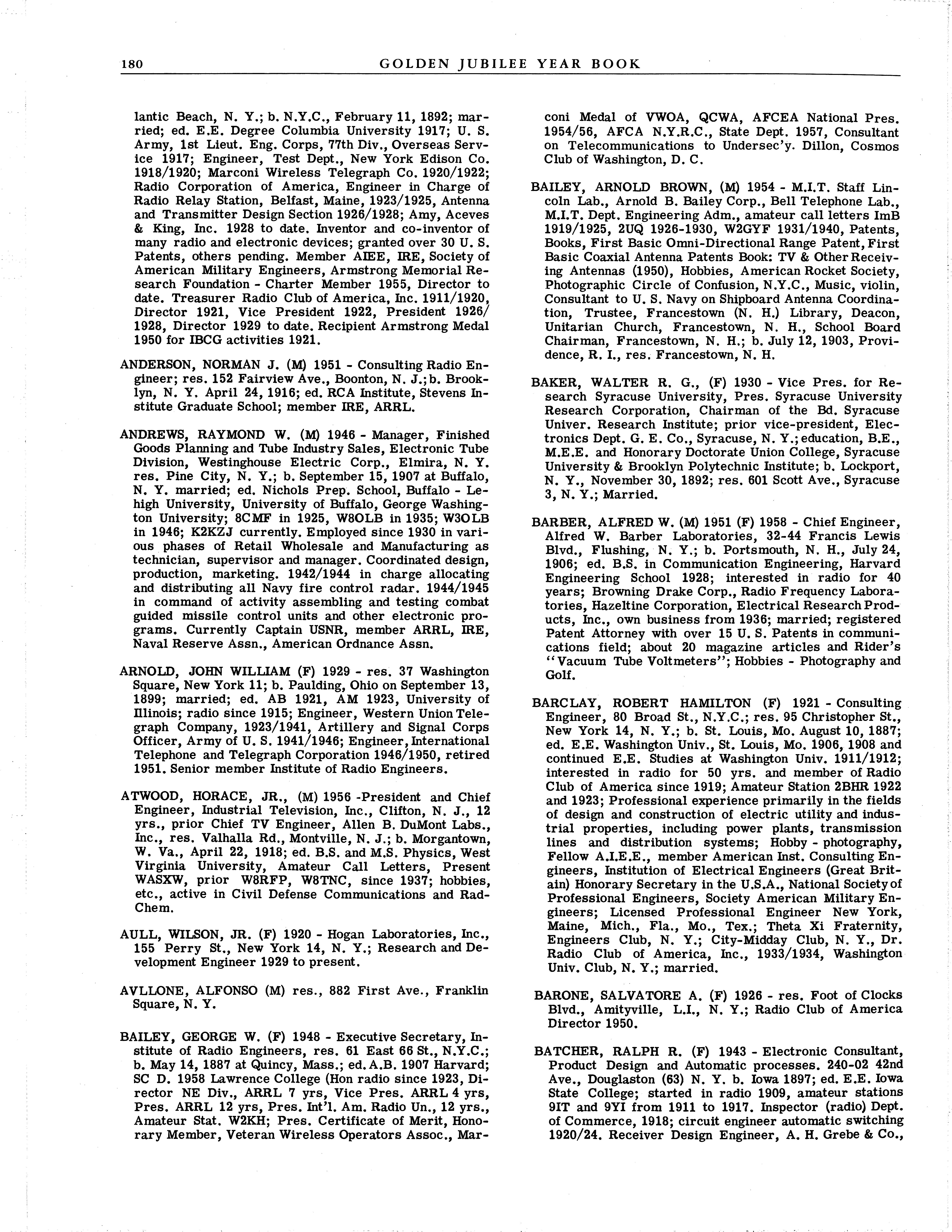
lantic Beach, N. Y.; b. N.Y.C., February 11, 1892; married; ed. E.E. Degree Columbia University 1917; U. S. Army, 1st Lieut. Eng. Corps, 77th Div., Overseas Service 1917; Engineer, Test Dept., New York Edison Co. 1918/1920; Marconi Wireless Telegraph Co.1920/1922; Radio Corporation of America, Engineer in Charge of Radio Relay Station, Belfast, Maine, 1923/1925, Antenna and Transmitter Design Section 1926/1928; Amy, Aceves & King, Inc. 1928 to date. Inventor and co-inventor of many radio and electronic devices; granted over 30 U.S. Patents, others pending. Member AIEE, IRE, Society of American Military Engineers, Armstrong Memorial Research Foundation - Charter Member 1955, Director to date. Treasurer Radio Club of America, Inc.1911/1920, Director 1921, Vice President 1922, President 1926/ 1928, Director 1929 to date.Recipient Armstrong Medal 1950 for IBCG activities 1921.
ANDERSON, NORMAN J. (M) 1951 - Consulting Radio Engineer; res.152 Fairview Ave., Boonton, N. J.;b. Brooklyn, N. Y. April 24, 1916; ed. RCA Institute,Stevens Institute Graduate School; member IRE, ARRL.
ANDREWS, RAYMOND W. (M) 1946 - Manager, Finished Goods Planning and Tube Industry Sales, Electronic Tube Division, Westinghouse Electric Corp., Elmira, N. Y. res. Pine City, N. Y.; b.September 15, 1907 at Buffalo, N. Y. married; ed. Nichols Prep. School, Buffalo - Lehigh University, University of Buffalo, George Washington University; 8CMF in 1925, W80LB in 1935; W30LB in 1946; K2KZJ currently. Employed since 1930 in various phases of Retail Wholesale and Manufacturing as technician, supervisor and manager. Coordinated design, production, marketing. 1942/1944 in charge allocating and distributing all Navy fire control radar. 1944/1945 in command of activity assembling and testing combat guided missile control units and other electronic programs. Currently Captain USNR, member ARRL, IRE, Naval Reserve Assn., American Ordnance Assn.
ARNOLD, JOHN WILLIAM (F) 1929 - res. 37 Washington Square, New York 11; b. Paulding, Ohio on September 13, 1899; married; ed. AB 1921, AM 1923, University of Illinois; radio since 1915; Engineer, Western Union Telegraph Company, 1923/1941, Artillery and Signal Corps Officer, Army of U.S.1941/1946; Engineer,International Telephone and Telegraph Corporation 1946/1950, retired 1951.Senior member Institute of Radio Engineers.
ATWOOD, HORACE, JR., (M) 1956 -President and Chief Engineer, Industrial Television, Inc , Clifton, N. J., 12 yrs., prior Chief TV Engineer, Allen B. DuMont Labs., Inc., res. Valhalla Rd., Montville, N. J ; b. Morgantown, W. Va„ April 22, 1918; ed. B.S. and M.S. Physics, West Virginia University, Amateur Call Letters, Present WASXW, prior W8RFP, W8TNC, since 1937; hobbies, etc., active in Civil Defense Communications and RadChem.
AULL, WILSON, JR. (F) 1920 - Hogan Laboratories, Inc., 155 Perry St., New York 14, N. Y.; Research and Development Engineer 1929 to present.
AVLLONE, ALFONSO (M) res., 882 First Ave., Franklin Square, N. Y.
BAILEY, GEORGE W. (F) 1948 - Executive Secretary, Institute of Radio Engineers, res. 61 East 66 St., N.Y.C.; b. May 14, 1887 at Quincy, Mass.; ed.A.B.1907 Harvard; SC D. 1958 Lawrence College (Hon radio since 1923, Director NE Div., ARRL 7 yrs, Vice Pres. ARRL 4 yrs, Pres. ARRL 12 yrs, Pres. Int’l.Am.Radio Un.,12 yrs., Amateur Stat. W2KH; Pres. Certificate of Merit, Honorary Member, Veteran Wireless Operators Assoc., Mar-
coni Medal of VWOA, QCWA, AFCEA National Pres. 1954/56, AFCA N.Y.R.C., State Dept. 1957, Consultant on Telecommunications to Undersec’y. Dillon, Cosmos Club of Washington, D. C.
BAILEY, ARNOLD BROWN, (M) 1954 - M.I.T. Staff Lincoln Lab., Arnold B. Bailey Corp., Bell Telephone Lab., M.I.T. Dept. Engineering Adm., amateur call letters ImB 1919/1925, 2UQ 1926-1930, W2GYF 1931/1940, Patents, Books, First Basic Omni-Directional Range Patent,First Basic Coaxial Antenna Patents Book: TV & OtherReceiving Antennas (1950), Hobbies, American Rocket Society, Photographic Circle of Confusion, N.Y.C., Music, violin, Consultant to U.S. Navy on Shipboard Antenna Coordination, Trustee, Francestown (N. H.) Library, Deacon, Unitarian Church, Francestown, N. H., School Board Chairman, Francestown, N. H.; b. July 12, 1903, Providence, R. I., res. Francestown, N. H
BAKER, WALTER R. G., (F) 1930 - Vice Pres, for Research Syracuse University, Pres. Syracuse University Research Corporation, Chairman of the Bd. Syracuse Univer. Research Institute; prior vice-president, Electronics Dept. G. E. Co., Syracuse, N. Y.;education, B.E., M.E.E. and Honorary Doctorate Union College, Syracuse University & Brooklyn Polytechnic Institute; b. Lockport, N. Y., November 30, 1892; res. 601 Scott Ave., Syracuse 3, N. Y.; Married.
BARBER, ALFRED W. (M) 1951 (F) 1958 - Chief Engineer, Alfred W. Barber Laboratories, 32-44 Francis Lewis Blvd., Flushing, N. Y.; b. Portsmouth, N. H., July 24, 1906; ed. B.S. in Communication Engineering, Harvard Engineering School 1928; interested in radio for 40 years; Browning Drake Corp., Radio Frequency Laboratories, Hazeltine Corporation, Electrical ResearchProducts, Inc., own business from 1936; married; registered Patent Attorney with over 15 U.S Patents in communications field; about 20 magazine articles and Rider’s “Vacuum Tube Voltmeters”; Hobbies - Photography and Golf.
BARCLAY, ROBERT HAMILTON (F) 1921 - Consulting Engineer, 80 Broad St., N.Y.C.; res. 95 Christopher St., New York 14, N. Y.; b. St. Louis, Mo. August 10, 1887; ed. E.E. Washington Univ., St. Louis, Mo.1906,1908 and continued E.E. Studies at Washington Univ. 1911/1912; interested in radio for 50 yrs. and member of Radio Club of America since 1919; Amateur Station 2BHR 1922 and 1923; Professional experience primarily in the fields of design and construction of electric utility and industrial properties, including power plants, transmission lines and distribution systems; Hobby - photography, Fellow A.I.E.E., member American Inst. Consulting Engineers, Institution of Electrical Engineers (Great Britain) Honorary Secretary in the U.SA., National Societyof Professional Engineers, Society American Military Engineers; Licensed Professional Engineer New York, Maine, Mich., Fla., Mo., Tex.; Theta Xi Fraternity, Engineers Club, N. Y.; City-Midday Club, N. Y., Dr. Radio Club of America, Inc., 1933/1934, Washington Univ.Club, N.Y.; married.
BARONE, SALVATORE A. (F) 1926 - res. Foot of Clocks Blvd., Amityville, L.I., N. Y.; Radio Club of America Director 1950.
BATCHER, RALPH R. (F) 1943 - Electronic Consultant, Product Design and Automatic processes. 240-02 42nd Ave., Douglaston (63) N. Y. b. Iowa 1897; ed. E.E. Iowa State College; started in radio 1909, amateur stations 9IT and 9YI from 1911 to 1917. Inspector (radio) Dept, of Commerce, 1918; circuit engineer automatic switching 1920/24. Receiver Design Engineer, A. H. Grebe & Co.,
GOLDEN JUBILEE YEAR BOOK 180
1924/28; Director of Engineering A. D. Cardwell Corp., till 1944; Editorial Consultant, Electronic Industries, 1944/48. Chief Engineer Electronic Industries Assn, (then RETMA) 1950/54; Professional Engineer N. Y. State; Fellow I.R.E.; Chairman of Board, National Electronics Conference 1955; Director Radio Club of America 1944 to date; Past Pres. Instrument Society, New York Sec., Several patents and author “ Prepared Radio Measurements”, “Cathode Ray Oscillography” “Electronic EngineeringHandbook”,“ElectronicControlHandbook” and several hundred for technical publications.
BAUM, ELMER (M) 1950 - Electrical Engineer, ITT Labs. 500 Washington Ave., Nutley, N. J.; res. 375 Fifth Ave., River Edge, N. J.; b. Brooklyn, N. Y., Nov. 7,1917; ed. B.E.E. Polytechnic Institute of Brooklyn, B.S. EM Fairleigh Dickenson Unit; interested in radio for 28 yrs.; professional experience RCA, Radio Wire TelevisionCo., Signal Corps Labs, and ITT Labs.; married.
BAUNACH, EDWARD L. (M) 1927 - Photoengraver with News Syndicate Co., Inc., 220 East 42nd St., New York 17, N. Y.; res. 2 Westminster St., Massapequa, Long Island, N. Y.; b. New York City, June 19,1907; ed. 8 years grade school, 4 years high school, 2 years college; interested in radio 35 years; Amateur station W2AZV since 1926; married.
BEAN, L. P. R. (F) 1935 - Managing Director,StrombergCarlson (Australasia) Ltd., Box 3971 GPO Sydney, Australia; b. Melbourne, Australia, May 7, 1884 ed. E.E. Melbourne Technical College, University of Perth, Australia; professional experience - manufacturing Radio Receivers, Television and Telephone Apparatus.
BEHR, JOSEPH (F) 1948 - Vice President, RadioEngineering Lab’s, Inc., 29-01 Borden Ave., Long Island City1, N. Y.; res. 118-44 223 St., Cambria Heights, N.Y.; b. N.Y.C., August 22, 1908; ed. Primary and High School graduate, Stuyvesant High School,1925; radio ten years; Associate member Institute of Radio Engineers; Member Armed Forces Communications and Electronics Assn.
BEIN, ALFRED A., (M) 1957, Buyer - Ladies Coats, Arnold Constable,13 yrs., Amateur 6 yrs.,Sports, hobbies, etc. weight lifting, music, dancing, ALFCE and SSBARA, ed., New York University, b. July 6, 1910, The Bronx, N.Y.C.; res, 26 Lenox Ave , Clifton, N. J.
BERNARD, HERBERT S. (F) 1941 - Engr. Ware Marine Products 6763 SW 81 St., Miami, Fla. res. 6321SW 80 St., Miami, Fla. (Automatic Pilot for marine use) President of Ware Marine Prod. b. N.Y.C., July 26,1900; radio since 1912; amateur 1929 to 1947;Air Force, World War I; Hobby - Flying; Patents 2,521,564 and 2,520,749; married.
BERNSTEIN, ROBERT I (M) res. 632 W. 125th St., New York 27, N. Y.
BEVERAGE, HAROLD HENRY (F) 1920 - Director, Radio Research Laboratory, Radio Corporation of America, RCA Laboratories Division, 66 Broad St., New York 4, N. Y.; 1942/1957 Chief Technical Advisor, Communications, 1957/1958. Retired 1958, retained as consultant RCA Lab., Rocky Point, N. Y. Res., Quaker Path,Stony Brook, Long Island, N. Y ; b. North Haven, Maine, October 14, 1893; ed. B.S.E.E. University of Maine, 1915. Honorary Degree, Doctor of Engineering, University of Maine, 1938; interest in radio since 1908; Amateur license in First District 1911/1915, W2BML 1919/1922; General Electric Company 1915/1920, Radio Corporation of America 1920 to date engaged in radio research and development; Institute of Radio Engineers (President
1937), American Institute of Electrical Engineers,American Association for the Advancement of Science, International GeophysicalUnion,AmericanRadioRelayLeague; Hobbies - Amateur photography, sound re-recording; Eight published papers; Forty one U.S.Patents;married.
BIGGS, J. ALLEN (M) 1949 - Sales Engineer, J. Alan Biggs Co., Doylestown, Pa., b. Indianapolis, Ind., January 9, 1911; res. Gardenville, Pa.; ed. State School of Mines, Rapid City, South Dakota; interested in radiothirtyyears; amateur 28 years; W8BXK, W9EH, W8LO, W2ZW, W1ZX, W3ZP; RCA International Division; Lulu Shrine, Philadelphia; Private Pilot, Huntington Valley Hunt Club, QCWA, Farmer
BINNS, JOHN ROBINSON (F) 1916 - Honorary Chairman, Hazeltine Corporation, 58-25 Little Neck Parkway, Little Neck, N. Y.; res. 220 Central Park South, New York 19, N. Y.; b. Lincolnshire, England; ed. Grade Schools and School of Arts and Sciences, Colchester, England; interested in radio since 1904; Marconi Operator 1904/1912 on German, British and U. S. Ships, Operator S/S Republic 1909; with Hazeltine Corporation 1924 to date; Adventurers Club, I.R.E., New York Athletic Club; Society of the Silurians; married.
BOGHOLTZ, RICHARD, JR. (M) res. 5811 Liebig Ave., Bronx 71, N. Y.
BOHMAN, ALBERT KASPER (F) 1926 - Staff Assn, toManager Ground Operation, Pan American Airways, International Airport, Miami, Fla.; res. 11705 N.E. 7th Ave., Miami 38, Fla ; b. Long Island City, N. Y. on August 9, 1900; ed. Grade and High School, N.Y.C., Brooklyn Polytechnic Institute, Brooklyn, N. Y.; interested in radio forty years; Engineering Department, Radio Corporation at Marion, Mass., New Brunswick, N. J. and 66 Broad St., N.Y.C. from 1920 to February 1929, Communications Department of Pan American Airways from February, 1929 to September, 1957 Ground Operation September, 1957 to date; Served in U. S. Naval Reserve from September 1917 to 1921, Active Service during World War I, September 1917 to August 1919; married.
BOLIN, RAY E. (M) res. 26 Twin Springe La., St. Louis 17, i Mo.
BORDEN, CLIFFORD C. (M) 1950 - ElectricalEngineering, Stratocon Corp. Box 10, Morristown, N. J.; res. New Providence, N. J.; b. Sloatsburg, N. Y. on February 22, 1903; ed. Rensselaer Polytechnical 1927, N.C.E. 1928 (EE); interested in radio 39 years; amateur since 1919 last license W2APK; electrical and electronic design engineer since 1928; duties with Stratocon include design and research on computers; magnetic amplifiers and devices; electronic instruments; radio and radardevices; sixteen patents in electrical instrument and conduit fitting fields; member I.R.E. and A.I.E.E.,Secy. Board of Trustees of New Providence, N. J.; Methodist Church, Member Executive Board, American Cancer Society; married.
BORST, JOHN M. (F) 1934 - Radio Engineer, Haskins Laboratories, 305 East 43rd St., N.Y.C.; res. 765 United Nations Plaza, New York 17, N. Y.; b. Lienden, Province of Gelderland, Netherlands; ed. Technical University at Delft, Netherlands; interested in radio since 1914; Ship’s radio operator 1922/1927, Broadcast station engineer 1926/1927, Technical Editor Radio News 1931/1937, Engineer Aerovox Corporation 1937/1938, Recording Engineer 1941, Engineer and Writer, John F.Rider 1941/ 1944, Engineer Halstead Traffic Communications Corporation 1944, Hammerlund Manufacturing Corporation
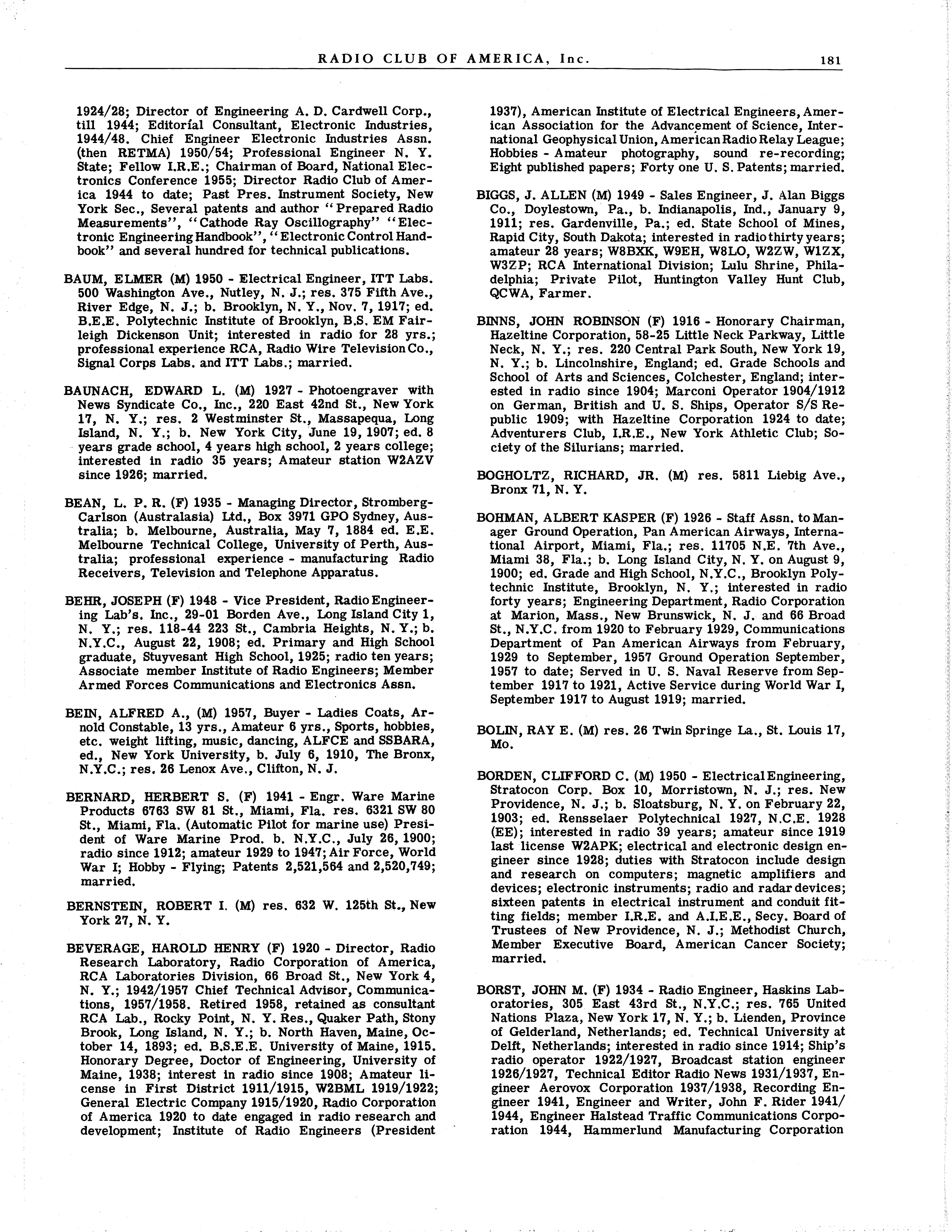
:
i RADIO CLUB OF AMERICA, Inc. 181
:
: ; i
? ! 1
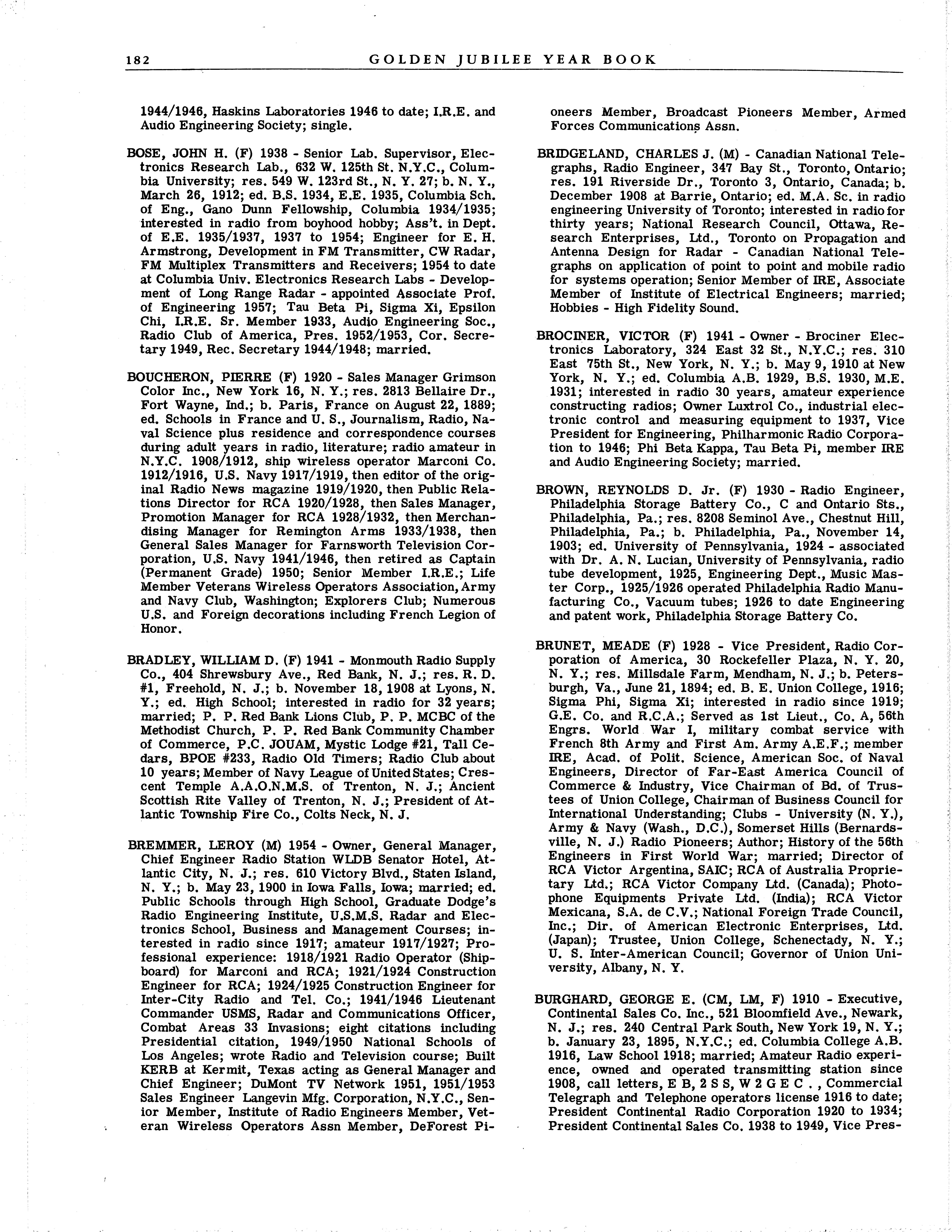
1944/1946, Haskins Laboratories 1946 to date; IJR.E. and Audio Engineering Society; single.
BOSE, JOHN H. (F) 1938 - Senior Lab. Supervisor, Electronics Research Lab., 632 W. 125th St. N.Y.C., Columbia University; res. 549 W.123rd St., N. Y. 27; b.N. Y., March 26, 1912; ed. B.S.1934, E.E. 1935, Columbia Sch. of Eng., Gano Dunn Fellowship, Columbia 1934/1935; interested in radio from boyhood hobby; Ass’t. in Dept, of E.E. 1935/1937, 1937 to 1954; Engineer for E. H. Armstrong, Development in FM Transmitter, CW Radar, FM Multiplex Transmitters and Receivers;1954 to date at Columbia Univ. Electronics Research Labs - Development of Long Range Radar - appointed Associate Prof, of Engineering 1957; Tau Beta Pi, Sigma Xi, Epsilon Chi, IJt.E. Sr. Member 1933, Audio Engineering Soc., Radio Club of America, Pres. 1952/1953, Cor. Secretary 1949, Rec.Secretary 1944/1948; married.
BOUCHERON, PIERRE (F) 1920 - Sales Manager Grimson Color Inc., New York 16, N. Y.; res. 2813 Bellaire Dr., Fort Wayne, Ind.; b. Paris, France on August 22, 1889; ed. Schools in France and U.S., Journalism, Radio, Naval Science plus residence and correspondence courses during adult years in radio, literature; radio amateur in N.Y.C. 1908/1912, ship wireless operator Marconi Co. 1912/1916, U.S. Navy 1917/1919,then editor of the original Radio News magazine 1919/1920, then Public Relations Director for RCA 1920/1928, then Sales Manager, Promotion Manager for RCA 1928/1932, then Merchandising Manager for Remington Arms 1933/1938, then General Sales Manager for Farnsworth Television Corporation, U.S. Navy 1941/1946, then retired as Captain (Permanent Grade) 1950; Senior Member I.R.E.; Life Member Veterans Wireless Operators Association,Army and Navy Club, Washington; Explorers Club; Numerous U.S. and Foreign decorations including French Legion of Honor.
BRADLEY, WILLIAM D. (F) 1941 - Monmouth Radio Supply Co., 404 Shrewsbury Ave., Red Bank, N. J.; res. R. D. #1, Freehold, N. J.; b. November 18,1908 at Lyons, N. Y ; ed. High School; interested in radio for 32 years; married; P. P. Red Bank Lions Club, P. P. MCBC of the Methodist Church, P. P. Red Bank Community Chamber of Commerce, P.C. JOUAM, Mystic Lodge #21, Tall Cedars, BPOE #233, Radio Old Timers; Radio Club about 10 years;Member of Navy League of UnitedStates;Crescent Temple A.A.O.N.M.S. of Trenton, N. J.; Ancient Scottish Rite Valley of Trenton, N J.; President of Atlantic Township Fire Co., Colts Neck, N. J.
BREMMER, LEROY (M) 1954 - Owner, General Manager, Chief Engineer Radio Station WLDB Senator Hotel, Atlantic City, N. J.; res. 610 Victory Blvd.,Staten Island, N. Y.; b. May 23, 1900 in Iowa Falls, Iowa; married; ed. Public Schools through High School, Graduate Dodge’s Radio Engineering Institute, U.S.M.S. Radar and Electronics School, Business and Management Courses; interested in radio since 1917; amateur 1917/1927; Professional experience: 1918/1921 Radio Operator (Shipboard) for Marconi and RCA; 1921/1924 Construction Engineer for RCA; 1924/1925 Construction Engineer for Inter-City Radio and Tel. Co.; 1941/1946 Lieutenant Commander USMS, Radar and Communications Officer, Combat Areas 33 Invasions; eight citations including Presidential citation, 1949/1950 National Schools of Los Angeles; wrote Radio and Television course; Built KERB at Kermit, Texas acting as General Manager and Chief Engineer; DuMont TV Network 1951, 1951/1953 Sales Engineer Langevin Mfg. Corporation, N.Y.C., Senior Member, Institute of Radio Engineers Member, Veteran Wireless Operators Assn Member, DeForest Pi-
oneers Member, Broadcast Pioneers Member, Armed Forces Communications Assn.
BRIDGELAND, CHARLES J. (M) - Canadian National Telegraphs, Radio Engineer, 347 Bay St., Toronto, Ontario; res. 191 Riverside Dr., Toronto 3, Ontario, Canada; b. December 1908 at Barrie, Ontario; ed. M.A. Sc. in radio engineering University of Toronto; interested in radiofor thirty years; National Research Council, Ottawa, Research Enterprises, Ltd , Toronto on Propagation and Antenna Design for Radar - Canadian National Telegraphs on application of point to point and mobile radio for systems operation; Senior Member of IRE, Associate Member of Institute of Electrical Engineers; married; Hobbies - High Fidelity Sound.
BROCINER, VICTOR (F) 1941 - Owner - Brociner Electronics Laboratory, 324 East 32 St., N.Y.C.; res. 310 East 75th St., New York, N. Y.; b. May 9,1910 at New York, N. Y.; ed. Columbia A.B. 1929, B.S. 1930, M.E. 1931; interested in radio 30 years, amateur experience constructing radios; Owner Luxtrol Co., industrial electronic control and measuring equipment to 1937, Vice President for Engineering, Philharmonic Radio Corporation to 1946; Phi Beta Kappa, Tau Beta Pi, member IRE and Audio Engineering Society; married.
BROWN, REYNOLDS D Jr (F) 1930 - Radio Engineer, Philadelphia Storage Battery Co., C and Ontario Sts., Philadelphia, Pa.; res. 8208 Seminol Ave., Chestnut Hill, Philadelphia, Pa.; b. Philadelphia, Pa., November 14, 1903; ed University of Pennsylvania, 1924 - associated with Dr. A. N. Lucian, University of Pennsylvania, radio tube development, 1925, Engineering Dept., Music Master Corp., 1925/1926 operated Philadelphia Radio Manufacturing Co., Vacuum tubes; 1926 to date Engineering and patent work, Philadelphia Storage Battery Co.
BRUNET, MEADE (F) 1928 - Vice President, Radio Corporation of America, 30 Rockefeller Plaza, N. Y. 20, N. Y.; res. Millsdale Farm, Mendham, N. J ; b. Petersburgh, Va., June 21,1894; ed. B. E. Union College, 1916; Sigma Phi, Sigma Xi; interested in radio since 1919; G.E. Co. and R.C.A.; Served as 1st Lieut., Co. A, 56th Engrs. World War I, military combat service with French 8th Army and First Am. Army A.E.F.; member IRE, Acad, of Polit. Science, American Soc. of Naval Engineers, Director of Far-East America Council of Commerce & Industry, Vice Chairman of Bd. of Trustees of Union College, Chairman of Business Council for International Understanding; Clubs - University (N. Y.), Army & Navy (Wash., D.C.), Somerset Hills (Bernardsville, N. J.) Radio Pioneers; Author; History of the 56th Engineers in First World War; married; Director of RCA Victor Argentina, SAIC; RCA of Australia Proprietary Ltd,; RCA Victor Company Ltd. (Canada); Photophone Equipments Private Ltd. (India); RCA Victor Mexicana, S.A. de C.V.; National Foreign Trade Council, Inc.; Dir. of American Electronic Enterprises, Ltd. (Japan); Trustee, Union College, Schenectady, N. Y.; U. S. Inter-American Council; Governor of Union University, Albany, N. Y.
BURGHARD, GEORGE E. (CM, LM, F) 1910 - Executive, Continental Sales Co. Inc., 521 Bloomfield Ave., Newark, N. J.; res. 240 Central Park South, New York 19, N. Y.; b. January 23, 1895, N.Y.C.; ed. Columbia College A.B. 1916, Law School 1918; married; Amateur Radio experience, owned and operated transmitting station since 1908, call letters, EB, 2 SS, W 2 GEC . , Commercial Telegraph and Telephone operators license 1916 to date; President Continental Radio Corporation 1920 to 1934; President Continental Sales Co.1938 to 1949, Vice Pres-
GOLDEN JUBILEE YEAR BOOK 182
:
:

ident to date; Ensign Radio in charge of Naval Radio Compass School 1917 to 1919; Senior Member IRE, Member: Old Old Timer’s Club, Veteran Wireless Operators Assn., Quarter Century Wireless Assn., ARRL, Single Side Band Amateur Radio Assn., Founder, President and Director, Armstrong Memorial Research Foundation; Member Junior Wireless Club Ltd. 1910. Radio Club of America Recording Secretary 1911/1913, President 1921/1925, Director 1920, 1926-to date. Charter Member; Awards, Armstrong Medal 1950 1 B C G, First Translantic Short Wave Message Dec. 11th. 1921.
BUTTNER, HAROLD H. (F) 1928 - Director Hewlett Packard Co., Palo Alto; res, Belmont Ave., Rye, N. Y ; b. November 3, 1892 at Port Costa, Cal.; ed. B S. in Electrical Engineering, University of California; interestedin radio 43 years; amateur 1910/1915; Bay Counties Radio Club; 1915/1917 U S. Navy Radio Development and Installation Mare Island Navy Yard and American Samoa; 1918/1920 U.S. Navy Installation Lafayette, France; 1921/1924, member of the staff of Western Electric Company and Bell Laboratories; 1926/1946 International Telephone and Telegraph Corporation; 1946/1951 President Federal Telecommunication Laboratories; 1951 to 1957 Retired; Vice President in charge research and development, International Telephone and Telegraph Corporation; Decoration - Commendatore dell ’Ordine della Corona d’ltalia; married; Westchester Country Club, Downtown Athletic Club, University Club, San Francisco.
CALLAHAN, JOHN L. (F) 1921 - Research Administrator, Radio Research Laboratory, RCA Laboratories, Radio Corporation of America, Rocky Point, N. Y.; res. 67 Nassau Ave , Malverne, Long Island, N. Y.; b. Minneapolis, Minn. - December 9, 1898; married; ed. High School, Army Signal Training, Sorbonne University, Paris, France, New York University; interested in radio since 1912; amateur crystal receiver and straight gap transmitter experiments 1912/1917; Signal Corps Laboratories, Little Silver, N. J. 1919/1920; Radio Corporation 1920 to date; research and development on marine shore station receivers and antennas; long distant point to point radiotelegraph, telephone and radiophoto receivers and antennas; aircraft beacon receivers; terminal facilities radiophoto, time division multiplex, teleprinters, etc.; Research Administrator IRE and American Institute of Electrical Engineers; Three published papers; six U S Patents; Sports, tennis; Hobby - gardening; Radio Club of America President 1941; Vice President 1940; Director 1935/1948
CANAVACIOL, FRANK E.(F)1934 - Professor of Electrical Engineering Polytechnic Institute of Brooklyn, 99 Livingston Street, Brooklyn 2, N. Y.; res. 7119 Juno St , Forest Hills 75, New York; b January 16, 1896 in N.Y.C.; ed. Polytechnic Institute of Brooklyn, E.E. 1918; married; interested in radio about 40 years; Professional experience in consulting and teaching fields; co-author “Radiophone Receiving” and Swope’s Lessons in Electricity,” Fellow AIEE, SM IRE, Member AAUP Member ASEE.
CANO, JOHN R , (M) 1956 - res. Southland Dr., Glen Cove, L.I., N. Y., b. November 12, 1925, Bronxville, N. Y., ed. Clarkson College of Tech., Potsdam, N. Y.; Research Eng., Photo Circuits Corp., 31Sea Cliff Ave., Glen Cove, L I., N Y , Military Serv , U S. Army, Amateur Call Letters EX K2 MAK; U. S. Power Squadron, U. S. Coast Guard Aux., IRE, Etched Ckt. Society.
CARINI, LOUIS F. B. (F) 1930 - Engineering Manager, Apparatus Development Co. Inc., Wethersfield, Conn.; res. 246 Wolcott Hill Rd., Wethersfield 9, Conn.; b.
Salisbury, Conn. June 21, 1911;ed HillyerJunior College, Conn. Teachers College, Temple Bar College, Ph.D.; amateur station 1-BOC in 1928.Served as technical field rep. for E. H. Scott Radio Labs ; training supervisor Underwood Elliott Fisher Co.; plant supt. Hershey Products Co. etc. U. S. Coast Guard 1943/1946 as instructor, laboratory research, and engineering writer at Coast Guard Headquarters, Communications Engineering Section, Washington. Project engineer, LaPointe Plascomold Corp.; Ass’t chief engineer and research director for LaPointe Electronics Inc., Since 1955 Engineering Manager of Apparatus Development Co.; Author of “Drafting For Electronics,” “ How To Do Your Own Electrical Servicing,” “All About FM Antennae And Their Installation” and numerous technical articles published in electronic and hi-fi magazines. Hobby, sports cars and collecting antique vacuum tubes.
CARLEBACH, WALTER M. (M) 1939 - Retired; res. 47 East 64 St., N Y.C.; Electrical Engineer; Columbia University.
CERULLI, FRANK J. (M) res. 871 Mountain Ave., Berkeley Heights, N. J.
CERVANTES, HOWARD T. (F) 1939 - President Electronicraft, Inc., Mt. Kisco, N. Y.; res. 190 Croton Ave., Mt. Kisco, N. Y.; b. December 15, 1902 inN.Y C.; married; ed. N.Y.C. Grade and High Schools and N Y.U.; Amateur 1920 to date with present call W2DB; Lieutenant Commander U. S. Navy Communications Officer 6 1/2 years World War II.
CHALFIN, NORMAN LEONARD (M) 1948 - Sub Group Hd. Member of Technical Staff, Hughes Aircraft Co. Ground Systems, Fullerton, Cal.; res. 11128 Wagner St., Culver City, Cal.; b. Philadelphia, Pa.October16,1913;married, son, Gregory b. October 15, 1942; ed. B.S. University of Georgia 1936; Graduate studies Columbia Univer.1936/ 1941; presently studying law at Southwestern Univ. Law School; professional experience - instructor, electrical engineer, chief engineer; technical editor and writer; W. E. Co. 1942; Crystal RES Lab 1943; Recordograph Patents 2,477,160 and 2,632,811; Registered Patent Agent. Many articles in Radio and TV News, Radio Electronics, Pop. Science, Pop. Mechanics, Electronics, Televisor, Radio and TV Maintenance, Radio Service Dealer and Tele-Tech., Hi-Fi column in local newspapers Southern Cal. area, 1957, Treas. Los Angeles Section, Audio Engineering Society; 1958, Vice Chairman Section, AES, 1959, Chairman, Section, AES, Member Los Angeles Patent Law Ass’n.; Papers before AES 1956, 1957, 1958, 1959; Member, International Ass’n. for the Protection of Industrial Property; Dir., Bd of Dir. Los Angeles Science Center Founding Com.
CHAMBERLIN, RUDOLPHUS M. (M) 1952 - Owner Radio Station WGGG, Alochua County Broadcasting Co.; res. 123 N.W 20th Dr , Gainesville, Fla.; b August 15, 1910, Micanopy, Fla.; married; interested in radio 33 years; amateur station W4DOD; Bell Telephone Labs engineer; member IRE; Vice President Duval Broadcasters, Inc. at Jacksonville, Fla.
CHAMBERS, ALBERT B. (M) 1949 - P.O.Box185,Wyckoff, N. J.; b. Jersey City, N. J. August 18, 1896; ed. Pace Institute 1917/1919; member American Television Society. Empire State T.V. Guild; Sons of AmericanRevolution; Institute of Radio Engineers; Licensed Real Estate Broker-New Jersey-New York.
CHUNG, WILLIAM (M) res. 325 Riverside Dr., New York 25, N. Y.
RADIO CLUB OF AMERICA , Inc 183

CHITTICK, K. A. (F) 1941 - Electronics Engineer, RCA Camden, N. J.; res. 1194 Washington Ave., Haddonfield, N. J.; b. Old Bridge, N. J. November 6, 1903; married; ed. B.S.E E Rutgers University; amateur pre World War I; General Electric Company 1925/1930; RCA 1930 to date; Ten patents; several papers; Fellow IRE; Franklin Institute Electronics Club; Many committees RTMA; Hobbies - Golf, fishing and baseball.
CHRISTALDI, P. SAMUEL (F) 1940 - Product Manager, Electronics Div., Curtiss-Wright Corp., Carlstadt, N. J., Prior, Div. Mgr , Technical Products, Div., Instrument Div. Allen B. DuMont Laboratories, Inc.; res. 132 Squire Hill Rd., Upper Montclair, N. J., b. November 26, 1914 in Philadelphia, Pa.; e. Rensselaer Polytechnic Institute; E.E. 1935 Ph.D (Physics) 1938; interested in radio since about 1931; amateur since 1931, W3BHT, W3AWZ, W2ZZBH, W2DMH, W2ZZDJ, W2ENY; presently active on 50 me; Professional experience DuMont, engineer on cathode ray tubes and oscillographs from1938,1941/1947 Chief Engineer CRO, oscillographs, TV receivers,transmitters; 1947/1952 Engineering Manager, Instrument Division; numerous U. S. and Foreign Patents and applications; electronics; numerous lectures and papers in technical journals; hobbies, ham radio, scouting (committeeman); Montclair Society of Engineers (President 1953/1954).
CIMORELLI, JOSEPH T. (F) 1956 (M) 1950 - Manager, Manufacturing, Receiving Tube Operations,ElectronTube Division, Radio Corporation of America, Harrison, N. J.; Res. 10 Cromwell Dr., Morristown, N. J.; b. March 18, 1912 in Catskill, N. Y.; ed. St. Patrick’s Academy, Catskill, N. Y., Massachusetts Institute of Technology B.S. 1932, M.S. 1933; Professional Experience, Tube Department RCA Victor Division, Harrison, N. J. Laboratory 4 years, Field Engineer 6 years, Manager Application Engineering Laboratory 8 years, Assistant to VicePresident and Director of Engineering,RadioCorporation of America, Camden, N.J.3years;Manager,Engineering, Receiving Tube Operations, Electron Tube Division, Radio Corporation of America, 2 years; IRE, SecretaryTreasurer of New York Section, Chairman, New York Section; Various IRE Section Committees; Charter member of Vatican Philatelic Society.
CLARK, LOUIS E. (M) 1939 - res. 298 Highwood Ave., Glen Rock, N. J.; b. Jersey City, N. J; August 9, 1898; member IRE, Curtiss-Wright Corp., Prop. Division,Caldwell, N. J., since 1940 to date.
CLEMENT, LEWIS M. (F) 1919 - Consultant, 3124 P St., N.W., Washington 7, D. C.; b. Oakland, Calif. January 25, 1892; married; University of California B.S in E.E. 1914; Amateur 1905/1914 at Oakland, Calif.; Professional experience 1914/1959, radio operator summer 1911 and 1912. Marconi Wireless Tel Co of America, Kahuku, Oahu, T. H., and Bolinas, Calif., Western Electric Co. and Bell Tel Laboratories; FADA RADIO; KOLSTER RADIO; Federal Telegraph and European I T.T. Companies; RCA Mfg. Co., Camden, N. J. and Crosley and Avco Mfg Corp , Crosley Div. Many patents and Technical Articles; Chairman Advisory Group Reliability of Electronic Equipment Dept, of Defense; Fellow IRE; Member British Institution of Radio Engrs.; Member Cosmos Club, Washington, D. C.; Member American Ordnance Assn ; member Armed ForcesCommunications and Electronic Assn.; Awards: Modern Pioneer Award, February 1940; National Assn of Mfgrs.; NavalOrdnance Dev. Award; Bureau of Ordnance-U.S. Navy, December 10, 1945; Pioneer intheFieldof Aircraft;Electronic Dev , May 4, 1950; Dayton Section I R.E.; Contribution toCreation of Color TelevisionStandards,June17,1954;RETMA-
Placque Presented to Lewis M. Clementfor Distinguished Service to Industry and Government in the Field of Reliability, October 18,'1959; RETMA AND IRE, A Pioneer Award, presented by The Professional Group on Aeronautical and Navigational Electronics to Lewis Mason Clement by IRE 1951; Radio Club Director 1920/1930; Recording Secretary 1921; Vice Pres. 1928 and President 1929.
COBB, HOWARD L (F) 1934 - Engineer, Aircraft Radio Corporation, Boonton, N. J ; res 250 Rockaway Ave., Boonton, N. J.; b. July 17, 1896 atSalina, Colo.; married; ed. MIT 1923 S.B Electrochemical Engineering; interested in radio since 1910; professional experience Radio Laboratory Philadelphia NavyYard;RCA;Benjamin Elect.; Fansteel Products Co.; Ballantine Laboratories; Aircraft Radio Corporation; School Board; P.P. of A.E.S. Newark Branch; member A S.M.; Mason.
COCKADAY, LAURENCE M. (F) 1915 - P.O. Box 902, Annapolis, Md.; ed. St. Johns School Physics and Engineering; b. Greenville, N. J. June 18, 1894; Amateur station “ LC” 1910, 20G 1912/1913, 2AAK 1916, W2XK 1919/ 1923; Editor Radio News 1934; Lecturer New York University.
COHN, HUGO (F) 1939 - Consulting Eng., 221 W. 57 St., New York, N. Y.; Formerly President Radio Receptor Co. Inc., 84 North 9 St., Brooklyn, N. Y.; res. 905 West End Ave., N.Y.C.; b November 26, 1887 in N.Y.C.; married; ed. E.E. Columbia University, 1909; interested in radio 36 years; professional experience engineering and management with Radio Receptor Co., Inc. 1922 to date.
COLLISON, PERCE BRAWN (F) 1934, Retired (1958) res. 9 Lorraine Dr., Tuckahoe, N. Y.; b. Brooklyn, N Y., June 15, 1891; married; e. High School followed by various special courses in Physics, Electrical Engineering, Television, interested in radio since 1906, 2KN with rotary spark gap until World War I; Vice Pres. New York Radio Club, Amateur (K2DZ) “ExtraGrade” Lie.Charter Member “Quarter Century Wireless Assn.” Member “Westchester Amateur Radio Assn ” , President Hammond Organ Society of Westchester; Professionalexperience, United Wireless Co installer, Marconi Co. shipboard inspector and superintendent of construction, Lieutenant Commander U S. Naval Reserve set up Radio Material School for Navy Radio, Radar, Sonar, andVisual Signalling. Charter Member IRE, Wireless Institute, Wireless Assn of America; Member ARRL, Armed Forces Communications Assn., Military Order of World Wars, Naval Order of the U. S.; Radio Club Recording Secretary 1949, Membership Com. Chairman 1950/1953.
CONNOR, GEORGE C. (F) 1936 - Vice President, Sylvania Electric Products, Inc.,1740 Broadway, N.Y.C.; res.100 Valley Rd., Larchmont, N Y.; b. Hoquiam, Washington May 28, 1903; married; ed. University of Wisconsin; interested in radio 40 years; Amateur 9CEK Chicago, Ill.; Radio Engineer with Brunswick Electronic Radio and Sylvania Electric; Member AAAS, IRE, NYAC, Director PMDA; Radio Club Vice President 1949.
COOK, LAWRENCE (M 1939 - F 1957) Engineer, Boonton Radio Corporation, Boonton, N. J.; res. 610 William St., Boonton, N. J.; b. Bryan, Ohio October 4th, 1908; ed. Bliss Electrical School; member IRE.
COOPER, CHARLES B. (F) 1924 - Retired; res.131 Lexington St., Westbury, L.I., N. Y.; b. Bracebridge, Ontario, Canada May 13, 1882; married; professional experience 1903 Wireless Operator Dr Lee DeForest Toronto, Canada; 1904 Buffalo, Cleveland and St. Louis
! 184 GOLDEN JUBILEE YEAR BOOK

Worlds Fair with first paid message service between St. Louis and Springfield;1905/1906DeForestSuperintendent of Construction for several stations in Colorado and Texas for point to point service but static licked us1907 Transferred to Seattle, Wash, and built “PA” and “PC” at Astoria; 1908/1915 Various executive positions with United Wireless and Marconi in Construction and expansion of Ship to Shore communications: 1915 Radio Superintendent Alaska Steamship Co.; 1916/1917 Organized the Ship Owners Radio Service, Inc. for Kilbourne and Clark; 1918 Opened New York Office for Kilbourne and Clark’s Navy transmitter business; 1919/1921 Reorganized Ship Owner’s Radio Service for Kilbourne and Clark on service contract for Shipping Board vessels; 1932/1933 Factory representative for Crosley Radio and other receivers and parts manufacturers; 1931 Changed firm name from C. B Cooper Co. to Cooper-DiBlasi which continues to date; Retired from firm in Fall of 1952; Life Member Veteran WirelessOperatorsAssociation; Charter Member DeForest Pioneers; F. and A.M. Lodge No. 856 Bay Ridge, Brooklyn; Marconi Memorial Wireless Pioneers Medal Awarded for efforts in early days of radio, 1903 to 1954.
CORYELL, ROBERT L. (M) res. 90 Wykalyl Terrace, New Rochelle, N. Y.
CORZO, GUILLERMO ANDREU (M) res. 5a Avenida No. 5-20, Zona 2 Guatemala, C. A.
COUNTESS, JULIUS (M) res. 64-04 217th St., Bayside 64, N. Y.
CRAMER, BRUCE G. (M) 1955 - Electronics Engineer, Research Division, Philco Corp.; res. P.O. Box 945, Harrisburg, Pa.; b. November 22, 1930 in Harrisburg, Pa.; ed. Pennsylvania State University, BSEE, 1952, current graduate study, University of Pennsylvania, previously with Bendix Aviation Corp. 1952/54; Military Service, Signal Corp.1954/1956.
CRAWFORD, JOHN D. (F) 1939 - res.16 Lodge Rd., Great Neck, N. Y.; b. Barberton, Ohio April 30, 1904; Senior Publication Engineer, Hazeltine Corp. 59-27 Little Neck Parkway, Little Neck 62, N. Y.
CRAWFORD, ROBERT V. (F) 1940 - Electrical EngineerGeneral Electric Company, Schenectady, N. Y. 1928 to 1930; Bell Telephone Laboratories, Inc., Murray Hill, N. J. 1930 to date; Residence 11 Crest Circle, Murray Hill, N. J.; Education Rensselaer Polytechnic Institute; New York University, B.S. in E.E. - Senior Member Institute of Radio Engineers;Memberof ProfessionalGroup on Vehicular Communications; Member of various Special Committees of Radio Technical Commission for Marine Services (R.T.C.M.); Member of U. S. Study Group XIH of International Radio Consultative Committee (C.C.I.R.).
CRONKHITE, MINTON (F) 1919 - Radio Club Corresponding Secretary 1920;Director1921/1922;ArmstrongMedal 1950; IBCG Group. P.O. Box 805, RanchoSanteFe, Calif.; President Liberty Electric Co. 1928 at Stanford, Conn.; Radio Club of America Armstrong Medal 1950 - IBCG.
CRONKHITE, WILLIAM GORDON FELLOWS, (M) 1955, Industrial Management, res. 1718 Grevelia St., S. Pasadena, Calif., e. Univ. of Southern California; Military Service U. S. Navy 1951/1955, Amateur Call Letters K6QQN, 4 yrs.
CRONKHITE, M. B. (M) res. P.O. Box 805, Paucho Sante Fe, Calif.
CROSBY, MURRAY G. (F) 1939 - President and Research Director, Crosby Laboratories, Inc., 299 Robbins Lane, Syosset, N. Y.; res. 93 Muttontown Rd., Syosset, N. Y.; b. Elroy, Wise.September 1903; married; ed. University of Wisconsin 1927 B.S.E.E.; amateur W2CSY formerly 9AOX; professional experience RCA Laboratories 1927/ 1944; Press Wireless 1944/1945; Paul Godley Co.1945/ 1948; Crosby Laboratories, Inc.1948topresent;Approximately 180 U. S. Patents; 20 Technical Publications in Proceedings IRE, RCA Review, QST and others.
CUNN1FF, LEO C., (M) 1958 - Vice Pres (Eng.) for manufacture of electronic test equipment and analytical equipment for chemical industry, Industrial Instruments, Inc., Cedar Grove, N. J., (17 yrs.), Military Service U.S. Navy 1944/1946 Radar Maintenance on U.S.S. Princeton CV-37; Amateur Call Letters W20EH, 1940, Patents, Books, etc. (Basics of Radio Control - Air Trails Model Annual 1953 - Street & Smith); (Plug-In 27 Me. Radio Equipment - Air Trails June 1950) (Instruments - World War I to date, The Hudson Engineering Jr. October 1952) Sports and Hobbies, Skiing, Flying, Skin Diving, Photoggraphy, Music.
CURTIS, PAUL EVART (M) 1952 - Area electronics technician, U. S. Weather Bureau, 311 N. Terminal Dr., San Antonio 12, Texas; res. 128 W. Terra Alta Rd., San Antonio 9, Texas; b. December 14, 1907 Chelsea, Mich.; married; ed. Wayne, Michigan Hi£h School 1924; oneyear of engineering at Georgia Tech.; amateur 8DLZ in 1923; 4VD in 1924; W5IOJ in 1940; now W5VE; professional experience 2 yrs. seagoing (Telefunken, Simon & Indewirtel spark); operator CPC-CPV-CPY-CPS (Standard Oil of Bolivia) 1930/1933; Chief operator XENT 1935/ 1936; Eastern Air Lines 1937/1951; presently install & maintain radar, rawinsonde, automatic weather observing stations & general meteorological electronic & electro-mechanical equipment.
DARRELL, ROBERT D. (M) 1946 - Music Critic, freelance, res. Balmoral, the Vly, Stone Ridge, N. Y.; b. December 13, 1903 Newton, Mass.; single (div.); ed. Newton Public Schs., New England Conservatory of Music; interested in radio; amateur audio amplifiers and testing since 1942; professional experience Instruction Book Editor (IFF) Hazeltine Electronics Corp. 1943/ 1946; Magazine articles (Electronics, Saturday Review, Audiocraft, etc. and lectures on audio subjects, Audio Engineering Society, IRE, Music Librarians Assoc., etc.) Books, Good Listening (Knopf 1953, Mentor reprint 1955; Schirmer’s Guide to Books on Music andMusicians(1951, Supplement in prep. 1959); Gramophone Shop Encyclopedia of Recorded Music (1936); onetime Editorof Phonograph Monthly Review, Review of Recorded Music, Music Lover’s Guide; since 1956 Contributing Ed. High Fidelity Magazine; many articles and reviews (mostly on recorded music); Guggenheim Fellowship 1939; Societies AES (CM); IRE (A); Acoustical Society of America (A).
DAVIS, E. STUART (M) res. 244 Elmwood Ave., Union, N.J.
DAY, HOWARD BLOOD GOOD (F) 1912 - Electrical Engineer Pennsylvania Power & Light Co., 901 Hamilton, Allentown, Pa., (scheduled for retirement January 1, 1960); res. 27 N. Jefferson, Allentown, Pa.; b. November 2, 1894 at N.Y.C.; married; ed. Westfield, N. J. Public Schools and University of Illinois, B.S.E.E. 1922; interested in radio since 1908; Amateur station “HDF”Westfield in 1908/1918 and licensed as 2KK 1913/1917; Commercial First Grade Radio Operator License No. 2488 in 1913; Chief Operator U. S. Ambulance Ship “Surf” in 1917 with Atlantic Fleet; Member AIEE; Registered Pro-
RADIO CLUB OF AMERICA, Inc 185
: : 1
!
: * : : : :

fessional Engineer in Pennsylvania; Lehigh Valley Engineers’ Club and The Pennsylvania German Folklore Society which is a hobby or side study as is photography and TV circuitry; founding member of the Armstrong Memorial Foundation.
DAY, JAMES R. (F) 1938 - Vice President, Radio Engineering Laboratories, Inc., 29-01 Borden Ave., Long Island City 1, N. Y.; res. 39 Gramercy Park, New York 10, N. Y ; b. July 21, 1910, N.Y.C.; married; grade and high school (Stuyvesant) in New York City, B.S. 1931 M.I.T.; professional experience E. H. Armstrong Labors! ' *ies - OSRD * RCA Laboratories, Press Wireless, Ra o Engineering Laboratories; patents, several in FM and related fields.
DEAN, CHARLES EARLE (F) 1930 - Consulting Engineer, Hazeltine Research Corporation 5925, Little Neck Parkway, Little Neck, N. Y.; res. 260-21 Pembroke Ave., Great Neck, N. Y.; b. May 23, 1898, Pickens County, S. C.; interested in radio since about 1921; professional experience 1921/1924 Bell TelephoneLaboratories;1924/ 1927 Dept, of Otology, Johns Hopkins Medical School; 1927/1929 American Telephone and Telegraph Co.; 1929 to date Hazeltine Corporation and Associated Firms; Licensed Professional Engineer, New York State, 1934; Apprentice Seaman, U. S. Naval Reserve, World War 1; Awarded Navy Certificate of Commendation for Civilian Work, World War H; Editor “Color Television Receiver Practices,” 1955, co-editor, “Principles of Color Television,” 1956; Fellow AIEE, senior member IRE; Society for Ethical Culture, N.Y C.
DEAN, FRANK C., (M) 1955 - Western Electric Co., Military Engineering Service, Winston-Salem, N. C. Permanent location: Bell Telephone Laboratories, Murray Hill, N. J. (Dev. Engr ) res West Main St., Brookside, N. J., ed. Morristown High School (rech.), Morris County Junior College 1933/1936 (Engr.), Military Service U.S. Maritime Service, September 1944/September 1945 (Radio Officer), Amateur Call Letters W2CKN, September 1932 to present time, F.C.C. Radio Telegraph 2nd. 1944/ 1949; Sports, Hobbies, etc., Electronics, sports.
DiBLASI, JOHN (F) - Electronic Sales, Cooper-DiBlasi, 90 Main St., Port Washington, L.I., N. Y.; res. 155 Bayview Rd., Plandome, N. Y.; b. New York City November 5, 1898; married; ed. New York City Schools, Cooper Union, Electrical Engineering 1922; interested in radio since 1912; licensed as amateur 2AGD in 1915, re-licensed as 2FD in 1920, presently W2FX; electronic sales business since 1915; taught radio in YMCA Schools and Jamaica Vocational High School; Senior Member IRE, member ARRL, North Shore Radio Club; Past President North Shore Radio Club; President Quarter Century Wireless Association.
DiBLASI, JOHN S. (M) 1951 - Salesman, Cooper-DiBlasi 90 Main St., Port Washington, L.I., N. Y.; b. May 3, 1924 Elmhurst, L.I. married; ed. Bayside High School, U.S. Sig. Corps. Communications. Airforce Pilot TrainingO.S.S. Communications St. Johns University Science B.S
DICKEY, EDWARD T. (F) 1927 - Engineer RCA Laboratories, Princeton, N. J.; res.104 Jefferson Rd., Princeton, N. J.; b. November 16, 1896 Oxford, Pa.; married; ed. B.S. College of the City of New York; interested in radio since 1909; held amateur license for station 2CN from about 1913/1928; professional experience RCA Research Department in New York 1919/1924; Technical and Test Department 1924/1929; RCA Victor 1929/1941, RCA Laboratories 1942 to date. Present position, Coordinator, Technical Publications; several patents on
radio; about ten technical articles on Radio; HobbyPhotography;Senior member IRE.
DIEHL, WILLIAM FRANCIS (F) 1924 - Engineering Executive, Dumont-Airplane and Marine Instrument, Inc., Clearfield, Pa.; res. 1012 S. Second St., Clearfield, Pa.; b. December 18, 1896 at New York City; ed. Flushing High School, Columbia University, Alexander Hamilton Institute, LaSalle; married; interestedinradiosince1907; amateur 1907/1917, professional experience, Chief Radio U.S N 1918/1919, Chief Engineer A. H. Grebe1919/1928, Assistant Chief Engineer and Division Manager RCAMfg. Co. Camden 1928/1938; Director of EngineeringandManufacturing, Product Manager AssistantVicePresidentDumont, Airplane and Marine Instruments, Inc. 1938todate; patents Cathode-Ray Oscillograph, Apparatus for Calibrating Piezo-Electric Elements, Crystal holder; Publications: Section (2) Properties of Materials, PenderMcllwain, Electrical Engineers Hand Book, Volume (5) Electrical Communications and Electronics; Papers in Radio Club, Electronics, Radio; Chairman, Philadelphia Section, Chairman IRE Ninth Annual IREConvention;Fellow IRE; Certificate of Commendation U.S.N. World War Two; Sports: Tennis, Badminton and Crokinole; HobbyPhotography including medical Registered Professional Engineer, Commonwealth of Pa Standard Teaching Certificate (Photography), Commonwealth of Pennsylvania; Commercial Radio Operator’s License-1913; Commercial Radio Operator-1919
DIETRICH, FREDERICK (F) 1925 - Retired 1 Wall St., N.Y.C.; res. 1136 Fifth Ave., New York City; b. New York City September 15, 1880; Grammar School, New York City, two years City College of New York; interested in radio since 1908; Member, IRE;Engineer’sClub.
DOUCHA, ARTHUR FRANK (M) 1951 - Industrial Salesman Continental Sales Co., Inc , Newark, N. J.; res. Clark, N. J.; b. New York City September 30,1907; ed. Grammar and High School, N. Y Electrical School; married; interested in radio since 1924; built transmitters and receivers for amateur use in late 1920s; Radio Service business with a stress on sound installations; served in U. S. M. C.; member of A.E.S. and V.F.W.
DREHER, CARL (F) 1923 - Writer, res.R.F.D. #3, Brewster, N. Y.; b. Vienna, Austria, February 16, 1896; married; ed. B.S. City College of New York 1917; Assistant Research Engineer, Marconi Wireless Telegraph Co.; Receiving Engineer, Broadcasting Station Engineer, Radio Corporation of America; Staff Engineer NBC, Chief Engineer RCA Photophone; Director of Recording, RKO Studios; Air Corp, AUS 1942/45; Fellow, IRE. Radio Club of America Director 1927/1928, Vice President 1929.
DROSTE, GEORGE THEODORE (M) 1926 - Estimator and Project Manager, Starrett Brothers and Eken, Inc., 225 Broadway, N.Y.C.; res. 215 Meisner Ave., Staten Isl. 6, N. Y.; b. N.Y.C. November 23,1886;ed. Public School, Night and Trade Schools; interested in radio since 1903; School under Kolster 1904/1905; amateur 1912 2EU,after World War I call changed to W2IN; Signal Corps WWI; Production Engineer WW2 Bell Labs, at West Street and Western Electric at Kearney on radio, architect and builder since 1901; Infantry 1906/1911, Signal Corps 1911/1936, Grade Captain N.G.N.Y.,1940/1942 Lieutenant Colonel Infantry; Member Staten Island Amateur Radio Club, IRE.
DUBILIER, WILLIAM (F) 1920 - res. 72 Esplanade, New Rochelle, N. Y.; b. N.Y.C. July 1888; married; ed. Technical Institute, Cooper Institute; interested in radio since 1903; professional experience; experimental and
GOLDEN JUBILEE YEAR BOOK 186

original development of high frequency generators 1906, Chief Electrician Continental Wireless and Telegraph Co. 1907, President and Technical Director Commercial Wireless and Telegraph Co. 1909, organized Dubilier Electric Co. London 1910, Dubilier Electric Co. 1912, Dubilier Condenser Corporation 1913, Radio Patents Corporation 1917, all leading up to many present companies in this country and abroad.
EASTHAM, MELVILLE (F) 1917 - Retired, formerly with General Radio Co., Cambridge, Mass.; res. 8 Gray Gardens, Cambridge, Mass.; b. June 26, 1885 atOregon City, Oregon; married; interested in radio since 1902; professional experience; Design Engineer for over 40 years, Clapp Eastham Co. 1906/1915, then General Radio to retirement; Fellow IRE, AIEE, American Physical Society, Acoustical Society, IRE Medal of Honor 1938; Medal for Merit-1946; Armstrong Medal-1956 Honorary Doctor of Engineering, Oregon State College-1945.
EDINGER, JOHN RAYMOND(F)1949 - ProductionManager, Pickering and Co., Plainview, L.I., N Y.; res. 852 Henry St., Uniondale, N. Y.; b. September 17, 1914 at Watervliet, N. Y.; ed V T.I 1934; married; interested in radio 25 years; amateur W2JKF 20 years; professional experience radio operator, engineer; Audio EngineeringpaperJune 1947.
EGOLF, RICHARD S. (F) 1945 - Supervisor, International Program-Radiophoto Department, RCA Communications, Inc., 66 Broad St., N.Y.C.; res. 90 Eighth Ave., Brooklyn 15, N Y.; b. Brooklyn, N. Y. December 30, 1895; ed. Public School 131, Manual Training High School, Pratt Institute, Brooklyn; married; interested in radio since 1909; Amateur station RS 1909, licensed 2LE in 1912, relicensed W2WX in 1919 and active ever since, hold Amateur Extra Class, First Class Radiotelephone and Radiotelegraph Licenses; Marine Radio Operator for Marconi Company 1914 SS Hamilton, SS North Land, SS Evangeline and for National Electric Signalling Company SS Priscilla, SS Commonwealth and land station FNK Brooklyn; Radio Intelligence Division Signal Corp. U. S. Army World War 1, Senior Member IRE, Member Veteran Wireless Operators Association, Quarter Century Wireless Association, Old Old Timers Club, DeForest Pioneers, Broadcast Pioneers.
ELDRIDGE, ALBERT B.(M)1958 - SalesEngineer,“Measurements” A McGraw - Edison Div., Boonton, N.J.;Box 473, Sparta, N. J., e. attended, Rutgers University, Business Administration, RCA Institutes, Engineering; Military Service Signal Corps. Air Corps., 1942/1945
ENGLE, KARL D. (M) 1929 - Sales Representative Karl D. Engle Co., 4724 N. Sheridan, Chicago 40, HI.; res 6111 N. Damen Ave., Chicago 45, HI.; b. February 9, 1899 Shelbyville, Ky.; ed. High School. Ex Courses in E.E. at Columbia University; interested in radioforty-fiveyears; married; professional experience in radio parts manufacturing since 1917, mostly as Factory Superintendent and production Manager with large Eastern parts manufacturers; member Chicagoland Chapter of “ Electronic Representatives Association,” past President 1956.
ESPENSCHIED, LLOYD (F) 1925 - Research Consultant, retired from Bell Telephone Laboratories; res. 99-82nd Rd., Kew Gardens 15, N, Y.; b. April 27, 1889 St. Louis, Mo.; ed. Pratt Institute 1909, hon. D.Sc. 1957; married; interested in radio since 1904; amateur 1904/1909 Brooklyn, N. Y. Station “XY”; summers 1907/1908 ship wireless telegraph operator United Wireless Teleg. Co.; 1909/1910 assistant engineer Telefunken Wireless Telegraph Co. of Amer., TWT at 111 Broadway, N.Y.C.; 1910
to 1954 with Bell Telephone System (AT&TCo, and Bell Telephone Labs.) on research and development in radio and carrier systems; over hundred U S patents, dozens of technical papers, participated in national and international conferences on electric communications, received several honors; hobby - history, electrical and family (genealogical); Fellow AIEE, IRE; mem Ocean Club of Forest Hills; Radio Club Director, 1931.
FARRAND, CLAIR L. (F) 1921 - President - Farrand Controls Inc , 4401 Bronx Blvd., N.Y.C.; President - Inductosyn Corp., 729 N. Carson St., Carson City, Nev.; res. 133 Pondfield Rd., Bronxville, N. Y.; b. October 22, 1895 at Newark, N. J ; ed. Central High School, Philadelphia, Pa. 1908/1911; married; interested in radio 45 years; amateur station WN 1908, Denver 1910; professional experience: 1912/1919 Design Engineer, Marconi Wireless Telegraph Co , 1919/1920 Assistant Chief Engineer Liberty Electric Corp., 1921/1922 Chief Engineer Wireless Improvement Co., 1922/1924 Consulting Engineer Atwater Kent, 1924/1929 President Farrand Manufacturing Co., 1930/1936 President United Research Corp. (subs. Warner Brothers Pictures), 1936/1937 Consulting Engineer Warner Brothers Pictures, 1937/1940 President Independent Res. Service, 1940 to date President Farrand Optical Co., Inc.; about 30 U.S. Patents, about 10 Foreign Patents; Sports - Tennis, Fly Fishing, Yachting; Societies - Fellow IRE, Society Motion Picture and Television Engineers, Member American Physical Society, British Kinematograph Society; Clubs - New York Yacht Club, West Side Tennis Club, Bronxville Field Club; Naval Ordnance Development Award, U.S. Navy December 10, 1945, Technical Mission to British Isles and Germany 1946, Honorary Degree of Mechanical Engineer, Stevens Institute of Technology, 1949.
FELCH, EDWIN PIERSON (F) 1939 - Director of Military Systems Development, Bell Telephone Laboratories,Inc., Whippany, N. J.; res. 109 Fairmount Ave , Chatham, N. J.; b. January 10, 1909 at Madison, N. J.; ed. A.B Physics 1929 Dartmouth College; married; interested in radio about 35 years; amateur 1930/1937 W3AWT associate; professional experience Bell Telephone Labs. 1929 to date, electronic measuring apparatus development 1930/ 1953, Airborne Magnetometer Development World War Two, now in charge of Titan ICBM Guidance system development; several patents on automatic frequency control systems and Magnetometers; member AIEE, Fellow IRE; Hobby Sports cars.
FELIX, EDGAR H. (F) 1928 - Planning Co-Ordinator, Government Division, RadioCorporationof America,Camden, N, J.; Manager, Market Development, Missile and Surface Radar Division, Radio Corporation of America, Moorestown, N. J. Res 1103 York Rd., Barclay Farm, Haddonfield, N. J.; b. March 29, 1898; married; ed. Sheffield Scientific School, Journalism atColumbiaSchool of Journalism; interested in radio since 1912; amateur 1915 2ADQ; professional experience, technical writer on radio 1918/1922, allocation.
FINK, DONALD G (F) 1934 - Director of Research Philco Corporation, Tioga and “C”Streets,Philadelphia24,Pa.; res. 845 Dale Rd., Meadowbrook, Pa.; b. Englewood, N. J November 8, 1911; married; ed. Bachelor of Science, M.I.T. 1933, Master of ScienceColumbia University 1942; interested in radio since 1921; amateur W2AFX 1928 to date, W3TVI 1952 todate;professionalexperience editorial staff Electronics 1934/1952, Editor-in-Chief 1946/1952, Staff Member MIT Radiation Laboratory1941/ 1943, Expert Consultant, Office of Secretary of War 1943/1945, Director of Research Philco Corporation1952 to date; Books: Engineering Electronics 1935, Principles
RADIO CLUB OF AMERICA, Inc. 187

of Television Engineering 1940, Microwave Radar 1942, Television Standards and Practice 1943, Radar Engineering 1947, Television Engineering 1952. Television Engineering Handbook-1957; Editor, Proceedings of the IRE-1956/57; President-IRE-1958.
FINLAY, ROBERT (F) 1939 - Manufacturers’ Representative, 307 Lincoln Building, Ridgewood, N. J.; res. 104 Brookside Ave., Ridgewood, N J.; b. N Y.C. December 17, 1901; ed. U.S.M.A. West Point 1924; married; West Point Society of New York, Association of Graduates, U.S.M.A., Armed Forces Communications Assn., Electronic Representatives Ass’n., PGA Hole-In-One Club. Director, Radio Club, 1959.
FOWLER, CHARLES J. (F) Supervisor Bldgs. & Grounds, Armstrong Research Field Lab. for Columbia Univ. at Alpine, N. J. res. 135 E. Madison Ave., Dumont, N. J.; b. Sea Bright, N. J. July 10, 1899; married; professional experience, Construction of radio stations for 27 yrs., Belfast, Maine, Tuckerton, N. J., Riverhead and Rocky Point, L.I., N. Y. WEAF Bellmore, L.I., WJZ at Bound Brook, N. J. past 21 years at Alpine, N. J. (17 yrs. with Maj. Armstrong).
FOWLER, HENRY L. (M) res. 319 Vermont Ave., Irvington 11, N. J.
FRENCH, B. V. K. (M) 1947 - res. 2221 East52 St , Indianapolis, Ind ; b. Coudersport, Pa. February 19, 1903; ed. B.S. University of Buffalo; staff of Barnard Studios, 2136 East 52 St., Indianapolis 5, Ind ; Senior Member IRE.
FRESEMAN, WILLIAM L. (M) 1957 - Executive, Communication Engineering & Mfg. Co , prior, International Standard Electric Corporation (ITT); e. B.S., U.S. Naval Academy 1922, M.S. Harvard University 1929, Certificate, U. S. Naval War College 1935; Military Service, 29 Years, U.S. Navy; Patents, Books, etc Book (with H. W. Hiser) Radar Meteorology, 1955, Various Technical Papers; Sports, Hobbies, etc. Yachting, University Yacht Club, Miami, Fla , Army Navy Country Club, Arlington, Va.
GAW, NORMAN W., JR. (M) 1958 - Measurements Corp., Boonton, N. J.
GAWLER, HARRY (F)1921 - Engineer,Gawler-KnoopCompany, 168 Eagle Rock Ave., Roseland, N. J.; res. 102 North 22nd St., East Orange, N. J.; b. Washington, D. C.; interested in radio 1904; professional experience, U.S. Radio Inspector, New England 1912/1920, Army and Navy Radio, Graduate of First Navy Wireless Class 1904 at Brooklyn Navy Yard; married; Senior Member IRE.
GERNSBACK, HUGO (F)1919 - Publisher - Gernsback Publications, Inc., 154 West 14th St., N.Y.C.; res. 263 West End Ave., N.Y.C.; b. August 16, 1884 at Luxembourg, Luxembourg; ed.EcoleIndustrielle, Luxembourg;Founded Electro Importing Co. 1905 offering first spark transmitters and receivers to public; Modern Electrics 1908, Electrical Experimenter 1913, Radio News 1919, Radio Craft 1929 (now Radio Electronics) and a series of technical publications to date.
GHIRARDI, ALFRED A. (F) 1933 - Consulting Electronics Engineer, Technical Publications Consultant, Author Technical Books, self-employed; res. 94 Alpine St., Stamford, Conn.; b. New York City August 16,1904; ed. Cooper Union Institute of Technology BS. and post Graduate E.E.; interested in radio since 1917; professional experience, Electrical Engineer, Livingston and Co. 1923/1924, Engineer of Experimental Laboratory and
Associate Editor Radio Engineering Magazine 1924/1926, Head of Electrical and Radio Department Technical Institute N.Y.C. 1926/1934, Technical Consultant Pilot Radio and Tube Corp. 1931/1934, President Radio and Technical Publishing Co. 1930/1943; author Radio Physics Course, Modern Radio Servicing,RadioandTelevision Receiver Troubleshooting and Repair, Pix-O-Fix TV Trouble Finder Guide, Radio Troubleshooter’s Handbook; Co-author; Radio & TV Receiver Circuitry & Operation, TV Probes & Their Application; Senior Member IRE; Member Tau Beta Pi.
GILLEN, RICHARD G. (M) 1952 - Engineer, Cornell Aeronautical Laboratory, Inc , Flight Research Division, 4455 Genesee St., Buffalo, N. Y.; res. Tockey St., Burt, N. Y.; b. Dorchester, Mass. November 11, 1924; ed. B.EE. New York University College of Engineering 1954; married; interested in radio since 1939; amateur W3JOS 1941/ 1948, W2ZCD 1948 to present; professional experience Commercial Operator’s License 1941, Experimental Broadcasting license 1941/1942, Army Air Force Radio Maintenance 1942/1945; research assistant Edwin H. Armstrong Columbia University Laboratories 1945/1954; Member ARRL 1941 to present, Active in NYU Student Branch AIEE and IRE Officer 3 years, Chairman2 years, Associate IRE; Hobbies - Amateur Radio, Photography.
GILLETTE, EDWARD CLINTON, JR. (F) 1947 - Colonel U. S. Army 0-12697 “Professor and Head of Dept, of Physics and Chemistry” U. S. Military Academy, West Point, N. Y.; res. West Point, N. Y. and Castine, Maine; b. Philadelphia, Pa. July 25, 1900; married; ed. B.S. West Point Military Academy 1920, M S.E E Purdue University 1931; attended Harvard University, Columbia Univ., Penn State Univ., Atomic Energy Com. Nuclear Institute, Purdue Univ. 1958; interested in radio since 1912; amateur 1929/1936; professional experience military only 1918 to present in Reg. Army, Artillery and Signal Corps, appointed permanent Prof, of Physics and Chemistry at U. S. Military Academy 1946; World War Two service in ETO 1943/1945, Signal Div. SHAEF, Chief Signal Officer First Allied Airborne Army and Chief Signal Officer Berlin District; Decorations include Legion of Merit, Bronze Star and ACM(US), Order of British Empire, Croix de Guerre (Belgium), Croix de Guerre (France); Sports - Tennis, Swimming, Handball, Squash, and Sailing; Hobbies - Radio and Electronics, metal and wood-working, collecting and refinishing antique furniture, collecting old clocks, repairing and restoring antique automobiles; Member IRE, Member Army and Navy Club, Washington, D.C.AFCEA,Member American Assn, of Physics Teachers, member American Soc. for Eng. Ed., Member Nat. Geographic Soc.
GIRDWOOD, JAMES, (M) 1952 - Associate Publisher,Electronics Magazine, McGraw-Hill Publishing Co.,330-West 42nd St., New York 36, N Y.; b. Maplewood, N. J. November 12, 1919; ed. Kent School 1938, M.I.T. 1942, Mechanical Engineering University of Main 1943; Business Administration, Harvard Graduate School of Engrg., 1944, M.I.T. Graduate School 1945 electronics engineering; Military Service, U S. Marine Corps. 1st. Lieutenant Radar Counter-measures Officer and Electronics Engineering; Patents, Paper, etc. Textbooks-Govt. prepared on Radar Theory and Maintenance, editorial work on marketing in the electronics field; Sports, Hobbies Clubs, etc., U. S. Amateur Roller Skating Assn., exec. Board and dance com., U.S. Bronze & Silver Bar Medalist, National Skating Judge, member Phi Gamma Delta Club, N.Y.C., Loantaka Skeet Club, Florham Park, N. J. Ganahgoate Gun Club, Gardner, N. Y.;1948/1956, Advtg. Salesman, N J , Electronics and Nucleonics, 1957/1958 Sales Mgr., Electronics and Nucleonics, 1959 Assoc Publisher Electronics.
188 GOLDEN JUBILEE YEAR BOOK

GLASER, EDWARD M. (F) 1946 - Chief Electrical Engineer, Kollsman Instrument Corporation, Elmhurst, L.I., N. Y.; res. 2733 Wallace Ave., Bellmore, L.I., N. Y.; b. Brooklyn, N. Y. September 19, 1905; ed. B.S. inE.E., assorted graduate courses; married; interested in radio since 1920; amateur W2BRB 1921 to date, 8AX during 1929, schedules Byrd Antarctic Expedition; professional experience 3 years in radio manufacturing,test,foreman, engineer, 5 years Pioneer Instrument Co , development engineering aviation instruments, 24 years Kollsman as Chief of Electrical Experimental Department in chargeof laboratory; Senior Member IRE, Member AIEE; Hobbies - piano, small orchestra, fishing, bowling, gardening, photography, piloting; Avocation - free servicing and consulting on electronic gear for friends, relatives and neighbors.Organ; CoastGuard AuxiliaryTrainingOfficer.
GLASER, MARCUS (F) 1941 - Professional Engineer, N. Y. & N. J. DeWald Radio and TV Corp., 35-15 37 Ave., Long Island City, N. Y.; res. 226-07 137 Ave., Laurelton, N. Y.; b. Brooklyn, N. Y. February 5, 1908; ed. Pratt Institute E.E.; married; interested in radio since 1918; amateur W8IE & K2GR; professional experience 29 years Chief Engineer and Vice President United Scientific Laboratories and Chief Engineer and Vice President DeWald Radio and DeWald Radio and TV Corporation; Senior Member IRE, Member Filicity Lodge 1100 New York, AIEE.
GODLEY, PAUL F. (F) 1914 - Consulting Radio Engineer, Paul Godley Co., Great Notch, N. J.; res. Old Quarry Rd., Great Notch, N. J.; b.GardenCity,Kans., 9/25/1889; ed. Defiance College & Univ. Hlinois; married; professional experience United Wireless Tgh. Co.1909; radio instructor 1909/11; Radio EngineerBrazillian Govt.Amazon River Radio Service 1912/13; Independent VT circuit research 1914/15; partner Adams Morgan Co. 1915/24 also, design engineer Marconi’s Wireless Tgh. Co.1918/ 19; Technical Editor, Wireless Age 1918/19; design engineer Liberty Electric Co. 1920; Receiving Operator ARRL Trans-Atlantic Tests 1921; Radio Editor Newspaper Enterprise Assn. 1922/24; Organizer VP & GM Farrand Mfg. Co. 1924/25; VP Chalmers-Godley Corporation, 1926/27; Consulting Radio Engineer 1926 to date; Radio Club of America President 1939, VP 1923/25, Director 1915/17, 1919/22, 1926, 1931/33; Armstrong Medal 1950 for IBCG reception at Ardrossan, Scotland; Marconi Memorial Award, Veteran Wireless Operator’s Association 1947; Life Member I.R.E.
GOLDSMITH, DR. ALFRED N. (HM) 1922 - Consulting Engineer, 597 Fifth Ave., N.Y.C.; b. New York, N. Y.September 15, 1888; ed. College of the City of New York, Columbia University; married; interested in radio since 1901; amateur 2XN, New York; professional experience Professor of Electrical Engineering, College of the City of New York, Vice President and General Engineer Radio Corporation of America, Director of Research, Marconi Wireless Telegraph Company of America, Consultant to General Electric Co.; about 200 patents; numerous technical papers; Fellow AIEE, Fellow American Physical Society, Fellow Acoustical Society of America, Fellow IRE; Medal of Honor IRE- Radio Pioneers Award; Progress Medal Award, Society of Motion Picture and Television Engineers; Director, RCA Communications, Inc.
GOLDSMITH, T. T. JR. (F) 1939 - Vice President, Allen B. DuMont Labs.; res. 519 Highland Ave., Upper Montclair, N. J.; ed. Furman University B.S. 1931, Cornell Ph.D. 1936; member IRE and American Physical Society.
GOLDSTEIN, HAROLD (M) res.147-06 76th Ave.,Flushing, N. Y.
GOUDY, CARL F. (F) 1925 - Retired as Chairman of the Board of Technical Appliance Corp., Sherburne, N. Y.; in 1955, Continuing as a Director; res. South Main St., Sherburne, N. Y.; b. Enfield, Illinois May 26,1890; ed. Grammar School and 1 year Fairbury Ill. High School, Bradley Horological School Peoria, HI.1 year, Graduate Pratt Institute, New York; interested in radio since 1920; married; professional experience, Assistant Instructor in Mechanical Laboratory Pratt Institute 11/2 years, in charge of Engineering Pacent Electric Company, N.Y.C. 9 years, President Technical ApplianceCorp.,Sherburne, N. Y. 20 years; several patents assigned to Pacent Electric and TACO; Member Board of Directors, Chenango Memorial Hospital, Norwich, N. Y., Member Village Board of Trustees, Sherburne, N. Y.; military service 1918/1919 U. S. Naval Aviation; Member of Shrine, Ziyara Temple, Utica, N Y , Member International Rotary Club, Sherburne, N. Y.; sports - motorcycling.
GRAHAM, VIRGIL M (F) 1931 - (Director of Technical Relations, Sylvania Electric Products, Inc., Bayside, N. Y.); res. 40 Brompton Rd., Great Neck, N. Y.; b. Rochester, N. Y. January 22, 1902; ed. University of Rochester; married; interested in radio since 1916; professional experience 1923/1935 Head of Radio Laboratory, Stromberg Carlson, 1935/1942 Director of Tube Application Department Sylvania Electric, Plant Manager 1942/1946 and 1946 to 1954 as above; Fellow IRE, Standards Engineers Society; IRE Australia, Member Engineers Club, AIEE; Acoustical Society of America and Societe’ des Radioelectriciens, Presently: Associate Director, Engineering Department, Electronic Industries Association, 11 West 42nd St. New York 36, N. Y.
GREBE, ALFRED HENRY, (M) 1952, Dept. Hd., New Product Design andDevelopment,AlliedControlCompany, Inc., Plantsville, Conn, (main offices, 2 East End Ave., N.Y.C., res. 440 Juniper Lane, Cheshire, Conn.; b.Jamaica, Long Island, N. Y., April 3, 1926; ed. B.S.E.E. (electronics) Rensselaer Polytechnic Institute, 1950, 11 months U. S. Navy Aviation Electronics Technician Training, World War H; Professional Experience, Chief Eng., Filtors, Inc., Port Washington, N. Y., Owner Greve Radio & Television Co., sales and service,11/2 yrs., Asst. Project Eng., Sperry Gyroscope Co., 11/2 yrs., Aviation ElectronicsTechniciansMateSecondClass, U. S. Navy, 2 yrs., Professional Societies and memberships, Tau Beta Pi, Eta Kappa Nu, Institute of Radio Engineers, American Management Ass’n.
GRIM, W. MANNING (F) 1925 - Field Engineer, Lepel High Frequency Laboratories, Woodside, L. I., N. Y.; res. 136 Davis Ave., White Plains, N. Y.; b. Brooklyn, N. Y. September 14, 1890; ed. South Side High School, Ex. Courses Penn State College, Army Signal Corps School; married; interested in radio since 1913; W2AQJ 25 years; professional experiencesignalengineer,telephone, fire alarm, traffic control, communication radio, metal heating by high frequencies, affiliated Signal Corps 1925/ 1935;Hobbies - old automobiles,models;Societies ARRL, Army Ordnance Association,AmericanSocietyforMetals, International Municipal Signal Assn.
GROGAN, WILLIAM F. (M) 1949 - Purchasing Director, Times Facsimile Corporation, 540 West 58th St., N.Y.C.; res. 243 East 39th St., N.Y.C.; b. Acworth, Georgia May 19, 1898; ed. High School; married; interested in radio since 1922; amateur licenses 4QY 1922, J9NB and J9ANB 1946 Okinawa; Commerical Telegraph and Telephone Operator Licenses; Professional experience 3 years commercial operator (ships), 1 year Blimps, Goodyear Rubber Co.; Commander, Naval Reserve, Retired, Two years instructor Navy Radio School, 3 yearsCommanding
RADIO CLUB OF AMERICA, Inc. 189
i : | ; 1 ; 1
Officer, Naval Training School (pre-Radar) Grove City College, Pa ; secretary Greater New York Chapter Retired Officers Association.
GRUBER, PAUL, (M) 1957 - Electrical Engineer, Radio Engineering Laboratories, 29-01 Borden Ave , L. I City, 8 yrs.; res, 1357 Prospect Ave., East Meadow, N. Y.; ed. Polytechnic Institute of Brooklyn,B.E.E.(Communication Engineering), Graduate School Adelphi College, Physics Major; RCA Institute, General Course Electrical Technology; Military Service, 1942/1945 U. S. Army; Patents, Papers, etc “Electronics” April 11, 1958 Crystal Converter for Tropo-Scatter Receivers.
GULLI, ANTHONY (M) res. 198 West 231st St., Bronx 63, N. Y.
eral Manager Stromberg-Carlson, Co., Ltd., 1940/1943 Vice President and Director Radar Division Research Enterprises, Ltd., 1944 to present as above; Fellow IRE, Member Acoustical Society of America, member Rochester Engineering Society, Member Royal Canadian Institute, Golden Fleece Lodge AF and AM, registered Professional Engineer, Past Vice President and Director IRE, Past President RTMA of Canada, Past President Canadian Radio Technical Planning Board 1949/1953, Granite Club, Toronto General Technical Co-ordinator CRTPB 1955/59; Member IRE Gen. Standards Committee 1954/59; Member BIA Gen.StandardsCommittee1930/59; Dir. of Engineering BIA of Canada 1932/39 & 1945/59; Chairman CSA Sectional Committee on Radio 1957/59.
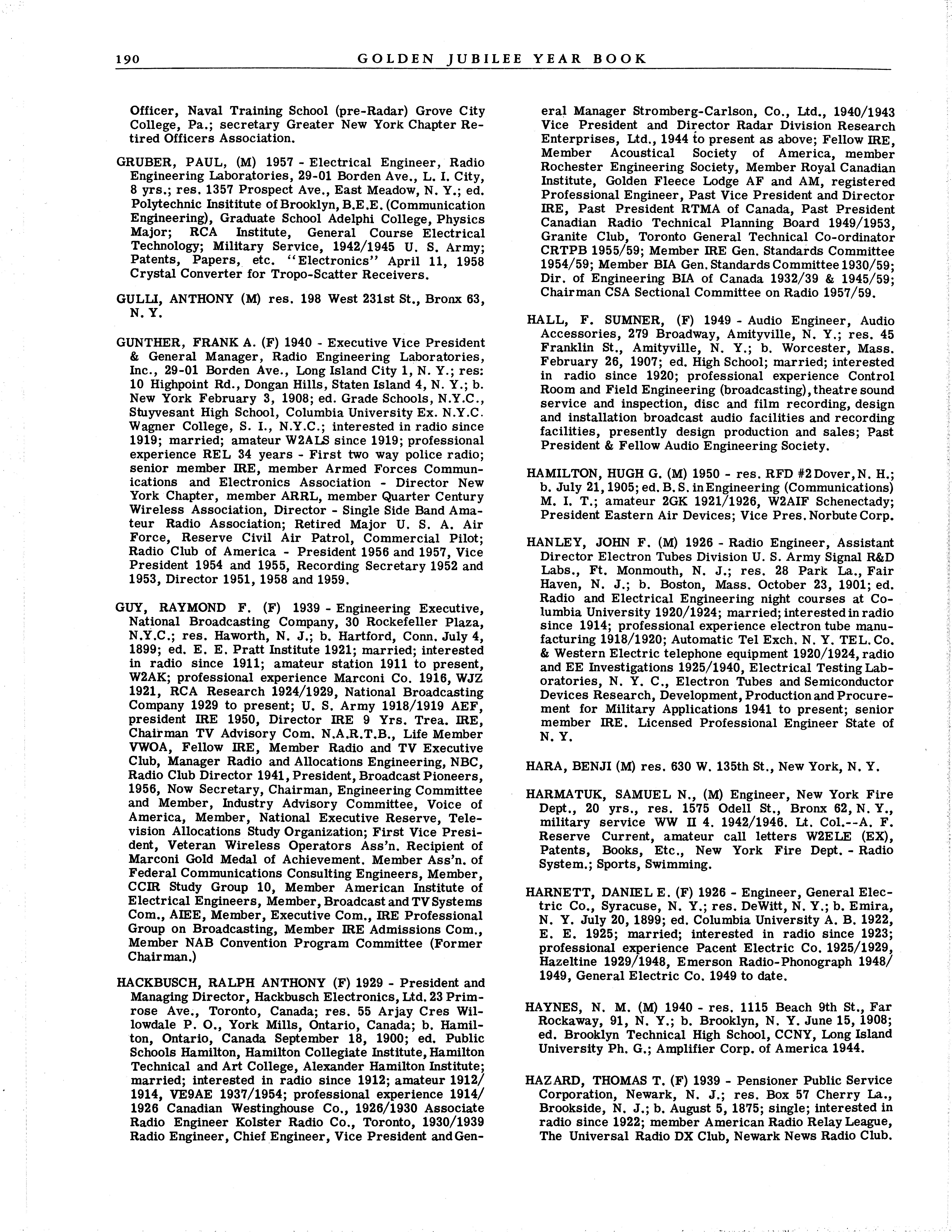
Director New
GUNTHER, FRANK A. (F) 1940 - Executive Vice President & General Manager, Radio Engineering Laboratories, Inc , 29-01 Borden Ave , Long Island City 1, N. Y.; res: 10 Highpoint Rd., Dongan Hills, Staten Island 4, N. Y.; b New York February 3, 1908; ed Grade Schools, N Y.C , Stuyvesant High School, Columbia University Ex. N.Y.C. Wagner College, S. I., N.Y.C ; interested in radio since 1919; married; amateur W2ALS since 1919; professional experience REL 34 years - First two way police radio; senior member IRE, member Armed Forces Communications and Electronics Association York Chapter, member ARRL, member Quarter Century Wireless Association, Director - Single Side Band Amateur Radio Association; Retired Major U. S. A. Air Force, Reserve Civil Air Patrol, Commercial Pilot; Radio Club of America - President 1956 and 1957, Vice President 1954 and 1955, Recording Secretary 1952 and 1953, Director 1951, 1958 and 1959.
GUY, RAYMOND F. (F) 1939 - Engineering Executive, National Broadcasting Company, 30 Rockefeller Plaza, N.Y.C.; res. Haworth, N. J.; b. Hartford, Conn. July 4, 1899; ed E E Pratt Institute 1921; married; interested in radio since 1911; amateur station 1911 to present, W2AK; professional experience Marconi Co. 1916, WJZ 1921, RCA Research 1924/1929, National Broadcasting Company 1929 to present; U. S. Army 1918/1919 AEF, president IRE 1950, Director IRE 9 Yrs. Trea. IRE, Chairman TV Advisory Com. N.A.R.T.B., Life Member VWOA, Fellow IRE, Member Radio and TV Executive Club, Manager Radio and Allocations Engineering, NBC, Radio Club Director 1941,President, Broadcast Pioneers, 1956, Now Secretary, Chairman, Engineering Committee and Member, Industry Advisory Committee, Voice of America, Member, National Executive Reserve, Television Allocations Study Organization; First Vice President, Veteran Wireless Operators Ass’n. Recipient of Marconi Gold Medal of Achievement. Member Ass’n. of Federal Communications Consulting Engineers, Member, CCIR Study Group 10, Member American Institute of Electrical Engineers, Member,Broadcast andTVSystems Com., AIEE, Member, Executive Com , IRE Professional Group on Broadcasting, Member IRE Admissions Com., Member NAB Convention Program Committee (Former Chairman.)
HACKBUSCH, RALPH ANTHONY (F) 1929 - President and Managing Director, Hackbusch Electronics,Ltd.23Primrose Ave., Toronto, Canada; res 55 Arjay Cres Willowdale P. O., York Mills, Ontario, Canada; b. Hamilton, Ontario, Canada September 18, 1900; ed. Public Schools Hamilton, Hamilton Collegiate Institute,Hamilton Technical and Art College, Alexander Hamilton Institute; married; interested in radio since 1912; amateur 1912/ 1914, VE9AE 1937/1954; professional experience 1914/ 1926 Canadian Westinghouse Co., 1926/1930 Associate Radio Engineer Kolster Radio Co , Toronto, 1930/1939 Radio Engineer, Chief Engineer, Vice President andGen-
HALL, F. SUMNER, (F) 1949 - Audio Engineer, Audio Accessories, 279 Broadway, Amityville, N. Y.; res. 45 Franklin St., Amityville, N. Y.; b. Worcester, Mass February 26, 1907; ed. High School; married; interested in radio since 1920; professional experience Control Room and Field Engineering (broadcasting),theatresound service and inspection, disc and film recording, design and installation broadcast audio facilities and recording facilities, presently design production and sales; Past President & Fellow Audio Engineering Society.
HAMILTON, HUGH G. (M) 1950 - res. RFD #2Dover,N. H.; b. July 21,1905;ed.B.S.inEngineering (Communications) M. I. T.; amateur 2GK 1921/1926, W2AIF Schenectady; President Eastern Air Devices; Vice Pres.NorbuteCorp.
HANLEY, JOHN F (M) 1926 - Radio Engineer, Assistant Director Electron Tubes Division U. S. Army Signal R&D Labs., Ft. Monmouth, N. J.; res. 28 Park La., Fair Haven, N J.; b Boston, Mass. October 23, 1901; ed. Radio and Electrical Engineering night courses at Columbia University 1920/1924; married;interestedin radio since 1914; professional experience electron tube manufacturing 1918/1920; Automatic Tel Exch. N. Y. TEL.Co. & Western Electric telephone equipment 1920/1924,radio and EE Investigations 1925/1940, Electrical TestingLaboratories, N. Y. C , Electron Tubes and Semiconductor Devices Research, Development,ProductionandProcurement for Military Applications 1941 to present; senior member IRE. Licensed Professional Engineer State of N. Y.
HARA, BENJI (M) res. 630 W. 135th St., New York, N. Y.
HARMATUK, SAMUEL N., (M) Engineer, New York Fire Dept., 20 yrs., res. 1575 Odell St., Bronx 62, N. Y., military service WW H 4. 1942/1946. Lt. Col.—A. F. Reserve Current, amateur call letters W2ELE (EX), Patents, Books, Etc., New York Fire Dept. - Radio System.; Sports, Swimming.
HARNETT, DANIEL E. (F) 1926 - Engineer, General Electric Co., Syracuse, N. Y.; res. DeWitt, N. Y,; b. Emira, N. Y. July 20, 1899; ed. Columbia University A. B. 1922, E. E. 1925; married; interested in radio since 1923; professional experience Pacent Electric Co. 1925/1929, Hazeltine 1929/1948, Emerson Radio-Phonograph 1948/ 1949, General Electric Co. 1949 to date.
HAYNES, N. M. (M) 1940 - res. 1115 Beach 9th St., Far Rockaway, 91, N. Y.; b. Brooklyn, N. Y. June 15, 1908; ed. Brooklyn Technical High School, CCNY, Long Island University Ph. G.; Amplifier Corp. of America 1944.
HAZARD, THOMAS T. (F) 1939 - Pensioner Public Service Corporation, Newark, N. J.; res. Box 57 Cherry La., Brookside, N. J.; b. August 5, 1875; single; interested in radio since 1922; member American Radio Relay League, The Universal Radio DX Club, Newark News Radio Club.
GOLDEN JUBILEE YEAR BOOK 190
HAZELTINE, (LOUIS) ALAN (F) 1915 - Technical Consultant 15 Tower Drive, Maplewood, N. J.; b. Morristown, N. J. August 7, 1886; ed M E. 1906 Stevens, Sc D. (Hon.) 1933 Stevens,A.M.1938Columbia; married; interested in radio since 1914; professional experience professor of Electrical Engineering atStevens1918/1925, Professor of Physical Math at Stevens 1933/1944, President IRE1936,Consultant WashingtonNavyYard1918/1919 radio receiver design, OSRD 1944/1945; many patents including the “Neutrodyne,” Book “ElectricalEngineering” (MacMillan, 1924), many papers mostly on radioand education; Fellow IRE, AIEE, American PhysicalSociety, AAAS, Member ASEE, American Mathematical Society, Mathematical Association of America, American Association of Physics Teachers, Optical Society of America; Radio Club of America President 1946/1947, Armstrong Medal 1937.
HEALEY, WILLIAM J. (M) 1952 - Sales Manager, Weston Electrical Instrument Co., 50 Church St., N.Y.C. res. Glen Ridge, N J.; b. Tacoma, Wash March 5, 1895; ed. Electrical Engineering ICS; interested in radio since 1924; professional experience in engineering and sales; Boy Scouts, Scout Master 18 years, Church Trustee 12 years, Masonic Orders.
HEALY, ELLIOTT L (M) res. R. F. D., Hanover, N. J.
HEES, GEORGE C (F) 1943 - Purchasing Agent, Sperry Gyroscope Co., Great Neck, N. Y ; res. 701 5th Ave., New Hyde Park, N. Y.; b. Brooklyn, N. Y May 10, 1899; ed. Pratt Institute, Brooklyn, N. Y.; married; interested in radio since 1918.
HEISING, RAYMOND A. (F) 1921 - Consulting Engineer and Patent Agent, 232 Oak Ridge Ave., Summit, N J.; b. Albert Lea, Minn. August 10, 1888; ed E.E. University of North Dakota 1912, M.S. (physics) University oc Wisconsin 1914; married; interested in radio since 1907; professional experience Western Electric Co, and Bell Telephone Laboratories 1914 to 1953; research and development on all pioneer commercial and military radio telephone applications; retired from Bell Telephone Laboratories 1953; over 120 U S Patents, dozen engineering papers, 1 book; American Physical Society, AIEE, Radio Club of America Director, ArmstrongMedal 1952 for Heising Modulation D Sc - University of North Dakota, 1947.
HENNEY, KEITH (F) 1927 - Editor, McGraw-Hill Publishing Co., 330 West 42th St., N.Y.C.; res. Garden City, N. Y. and Snowville, N. H.; b. McComb, Ohio October 28, 1896; ed. A.B. Western Reserve University 1921, A. M Harvard University 1925; married; interested in radio since 1913; amateur 8ZD and 8ADP Marion, Ohio 1915, 2EJ-1925, W1QGU-1947, K2BH-1948; professional experience Engineer Western Electric Co. 1923/1924, Radio Broadcast Magazine 1925/1930, McGraw-Hill 1930 to date; Radio Operator United Wireless 1918 and Marconi 1922; Books“ Principles of Radio” 1930, “Color Photography for the Amateur” 1938, “ElectronTubes in Industry” 1934, “ Handbook of Photography” 1939, “Radio Engineering Handbook” 1933; Fellow IRE, Member Harvard Club of N.Y.C.; Radio Club of America, President 1940, Vice President 1939, Recording Secretary 1934-1938.
HEWGLEY, CHARLES W. (M) res.170-10 Cedarcroft Rd., Jamaica 32, N. Y
HIGGS, HAROLD P. (M) 1950 - Advanced Development Engineer, Lehigh Engineering Associates; 295 Plane St. Newark, 2, N. J.; b. Toronto, Canada December 4, 1907; ed. Chicago Radio Institute, Detroit Institute of Technology; interested in radio since 1920; amateur
9CKS; professional experience mostly responsible for engineering groups dealing with design of radio and recording apparatus for homeentertainment,alsomilitary equipment; married; Hobby - Photography.
HINNERS, FRANK A. (F) 1942 - President, HINNERSGALANEK RADIO CORP., ManufacturersCavalierRadios - Phonographs, 66-02 Austin St., Forest Hills 74, N. Y.; res. 233 Raymond St., Rockville Centre, N. Y.; b New York City February 19, 1894; ed. E. E. Pratt Institute, N. Y, 1915; married; office boy, Radio Telephone Co. (Lee DeForest, Metropolitan Tower) 1910 forward; Charter Member IRE via Wireless Institute 1912, Fellow IRE 1926.

> U Principles of Color
HIRSCH, CHARLES JOACHIM (F) 1947 - Executive VicePresident, Hazeltine Research Corporation, 59-25 Little Neck Parkway, Little Neck 62, N. Y.; res #1 Fox Ridge Lane, Locust Valley, N Y.; b. Pittsburgh, Pa. October 25, 1902; ed. Columbia College A. B. 1923, Columbia School of Engineering E. E. 1925; married; professional radio experience since 1925; several patents; papers in IRE, Radio Club, IEE, SMPTE, Onde Electrique, Acta Electronica; Contributing author: “ Pender-Mcllwain Electrical Engineering Handbook, Television”; Fellow IRE and Radio Club of America, Member IEE (Great Britain), Societe des Radio-electriciens (France), SMPTE, SPSE. Past Chairman Long Island Section IRE, Past Chairman of U S Committee for CCIR Study Group XI and of several U. S. delegations abroad on TV standards, Chairman Broadcast Television Systems Committee of EIA; Panel 1 NSRC; Certificate of Commendation from U. S. Navy for contributions to Radar in World War II.
HOGAN, JOHN VINCENT LAWLESS, (HM) 1915, Consulting Engr., 1921; b. Philadelphia, Pa., February 14, 1890; s. John Lawless and Louise (Shimer) H; Grad. University School, New Haven, Conn., 1908; Lab Asst, to Dr. Lee De Forest, 1906/1907; E.E. student Sheffield Scientific Sch. (Yale), 1908/1910, honors in physics and math,; hon. D. Eng., Polytechnic Institute of Brooklyn, 1957; m. Edith MacLennan Schrader (December,1917); registered U.S. Patent Solicitor, 1921-; N. Y. Prof. Eng. 1924-; pres founder and consultant,Interstate BroadcastingCo., Stations WQXR and WQXR-FM, 1936/1949; special asst, to dir. of Office of Scientific Research and Development, 1943/1946; mem. Stag to JCS, ECM Panel RDB 1950/ 1953, Pres. & Dr. Hogan Labs., Inc., Fascimile, Inc., 1929—, Mem. Patent Compensation Bd., A.E.C., 1949 . Mem. and former chairman Joint Tech. Adv. Com., I.R.E., E.I.A. 1949—.Decorated King Christian X’sMedal of Liberation, 1946; Armstrong Medal, Radio Club of America, Radio Pioneer’s Award, 1953; Marconi Memorial Wireless Pioneer’s Medal, 1954; Medal of Honor, Inst. Radio Engineers, 1956. Fellow Inst. Radio Eng. (v. pres., 1916/1919; pres. 1920), Acoustical Soc. of Am., American Inst. Elec Engrs. Mem. AAAS, Armed Forces Communications and Electronics Assn,, Broadcast Pioneers, De Forest Pioneers, Inc. (pres., 1959), Radio Club of America, Soc American Mil. Engrs , Soc. Motion Picture & TV Eng., U.S. Preparatory Com for Internat. Radio Conf., Vet Wireless Oper. Assn , Inc., Alpha Sigma Phi. Republican. Episcopalian (Sr. Warden, St. Luke’s Episcopal Church, Forest Hills, L.I., N. Y.). Clubs: Yale (N. Y.), The Players (N. Y.), Dutch Treat (N. Y.), Cosmos (Wash.). Author: The Outline of Radio, 1923, 1925, 1928 Lecturer on technical subjects. Inventor radio devices, Res., 239 Greenway S., Forest Hills 75, L. I , N. Y.Office:155 Perry St., New York 14; interested in radio since 1902; amateur stations in N. Y., Northport, L. 1. and Cos Cob, Conn., 1902/1908; numerous patents, including single control tuner and Rectifier Heterodyne; hobbies, swimming, sailing, book, coin and stamp collecting, piano.
RADIO CLUB OF AMERICA , Inc. 191
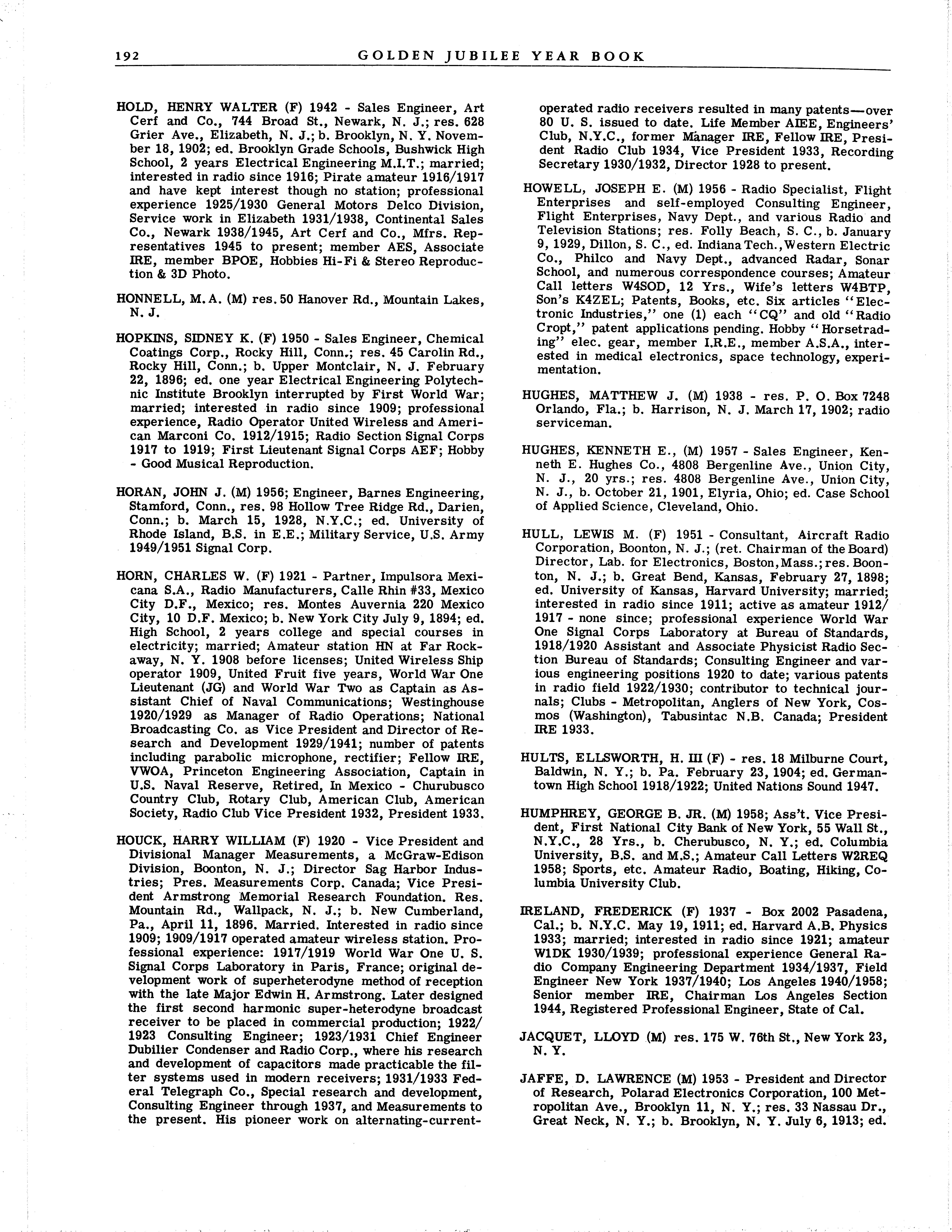
HOLD, HENRY WALTER (F) 1942 - Sales Engineer, Art Cerf and Co., 744 Broad St., Newark, N. J.; res. 628 Grier Ave., Elizabeth, N. J.; b. Brooklyn, N Y November 18, 1902; ed. Brooklyn Grade Schools, Bushwick High School, 2 years Electrical Engineering M.I.T.; married; interested in radio since 1916; Pirate amateur 1916/1917 and have kept interest though no station; professional experience 1925/1930 General Motors Delco Division, Service work in Elizabeth 1931/1938, Continental Sales Co., Newark 1938/1945, Art Cerf and Co., Mfrs. Representatives 1945 to present; member AES, Associate IRE, member BPOE, Hobbies Hi-Fi & Stereo Reproduction & 3D Photo.
HONNELL, M.A. (M) res.50 Hanover Rd , Mountain Lakes, N. J.
HOPKINS, SIDNEY K. (F) 1950 - Sales Engineer, Chemical Coatings Corp., Rocky Hill, Conn.; res. 45 Carolin Rd., Rocky Hill, Conn ; b. Upper Montclair, N. J. February 22, 1896; ed. one year Electrical Engineering Polytechnic Institute Brooklyn interrupted by First World War; married; interested in radio since 1909; professional experience, Radio Operator United Wireless and American Marconi Co. 1912/1915; Radio Section Signal Corps 1917 to 1919; First Lieutenant Signal Corps AEF; Hobby - Good Musical Reproduction.
HORAN, JOHN J. (M) 1956; Engineer, Barnes Engineering, Stamford, Conn , res 98 Hollow Tree Ridge Rd., Darien, Conn.; b. March 15, 1928, N.Y.C.; ed. University of Rhode Island, B.S. in E.E.; Military Service, U S Army 1949/1951 Signal Corp.
HORN, CHARLES W. (F) 1921 - Partner, Impulsora Mexicana S.A., Radio Manufacturers, Calle Rhin #33, Mexico City D.F., Mexico; res. Montes Auvernia 220 Mexico City, 10 D.F. Mexico; b. New York City July 9, 1894; ed. High School, 2 years college and special courses in electricity; married; Amateur station HN at Far Rockaway, N. Y. 1908 before licenses; United Wireless Ship operator 1909, United Fruit five years, World War One Lieutenant (JG) and World War Two as Captain as Assistant Chief of Naval Communications; Westinghouse 1920/1929 as Manager of Radio Operations; National Broadcasting Co. as Vice President and Director of Research and Development 1929/1941; number of patents including parabolic microphone, rectifier; Fellow IRE, VWOA, Princeton Engineering Association, Captain in U.S. Naval Reserve, Retired, In Mexico - Churubusco Country Club, Rotary Club, American Club, American Society, Radio Club Vice President 1932, President 1933.
HOUCK, HARRY WILLIAM (F) 1920 - Vice President and Divisional Manager Measurements, a McGraw-Edison Division, Boonton, N. J.; Director Sag Harbor Industries; Pres. Measurements Corp. Canada; Vice President Armstrong Memorial Research Foundation. Res. Mountain Rd., Wallpack, N. J.; b. New Cumberland, Pa , April 11, 1896. Married. Interested in radio since 1909; 1909/1917 operated amateur wireless station. Professional experience: 1917/1919 World War One U. S Signal Corps Laboratory in Paris, France; original development work of superheterodyne method of reception with the late Major Edwin H. Armstrong. Later designed the first second harmonic super-heterodyne broadcast receiver to be placed in commercial production; 1922/ 1923 Consulting Engineer; 1923/1931 Chief Engineer Dubilier Condenser and Radio Corp., where his research and development of capacitors made practicable the filter systems used in modern receivers; 1931/1933 Federal Telegraph Co., Special research and development, Consulting Engineer through 1937, and Measurements to the present. His pioneer work on alternating-current-
operated radio receivers resulted in many patents—over 80 U. S. issued to date. Life Member AIEE, Engineers’ Club, N.Y.C., former Manager IRE, Fellow IRE, President Radio Club 1934, Vice President 1933, Recording Secretary 1930/1932, Director 1928 to present.
HOWELL, JOSEPH E. (M) 1956 - Radio Specialist, Flight Enterprises and self-employed Consulting Engineer, Flight Enterprises, Navy Dept., and various Radio and Television Stations; res Folly Beach, S C , b. January 9, 1929, Dillon, S. C., ed IndianaTech.,Western Electric Co., Philco and Navy Dept., advanced Radar, Sonar School, and numerous correspondence courses; Amateur Call letters W4SOD, 12 Yrs., Wife’s letters W4BTP, Son’s K4ZEL; Patents, Books, etc. Six articles “Electronic Industries,” one (1) each “CQ” and old “Radio Cropt,” patent applications pending Hobby “ Horsetrading” elec, gear, member I.R.E., member A.S.A., interested in medical electronics, space technology, experimentation.
HUGHES, MATTHEW J. (M) 1938 - res. P. O. Box 7248 Orlando, Fla.; b. Harrison, N. J. March 17, 1902; radio serviceman.
HUGHES, KENNETH E., (M) 1957 - Sales Engineer, Kenneth E. Hughes Co., 4808 Bergenline Ave., Union City, N. J., 20 yrs.; res 4808 Bergenline Ave., Union City, N. J., b October 21, 1901, Elyria, Ohio; ed Case School of Applied Science, Cleveland, Ohio
HULL, LEWIS M (F) 1951 - Consultant, Aircraft Radio Corporation, Boonton, N J.; (ret Chairman of theBoard) Director, Lab. for Electronics, Boston,Mass.;res. Boonton, N. J.; b. Great Bend, Kansas, February 27, 1898; ed. University of Kansas, Harvard University; married; interested in radio since 1911; active as amateur 1912/ 1917 - none since; professional experience World War One Signal Corps Laboratory at Bureau of Standards, 1918/1920 Assistant and Associate Physicist Radio Section Bureau of Standards; Consulting Engineer and various engineering positions 1920 to date; various patents in radio field 1922/1930; contributor to technical journals; Clubs - Metropolitan, Anglers of New York, Cosmos (Washington), Tabusintac N.B, Canada; President IRE 1933.
HULTS, ELLSWORTH, H. HI (F) - res. 18 Milburne Court, Baldwin, N. Y.; b. Pa. February 23, 1904; ed Germantown High School 1918/1922; United Nations Sound 1947.
HUMPHREY, GEORGE B. JR (M) 1958; Ass’t. Vice President, First National City Bank of New York, 55 Wall St., N.Y.C., 28 Yrs., b. Cherubusco, N. Y.; ed. Columbia University, B.S. and M.S.; Amateur Call Letters W2REQ 1958; Sports, etc. Amateur Radio, Boating, Hiking, Columbia University Club
IRELAND, FREDERICK (F) 1937 - Box 2002 Pasadena, Cal.; b. N.Y C May 19, 1911; ed. Harvard A.B. Physics 1933; married; interested in radio since 1921; amateur W1DK 1930/1939; professional experience General Radio Company Engineering Department 1934/1937, Field Engineer New York 1937/1940; Los Angeles 1940/1958; Senior member IRE, Chairman Los Angeles Section 1944, Registered Professional Engineer, State of Cal.
JACQUET, LLOYD (M) res.175 W. 76th St., New York 23, N. Y.
JAFFE, D. LAWRENCE (M) 1953 - President and Director of Research, Polarad Electronics Corporation, 100 Metropolitan Ave., Brooklyn 11, N. Y.; res. 33 Nassau Dr., Great Neck, N. Y.; b. Brooklyn, N. Y July 6, 1913; ed.
GOLDEN JUBILEE YEAR BOOK 192

B.S. in E.E. City College 1935, M.S in E E. Columbia University 1936, Ph D. in E E. Columbia University 1940; married; interested in radio since 1940; professional experience College of the City of New York Instructor 1935/1937, Awarded Bridgham Fellow in E.E. at Columbia University, associated with Professor E. H. Armstrong on fundamental problems in frequency modulation 1937/1939; Columbia Broadcasting System, television Studio equipment 1939/1942; Raytheon Manufacturing Company, Waltham, Mass. Radar 1942/1944; Templetone Radio Manufacturing Corp. Chief Research Engineer 1944/1945, Polarad Electronics Corp. 1945 to date; eleven technical papers in various publications; Fellow IRE, Member RTMA Technical Products Division, Broadcast Transmitter Section.
JAMES, WALLACE M. (F) 1930 - Engineering Manager, Radio Corporation of America, Harrison, N J res. West Caldwell, N. J.; b. Hutchinson, Kan. September 2, 1901; ed. University of Kan., 5 years, B.S. in E.E. and B S in Engineering, other miscellaneous courses; married; interested in radio since 1925; professional experience radio and electric engineering since 1925; Member T B Pi, Sr. Member IRE; Am. Assn, for the Advancement of Sciences; Listed in “ Who is Who” in Engineering. Director 1940
JARVIS, KENNETH W. (F) 1935 - President, Jarvis Electronics Corporation, 6058 West Fullerton Ave., Chicago 39, HI.; res. 1140 Cherry St., Winnetka, Ill.; b Mansfield, Ohio, October 18, 1901; ed. Graduated E.E. Ohio State University 1923; married; interested in radio since 1912; amateur 1915/1916; professional experience Westinghouse Engineering School and Radio Laboratory, Crosley, Colonial, U.S. Radio, Director of Engineering Zenith, Consulting Engineer 18 years, Manager Electronics Department Automation Electric; 20 Patents several pending; Chapter on Detection and Modulation Henney’s Radio Engineering Handbook, many papers IRE; Fellow IRE, AIEE, Member ASM, AAAS, AFCA, Chicago Radio Engineers Club; Lecturer Graduate School Northwestern University; Reserve Officer Signal Corps,Princ Staff Eng., Electronics & Electric Dept , The Martin Co., Boy Scout Leader; Hobbies - Camping, Travelling, Flying own Plane.
JENNINGS, MALBON H. (F) 1948 - Director, Military Requirements, Ramo-Wooldridge Div. of Thompson Ramo Wooldridge, Inc., 1825 Connecticut Ave., N.W., Washington 9, D. C. Res. 2801 Dumbarton Ave., N.W., Washington 7, D. C.; b. Haverill, Mass. April 3, 1917; ed. University of Maine - Columbia University; married; interested in radio since 1930; professional experience E. H. Armstrong Junior Engineer 1938/1942, Radiation Laboratory MIT Staff Member 1942, BuShips U.S. Navy 1942/ 1943, Radio Engineering Laboratories 1943/1951 (Chief Engineer 1944/1951), Laboratory for Electronics 1951 to 1953. Director, GCA Division, 1953/1955. Independent Consultant, 1955/1956. Ramo-Wooldridge, 1956 to present. Patent on FM Recording on film or tape; Hobbiesprivate flying, restoration of early American houses and furniture.
JOHNSON, JOHN KELLY (F) 1927 - Consulting Engineer, Office & res. 184 South Ave., New Cannan, Conn.; b. Oskaloosa, Iowa, January 27, 1903; ed. A.B. and B.S. Penn College, Oskaloosa, Iowa 1923; A.B. Columbia 1924, B.S. Columbia 1925, E E. Columbia 1927; married; interested in radio since 1916; professional experienceInstructor in E.E. Columbia 1927/1929; Chief Engineer Silver Marshall 1930, Wells Gardner 1934/1937, Engineer Hazeltine Corporation 1930/1934 and 1937/1942, U.S. Navy Consultant 1943/1944, Hammerlund 1944/1945 and Consultant 1945 to present; Numerous patents all
assigned to Hazeltine; Fellow IRE, Member AIEE; Columbia University Club, N.Y.C., The Engineers Club N.Y.C.
JOLLIFFE, CHARLES BYRON (F) 1939 - Radio Executive, Radio Corporation of America, Princeton, N, J. & Camden, N J., res. 1204 E. Cherry Hill Apt., Merchantville, N. J.; b. Mannington, W. Va. November 13, 1894; ed. W. Va. University B S 1915, M S. 1920, HonLL.D. 1942, Cornell University Ph.D. 1922; widower; interested in radio since 1917; professional experience: Instructor in Physics W. Va University 1917/1918 and 1919/1920, Physics Instructor Cornell University 1920/1922, Physicist Bureau of Standards Radio Section 1922/1930, Chief Engineer Federal Radio Commission and Federal Communications Commission 1930/1935, Radio Corporation of America Engineer-in-Charge RCA Frequency Bureau, Chief Engineer of RCA Laboratories, Assistant to President, Vice President and Chief Engineer RCA Manufacturing Company 1935/1945, Vice President of RCA in charge of RCA Laboratories 1945, Executive Vice President in Charge of RCA Laboratories Division since 1945, 1951 Vice Pres. & Technical Advisor, RCA.; World War Two Chairman of Communication Division of the National Defense Research Committee, Secretary of the Industry Advisory Committee, Board of War Communications, Member Engineers Defense Board, Certificates of Appreciation from Army and Navy; Fellow AAAS, AIEE, IRE. Member Radio Pioneers
JONES, CARY BODLEY (M) 1937 - Electrical Engineer, Director of Palo Alto Physicists, P O. Box 1059 Palo Alto, Cal.; b. St. Louis County, Mo. August 9, 1910; married; ed. B.S. in E.E. Lehigh University 1934; interested in radio since 1927; professional experience Research in Electronics at Sperry Products 1936/1937, Engineering Laboratories, Tulsa 1938/1940, Research in Magnetic Recording Brush Development 1940/1945, Research and Engineering at Stanford University 1946 to present, Director Palo Alto Physicists 1948 to present; Member, Institute of Radio Engineers; Amer. Asso. for Advancement of Science; Audio Engineering Society; Acoustical Society of Amer ; Society of Motion Picture & TV Engineers; Amer. Inst, of Elec. Engineers.
KAHN, LEONARD R (M) 1953 - Owner and Research Director, Kahn Research Laboratories, Elizabeth Building, 22 Pine St., Freeport, N. Y.; res. 46 West 95th St., N.Y.C.; b. N.Y.C. June 16, 1926; ed. B.E.E. Polytechnic Institute of Brooklyn; single; interested in radio since 1940; amateur W2NOW since 1940; professional experience Consultant in Communications and Electronics, Research Director of Communications Laboratory, Adjunct Professor of Electrical Engineering Department, Polytechnic Institute of Brooklyn; number of patents and patentpendings. Papers published in Proceedings of IRE and AIEE Electrical Engineering.
KARDAUSKAS, EDMUND (M) 1950 - Project EngineerAirborne Avionics Systems; US Army Signal R&D Lab , Fort Monmouth, N. J. - res. 180 Franklin Ave., Long Beach, N. J.; b. Elizabeth, N. J. October 26, 1924; ed B.S. EE Newark College of Engineering 1949; married; interested in radio since 1938; professional experience Shepard Laboratories and Prese; Hobby - Audio.
KELLERMAN, KARL F. (F) 1946 - Engineer, Asst. V-P.Engineering, Bendix Aviation Corp., Washington, D. C.; res. 1701 K St. N.W., Washington, D C ; b Washington, D. C. May 11, 1908; ed. E.E. Cornell University1929, Graduate work in Law, Economics and Electronics; married; interested in radio since 1921; amateur work extensive but unlicensed; Registered Professional Engineer member IRE, Cornell Society of Engineers, AAAS, TB Pi
RADIO CLUB OF AMERICA, 193 n c
I I i :S ! 1 i , | 3 i : : :I : ! ! s j :

HKN, Cosmos Club, Columbia Country Club, ex-Commander USNR; Hobby - Golf.
KELLY, ARTHUR WILLIAM, JR. (M) 1957; Sales Mgr. Photocircuits Corp., Glen Cove, N. Y., res. 29 Derby Rd., Port Washington, N. Y.; b. March 31, 1926, N.Y.C.; ed. Taft Preparatory School, Watertown, Conn., Rensselaer Polytechnic Inst., Troy, N. Y., prev. emp. Motorola 1951, 1 yr., Photocircuits 1952 to present; military service 1944/1946 U.S. Naval Air Corp., Aviation Electronic Technicians mate; Sports, hobbies, etc., HiFi, skiing, sailing.
KELLEY, LEO A. (F) 1938 - res. 34-38 87 St., Jackson Heights, N. Y.; b. July 7, 1897 Arlington, Mass.; ed. M.I.T., Harvard B.S. in E.E 1918; professional experience - U. S. Signal Corps 1918/1919; Engineering Department Western Electric Co. 1920/1925, AT and T 1925/1929, International Communications Laboratories 1929/1932; Consulting Engineer to Date
KENNEDY, ROBERT E. L. (F) 1942 - Consulting Engineer, Kear and Kennedy, Washington, D. C.; res. Forest Heights, Md.; b. Norfolk, Va. January 19, 1910; ed. High School, Engineering Courses University of Va. extension, George Washington University and Catholic University; married; interested in radio since 1921; Amateur station 3RT 1924/1928, W3CQK 1930/1935; professional experience 1945 to date Partner Kear and Kennedy, 1942/1945 Assistant Head Radio Section Bureau of Aeronautics, 1940/1942 Senior Engineer with John Barron 1938/1940 Engineer with Paul Godley; Lt. Cmdr. U.S.N.R. Senior Member IRE, Charter Member Also Past President Association Federal Communications Consulting Engineers, Hobby - Yachting, Capitol Yacht Club, Washington.
KENT, ROSCOE (F) 1949 - Professional Engineer, Florida and New Jersey, and Florida representative, Industrial Instruments, Inc , Cedar Grove, N J ; res 1630 Dormont St., Orlando, Fla.; b. St. Paul, Minn. February 22, 1885; ed. School, Navy, Correspondence, home study; interested in radio since 1904; professional experience, Chief Engineer Great Lakes Radiotelephone 1908/1910, Radio Telephone and Telegraph Co., 1910/22 Mgr. N. Y. Territory, Matthews Gravity Carrier Co., 1922/31 Vice President Florida Associated Engineers, Inc., DeForest Radio, Radio Inventions, Hogan Laboratories, Consultant and Manufacturers Representative to date; Builder of first two commercial radio telephone instruments for Sandusky tests 1907, Chief Engineer Radio Telephone Co. and supervised building and installation for Navy, Admiral Evans World cruise 1908, operating the equipment from Hampton Roads to San Francisco; Senior Member IRE, Charter member DeForest Pioneers, member VIW.O.A., Society American Military Engineers, American Ordnance Assn.; During World War Two, Mgr. War Contra ts Gemex Co.; developed and produced stainless steel electrodes for pressure mounted crystals, pivot mechanisms for altimiters, non-leaded nickel silver pins for crystal holders, one piece spring release levers for airplane starters and other small delicate units.
KING, FRANK (CM, F, LM) 1909 - Consulting Engineer, Amy Aceves and King, Inc., 11 West 42 St., N.Y.C.; res. 85 Willow Ave., Larchmont, N. Y.; b. N.Y.C. January 12, 1893; ed. New York University, Columbia University E.E. 1917; interested in radio since 1907; married; amateur station “FK” 1907, later 2MP 1925, W2MP 1929, constructed and operated first amateur Telephone Broadcasting Station in U. S. in 1911; professional experience, Radio Operator S/S Montgomery 1912, President King Radio Corporation New York 1922/ 1926, 1926 to date Consulting Engineer New York City, Licensed Professional Engineer New York State 1941;
military, organized and was officer in Charge of the First U. S Naval Aircraft Radio Laboratory, Hampton Roads, Va. 1918, Officer in Charge of Aircraft Radio Telephones Headquarters Northern Bombing Group (U.S. Navy) France 1919, U. S. Naval Headquarters Washington, D. C., and Anacostia; Sports - Tennis, Golf, Horseback, Hunting; Societies - Senior MemberIRE, LifeMember Friendly Sons of St. Patrick, Phi Gamma Delta; Radio Club of America Charter Member andFirst President.
KISHPAUGH, A, W. (F) 1921 - Retired; res. 10 Yale Terrace, West Orange, N. J.; b. Newberry, Mich. November 5, 1891; ed. E.E. University of North Dakota 1912; professional experience; General Electric Co. 1912/14; Utah Power and Light Co.1914/16; Western Electric Co. and Bell Telephone Laboratories 1916/56. Member AIEE and IRE.
KLINGENSCHMITT, FRED A. (F) 1929 - Sales Engineer, Amy Aceves and King, Inc.,11 West 42 St., N.Y.C.; res. Hudson View Gardens, N.Y.C.; b. N.Y.C. September 8, 1892; ed. High School; married; interested in radio 44 years; amateur 1908/1910; professional experience1910/ 1916 commercial operator, installation and inspection, United Wireless Telegraph Co. and Marconi Wireless Telegraph Co of America; World War I Military Intelligence Branch Lieutenant, Vice President, Sleeper Radio Corporation 1921/1927, E. T. Cunningham, Inc. 1928/1929; Amy, Aceves and King 1929 to present; Radio Club of America President 1944/1945, Director-1945 to Date, Vice President 1938, Corresponding Secretary 1934/1937.
KNOOP, WALTER A., JR. (F) 1942 - Professional Engineer, Gawler-Knoop Co. 178 Eagle Rock Ave., Roseland, N. J.; res. 63 Grover La., W. Caldwell, N. J.; b. Chicago, Ill. May 14, 1919; married; ed. B.E.E. Rensselaer Polytechnic Institute; amateur W9KHG 1932, W2PXR and operated at W8XYR Whiteface Mountain Observatory; professional experience Manager Contract Division DuMont Laboratories until 1946; two patents on CR Tubes, articles for QST, Radio News, IRE Proceedings, Instruments Magazine; Member AIEE, IRE and Montclair Society of Engineers, Member-Sibma XI; Tau Beta Pi; National Pilots Assoc.
KOBI, JOHN THOMAS, (M) 1956 - Electronic Engineer, Radio Engineering Laboratories, 6 years; res. 2 Henrietta La., Massapequa Pk., L.I , N. Y.; b. November 10, 1924, Atlas, Pa., Military Service U.S.A.F. 1942/1945, Education, B.E.E , Brooklyn Polytechnic Institute, Brooklyn, N. Y.
KUNIK, I. JORDAN (M) 1952 - Patent Lawyer, 521 Fifth Ave., New York, N. Y.; b. Hartford, Conn. November 10, 1912; ed. Wesleyan University, Harvard Law School; interested in radio since 1938; professional experience in Patent Law including all phases of electronics; IRE, AAAS (Fellow), American Bar Association, New York Patent Law Association, American Chemical Society, American Institute of Chemists (Fellow), American Society for Metals.
LAFFERTY, RAYMOND E. (M) 1947, (F) 1957 - Section Supervisor, The Daven Co., Livingston, N. J. res.12-05 Sumner PI., Fairlawn, N. J.; b. Brooklyn, N. Y. July 12, 1918; ed High School, RCA Institutes, General Engineering Course; married; interest in radio since 1930; Amateur W8VTJ in Ogdensburg, N. Y. (expired), First Class Radiotelephone License since 1939; professional experience: Engineer with Boonton Radio Corporation, Ferris Instrument Corporation, A. B. DuMont Laboratories; Chief Engineer WSLB; Instructor with N. Y.State Signal Corp Training School, Paterson Radio Institute; Develop-
GOLDEN JUBILEE YEAR BOOK 194

ment Engineer, 1948-1957, with NBC; presently with the Daven Co. of Livingston, N. J. since1957;several patents and numerous papers dealing with audio and radiodevices and radio frequency measurements, 1956 IRE National Convention paper on High Frequency Shields; Senior Member IRE.
LAMB, FRANCIS XAVIER (F) 1945 - Vice Pres, and Chief Engineer, Weston Instruments, Div. of Daystrom, Inc., 614 Frelinghuysen Ave., Newark, N. J.; res. 49 Mountain View Ave., East Orange, N. J.; b. Newark, N. J. August 5, 1905; ed. Newark Technical School 1927-AE; Newark College of Engineering B.S. in E.E.1930; married; interested in radio since 1920; amateur non-licensed experiments; professional experience 1928/1936 Electrical Eng with Weston; 1937/1939 Res. Eng. in Japan for Weston, 1940/1942 Project Eng.on Research and Development, 1942/1943 Liaison Eng. for Weston assigned to Sangamo-Weston Co., Springfield, Ill., 1944/ 1951 Asst. Chief Engineer, Weston, 1952/1953Chief Eng., Weston, 1954 Vice Pres, and Chief Eng. Weston; Profession Eng. License #5573, 25 U.S. Patents; Fellow AIEE, Member IRE, ISA, RCA, SAMA, ASA, NAM, AFCEA, Company Rep. ASA (C39), ASA (Indicating Instruments C39. I). Honorary Membership Eta Kappa Nu Assn.; Technical Publications 9.
LAMB, JAMES J., (F) 1958 - Consulting Eng.; res. 4 Rock Ridge Dr., S. Norwalk, Conn.; b. November 30, 1900 at Michigan City, N. Dakota; ed Michigan, N.D. grade and high school; St, Thomas College (S A.T.C.) 1918, U. of Minn., 1919, Catholic Univ. of America, 1919/22, B.S. in E.E. Georgetown U. Law, 1928, U. of Conn. Industrial Eng course, 1944; employed by Remington Rand Div., Sperry Rand Corp., 1941 to date; American Radio Relay League, 1928/1941; J. P. Lamb Land Co., Michigan, N. D. 1924/1927, Valley Radio Div., Electric Construction Co., Grand Forks, N. D.1922/24; Military Service, enroUed in Student Army Training Corps.,1918;Amateur Call Letters 9CEI, 1925/27, 3CEI, 1928,WICEIand WIAL, 1928-WW2. Also held 2nd. Class Commercial 1922/1927 and First Class Commercial, 1928/29; Patents, 6Patents in electronic field, co-author two technical manuals, author over 60 papers and articles published, including one in RCA Proc., Q.S.T. Also gave one RCA paper on Industrial TV, Stereo sound and photography, Norwalk Shore and Country Club designing ham radio gear; member of So. Norwalk Public Library Board and member of 3rd Ward Democratic com., member of National Catholic Social Action Conference.
LANDMAN, RAY R., (M) - Engineering Aid, Radio Engineering Labs., 3 years, res 67-108th St., Forest Hills, N. Y.; b. England, ed. attending City College, N. Y.; Military Service Air Force 4 years; Amateur Call Letters K2AWQ, 6 yrs.; Hobbies, photography,automatovies.
LANGER, PETER LAWRENCE (M) 1954 - Sylvania Electric Products Co.,^700 Ellicoh St., Batavia, N. Y.; res. 43-55 168 St., Flushing, L.I., N. Y.; b N.Y.C. February 17, 1915; ed. Lawrence High School 1928/1934, Navy Electronics School 1943/1944; professional experiencePhilco Field Service Engineer 1946/1949; 1949 to date Field Service Engineer, Sylvania Elec. Products; Member IRE.
LANGLEY, RALPH H. (F) 1928 - Retired; res.18 Prescott Ave., Bronxville, N. Y.; b. N.Y.C., January 5, 1889; ed. Columbia University, E.E. 1913; married; interested in radio since 1906; built IKW Quenched Gap Transmitter in the Electro-Chemical Laboratory at Columbia; professional experience 1913/1916 with Colonel John Firth, 1916/1920 Marconi Wireless Telegraph Co. of America, 1920/1927 General Electric Co., RadioDepartment,Schenectady, 1927/1931 Director of Engineering Crosley Ra-
dio Corporation, Cincinnati, Ohio, then as Consulting Engineer following 1931; Underwater Sound Laboratory, New London, Conn. 1941/1943, Asst, to Dir. Hazeltine Electronics Corp., Little Neck, L I , N. Y 1943/1946; in charge of Licensee Laboratory Olympic Radio & Television Corp. Long Island City, N. Y. 1946/1948, Vice President in charge of Engineering, Farrand Optical Co., Inc. Bronx, N. Y. 1948/1957 Asst, to the President; Radio Club of America President 1935/1936, Vice President 1934, Corresponding Secretary 1933, Director 1932.
LaPENNA, FRANK (M) 1949 - Assistant Professor, Hudson Valley Tech. Inst., Troy, N.Y.;res.StatenIsland, N.Y.C.; b. N.Y.C. December 18, 1898; ed. RCA Institutes; married; interested in radio since 1933.
LAYMAN, PAUL N. JR (M) - 50 Sutton Place South, New York 22, N. Y.
LeBEL, CLARENCE J. (F) 1926 - Chief Engineer, Audio Instrument Co., Inc., 135 West 14St.,NewYork 11, N. Y.; Vice President, Audio Devices, Inc.; res. 370 Riverside Dr., New York 25, N. Y.; b. New York, N. Y. December 16, 1905; ed. S.B. and S.M.inE.E.MIT; single, interested in radio six years, audio 32 years; professional experience 32 years Raytheon, Inc. Research Engineer 1927/ 1929, 1929/1932 Research Eng., Hygrade Sylvania Co., Consulting Engineer, Audio Devices Inc , Maico Co , Audio Instrument Co , 9 Patents, many papers, one book “How to Make Good Tape Recordings;” member AIEE, Acoustical Society of America, SMPTE, Fellow AES, Past President and now Secretary; Radio Clubof America Director.
LEMMON, WALTER S. (F) 1914 - President Radio Industries Corporation,1 East 57 St., NewYork22, N. Y.; res. Greenwich, Conn.; b. N.Y.C. February 3, 1896; ed. E.E. degree Columbia University; married; Amateur Station “AX” New York 1908 and later licensed 21E until 1917; professional experience U. S. Navy Radio Officer, Development Engineering Radio Receivers, general radio executive work, developed radiotype for International Business Machines Corp., International Broadcasting stations, WRUL, Boston; Radio Club of America Recording Secretary 1917/1920, Director 1915/1916, 1921/1922.
LEMPERT, IRVING E. (M) 1941 - Engrg. Sector-Mgr., Westinghouse Electric Corp., Metuchen, N. J.; res. 51 Linden Ave., Metuchen, N. J.; b. N.Y.C. April 11, 1917; ed. Lehigh University B.S. in E.E.
LERZ, OTTO M, JR (M) - res 25 Iowa Rd., Great Neck, N. Y.
LESCARBOURA, AUSTIN C. (F) 1919 - Pres., Lescarboura Advertising, Inc., County Trust Bldg , Ossining, N. Y.; res. 105 Narragansett Ave., Ossining, N. Y.; b. N.Y.C. June 5, 1891; ed. High School of Commerce, N.Y.C., evening courses, correspondence courses, Hon. D. Litt. Guest Lecturer, School of Journalism, Syracuse University; married; interested in radio since 1907; amateur spark coil station “JR” in New York 1908/1909; professional experience:Engineer with Telefunken Wireless Telegraph Company in New York 1908/1909, editor Modern Electrics 1907/1908, Associate Editor of Dun’s Review 1911/1912, Editor of Modern Electrics and Mechanics (Now Popular Science Monthly) 1912/1915, Managing Editor of Scientific American 1915/1924, Editor with Hardware Age 1925, owner industrialadvertising agency 1925 to present; co-inventor of adjustable pitch mechanical phonograph reproducer; Books: “Radio for Everybody” (1921); “ This Thing Called Broadcasting” (1931); Chevalier French Legion of Honor, Past Governor of Rotary International (New York Area); Hobby
RADIO CLUB OF AMERICA, Inc 195
i

Photography; Advertising Club of N. Y., 32°Mason; Rotary Club of Peekskill; Avocations: Lay preacher andLay reader in Protestant-Episcopal Church; Radio Club of America Director 1927/1929.
LEWIS, HAROLD MILLER (F) 1925 - Professional Engineer N. Y. State; res. 510 Blanchard Parkway, West Allenhurst, N. J.; b. Geneva, N. Y. January 12, 1893; married; ed. B.E. Union College 1916, Radio Engineering Course, Sorbonne, Paris 1919; interested in radio since 1906; amateur: electrolytic receivers 1906/1910; professional experience General Electric Research 1916/1917, Signal Corps Division of Research Paris 1918/1919, Radio Engineer Signal Corps 1919/1921, President Radio Service Laboratories 1921/1925; President LeMor Radio 1925/1927, Signal Corps Fort Monmouth 1927/1930, Hazeltine Electronics Corp. Engineer in charge of Television 1930/1937, Consulting Engineer 1939/1941, Hazeltine Corp. in Charge of I.F.F. Training 1942/1944, Technical Adviser Hazeltine Patent Department 1945/1946, Patent Adviser Signal Corps 1948 to 1955; about 60 U S Patents, papers in IRE and Electronics; original superheterodyne development with E. H. Armstrong 1918, Television Standards Committee 1931/1936,devisedWhipAntennafor Army Tanks; member AIEE, IRE, Chairman, N. Y. section 1944; Director Radio Club 1934/37.
LONG, ESCO C. (M) - Senior Standards Engineer, Stavid Engineering, Inc., Plainfield, N. J.; res. NewProvidence, N. J.; b. Twin Rocks, Pa. August 24, 1906; ed. Indiana State Teachers College B.S., Penn State and University of Pittsburgh Graduate Work; married; five children; interested in radio since 1918; amateur: built various types transmitters and audio amplifiers; professional experience: Radio Engineering Naval Research Laboratory, Washington, D. C.; three years Stavid Engineering, Inc., Supervisor of the Standards Section; eleven years Shepard Laboratories, Summit, N. J. as ProjectEngineer in Electronics; High School Instructor in Mathematics (12 years); Metropolitan Life Insurance Co. (2 years); U.S.N.R. (Electronics) during World War H, Boy Scout (Eagle Scout), Played Baseball, Football, Basketball and Tennis; Hobbies - Gardening, Hunting and Fishing; Lions Club (Secretary), PTA (President).
LOUGHLIN, BERNARD D. (F) 1940 - Electronic Research Consultant; res. Little Neck Rd., R.D. 5, Huntington, N. Y.; b. May 19, 1917; ed. Cooper Union B.E.E. 1939; Fellow IRE, member AIEE, IRE Zworglin TV Prize Award, 1952, SMPTE Sarnoff Gold Medal Award, 1955, IRE, 1957 award of PGBTR.
LOUGHREN, ARTHUR VIVIAN (F) - Vice Pres., Airborne Instruments Laboratory Division of Cutler-Hammer,Inc., Mineola, N. Y. Applied Research Division; res.22Broadlawn Ave., Great Neck, N. Y.; Radio Eng.; b. Rensselaer, N. Y., September 15, 1902; ed Columbia Univ.A.B.1923, E.E. 1925; Phi Beta Kappa, Sigma Xi, Tau Beta Pi; married; Gen. Elec. Co., Schenectady 1925/30; RCA Mfg. Co., Camden, N. J. 1930/34; Gen. Elec, Co., Bridgeport, Conn. 1934/36; Hazeltine Electronics Corp. 1936/56Ch. Eng. 1946/49, V.P. charge research 1951/56 also Exec. V.P. Hazeltine Research Corp. 1952/56. Holder of 29 patents, and continuously in radio and TV since 1925. Fellow of IRE, SMPTE, AIEE, and Radio Club of America; President IRE 1956; member Joint Technical Advisory Committee; National Stereophonic Radio Committee; holder David Sarnoff Gold Medal, 1953; Morris Liebmann Memorial Prize 1955; U.S Navy Certificate of Commendation, 1947
LYNCH, ARTHUR H. (F) 1922 - Field Engineer, Arthur H. Lynch and Associates, 67 W.N.Shore Ave,, Fort Myers, Fla.; b. Brooklyn, N. Y. July 2, 1894; ed. 3 Years High School several correspondence courses electronics etc.;
married; interested in radio since 1908; amateur station Brooklyn and Jamaica,,L.I. 1908; presently W4DKJ all bands; professional experience Marconi Wireless Telegraph Co. 1912, Army Officers Training School, Tours France World War One, Radio Department New York Times 1920, Director of Publicity RCA1920,EditorRadio Broadcast 1924/1928, Manufacturer Fixed Resistors 1929/1940 and Noise Reducing Antennas 1937/1942, Editor Radio News 1935/1936, now represents 30 manufacturers in Fla.; Senior Member IRE, Life Member VWOA and Recipient VWOA Marconi Medal; Hobbies - amateur radio, flying, yachting; Director Lee County Chamber of Commerce, Florida; Radio Club of America Recording Secretary 1924/1926
LYON, WALTER (M) 1951 - Communications Engineer, RCA Communications, Inc., 66 Broad St., N.Y.C.; res. 3326 160 St., Flushing, L.I., N. Y.; b. October 5, 1906 N.Y C ; ed. Morris High School, McGill University B.S. in Engineering 1928, M.Sc. in Physics and Mathematics 1932; married; interested in radio since 1918; Professional experience Hazeltine Service Corp. 1929/1932, 1934/1937, Chief Engineer Wells-Gardner 1933/1934, Chief Engineer Emerson Radio TV Corp., Asst. Chief Engineer Majestic Radio and TV Corp. 1937/1938, RCA Victor design Engineer 1938/1945, RCA International Division Staff engineer 1945/1946; RCA Communications Manager, Station Facilities (Equipment & Systems) 1946 to present; 15 U.S. Patents, several papers in “Electronics” RCA Review, I.R.E. and A.I.E.E. Transactions also Sigma Xi., member IRE, Cold Iron Society, Roslyn Rifle and Revolver Club, Chairman E.I.A. TR 6 Com. on Long Distance Point to Point Radio Communications 1949 to date; Professional Engineer, N Y. State, Consulting Communications Engineer, Adjunct-Professor of Electrical Engineering, Polytechnic Institute of Broklyn.
MAC DONALD, WILLIAM ALEXANDER (F) 1937 - Chairman of the Board, Hazeltine Corporation, 59-25 Little Neck Parkway, Little Neck, N. Y.; res. Bayville Rd., Locust Valley, N. Y ; b. New York, N. Y. December 27, 1895; ed. University of Paris,France; married;interested in radio since 1913; amateur 2 yrs.; professional experience 43 years, licensed Professional Engineer, N. Y. State, Radio Operator Marconi Wireless Telegraph Co. 1913/1915 aboard munitions ships, Laboratory asst. Western Electric Co. 1916, U. S. Army Signal Corps 1917/1918 advancing through grades to commissioned officer, assisted Edwin H. Armstrong in establishing at Paris first Laboratory, Div. of Research and Inspection. Set up school at Orly and instructed pilots and observers in first air-borne radio-telephone equipment. During 1918, constructed first superheterodyne receiver under Armstrong guidance, Assistant Radio Eng. Civil Service Com.1919/1920, Engineer Radio Corp. of America 1920/ 1924, Chief Engineer Hazeltine Corp. since 1924, Director since 1934, Vice President 1934/1952, Pres. 1952/ 1957, Chairman since 1957, Research Corp. of Calif. 1946/1952, Dir. since 1946; 110 U.S.andForeignPatents; American Society of Naval Engineers, National Security Industrial Assn., Armed Forces Communications Assn., Army Ordnance Assn., Fellow Institute of Radio Engineers, Dir. Radio-Electronics Television Manfrs. Assn., Member Electronics Equipment Industry Advisory Com. of the Munitions Bd., Member of the Joint Electronics Industry Com., Awarded Certificate of Merit World War Two, Engineers Club, Founding Member, Armstrong Memorial Research Foundation, Inc., Member Advisory Group on Reliability of Electronics Equipment (Agree) Task Group No. 6.
MacLAREN, FRED B. (M) 1951 - President, F. B. MacLaren Inc., 15 Bay Drive West, Huntington, L.I., N.Y.; Vice-President, Photomechanisms; res. same; b. Jersey
GOLDEN JUBILEE YEAR BOOK 196
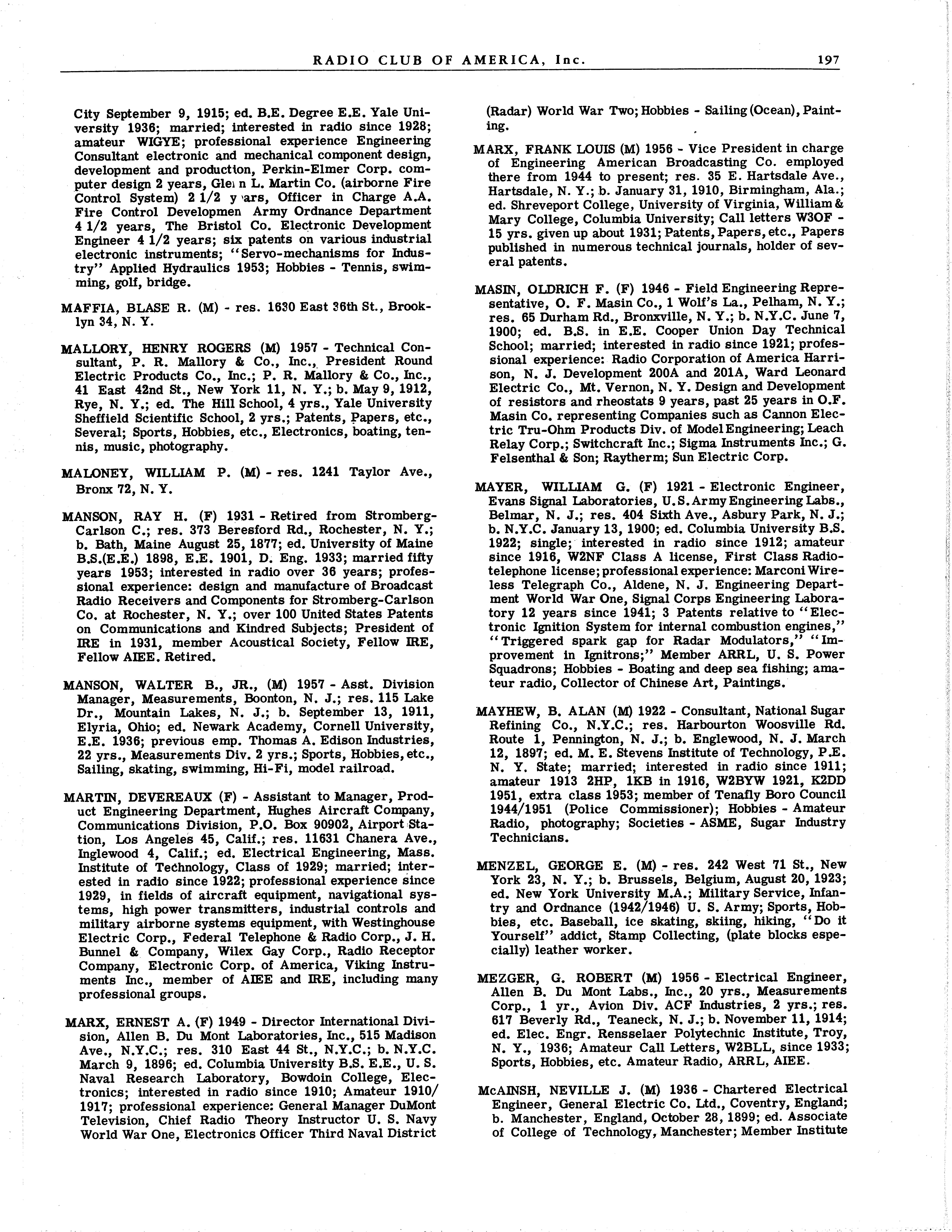
City September 9, 1915; ed. B.E. Degree E.E. Yale University 1936; married; interested in radio since 1928; amateur WIGYE; professional experience Engineering Consultant electronic and mechanical component design, development and production, Perkin-Elmer Corp. computer design 2 years, Glei n L. Martin Co. (airborne Fire Control System) 21/2 y >ars, Officer in Charge A.A. Fire Control Developmen Army Ordnance Department 4 1/2 years, The Bristol Co. Electronic Development Engineer 41/2 years; six patents on various industrial electronic instruments; “Servo-mechanisms for Industry” Applied Hydraulics 1953; Hobbies - Tennis, swimming, golf, bridge.
MAFFIA, BLASE R. (M) - res. 1630 East 36th St., Brooklyn 34, N. Y.
MALLORY, HENRY ROGERS (M) 1957 - Technical Consultant, P. R. Mallory & Co., Inc., President Round Electric Products Co., Inc.; P. R. Mallory & Co., Inc., 41 East 42nd St., New York 11, N. Y.; b. May 9, 1912, Rye, N. Y.; ed. The Hill School, 4 yrs., Yale University Sheffield Scientific School, 2 yrs.; Patents, Papers, etc., Several; Sports, Hobbies, etc., Electronics, boating, tennis, music, photography.
MALONEY, WILLIAM P. (M) - res. 1241 Taylor Ave., Bronx 72, N. Y.
MANSON, RAY H. (F) 1931 - Retired from StrombergCarlson C.; res. 373 Beresford Rd., Rochester, N. Y.; b. Bath, Maine August 25, 1877; ed. University of Maine B.S.(E.E.) 1898, E.E. 1901, D. Eng. 1933; married fifty years 1953; interested in radio over 36 years; professional experience: design and manufacture of Broadcast Radio Receivers and Components for Stromberg-Carlson Co. at Rochester, N. Y.; over 100 United States Patents on Communications and Kindred Subjects; President of IRE in 1931, member Acoustical Society, Fellow IRE, Fellow AIEE. Retired.
MANSON, WALTER B., JR., (M) 1957 - Asst. Division Manager, Measurements, Boonton, N. J.; res.115 Lake Dr., Mountain Lakes, N. J.; b. September 13, 1911, Elyria, Ohio; ed. Newark Academy, Cornell University, E.E. 1936; previous emp. Thomas A. Edison Industries, 22 yrs., Measurements Div. 2 yrs.; Sports, Hobbies,etc., Sailing, skating, swimming, Hi-Fi, model railroad.
MARTIN, DEVEREAUX (F) - Assistant to Manager, Product Engineering Department, Hughes Aircraft Company, Communications Division, P.O. Box 90902, Airport Station, Los Angeles 45, Calif.; res. 11631 Chanera Ave., Inglewood 4, Calif.; ed. Electrical Engineering, Mass. Institute of Technology, Class of 1929; married; interested in radio since 1922; professional experience since 1929, in fields of aircraft equipment, navigational systems, high power transmitters, industrial controls and military airborne systems equipment, with Westinghouse Electric Corp., Federal Telephone & Radio Corp., J. H. Bunnel & Company, Wilex Gay Corp., Radio Receptor Company, Electronic Corp. of America, Viking Instruments Inc., member of AIEE and IRE, including many professional groups.
MARX, ERNEST A.(F) 1949 - Director International Division, Allen B. Du Mont Laboratories, Inc., 515 Madison Ave., N.Y.C.; res. 310 East 44 St., N.Y.C.; b. N.Y.C. March 9, 1896; ed. Columbia University B.S. E.E., U.S. Naval Research Laboratory, Bowdoin College, Electronics; interested in radio since 1910; Amateur 1910/ 1917; professional experience: General Manager DuMont Television, Chief Radio Theory Instructor U. S. Navy World War One, Electronics Officer Third Naval District
(Radar) World War Two;Hobbies - Sailing(Ocean),Painting.
MARX, FRANK LOUIS (M) 1956 - Vice President in charge of Engineering American Broadcasting Co employed there from 1944 to present; res. 35 E. Hartsdale Ave , Hartsdale, N. Y.; b. January 31, 1910, Birmingham, Ala ; ed. Shreveport College, University of Virginia, William & Mary College, Columbia University; Call letters W30F15 yrs. given up about 1931;Patents,Papers,etc., Papers published in numerous technical journals, holder of several patents.
MASIN, OLDRICH F. (F) 1946 - Field Engineering Representative, O. F. Masin Co.,1 Wolf’s La., Pelham, N.Y.; res. 65 Durham Rd., Bronxville, N.Y.; b. N.Y.C. June 7, 1900; ed. B.S. in E.E. Cooper Union Day Technical School; married; interested in radio since 1921; professional experience: Radio Corporation of America Harrison, N. J. Development 200A and 201A, Ward Leonard Electric Co., Mt. Vernon, N. Y. Design and Development of resistors and rheostats 9 years, past 25 years in O.F. Masin Co. representing Companies such as Cannon Electric Tru-Ohm Products Div. of ModelEngineering;Leach Relay Corp.; Switchcraft Inc.; Sigma Instruments Inc.; G. Felsenthal & Son; Raytherm; Sun Electric Corp.
MAYER, WILLIAM G. (F) 1921 - Electronic Engineer, Evans Signal Laboratories, U.S.ArmyEngineering Labs., Belmar, N. J.; res. 404 Sixth Ave., Asbury Park, N.J.; b. N.Y.C. January 13, 1900; ed. Columbia University B.S. 1922; single; interested in radio since 1912; amateur since 1916, W2NF Class A license, First Class Radiotelephone license;professionalexperience:MarconiWireless Telegraph Co., Aldene, N. J. Engineering Department World War One, Signal Corps Engineering Laboratory 12 years since 1941; 3 Patents relative to “Electronic Ignition System for internal combustion engines,” “Triggered spark gap for Radar Modulators,” “Improvement in Ignitrons;” Member ARRL, U. S. Power Squadrons; Hobbies - Boating and deep sea fishing; amateur radio, Collector of Chinese Art, Paintings.
MAYHEW, B. ALAN (M) 1922 - Consultant, National Sugar Refining Co., N.Y.C.; res. Harbourton Woosville Rd. Route 1, Pennington, N. J.; b. Englewood, N. J. March 12, 1897; ed. M. E.Stevens Institute of Technology, P.E. N. Y. State; married; interested in radio since 1911; amateur 1913 2HP, 1KB in 1916, W2BYW 1921, K2DD 1951, extra class 1953; member of Tenafly Boro Council 1944/1951 (Police Commissioner); Hobbies - Amateur Radio, photography; Societies - ASME, Sugar Industry Technicians.
MENZEL, GEORGE E. (M) - res. 242 West 71 St., New York 23, N. Y.; b. Brussels, Belgium, August 20, 1923; ed. New York University M.A.; Military Service, Infantry and Ordnance (1942/1946) U. S. Army; Sports, Hobbies, etc. Baseball, ice skating, skiing, hiking, “Do it Yourself” addict, Stamp Collecting, (plate blocks especially) leather worker.
MEZGER, G. ROBERT (M) 1956 - Electrical Engineer, Allen B. Du Mont Labs., Inc., 20 yrs., Measurements Corp., 1 yr., Avion Div. ACF Industries, 2 yrs.; res. 617 Beverly Rd., Teaneck, N. J.; b. November 11, 1914; ed. Elec. Engr. Rensselaer Polytechnic Institute, Troy, N. Y., 1936; Amateur Call Letters, W2BLL, since 1933; Sports, Hobbies, etc. Amateur Radio, ARRL, AIEE.
McAINSH, NEVILLE J. (M) 1936 - Chartered Electrical Engineer, General Electric Co. Ltd., Coventry, England; b. Manchester, England, October 28, 1899; ed Associate of College of Technology, Manchester; Member Institute
RADIO CLUB OF AMERICA, Inc 197
i i ; j i I i
: ;} I : ,5 \
:
? i ! 1 j
of Electrical Engineers; professional experience: engineering and development of electronic and television equipment at executive level
McCOY, DANIEL C. (F) 1921 - Consulting Engineering, Refrigeration, and Food Technology, Sales and Sales Management; 7546 Normandy La., Dayton 59, Ohio; res. same; b. N.Y.C. December 22, 1894; ed. Public Schools of Tarrytown and Yonkers, N. Y., Cornell University (Chemistry); married; interested in radio since 1900; active amateur since 1906 except for war periods and brief periods due to change in residence; professional experience: Marine operator 1911/1916 (summer vacations); Lecture Assistant Department of Chemistry Cornell University 1914/1917; Commissioned Officer Signal Corps and Air Service World War One;Sales and Sales Management in automobile business 1919/1925; Frigidaire Division of General Motors Corp. 1925-retired October, 1955, activities included sales, sales engineering, and sales management work in commercial and industrial refrigeration and air conditioning, directed field engineering organization, edited three commercial refrigeration engineering manuals, directed frozen food research, final assignment Technical Consultant staff of General Sales Manager; Fellow, American Society of Refrigerating Engineers; Charter Member of the Institute of Food Technologists, Member American Society of Agricultural Engineers, Engineer’s Club of Dayton, ARRL, OldOld Timers Club, Quarter Century Wireless Association, Dayton Amateur Radio Association (past president), Delta Upsilon Fraternity, Scabbard andBlade, Alembic (Cornell); hobbies are amateur radio, fishing, and sailing.
McDOUGALL, DUGALD S. (M) 1950 (F) 1953 - Patent Attorney, Ooms, McDougall, Williams & Hersh,135 So. La Salle St., Chicago, Ill.; res. 1231 Ashland Ave., Wilmette, Ill.; b. Indianapolis, Ind. May 15, 1916; ed. A.B. University of Chicago 1935, J.D. University of Chicago 1937, special courses Harvard University radar and ultra-high-frequency techniques 1943, MIT 1943; married; interested in radio since 1927; amateur W9CVQ since 1929, presently W9CVQ; professional experience; practiced patent law since 1946 with emphasis on electronics, Instructor in Radar U. S. Naval Reserve 1943/ 1945, Naval Research Laboratories 1945/1946; member IRE, American Bar Association.
MCKENZIE, ALEXANDER ANDERSON (F) 1948 - Editor, Engineering Books, McGraw-Hill Book Co., 330 West 42nd St., New York 36, N. Y.; res. 245 Poplar Ave., Hackensack, N. J.; b. Albany, N.Y.October 2, 1908; ed. Albany public Schools and Albany Academy 1928, Dartmouth College A.B. 1932; married; interested in radio since 1920; amateur W1BPI (1931) and W2SOU 1946 but continuously licensed; professional experience: radio operator or radio operating engineer at Mt. Washington, N. H. Observatory, Research Assistant Yankee Network, Inc., Research Assistant Carnegie Institution of Washington, Staff member Radiation Laboratory MIT; Member (SM) IRE, Institute of Navigation, ARRL, Appalachian Mountain Club, Mt. Washington Observatory Inc.; Active in Hackensack politics, PTA and similar school-centered work, Member, Board of Education 1955/60, President 1959/60, local church work; Co-editor “ Loran,” author and publisher “Key and Answers to New Radiotelegraph Examination Questions,” Radio Operating Questions and Answers;” pioneered in 5 meter and 2.5 meter communications between Mt. Washington and Blue HiU Observatory 1935/1937 and with Radiosonde at 60 me and during 1937 on similar sounding at the Bartol Research Foundation, returned to Mt. Washington to install Yankee Network 41 me FM station and heard first FM Signals from Alpine in 1938; transferred to Paxton 1939 on first 50
KW FM station, Radiation Laboratory MIT 1942 on Loran with field work in U.S.,,Canada, Labrador and Newfoundland; Electronics magazine 1945 to 1957; McGraw-Hill Book Co.1957 to present.
McMANN, RENVILLE H. (F) 1919 - Consultant; res. 60 East 96th St., New York City 28, N. Y.; b. N.Y.C. June 29, 1895; ed. Choate, U.S. Naval Radio School, Harvard University; married; interested in radio since1912;amateur 2 MC from 1919 to 1928; professional experience R. H. McMann, Inc. radio distributors, 12 Warren St., N.Y.C., Procurement Director Republic Aviation, December 1942 to 1945, Westinghouse Electric Corp.1945/ 1957; Past President West Side Tennis Club, Past President United States Lawn Tennis Association; Radio Club of America Corresponding Secretary 1921/1924.
McMANN, RENVILLE H., JR. (F) 1944 - Engineering Manager CBS “Sentry” CBS Laboratories, Stamford, Conn.; res. 60 East 96 St., N.Y.C.; b. N.Y.C. August 20, 1927; ed. B.E. Yale University, 1950; single; Pioneer in amateur teletype activities; Professional Experience, 5 summers plus one and one-half years in Columbia University and Alpine, New Jersey Laboratories of Major E. H. Armstrong; TV Development Laboratory National Broadcasting Co., 52/55 Pilot Member Soaring Society of America, Patents in Color TV field.
MEYERS, JAMES G. (M) 1949 - Government Electronics Inspector, Department of Defense, U. S. Army Signal Supply Agency, 225 S. 18 St., Philadelphia 3, Pa.; res. 1056 Sheridan Ave., Bronx 56, N.Y.; b. N.Y.C. January 13, 1914; ed. University of Illinois, RCA Institute, Capitol Radio Engineering Institute; interested in radio since 1933; married; ex-amateur and ship’s operator, American Export Line; professional experience: radio operator 2 years, Chief Engineer 5 years, Laboratory Electronic Engineer 10 years, Government Electronics Inspector 7 years, U. S. Marines 2 years; Captain U. S. Marines Radar School, Senior Member IRE, Charter MemberAES; Hobbies - Radio, Audio Amplifiers; Contributor Radio and Television News; Sports - wrestling.
MEYERSON, ART H. (M) 1956 - Lieutenant, New York Fire Department, Bureau of Fire Communications, 22 yrs.; res. 60 Knolls Crescent, New York 63; b.August 1, 1909, N.Y.C.; ed. Fordham University 1 yr., Pratt Institute, 2 yrs., New York University1-1/2 yrs.; Patents,Papers, etc., Various papers published in “Communications,” on superregeneration VHF techniques, Coil Q, portable mobile XMTRS and RCVRS; Sports, Hobbies, etc., Member IRE, Member AES, Hobby High Fidelity
MEYER, STUART F (M) 1955 - Engineering Dept.Supervisor, Allen B. DuMont Labs., 51/2 yrs.; res.1103 Kent PL, Unden, N. J.; b. N.Y.C. February 4, 1918; ed. High School and DeVry Institute Correspondence Course (Radio & TV) and 6 months Technical Course U.S.Navy; Military Service 5 yrs. U. S. Navy, Maintenance Radar and Communication Equipment 21/2 yrs.as Instructor; Amateur Letters, W2GHK since 1933; Patents, Papers, etc. IRE Papers, a Manually Operated Demand Repeater, Vehicular Noise Problems in Modern Land-mobile Systems, plus many technical talks before; Association of Police Communication Officers, International Municipal Signalmans Assn. Pennsylvania Elec. Assn. Forestry Conservation Service, etc., “Many Radio Clubs;” Sports Hobbies, etc.,Bowling,Woodworking,MemberIRE,ARRL, RSGB, Tri County Amateur Radio Assn., Former President Staten Island Amateur Radio Assn.; Currently finishing up installation of San Francisco Police Radio System which is used in Filming of Current “ Line-up” series.

:
198 GOLDEN JUBILEE YEAR BOOK
MEZGER, GEORGE ROBERT (M) - res. 617 Beverly Rd., Teaneck, N. J.
MILLER, ARTHUR G. (M) 1949 - Electrical Manufacturing, Delta Electronics, 259 Green St., Brooklyn, N. Y.; res. 730 Rifton St., Elmont, L.I., N. Y.; b N.Y C. January 3, 1916; ed. Cooper Union; married; interested in radio since 1925; First Class Radio Operator.
MILLER, DONALD H. (F) 1944 - New York District Manager, Electronics, Advertising Sales Dept., McGraw-Hill Publishing Company, Inc., 500 Fifth Ave., New York 36, N. Y.; res. 177 Clinton Ave., Dobbs Ferry, N. Y.; b. Cambridge, Mass. May 4, 1902; ed. B.S. in Engineering Tufts University; married; active in radioandelectronics since 1921.
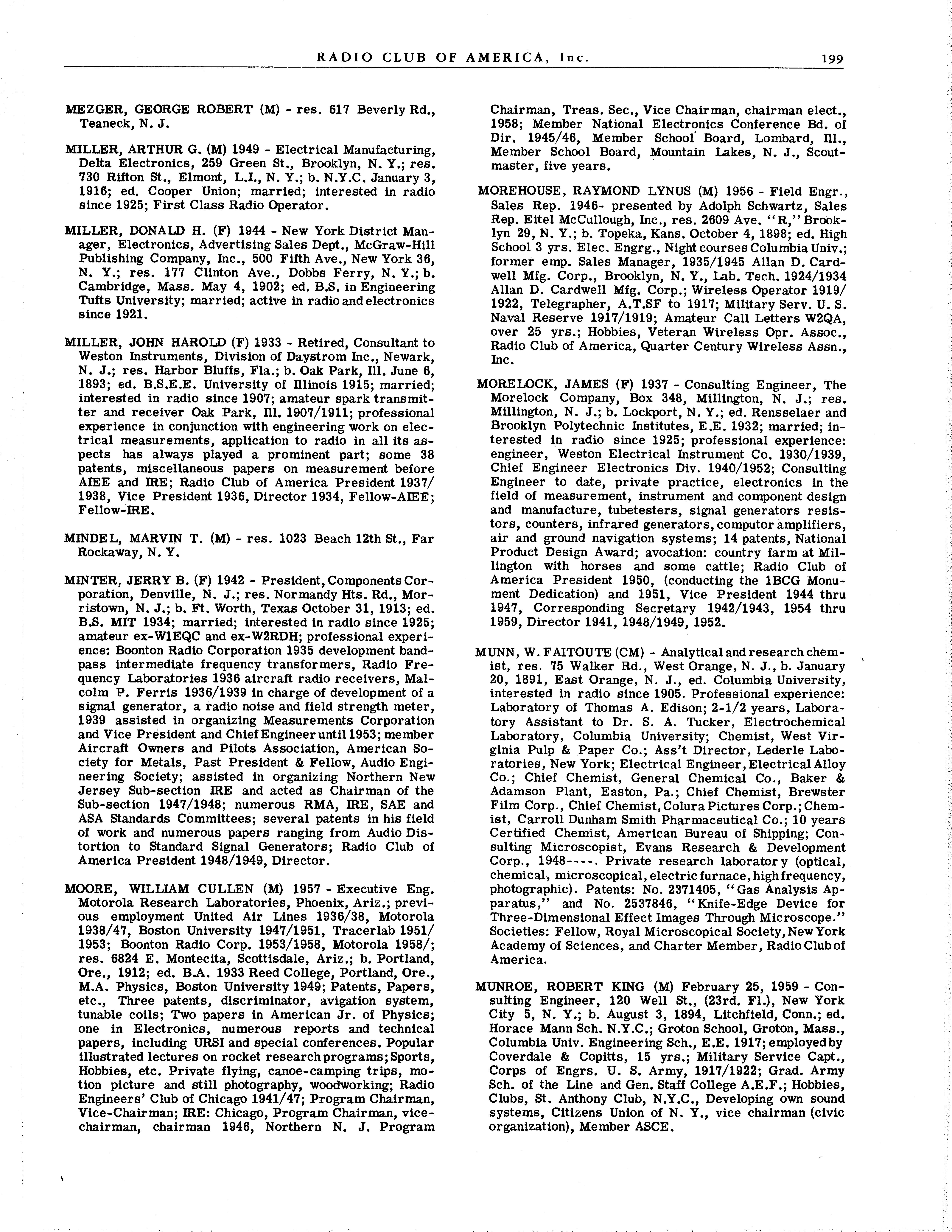
Chairman, Treas.Sec., Vice Chairman, chairman elect., 1958; Member National Electronics Conference Bd. of Dir. 1945/46, Member School ’ Board, Lombard, Ill., Member School Board, Mountain Lakes, N. J., Scoutmaster, five years.
MOREHOUSE, RAYMOND LYNUS (M) 1956 - Field Engr , Sales Rep. 1946- presented by Adolph Schwartz, Sales Rep. Eitel McCullough, Inc., res. 2609 Ave. “R,” Brooklyn 29, N. Y.; b. Topeka, Kans. October 4, 1898; ed. High School 3 yrs. Elec Engrg , Night coursesColumbiaUniv.; former emp. Sales Manager, 1935/1945 Allan D. Cardwell Mfg. Corp., Brooklyn, N. Y , Lab. Tech.1924/1934 Allan D. Cardwell Mfg. Corp.; Wireless Operator 1919/ 1922, Telegrapher, A.T.SF to 1917; Military Serv. U.S. Naval Reserve 1917/1919; Amateur Call Letters W2QA, over 25 yrs.; Hobbies, Veteran Wireless Opr. Assoc., Radio Club of America, Quarter Century Wireless Assn., MILLER, JOHN HAROLD (F) 1933 - Retired, Consultant to Weston Instruments, Division of Daystrom Inc., Newark, N. J.; res. Harbor Bluffs, Fla.; b. Oak Park, Ill. June 6, 1893; ed. B.S.E.E. University of Illinois 1915; married; interested in radio since 1907; amateur spark transmitter and receiver Oak Park, Ill. 1907/1911; professional experience in conjunction with engineering work on electrical measurements, application to radio in all its aspects has always played a prominent part; some 38 patents, miscellaneous papers on measurement before AIEE and IRE; Radio Club of America President 1937/ 1938, Vice President 1936, Director 1934, Fellow-AIEE; Fellow-IRE
MINDEL, MARVIN T. (M) - res 1023 Beach 12th St., Far Rockaway, N.Y.
MINTER, JERRY B. (F) 1942 - President,ComponentsCorporation, Denville, N. J.; res. Normandy Hts. Rd., Morristown, N. J.; b. Ft. Worth, Texas October 31, 1913; ed. B.S. MIT 1934; married; interested in radio since 1925; amateur ex-WlEQC and ex-W2RDH; professional experience: Boonton Radio Corporation 1935 development bandpass intermediate frequency transformers, Radio Frequency Laboratories 1936 aircraft radio receivers, Malcolm P. Ferris 1936/1939 in charge of development of a signal generator, a radio noise and field strength meter, 1939 assisted in organizing Measurements Corporation and Vice President and Chief Engineer until1953; member Aircraft Owners and Pilots Association, American Society for Metals, Past President & Fellow, Audio Engineering Society; assisted in organizing Northern New Jersey Sub-section IRE and acted as Chairman of the Sub-section 1947/1948; numerous RMA, IRE, SAE and ASA Standards Committees; several patents in his field of work and numerous papers ranging from Audio Distortion to Standard Signal Generators; Radio Club of America President 1948/1949, Director.
MOORE, WILLIAM CULLEN (M) 1957 - Executive Eng. Motorola Research Laboratories, Phoenix, Ariz.; previous employment United Air Lines 1936/38, Motorola 1938/47, Boston University 1947/1951, Tracerlab 1951/ 1953; Boonton Radio Corp. 1953/1958, Motorola 1958/; res. 6824 E. Montecita, Scottisdale, Ariz.; b. Portland, Ore., 1912; ed. B.A. 1933 Reed College, Portland, Ore., M.A. Physics, Boston University 1949; Patents, Papers, etc., Three patents, discriminator, avigation system, tunable coils; Two papers in American Jr. of Physics; one in Electronics, numerous reports and technical papers, including URSI and special conferences. Popular illustrated lectures on rocket researchprograms;Sports, Hobbies, etc. Private flying, canoe-camping trips, motion picture and still photography, woodworking; Radio Engineers’ Club of Chicago 1941/47; Program Chairman, Vice-Chairman; IRE: Chicago, Program Chairman, vicechairman, chairman 1946, Northern N. J. Program
Inc.
MORELOCK, JAMES (F) 1937 - Consulting Engineer, The Morelock Company, Box 348, Millington, N. J.; res. Millington, N. J.; b. Lockport, N. Y.; ed. Rensselaer and Brooklyn Polytechnic Institutes, E.E.1932; married; interested in radio since 1925; professional experience: engineer, Weston Electrical Instrument Co. 1930/1939, Chief Engineer Electronics Div. 1940/1952; Consulting Engineer to date, private practice, electronics in the field of measurement, instrument and component design and manufacture, tubetesters, signal generators resistors, counters, infrared generators,computor amplifiers, air and ground navigation systems; 14 patents, National Product Design Award; avocation: country farm at Millington with horses and some cattle; Radio Club of America President 1950, (conducting the 1BCG Monument Dedication) and 1951, Vice President 1944 thru 1947, Corresponding Secretary 1942/1943, 1954 thru 1959, Director 1941, 1948/1949, 1952.
MUNN, W.FAITOUTE (CM) - Analyticaland researchchemist, res 75 Walker Rd., West Orange, N J , b January 20, 1891, East Orange, N. J., ed. Columbia University, interested in radio since 1905. Professional experience: Laboratory of Thomas A Edison; 2-1/2 years, Laboratory Assistant to Dr. S. A. Tucker, Electrochemical Laboratory, Columbia University; Chemist, West Virginia Pulp & Paper Co.; Ass’t Director, Lederle Laboratories, New York; Electrical Engineer,ElectricalAlloy Co.; Chief Chemist, General Chemical Co., Baker & Adamson Plant, Easton, Pa.; Chief Chemist, Brewster Film Corp , Chief Chemist,ColuraPicturesCorp ;Chemist, Carroll Dunham Smith Pharmaceutical Co ; 10 years Certified Chemist, American Bureau of Shipping; Consulting Microscopist, Evans Research & Development Corp , 1948 . Private research laboratory (optical, chemical, microscopical,electricfurnace,highfrequency, photographic) Patents: No. 2371405, “Gas Analysis Apparatus,” and No 2537846, “Knife-Edge Device for Three-Dimensional Effect Images Through Microscope ” Societies: Fellow, Royal Microscopical Society,NewYork Academy of Sciences, and Charter Member, RadioClubof America.
MUNROE, ROBERT KING (M) February 25, 1959 - Consulting Engineer, 120 Well St., (23rd. FI.), New York City 5, N. Y.; b. August 3, 1894, Litchfield, Conn.; ed. Horace Mann Sch. N.Y.C.; Groton School, Groton, Mass., Columbia Univ. Engineering Sch., E.E.1917;employedby Coverdale & Copitts, 15 yrs.; Military Service Capt., Corps of Engrs. U. S. Army, 1917/1922; Grad. Army Sch. of the Line and Gen.Staff College A.E.F.; Hobbies, Clubs, St. Anthony Club, N.Y.C., Developing own sound systems, Citizens Union of N. Y., vice chairman (civic organization), Member ASCE.
RADIO CLUB OF AMERICA , Inc. 199

ODGERS, ARTHUR J. (F) 1950 - Vice President, Northern Radio Co.; res. 80 Heights Rd , Plandome, L.I., N. Y.; b. Calumet, Mich. August 6, 1912.
OFFENHAUSER, WILLIAM H. (F) 1936 - Engineer, selfemployed; res. New Canaan, Conn.; b. Brooklyn, N. Y. May 8, 1904; ed. B.A. Columbia (with Engineering Option); married; interested in radio since 1915; always on fringe of amateur station, still have hopes of running ham set; made first recordings of mosquito sounds, confirming Hiram Maxim’s findings after 75 yrs.; about 20 odd patents (such as noiseless recording for sound films, direction finder with response to the tangent of the field angle, a system for recording and utilizing low energy sound of insects to effect control of them); one book on 16 mm Sound Motion Pictures, A Manual (Interscience 1949, reprinted 1953, 1958) another book on Microrecording (microfilming) with C. Lewis (Interscience1956); also numerous technical papers Fellow - Sc. Motion Picture Television Engrs., Ands Eng. Society. MemberAcoustical Society of America, Inst. Radio Engrs. Am. Ordnance Assn.; Awards - OSRD Certificate (VT Fuze Project); ASA War Standards Certificate (252 Project); Naval Ordnance Development Award Certificate (NDRC Tropic Deterioration Project).
OLSON, A. ELLIOTT (M) - res. 31 Jervis Rd., Yonkers 5, N. Y.
OSBAHR, BERNARD F (M) 1951 (F) 1956 - Editor, Electronic Industries, (Chilton Company) Chestnut &56thSts., Philadelphia 39, Pa.; res. 923 Longview Rd., King of Prussia, Pa.; b. Brooklyn, N. Y. December 17,1918; ed. University of Pennsylvania, RCA Institutes Inc.;married; interested in radio since 1933; professional experience 1939/1942 Engineer RCA Mfg. Co. Camden, N. J.; 1942 Chief Engineer New York School of Radio; 1943/46 U.S. Army 1946/1947 Chief Electrical & Mechanical Procurement USFET Corps, of Engineers (Germany); 1947/1948 Director Services Division U.S. Army Exchange Service (Germany) 1948 to present Editor Electronic Industries, Senior member IRE, Member AES, AFCA; Hobbiesfishing, boating.
OSBORN, PERRY H. (F) 1944 - Senior Engineer, Radio Engineering Laboratories, Inc., 29-01 Borden Ave., Long Island City 1, N. Y.; res. 546 Sunsey Ave., Haworth, N. J.; b. Buskirk, N. Y. August 31, 1904; ed. E.E. Rensselaer, Polytechnic Institute, M.Sc. University of Pittsburgh; married; interested in radio since 1920; amateur W2FAA; Radio Engineer with Westinghouse,SignalCorps, RCA and E. H. Armstrong, Director Radio Club 57 Member IRE.
OSTERLAND, EDMUND (F) 1950 - Electronic Instrument Design and Manufacture, EO Electronics, Inc., Mountain Lakes, N. J.; b. Brooklyn, N. Y.1909; ed. B.S.E.E. New York University; married; professional experience Chief Engineer Ballantine Labs., Inc. until January 1952, own business since that time.
OTIS, G. EDWIN (M) 1953 - Site Manager, General Electric Co. in Product Service, Bolori, Miss.; b. Plattsburg, N. Y. 1915; ed. graduated Union College 1938; interested in radio since 1930; professional experience - General Electric Co. 1941/1943, U. S. Army Signal Corps 1943/ 1946, instructor in radio and television at Veterans Vocational School, Troy, N. Y.; presently President of Otisonde, Inc., majoring in Hi-Fi Custom Sound Installations and Industrial Television; Technical article in “Radio” 1943 on volume expander, U. S. Army, developed special test equipment for carrier telephone and a noise suppressor for background line noise.
PACKARD, LUCIUS E. (F) 1940 - Engineer, President, Sales Manager, Technology Instrument Corporation, Acton, Mass ; res. Framingham Centre, Mass ; b. Sommerville, Mass. January 21, 1914; ed. Graduate MIT 1935; married; interested in radio since 1928; amateur WIDFL; patent, variable resistor, Patent Electric method and system for measuring Impedance and Phase Angle (conjunction with Hermon H Scott).
PAGE, ESTERLY CHASE (F) 1945 - Consulting Engineer, Partner, Page, Creutz, Steel and Waldschmitt, President Page Communication Engineers, 710 14th St.N.W.,Washington 5, D. C.; Vice Chairman Board of Director Edison-Page S.P.A. Rome, Italy; b. Chicago, Ill. July 16, 1902; Senior Member IRE, member Engineers Club, New York, ex-Lieut. Colonel AUS Signal Corps; AwardsLegion of Merit Order of British Empire.
PAINE ROBERT C. (F) 1935 - Test Engineer, Measurements Corporation, Boonton, N. J.; res. 436 Cornelia St., Boonton, N. J.; b. South Randolph, Vt., August 10, 1895; ed. Electrical Engineering at Worchester Polytechnic Institute and Marine Engineering at Webb Institute of Naval Architecture 1914/1917; married, four grandchildren; interested in radio since 1928; left college for Army 302nd Field Artillery1917/1919,attendedRoyal Technical College, Glasgow, Scotland,TechnicalStaff Bell Telephone Laboratories 1923/1932, Ferris Instrument Corporation 1934/1948; Senior member IRE, Morris County Engineers Club, Masonic Lodge, Author of many articles in radio magazines
PALMER, CHARLES WALTER (F) 1935 - Engineer, Western Electric Co., Inc., Lexington Rd., Winston-Salem, N. C.; res. 2429 Fairway Dr., Winston-Salem, N. C.; b. Kingsbridge, N. Y. August 26, 1907; ed. E.E.Cooper Union and Cornell University, also studied at Columbia University, N. Y. University and Stanford University; married; interested in radio since 1919; amateur formerly W2BV, W2BOY until 1940, Present W4ASV; professional experience: Technical Assistant Bell Telephone Laboratories 1928, Engineer Dresser Mfg Co.1929, Engineer Western Electric Co. 1929, Technical Editor Radio News Magazine 1931, Technical Editor and Managing Editor Radio-Craft Magazine 1933, Engineer, Section Chief and Department Chief Western Electric Co., Inc. Radio Division 1936 to date, presently Chief of Training Department; numerous articles in technical publications AIEE, Radio Magazine, Radio News, Radio-Craft; associated with radar and sonar engineering since 1940; Senior Member IRE, Member of Executive Board Boy Scouts of America, Old Heckory Council.
PANTER, PHILIP F. (F) 1946 - Fellow 1958 Executive Engineer ITT Laboratories (formerly Federal Telecommunication Laboratories) Nutley, N. J.; res. 6 Hooper Ave., West Orange, N. J.; b. Poland 1908; ed. McGill University 1929/1936, B.S. 1933, B. Eng.1935 and Ph.D. 1936; married; professional experience: teaching one year in Palestine, teaching mathematics and physics Sir George Williams College, Montreal and staff of Physics Department McGill University until 1945, 1941 Canadian Marconi Co. Montreal, 1945 Federal Telegraph and Radio Corporation, Senior Engineer in Charge of Development of FM Broadcast Equipments, 1946 Federal Telecommunication Laboratories, 1950 International Standard Electric Corporation technical adviser on telephone installations in Israel; Federal Telecommunications Laboratories since June 1952; Senior Member IRE and Member American Technion Society; author of various papers on FM and PCM.
PAPAMARCOS, GEORGE (F) 1940 - Sales Engineer, Radio Engineering Lab’s, Inc., 29-01 Borden Ave., Long Island
GOLDEN JUBILEE YEAR BOOK 200
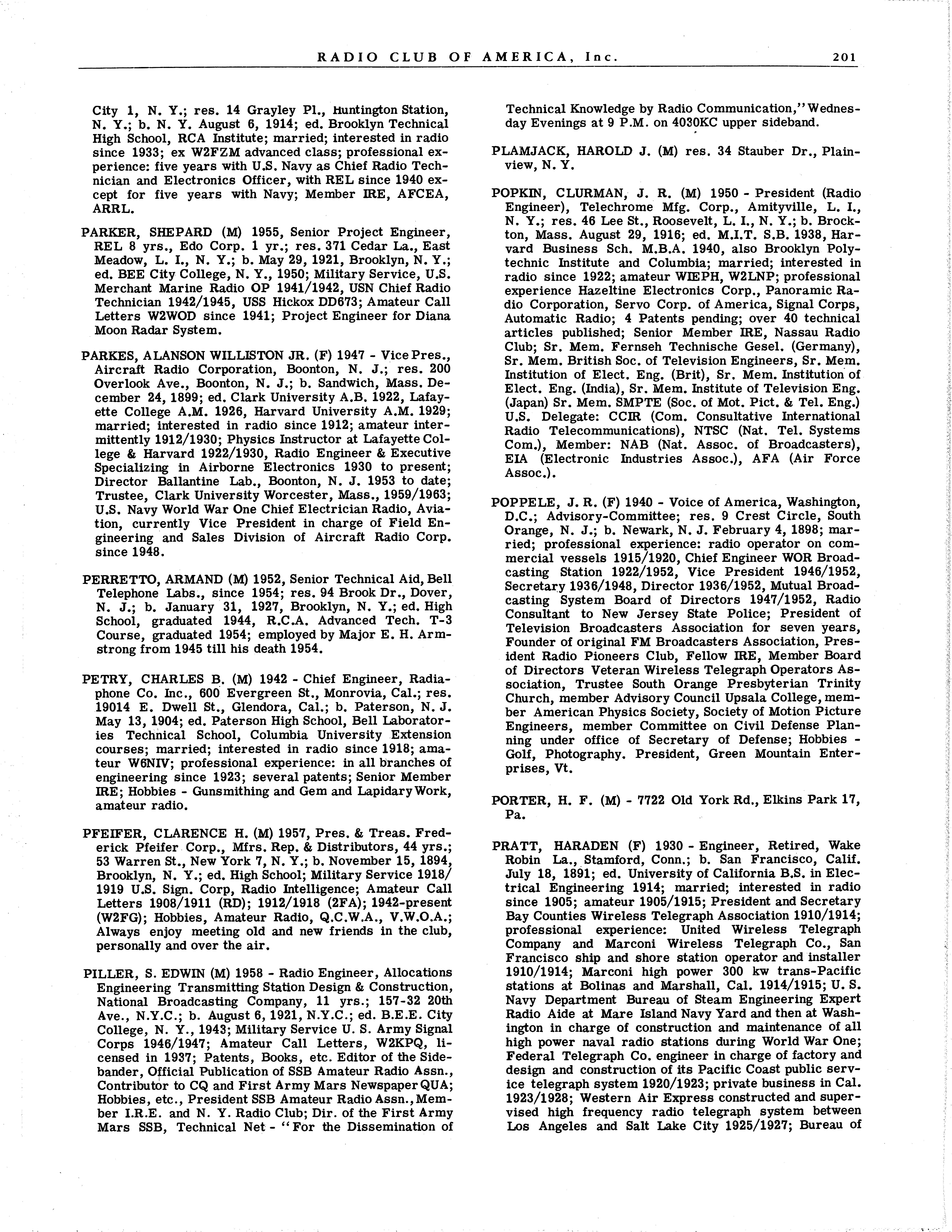
City 1, N. Y.; res. 14 Grayley PI., Huntington Station, N. Y ; b. N. Y. August 6, 1914; ed. Brooklyn Technical High School, RCA Institute; married; interested in radio since 1933; ex W2FZM advanced class; professional experience:five years with U.S. Navy as Chief Radio Technician and Electronics Officer, with REL since 1940 except for five years with Navy; Member IRE, AFCEA, ARRL.
PARKER, SHEPARD (M) 1955, Senior Project Engineer, REL 8 yrs., Edo Corp. 1 yr.; res. 371 Cedar La., East Meadow, L. I., N. Y.; b. May 29, 1921, Brooklyn, N.Y.; ed. BEE City College, N. Y., 1950; Military Service, U.S. Merchant Marine Radio OP 1941/1942, USN Chief Radio Technician 1942/1945, USS Hickox DD673; Amateur Call Letters W2WOD since 1941; Project Engineer for Diana Moon Radar System.
PARKES, ALANSON WILLISTON JR. (F) 1947 - VicePres., Aircraft Radio Corporation, Boonton, N. J.; res. 200 Overlook Ave., Boonton, N. J.; b. Sandwich, Mass. December 24, 1899; ed.Clark University A.B. 1922, Lafayette College A.M. 1926, Harvard University A.M. 1929; married; interested in radio since 1912; amateur intermittently 1912/1930; Physics Instructor at Lafayette College & Harvard 1922/1930, Radio Engineer & Executive Specializing in Airborne Electronics 1930 to present; Director Ballantine Lab., Boonton, N. J. 1953 to date; Trustee, Clark University Worcester, Mass., 1959/1963; U.S. Navy World War One Chief Electrician Radio, Aviation, currently Vice President in charge of Field Engineering and Sales Division of Aircraft Radio Corp. since 1948.
PERRETTO, ARMAND (M) 1952, Senior Technical Aid, Bell Telephone Labs., since 1954; res. 94 Brook Dr., Dover, N. J.; b. January 31, 1927, Brooklyn, N. Y.; ed. High School, graduated 1944, R.C.A. Advanced Tech. T-3 Course, graduated 1954; employed by Major E. H. Armstrong from 1945 till his death 1954.
PETRY, CHARLES B. (M) 1942 - Chief Engineer, Radiaphone Co. Inc., 600 Evergreen St., Monrovia, Cal.; res. 19014 E. Dwell St., Glendora, Cal.; b. Paterson, N. J. May 13, 1904; ed. Paterson High School, Bell Laboratories Technical School, Columbia University Extension courses; married; interested in radio since 1918; amateur W6NIV; professional experience: in all branches of engineering since 1923; several patents; Senior Member IRE; Hobbies - Gunsmithing and Gem and LapidaryWork, amateur radio.
PFEIFER, CLARENCE H. (M) 1957, Pres. & Treas. Frederick Pfeifer Corp., Mfrs. Rep. & Distributors, 44 yrs.; 53 Warren St., New York 7, N. Y.; b. November 15, 1894, Brooklyn, N. Y.; ed. High School; Military Service 1918/ 1919 U.S. Sign. Corp, Radio Intelligence; Amateur Call Letters 1908/1911 (RD); 1912/1918 (2FA); 1942-present (W2FG); Hobbies, Amateur Radio, Q.C.W.A., V.W.O A.; Always enjoy meeting old and new friends in the club, personally and over the air.
PILLER, S. EDWIN (M) 1958 - Radio Engineer, Allocations Engineering Transmitting Station Design & Construction, National Broadcasting Company, 11 yrs ; 157-32 20th Ave , N Y C ; b August 6, 1921, N.Y.C.; ed. B.E E City College, N. Y., 1943; Military Service U S. Army Signal Corps 1946/1947; Amateur Call Letters, W2KPQ, licensed in 1937; Patents, Books, etc. Editor of the Sidebander, Official Publication of SSB Amateur Radio Assn., Contributor to CQ and First Army Mars NewspaperQUA; Hobbies, etc., President SSB Amateur Radio Assn.,Member I R E and N Y Radio Club; Dir of the First Army Mars SSB, Technical Net“ For the Dissemination of
Technical Knowledge by Radio Communication,”Wednesday Evenings at 9 P M on 4030KC upper sideband.
PLAMJACK, HAROLD J. (M) res. 34 Stauber Dr., Plainview, N. Y.
POPKIN, CLURMAN, J. R. (M) 1950 - President (Radio Engineer), Telechrome Mfg. Corp., Amityville, L. I., N. Y.; res. 46 Lee St., Roosevelt, L. I., N. Y.; b. Brockton, Mass. August 29, 1916; ed. M.I.T. S.B.1938, Harvard Business Sch. M.B.A. 1940, also Brooklyn Polytechnic Institute and Columbia; married; interested in radio since 1922; amateur WIEPH, W2LNP; professional experience Hazeltine Electronics Corp., Panoramic Radio Corporation, Servo Corp of America, Signal Corps, Automatic Radio; 4 Patents pending; over 40 technical articles published; Senior Member IRE, Nassau Radio Club; Sr. Mem. Fernseh Technische Gesel. (Germany), Sr. Mem. British Soc. of Television Engineers, Sr. Mem. Institution of Elect. Eng. (Brit), Sr. Mem. Institution of Elect. Eng. (India), Sr. Mem. Institute of Television Eng. (Japan) Sr. Mem. SMPTE (Soc. of Mot. Piet. & Tel. Eng.) U.S. Delegate: CCIR (Com. Consultative International Radio Telecommunications), NTSC (Nat. Tel. Systems Com.), Member: NAB (Nat. Assoc, of Broadcasters), EIA (Electronic Industries Assoc.), AFA (Air Force Assoc.).
POPPELE, J. R. (F) 1940 - Voice of America, Washington, D.C.; Advisory-Committee; res. 9 Crest Circle, South Orange, N. J ; b. Newark, N. J. February 4, 1898; married; professional experience: radio operator on commercial vessels 1915/1920, Chief Engineer WOR Broadcasting Station 1922/1952, Vice President 1946/1952, Secretary 1936/1948, Director 1936/1952, Mutual Broadcasting System Board of Directors 1947/1952, Radio Consultant to New Jersey State Police; President of Television Broadcasters Association for seven years, Founder of original FM Broadcasters Association, President Radio Pioneers Club, Fellow IRE, Member Board of Directors Veteran Wireless Telegraph Operators Association, Trustee South Orange Presbyterian Trinity Church, member Advisory Council Upsala College,member American Physics Society, Society of Motion Picture Engineers, member Committee on Civil Defense Planning under office of Secretary of Defense; HobbiesGolf, Photography. President, Green Mountain Enterprises, Vt.
PORTER, H. F. (M) - 7722 Old York Rd., Elkins Park 17, Pa.
PRATT, HARADEN (F) 1930 - Engineer, Retired, Wake Robin La., Stamford, Conn.; b. San Francisco, Calif. July 18, 1891; ed. University of California B.S. in Electrical Engineering 1914; married; interested in radio since 1905; amateur 1905/1915; President and Secretary Bay Counties Wireless Telegraph Association 1910/1914; professional experience: United Wireless Telegraph Company and Marconi Wireless Telegraph Co., San Francisco ship and shore station operator and installer 1910/1914; Marconi high power 300 kw trans-Pacific stations at Bolinas and Marshall, Cal. 1914/1915; U.S. Navy Department Bureau of Steam Engineering Expert Radio Aide at Mare Island Navy Yard and then at Washington in charge of construction and maintenance of all high power naval radio stations during World War One; Federal Telegraph Co. engineer in charge of factory and design and construction of its Pacific Coast public service telegraph system 1920/1923; private business in Cal. 1923/1928; Western Air Express constructed and supervised high frequency radio telegraph system between Los Angeles and Salt Lake City 1925/1927; Bureau of
RADIO CLUB OF AMERICA , 201 n c.
I : I ! 1 3 3 :
: i I
I ' 1
3
1
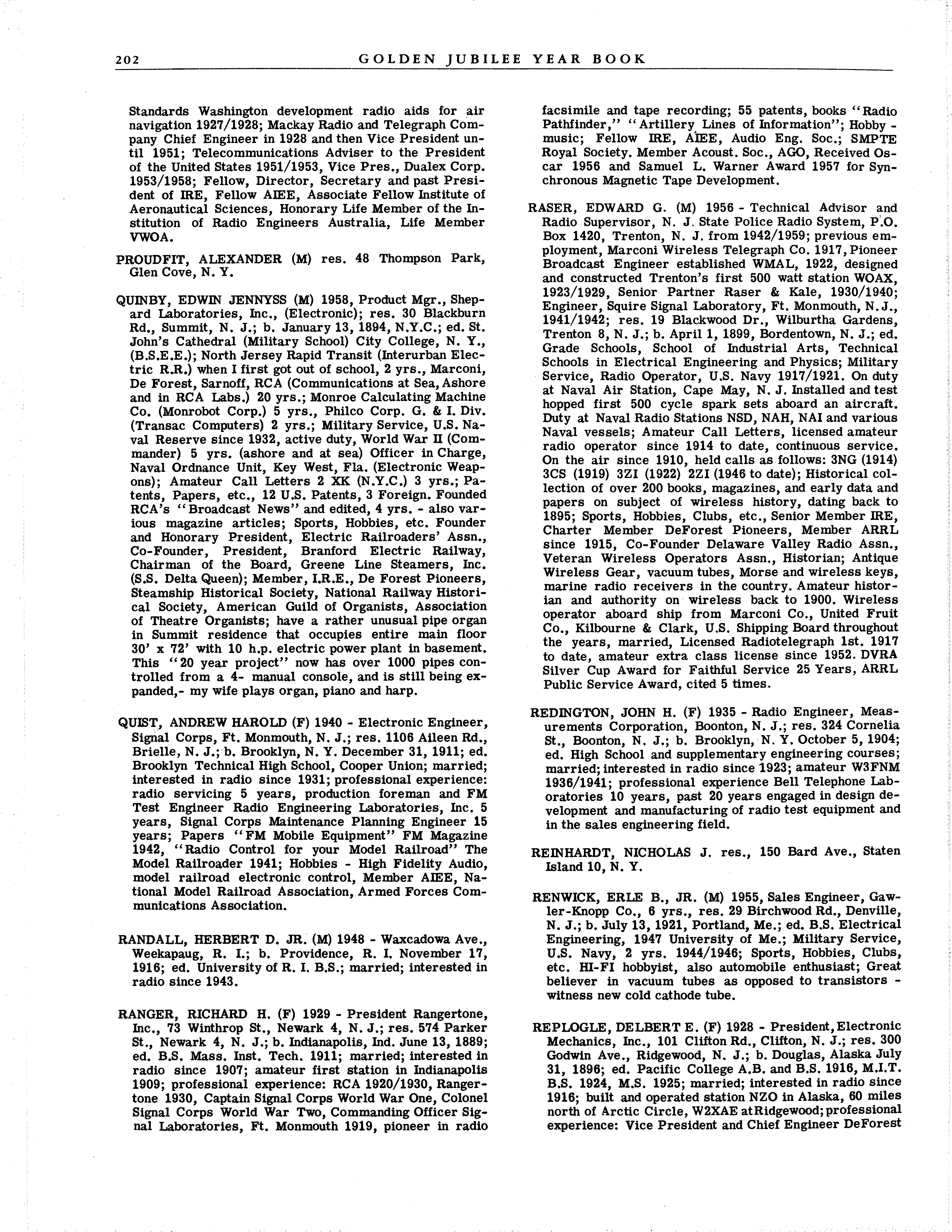
Standards Washington development radio aids for air navigation 1927/1928; Mackay Radio and Telegraph Company Chief Engineer in 1928 and then Vice President until 1951; Telecommunications Adviser to the President of the United States 1951/1953, Vice Pres., Dualex Corp. 1953/1958; Fellow, Director, Secretary and past President of IRE, Fellow AIEE, Associate Fellow Institute of Aeronautical Sciences, Honorary Life Member of the Institution of Radio Engineers Australia, Life Member VWOA.
PROUDFIT, ALEXANDER (M) res. 48 Thompson Park, Glen Cove, N. Y.
QUINBY, EDWIN JENNYSS (M) 1958, Product Mgr., Shepard Laboratories, Inc., (Electronic); res. 30 Blackburn Rd., Summit, N. J.; b. January 13, 1894, N.Y.C.; ed.St. John’s Cathedral (Military School) City College, N. Y., (B.S.E.E.); North Jersey Rapid Transit (Interurban Electric RJR.) when I first got out of school, 2 yrs., Marconi, De Forest, Sarnoff, RCA (Communications at Sea,Ashore and in RCA Labs.) 20 yrs.; Monroe Calculating Machine Co. (Monrobot Corp.) 5 yrs., Philco Corp. G. & I. Div. (Transac Computers) 2 yrs.; Military Service, U.S.Naval Reserve since 1932, active duty, World War H (Commander) 5 yrs. (ashore and at sea) Officer in Charge, Naval Ordnance Unit, Key West, Fla. (Electronic Weapons); Amateur Call Letters 2 XK (N.Y.C.) 3 yrs.; Patents, Papers, etc., 12 U.S. Patents, 3 Foreign.Founded RCA’s “Broadcast News” and edited, 4 yrs. - also various magazine articles; Sports, Hobbies, etc. Founder and Honorary President, Electric Railroaders’ Assn., Co-Founder, President, Branford Electric Railway, Chairman of the Board, Greene Line Steamers, Inc. (S.S. Delta Queen); Member, IJt.E., De Forest Pioneers, Steamship Historical Society, National Railway Historical Society, American Guild of Organists, Association of Theatre Organists; have a rather unusual pipe organ in Summit residence that occupies entire main floor 30’ x 72’ with 10 h.p. electric power plant in basement. This “ 20 year project” now has over 1000 pipes controlled from a 4- manual console, and is still being expanded,- my wife plays organ, piano and harp.
QUIST, ANDREW HAROLD (F) 1940 - Electronic Engineer, Signal Corps, Ft. Monmouth, N. J.; res.1106 Aileen Rd., Brielle, N.J.; b. Brooklyn, N. Y. December 31, 1911; ed. Brooklyn Technical High School, Cooper Union; married; interested in radio since 1931; professional experience: radio servicing 5 years, production foreman and FM Test Engineer Radio Engineering Laboratories, Inc. 5 years, Signal Corps Maintenance Planning Engineer 15 years; Papers “FM Mobile Equipment” FM Magazine 1942, “Radio Control for your Model Railroad” The Model Railroader 1941; Hobbies - High Fidelity Audio, model railroad electronic control, Member AIEE, National Model Railroad Association, Armed Forces Communications Association.
RANDALL, HERBERT D. JR. (M) 1948 - Waxcadowa Ave., Weekapaug, R. I.; b. Providence, R I. November 17, 1916; ed. University of R. I. B.S.; married; interested in radio since 1943.
RANGER, RICHARD H. (F) 1929 - President Rangertone, Inc., 73 Winthrop St., Newark 4, N.J.; res. 574 Parker St., Newark 4, N. J.; b.Indianapolis, Ind. June 13, 1889; ed. B.S. Mass. Inst. Tech. 1911; married; interested in radio since 1907; amateur first station in Indianapolis 1909; professional experience: RCA 1920/1930, Rangertone 1930, Captain Signal Corps World War One, Colonel Signal Corps World War Two, Commanding Officer Signal Laboratories, Ft. Monmouth 1919, pioneer in radio
facsimile and tape recording; 55 patents, books “Radio Pathfinder,” “Artillery Lines of Information”; Hobbymusic; Fellow IRE, AIEE, Audio Eng. Soc.; SMPTE Royal Society. Member Acoust.Soc., AGO, Received Oscar 1956 and Samuel L. Warner Award 1957 for Synchronous Magnetic Tape Development.
RASER, EDWARD G (M) 1956 - Technical Advisor and Radio Supervisor, N J State Police Radio System, P O. Box 1420, Trenton, N. J. from 1942/1959; previous employment, Marconi Wireless Telegraph Co.1917,Pioneer Broadcast Engineer established WMAL, 1922, designed and constructed Trenton’s first 500 watt station WOAX, 1923/1929, Senior Partner Raser & Kale, 1930/1940; Engineer, Squire Signal Laboratory, Ft. Monmouth, N.J., 1941/1942; res. 19 Blackwood Dr., Wilburtha Gardens, Trenton 8, N. J.; b. April1, 1899, Bordentown, N. J.; ed. Grade Schools, School of Industrial Arts, Technical Schools in Electrical Engineering and Physics; Military Service, Radio Operator, U.S. Navy 1917/1921. On duty at Naval Air Station, Cape May, N. J. Installed and test hopped first 500 cycle spark sets aboard an aircraft. Duty at Naval Radio Stations NSD, NAH, NAI and various Naval vessels; Amateur Call Letters, licensed amateur radio operator since 1914 to date, continuous service. On the air since 1910, held calls as follows: 3NG (1914) 3CS (1919) 3ZI (1922) 2ZI (1946 to date); Historical collection of over 200 books, magazines, and early data and papers on subject of wireless history, dating back to 1895; Sports, Hobbies, Clubs, etc., Senior Member IRE, Charter Member DeForest Pioneers, Member ARRL since 1915, Co-Founder Delaware Valley Radio Assn., Veteran Wireless Operators Assn., Historian; Antique Wireless Gear, vacuum tubes, Morse and wireless keys, marine radio receivers in the country. Amateur historian and authority on wireless back to 1900. Wireless operator aboard ship from Marconi Co., United Fruit Co., Kilbourne & Clark, U.S. Shipping Board throughout the years, married, Licensed Radiotelegraph 1st. 1917 to date, amateur extra class license since 1952 DVRA Silver Cup Award for Faithful Service 25 Years, ARRL Public Service Award, cited 5 times.
REDINGTON, JOHN H. (F) 1935 - Radio Engineer, Measurements Corporation, Boonton, N. J.; res. 324 Cornelia St., Boonton, N. J.; b. Brooklyn, N. Y. October 5, 1904; ed. High School and supplementary engineering courses; married;interested in radio since1923; amateur W3FNM 1936/1941; professional experience Bell Telephone Laboratories 10 years, past 20 years engaged in design development and manufacturing of radio test equipment and in the sales engineering field.
REINHARDT, NICHOLAS J. res., 150 Bard Ave., Staten Island 10, N. Y.
RENWICK, ERLE B., JR. (M) 1955,Sales Engineer, Gawler-Knopp Co., 6 yrs., res. 29 Birchwood Rd., Denville, N. J.; b.July 13, 1921, Portland, Me.; ed. B.S. Electrical Engineering, 1947 University of Me.; Military Service, U.S. Navy, 2 yrs. 1944/1946; Sports, Hobbies, Clubs, etc. HI-FI hobbyist, also automobile enthusiast; Great believer in vacuum tubes as opposed to transistorswitness new cold cathode tube.
REPLOGLE, DELBERT E. (F) 1928 - President,Electronic Mechanics, Inc., 101 Clifton Rd., Clifton, N. J.; res. 300 Godwin Ave., Ridgewood, N. J.; b. Douglas, Alaska July 31, 1896; ed. Pacific College A.B.and B.S.1916, M.I.T. B.S. 1924, M.S. 1925; married; interested in radio since 1916; built and operated station NZO in Alaska, 60 miles north of Arctic Circle, W2XAE atRidgewood;professional experience: Vice President and Chief Engineer DeForest
GOLDEN JUBILEE YEAR BOOK 202
5 ;
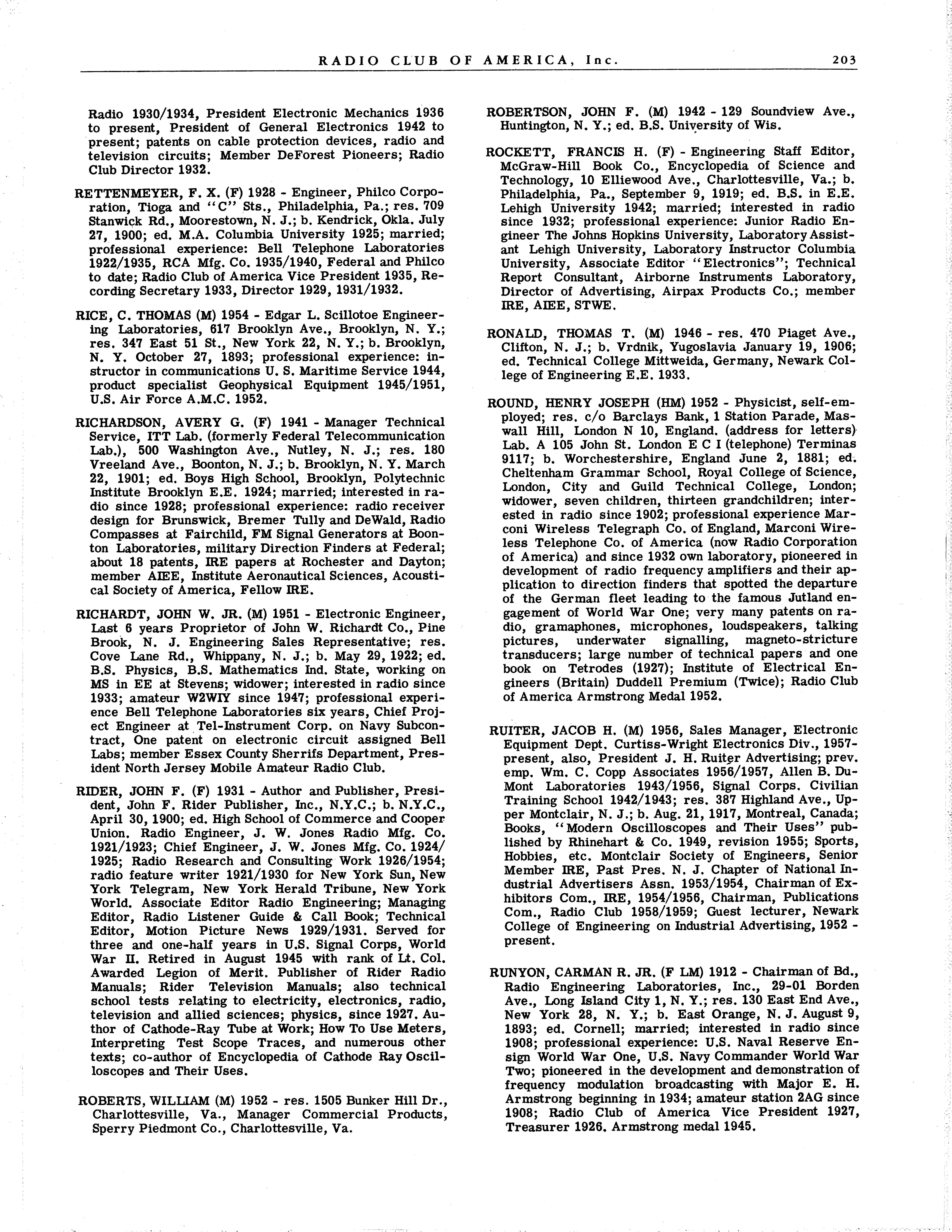
Radio 1930/1934, President Electronic Mechanics 1936 to present, President of General Electronics 1942 to present; patents on cable protection devices, radio and television circuits; Member DeForest Pioneers; Radio Club Director 1932.
RETTENMEYER, F. X. (F) 1928 - Engineer, Philco Corporation, Tioga and “C” Sts., Philadelphia, Pa ; res. 709 Stanwick Rd., Moorestown, N. J.; b. Kendrick, Okla. July 27, 1900; ed. M.A. Columbia University 1925; married; professional experience: Bell Telephone Laboratories 1922/1935, RCA Mfg. Co 1935/1940, Federal and Philco to date; Radio Club of America Vice President 1935, Recording Secretary 1933, Director 1929, 1931/1932.
RICE, C. THOMAS (M) 1954 - Edgar L.Scillotoe Engineering Laboratories, 617 Brooklyn Ave., Brooklyn, N. Y.; res. 347 East 51 St., New York 22, N. Y.; b. Brooklyn, N. Y. October 27, 1893; professional experience: instructor in communications U.S. Maritime Service 1944, product specialist Geophysical Equipment 1945/1951, U.S. Air Force A M.C. 1952.
RICHARDSON, AVERY G. (F) 1941 - Manager Technical Service, ITT Lab. (formerly Federal Telecommunication Lab.), 500 Washington Ave., Nutley, N. J.; res. 180 Vreeland Ave , Boonton, N. J.; b. Brooklyn, N. Y. March 22, 1901; ed. Boys High School, Brooklyn, Polytechnic Institute Brooklyn E.E. 1924; married; interested in radio since 1928; professional experience: radio receiver design for Brunswick, Bremer Tully and DeWald, Radio Compasses at Fairchild, FM Signal Generators at Boonton Laboratories, military Direction Finders at Federal; about 18 patents, IRE papers at Rochester and Dayton; member AIEE, Institute Aeronautical Sciences, Acoustical Society of America, Fellow IRE.
RICHARDT, JOHN W. JR. (M) 1951 - Electronic Engineer, Last 6 years Proprietor of John W. Richardt Co., Pine Brook, N. J. Engineering Sales Representative; res. Cove Lane Rd., Whippany, N. J.; b. May 29, 1922; ed. B S. Physics, B.S. Mathematics Ind. State, working on MS in EE at Stevens; widower; interested in radio since 1933; amateur W2WIY since 1947; professional experience Bell Telephone Laboratories six years, Chief Project Engineer at Tel-Instrument Corp. on Navy Subcontract, One patent on electronic circuit assigned Bell Labs; member Essex County Sherrifs Department, President North Jersey Mobile Amateur Radio Club.
RIDER, JOHN F. (F) 1931 - Author and Publisher, President, John F. Rider Publisher, Inc., N.Y.C ; b N.Y.C., April 30, 1900; ed. High School of Commerce and Cooper Union. Radio Engineer, J. W. Jones Radio Mfg. Co. 1921/1923; Chief Engineer, J. W. Jones Mfg. Co.1924/ 1925; Radio Research and Consulting Work 1926/1954; radio feature writer 1921/1930 for New York Sun, New York Telegram, New York Herald Tribune, New York World. Associate Editor Radio Engineering; Managing Editor, Radio Listener Guide & Call Book; Technical Editor, Motion Picture News 1929/1931. Served for three and one-half years in U.S. Signal Corps, World War n. Retired in August 1945 with rank of Lt. Col. Awarded Legion of Merit. Publisher of Rider Radio Manuals; Rider Television Manuals; also technical school tests relating to electricity, electronics, radio, television and allied sciences; physics, since 1927. Author of Cathode-Ray Tube at Work; How To Use Meters, Interpreting Test Scope Traces, and numerous other texts; co-author of Encyclopedia of Cathode Ray Oscilloscopes and Their Uses.
ROBERTSON, JOHN F. (M) 1942 - 129 Soundview Ave., Huntington, N. Y.; ed. B.S. University of Wis.
ROCKETT, FRANCIS H (F) - Engineering Staff Editor, McGraw-Hill Book Co., Encyclopedia of Science and Technology, 10 Elliewood Ave., Charlottesville, Va.; b. Philadelphia, Pa., September 9, 1919; ed B.S. in E.E. Lehigh University 1942; married; interested in radio since 1932; professional experience: Junior Radio Engineer The Johns Hopkins University, LaboratoryAssistant Lehigh University, Laboratory Instructor Columbia University, Associate Editor “Electronics”; Technical Report Consultant, Airborne Instruments Laboratory, Director of Advertising, Airpax Products Co.; member IRE, AIEE, STWE.
RONALD, THOMAS T. (M) 1946 - res. 470 Piaget Ave., Clifton, N. J.; b. Vrdnik, Yugoslavia January 19, 1906; ed. Technical College Mittweida, Germany, Newark College of Engineering E.E. 1933.
ROUND, HENRY JOSEPH (HM) 1952 - Physicist, self-employed; res. c/o Barclays Bank,1Station Parade, Maswall Hill, London N 10, England, (address for letters) Lab. A 105 John St. London E C I (telephone) Terminas 9117; b. Worchestershire, England June 2, 1881; ed. Cheltenham Grammar School, Royal College of Science, London, City and Guild Technical College, London; widower, seven children, thirteen grandchildren; interested in radio since 1902; professional experience Marconi Wireless Telegraph Co. of England, Marconi Wireless Telephone Co. of America (now Radio Corporation of America) and since 1932 own laboratory, pioneered in development of radio frequency amplifiers and their application to direction finders that spotted the departure of the German fleet leading to the famous Jutland engagement of World War One; very many patents on radio, gramaphones, microphones, loudspeakers, talking pictures, underwater signalling, magneto-stricture transducers; large number of technical papers and one book on Tetrodes (1927); Institute of Electrical Engineers (Britain) Duddell Premium (Twice); Radio Club of America Armstrong Medal 1952.
RUITER, JACOB H. (M) 1956, Sales Manager, Electronic Equipment Dept. Curtiss-Wright Electronics Div., 1957present, also, President J. H. Ruitpr Advertising; prev. emp. Wm. C. Copp Associates 1956/1957, Allen B. DuMont Laboratories 1943/1956, Signal Corps. Civilian Training School 1942/1943; res. 387 Highland Ave., Upper Montclair, N J.; b. Aug. 21, 1917, Montreal, Canada; Books, “ Modern Oscilloscopes and Their Uses” published by Rhinehart & Co. 1949, revision 1955; Sports, Hobbies, etc. Montclair Society of Engineers, Senior Member IRE, Past Pres. N. J. Chapter of National Industrial Advertisers Assn. 1953/1954, Chairman of Exhibitors Com., IRE, 1954/1956, Chairman, Publications Com., Radio Club 1958/1959; Guest lecturer, Newark College of Engineering on Industrial Advertising, 1952present.
RUNYON, CARMAN R. JR. (F LM) 1912 - Chairman of Bd., Radio Engineering Laboratories, Inc., 29-01 Borden Ave., Long Island City 1, N. Y ; res. 130 East End Ave., New York 28, N. Y.; b. East Orange, N. J. August 9, 1893; ed. Cornell; married; interested in radio since 1908; professional experience: U.S. Naval Reserve Ensign World War One, U.S. Navy Commander World War Two; pioneered in the development and demonstration of frequency modulation broadcasting with Major E. H. Armstrong beginning in 1934; amateur station 2AG since 1908; Radio Club of America Vice President 1927, Treasurer 1926. Armstrong medal 1945.
RADIO CLUB OF AMERICA , Inc 203
u
ROBERTS, WILLIAM (M) 1952 - res 1505 Bunker Hill Dr., Charlottesville, Va., Manager Commercial Products, Sperry Piedmont Co., Charlottesville, Va.
RUNYON, C. R. Ill (F) 1948 - Purchasing Agent, Radio Engineering Laboratories, Inc , 36-40 37th St., Long Island City 1, N. Y.; res 27 Robin La., Levittown, Long Island, N. Y.; professional experience: Sales Manager, Sales Engineering and Purchasing.
RUNYON, JOHN B. (M) res., New Providence, N. J.
RUSSELL, WILLIAM GORDON (F) 1926 - Staff Technician, General Precision Lab., Inc., Pleasantville, N. Y.; res. 62 Farragut Ave., Hastings-on-Hudson, N Y.; b Yonkers, N. Y. October 14, 1906; ed. Columbia University, United States Navy, Mechanics Institute, RCA Institutes; married; interested in radio since 1923; professional experience: E. H. Armstrong Laboratory, Columbia University, Norden Lab. Corp., White Plains, N. Y.; Radio Club of America Recording Secretary 1954.
RUSSELL, WILLIAM T. (F) 1915 - Retired Superintendent Electrical Tests, New York Central Railroad Co.; res. 62 Farragut Ave., Hastings-on-Hudson, N. Y.; b. London, England 1879; ed. Grade School and Trinity School, N.Y.C.; widower; interested in radio since 1898; early amateur stations and railroad storm detection tests; colaborator with E. H. Armstrong on feed back tests. Radio Club of America Recording Secretary 1928, Director 1927, 1929.
SADENWATER, HARRY (F) 1913, Assistant to Vice President, Radio Engineering Laboratories, Inc. 29-01 Borden Ave., Long Island City 1, N. Y.; res. 1165 Fifth Ave., New York 29, N. Y.; b. N Y.C. September 3, 1894; ed. Extension Courses Mechanics Institute, Columbia University, Union College and University of Pa.; interested in radio since 1908; Amateur “SW” 1908 in Bronx, WSEPZ, 2PZ, and currently W2YI; Professional Experience, Marconi Ship Operator 1912/1913, Radio Instructor, East Side YMCA 1913/1914, U.S. Assistant Radio Inspector N. Y.1914/1917, Radio Officer Lieut, (Jg) U.S Naval Reserve Force 1917/1919, Radio Engineer General Electric Co. 1920/1929, RCA Camden Engineering and Sales 1930/1941, RCA Laboratories Princeton 1941/ 1944, RCA Victor Sales Manager Engineering Products, N.Y.C. 1944/1947; Technical Sales Representative N.Y.C., 1948/1955, Radio Engineering Labs., Inc. 1956 to date; Navy Cross First Transatlantic NC-1 Flight 1919; Veteran Wireless Telegraph Operators Assn.; Radio Club of America President 1931, Corresponding Sec. 1946/1947, Director at intervals between 1916 and 1959.
SADENWATER, PAUL OSGOOD (M) 1952 - Electrical Engineer, Manager Field Engineering, Electronic Defense Laboratory, Sylvania Electric Company - Mountain View, California; residence 657 Mills Ave , Los Altos, Cal.; b. Schenectady, N. Y., February 1, 1927; ed. B.A. Columbia University 1949 - B.S.E.E. Columbia University 1950; married; interested in radio since 1935; amateur W2SLD 1946/1956; professional experience U.S. Navy Technician 1945/1946; E. H. Armstrong Laboratory Columbia University 1950/1951; Electrical Engineer Bell Telephone Laboratories 1952 to 1955, communications course; Sylvania Electric 1955 to present; member I.R.E.; Hobbies - High Fidelity and Music.
SAMPSON, HARVEY E. (M) 1941 - Executive Harvey Radio Co. Inc., 103 West 43rd St., N.Y.C.; res. 269 West Shore Dr., Massapequa, N. Y.; b. Jamaica, British West Indies November 17, 1907; interested in radio since 1923; married; amateur W2UL; professional experience: distribution and sale of electronic equipment to laboratories, schools, amateurs and home users and hobbiests.
1930 - Owner, Sara
Bloomfield Ave., Montclair, N. J.; b. Avola, Italy December 10, 1885; ed. Technical Schools, Italy
SARNOFF, DAVID (HM) 1926 - Chairman of the Board, Radio Corporation of America, 30 Rockefeller Plaza, New York 20, N. Y.; res. 44 East 71 St., New York 21, N. Y.; b. Uzlian, Russia February 27, 1891; ed. Special Course E.E. Pratt Institute, Brooklyn, N. Y ; married;interested in radio since 1906; professional experience: Wireless Operator 1908/1912, Chief Radio Inspector and Assistant Chief Engineer Marconi Co. 1913, Contract Manager, Marconi Co. 1914; Assistant Traffic Manager, Marconi Co. 1915; Commercial Manager Marconi Co. 1917, Commercial Manager Radio Corporation of America 1919, General Manager Radio Corporation of America 1921, Vice President and General Manager Radio Corporation of America 1922, Executive Vice President Radio Corporation of America 1929, President Radio Corporation of America 1930, and Chairman of the Board Radio Corporation of America 1947 to date; 2 patents, U.S. Army Signal Corps Reserve Lieutenant Colonel 1924, Colonel 1931, Brig. General 1944; appointed Member of Committee on Department of Defense Organization 1953; appointed by President Eisenhower (1953) to serve indefinite term as Brigadier General (Res.), Army of the U.S.; Member of New York State Chamber of Commerce, A.I.E.E., Armed Forces of Communications Association, Economic Club of New York, IRE, Newcomen Society of England, Poor Richard Club, Royal Society of Arts, U.S. Naval Institute, VWOA; Member of Army and Navy Club of Washington, D.C., Metropolitan Club, Washington D.C., India House, Century Country Club and Engineers Club of Philadelphia; He has received twenty-one honorary degrees from American colleges and universities. Included among his many awards from scientific, industrial, military, civic and cultural groups are: Medal of Honor of the Radio-Television Manufacturers Association (1952); First Founders Award of the IRE (1953); First Keynoter Award from National Association of Radio and Television Broadcasters (1953); and the Gold Pin Award of the Radio Pioneers of America (1956). Included among his U.S. Government Decorations are the Legion of Merit (1944); Medal for Merit (1946); and the U.S. Army’s Decoration for Exceptional Civilian Service (1956)
>
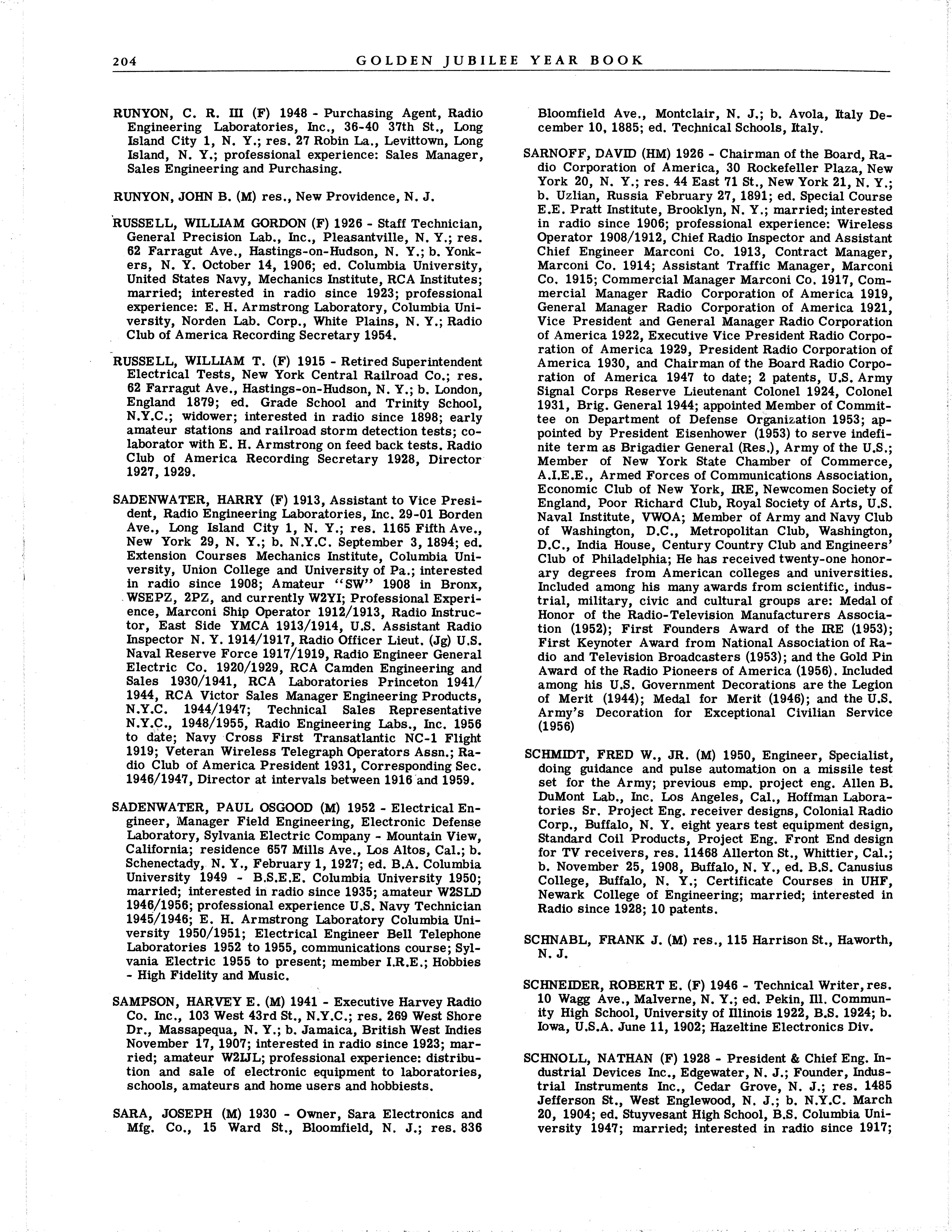
SCHMIDT, FRED W., JR. (M) 1950, Engineer, Specialist, doing guidance and pulse automation on a missile test set for the Army; previous emp. project eng. Allen B. DuMont Lab., Inc. Los Angeles, Cal., Hoffman Laboratories Sr. Project Eng. receiver designs, Colonial Radio Corp., Buffalo, N. Y. eight years test equipment design, Standard Coil Products, Project Eng Front End design for TV receivers, res. 11468 Allerton St., Whittier, Cal.; b November 25, 1908, Buffalo, N. Y., ed. B.S. Canusius College, Buffalo, N. Y.; Certificate Courses in UHF, Newark College of Engineering; married; interested in Radio since 1928; 10 patents.
SCHNABL, FRANK J (M) res., 115 Harrison St., Haworth, N. J.
SCHNEIDER, ROBERT E. (F) 1946 - Technical Writer,res. 10 Wagg Ave., Malverne, N. Y.; ed Pekin, Ill Community High School, University of Illinois 1922, B.S.1924; b. Iowa, U.S.A. June 11, 1902; Hazeltine Electronics Div.
SCHNOLL, NATHAN (F) 1928 - President & Chief Eng. Industrial Devices Inc., Edgewater, N. J.; Founder, Industrial Instruments Inc., Cedar Grove, N. J.; res. 1485 Jefferson St., West Englewood, N. J.; b. N.Y.C. March 20, 1904; ed. Stuyvesant High School, B.S. Columbia University 1947; married; interested in radio since 1917;
GOLDEN JUBILEE YEAR BOOK 204
SARA, JOSEPH (M)
Electronics and Mfg. Co., 15 Ward St., Bloomfield, N. J.; res. 836
amateur 2AGG 1919/1927; professional experience: Assistant Chief Engineer Polymet Mfg. Co. 1929/1932, Chief Engineer Solar Mfg. Co. 1932/1939, President and Chief Engineer Industrial Instruments Inc. 1939/1949, Chairman to date; Senior Member IRE; about 15 U.S. Patents in electronic and capacitor fields.
SCHOMBURG, RICHARD A. (M) res., North 921 Burns Rd., Spokane, Wash.
SCHUMACHER, ALLAN L. (M) 1937 - Senior Eng., Research & Development, Arma Division, American Bosch Arma Corp., Roosevelt Field, Garden City, L. I., N. Y.; res. 40 Maple Ave., Westbury, L. I., N. Y.; b. Brooklyn, N. Y.September 14, 1904; interested in radio since 1915; amateur 2AJ 1923/1925; held First Grade Radiotelephone operators license 1933; professional experience: Freshman Radio Co. Laboratory Assistant 1923/1929, Colonial Radio Corp. Engineer 1921/1931, Wired Radio Inc. engineer 1931/1940, Research and DevelopmentDepartment Arma Division, 1942 to present, on design & development of precision components for Analog & Digital Computers; Specializing in the design of Electromagnetic Components, Net-Works, Precision Electrical Measurements, Circuitry; Associate Member IRE 1942 to date; one paper “The Electromagnetic Resolver” AIEE 1951; Hobbies - Photography, music, Hi-Fi.
SCHWARTZ, ADOLPH (M) 1950, Radio Manufacturers Sales Representative, Eitel-McCullough, Inc. (Eimac), 23 years; res. 612 Sagamore Ave., Teaneck, N. J.; b. December 25, 1898; ed. High School, Marconi Institute on Elm St., N.Y.C.; Military Service, U.S. Army, WW1, Hon. Discharge; Amateur Call Letters, W2CN, Licensed since 1916, old calls 2 AFT, 2 ASK; Golf, Aldecress C/C.
SEELEY, S. WARD (F) 1948 - Retired 1956; RFD1, Carmel, N. Y.; b. Philadelphia, Pa. October 9, 1890; married 1920, Rosemary Clarke; ed. Central High School, Philadelphia, Pa.
SEKLEMIAN, ROBERT S. (M) 1942 - Manager, Real Estate Department, RCA Communications, Inc., 66 Broad St., New York 4, N. Y.; res. RFD1, Babylon, L. I., N. Y.; b. Fresno, Cal. April 20, 1902; ed. LL.B., J.D., LL.D.; married; interested in radio since 1922; professional experience: Announcer, radio operator, in charge of terminal office installations of RCAC domestic radiotelegraph network; Former Ensign U.S.N.R.; member IRE Morse Telegraph Club, Real Estate Board of N. Y. (Rental Conditions Committee)
nical magazine articles over past 35 years; Editor of “ Principles of Transistor Circuits” Wiley 1953; Chairman, Syracuse Section IRE, Senior Member IRE, member IRE Receivers, Standards and Papers Committees; currently Supervisor Semiconductors Applications G. E. Electronics Laboratory.
SHENIER, HENRY L. (M) 1951 - Patent Lawyer, Own Office, 230 Park Ave., N.Y.C.; res. Forest Hills, N. Y.; b. N. J. 1902; ed. U.S. Naval Academy B.S. 1922; Georgetown School of Law LLB1931; married; professional experience: Communication Officer U.S. Navy 1925/1927.
SHEPARD, FRANCIS H. JR. (F) 1936 - Consulting Engineer, and President of Shepard Laboratories, Inc., Summit, N. J.; res. Lee La., Countryside, Summit, N. J.; b. N.Y.C. May 6, 1906; ed. B.S. in M.E. Yale, Sheffield Scientific School 1929; married; interested in radio since 1930; professional experience: Laboratory Assistant to the late E. H.Sperry, Radio Corporation of America 1933/1940, Chief Eng. Revalation Patents Co. 1942/1945, Pres, of Shepard Labs, formed 1956, work in electro-mechanical fields, Computer input-output equipment, etc., about fifty patents mostly in electronics field on hearing aids, synthetic base response; Member IRE, member ASME, Director Kiwanis, member Chamber of Commerce, Summit, N. J.; Radio Club of America,President 1954 and 1955.
SHORTT, HUBERT L. (M) 1945 - President, Technograph Printed Electronics, Inc., 920 Northwest Blvd., WinstonSalem, N. C.; res. 3018 Cambridge, Winston-Salem, N. C.; Member IRE, & AIEE; Committee-PGPT-(IRE), 40C (EIA) Committee A(EIA).
SIEMENS, RUDOLPH H. (M) 1937 - Government Sales,RCA Electron Tube Division, 744 Broad St., Newark, N. J.; res. 31 Deer Trail Rd., No. Caldwell, N. J.; b. N.Y.C. 1905.

work-
SHACKELFORD, BENJAMIN E. (F) 1943 - Vice President, Ad. Auriema, Inc., 85 Broad St., New York 4, N. Y.; res. 743 Mosswood Ave., Orange, N. J.; b Richmond, Mo. August 12, 1891; ed. University of Mo. A.B.1912, A.M. 1913, University of Chicago Ph.D.1916;marrieding” interest in radio since 1918; amateur experience, none, father of one; professional experience Westinghouse Physical Laboratory Tube Engineering 1916/1929, RCA Research, Patent and License activities 1930 to 1956.
SHEA, RICHARD F. (F) 1934 Electronics Engineer, General Electric Co., Electronics Pk., Syracuse, N. Y.; res. 225 Twin Hills Dr., Syracuse 4, N. Y.; b. Boston, Mass. September 13, 1903; ed. B.S. in E.E. M.I.T.1924; married; interested in radio since 1917; amateur 1AZG, 1ADZ, W1BEC, W3BAI 1919/1931; professional experience 1925 to present American Bosch, Amrad, Kolster, Atwater Kent, Pilot (Chief Engineer), Freed-Eiseman (Chief Engineer), Fada (Chief Engineer), General Electric; 10 patents on electronic circuits; numerous tech-
SIEMINSKI, EDWARD (F) 1935 - Grumman Aircraft Engineering Corp., Avionics Engineering Dept., Bethpage, Long Island, N. Y.; res.134-14 Franklin Ave., Flushing 55, N. Y.; b. New Bedford, Mass. January 30, 1912; ed. M.I.T. B.S. in E.E.1934, Polytechnic Institute of Brooklyn Master in E.E. 1953; married; interested in radio since 1927; amateur WIDFD in New Bedford 1929/1934; professional experience: Press Association, Inc. (Research) 1940/1941, Amy, Aceves and King (Research) 1935/1940 and 1941/1942, Fairchild Camera and Instrument Corp. Project Engineer 1942/1945, Aeronics, Inc. Chief Engineer 1945/1947, Sylvania 1947/1955 Section Head in Electronics and missile systems laboratories, American Machine & Foundry Company 1955/1958 Group Supervisor in military electronics development, Grumman since January 1959; member IRE, AIEE, ARRL,Society of Professional Engineers, Sigma Xi, RESA, articles and papers on television, etc.; Hobbies: ice skating, swimming, automobile mechanics.
SIMON, WILLIAM C. (F) 1946 - Electronic Engineer United Fruit Co., General Manager Tropical Radio Service Corp., Pier 7, North River, New York 6, N.Y.; res. R.F.D. Box #36, Boston Ave., Bay Shore, L.I., N.Y.; b. Midway, Ky., June 16, 1899; ed. Grammar and some High School, U. S. Naval (Marine Corps) Radio School Parris Island 1917/1918; CREI; interested in radio since 1915; married; amateur 1913/1917; professional experience: U. S. Marine Corps 1917/1920, licensed commercial radio operator 1920/1924, United Fruit Co.1924 to present; Senior Member IRE, LM, Director and Secretary of VWOA, Member Marine Corps League, American Legion, Masonic Lodge; Baptist Church; Served on numerous committees with RTCA, RTCM, SLS, ITU, American
RADIO CLUB OF AMERICA, Inc. 205
:: : ;
. f
j :
Merchant Marine Institute dealing with Marine Electronic and Radio Matters; Marconi Memorial Medal of Merit, VWOA 1947.
SINGER, CHARLES H. (F) 1947 - Vice President Page Communication Eng. Inc., 710 14 St. N.W., Washington 8, D.C.
SINGLETON, HAROLD C. (F) 1935 - Consulting Radio Engineer, 931 S.W. King Ave., Portland 5, Ore.; res. 4488 SW Council Crest Dr., Portland 1, Ore.; b.Golden, Colo., February 7, 1904; ed. B.S. (EE) and E.E. University of Colorado; married; interested in radio since 1918; professional experience General Electric Co., RCA Victor Division, United Air Lines, Chief Engineer KGW Broadcasting Station; Resident Associate Harvard University (during World War Two); several patents on photo-electric controls. Tech. Dir. KWJJ, Portland, Ore.; V.Pres. KITN, Olympia, Wash.; Owner KUTY, Palmdale, Calif.
SKIPPER, LIONEL CARLYLE (M) 1946 - SperryGyroscope Co., Lake Success, Great Neck, N. Y.; res. 5 Warner Ave., Roslyn Heights, L.I., N. Y.; b. Clacton-on-Sea, Essex, England November 30, 1915; ed. Ascham College, Clacton, England, Brighton Technical College, Brighton England, British Institute of Engineering-Technology, London, England; married; interested in radiosince1932; professional experience: 1932/1935 Assistant Engineer Brighton Radio Circuit, Ltd., 1935/1940 Engineer Manager Radio Distribution Trinidad, Ltd., Port of Spain, Trinidad, BWI, 1940/1941 Director of Field Service, Radio Coverage Reports, New York City,1941 to present Technician, Sperry Gyroscope Co. (Radar Engineering); U. S. Citizen June 10, 1947; Senior Member IRE, Massapequa Lodge No. 822 F & A.M., Rosicrusian Order AMURC, Civil Defense Rescue Service, Green Mountain Club, Dale Carnegie Club International; fond of all outdoor activities including flying (Student Pilot Rating), 1941 to present Technician - Engineering Section for Systems, Surfire Armament Division', Sperry Gyroscope Co. (Radar Engineering).
SLATER, IRA M. (F) 1946 - Manager Sales Engineering, Semi-Conductor and Electro-Mechanical Divisions, P. R. Mallory & Co., Inc., 424 South Madison St., Du Quoin, HI.; res. 810 North Bolton Ave., Indianapolis 19, Ind.; b. Lebanon, Ind. July 14, 1906; ed. High School, College 2 years; married; radio since 1919; amateur 9DHE 1922/ 1926; professional experience Engineer WFBM, Engineer W. E. Co.Sound Systems; Engineer, Industrial Engineer, Divisional Chief Engineer, Sales Engineer, Divisional Sales Manager, Divisional Manager Sales Engineering, P. R. Mallory & Co., Inc. 28 years; several patents and patent applications; several papers on vibrators to technical groups; senior member IRE; HobbiesPhotography and Aviation (Private Pilot).
SLEEPER, MILTON BLAKE (F) 1925 - Publisher, Music at Home, 105 East 35th St., New York 16, N. Y.; res. Monterey, Mass.; b. Chicago, HI. November 13, 1897; amateur 1"Spark Coil transmitter in Newtonville, Mass, from 1910 to 1914; professional experience: Radio Operator U.S. Navy 1914/1915, Associate Editor Electrical Experimenter, Laboratory Assistant DeForest Radio 1915/1916, Aircraft Radio Research Sperry Gyroscope 1916/1917, Pilot British Royal Flying Corps. 1917/1918, Laboratory Assistant Western Electric Co. 1918/1919, Radio Editor Everyday Engineering Magazine 1919/1920, President Sleeper Radio Corporation 1929/1934, Mobile radio sales and service manager Gamewell Co. 1934/ 1935, Domestic Sales Manager Pilot Radio 1935/1937, Domestic Sales Manager Andrea Radio 1937/1938, Domestic Sales Manager Pilot Radio 1938/1940, Publisher FM Magazine, Communication Engineering 1940/1954,
High Fidelity 1951/1953, Senior Member IRE, member Eastern States Police Radio League; Publisher, Registries of Communication Systems 1945.
SMITH, MYRON T. (F) 1934 - Sales Manager, General Radio Co., West Concord, Mass.; res. Lowell Rd., Concord, Mass.; b. Meriden, Conn. July 11, 1908; ed.S.B. and S.M. M.I.T. Cambridge, Mass ; married.
SNITZER, MILTON S. (M) 1956 - Technical Editor, Radio and TV News, Ziff-Davis Publishing Co. since 1956; b. May 9, 1923, Pittsburgh, Pa.; res. 83-28 257thSt., Floral Park, N. Y.; Military Service, Electronics Instructor, U.S.M.S., 8 years; Amateur Call Letters, W2QYI since 1937; Books, Papers, etc., edited about 50 technical books, wrote about 6 technical and semi-technical books including military manuals as well as many magazine articles.
SNYDER, CHRISTOPHER L. (M) - GeneralCeramicsCorp., Keasbey, N. J.
SNYDER, RICHARD LEE (M) - res. 270 LindenSt.,Moorestown, N. J.
SOHVAL, LAWRENCE R. (M) - res. c/o Devlin, 111 West 95th St., New York 25, N. Y.
SPIES, DAVID (M) 1942 - Sales Manager-Owner, International Distributing Co.,185 Central Ave., Newark, N. J.; res. 239 Sanford St. East Orange, N. J ; ed. Newark College of Engineering E.E.; married; long interest in radio; Affiliate - International Sound Engineering Co.
STANTLEY, JOSEPH J. (F) 1912 - President Continental Sales Co., Inc., 521 Bloomfield Ave., Newark 7, N. J.; res. 213 Harvard Ave., Point Pleasant Beach, N. J.; b. Brooklyn, N. Y. September 16, 1891; married; ed. High School 2 years, Mechanics Institute 3 years, Pratt Institute 3 years; interested in radio since 1906; amateur 1906/1913-W2SC; professional experience:Secretary and Treasurer, Continental Radio Corp., 1920/1930, Secretary and Treasurer and General Manager Continental Radio Corp., 1922/1930, President, Continental Sales Co. Inc., 1930 to present; President Rochelle Park Bank, 1928/1952; Chairman of the Board, Rochelle Park Bank, 1952 to present. Bank now is known as Community Bank of Bergen County, N. J.; Treasurer, Armstrong Memorial Research Foundation, Inc., 1957 topresent;Director, Radio Club of America, Inc., 1926; Treasurer, 1927 to present.
STANTLEY, JOSEPH J. JR. (F) 1944 - Secretary and Treasurer, Continental Sales Co., Inc. 521 Bloomfield Ave., Newark 7, N. J.; res. 231 Harvard Ave., Point Pleasant Beach, N. J.; b. Teaneck, N. J. May 10, 1926; ed. Rutgers University (Business Administration);single.
STANTON, SAMUEL WARD (F) 1940 - Patent Engineer, A. B. DuMont Laboratories, Inc , 2 Main Ave., Passaic, N. J.; res. 289 Halsey Rd., East Parsippany, N. J.; b. Tottenville, Staten Island, N. Y. June 25, 1908; ed. B.S. in E.E. Rutgers University; married; interested in radio since 1918; amateur 2AHY-1923, W2QZ-1929, W2EEW and W2EHR 1932; professional experience: United Electric Light and Power Co. 1931/1935, RCA 1936, Western Electric 1937/1939, DuMont 1939 to date; Two U. S Patents.
STEEN, JEROME REED (F) 1947 - Engineering Reliability Specialist, Sylvania Electric Products Inc., 189 B St., Needham 94, Mass.; res. 50 Tamarack Rd., Reading, Mass.; b. West Bloomfield, N. Y. June 29,1901; ed. Uni-
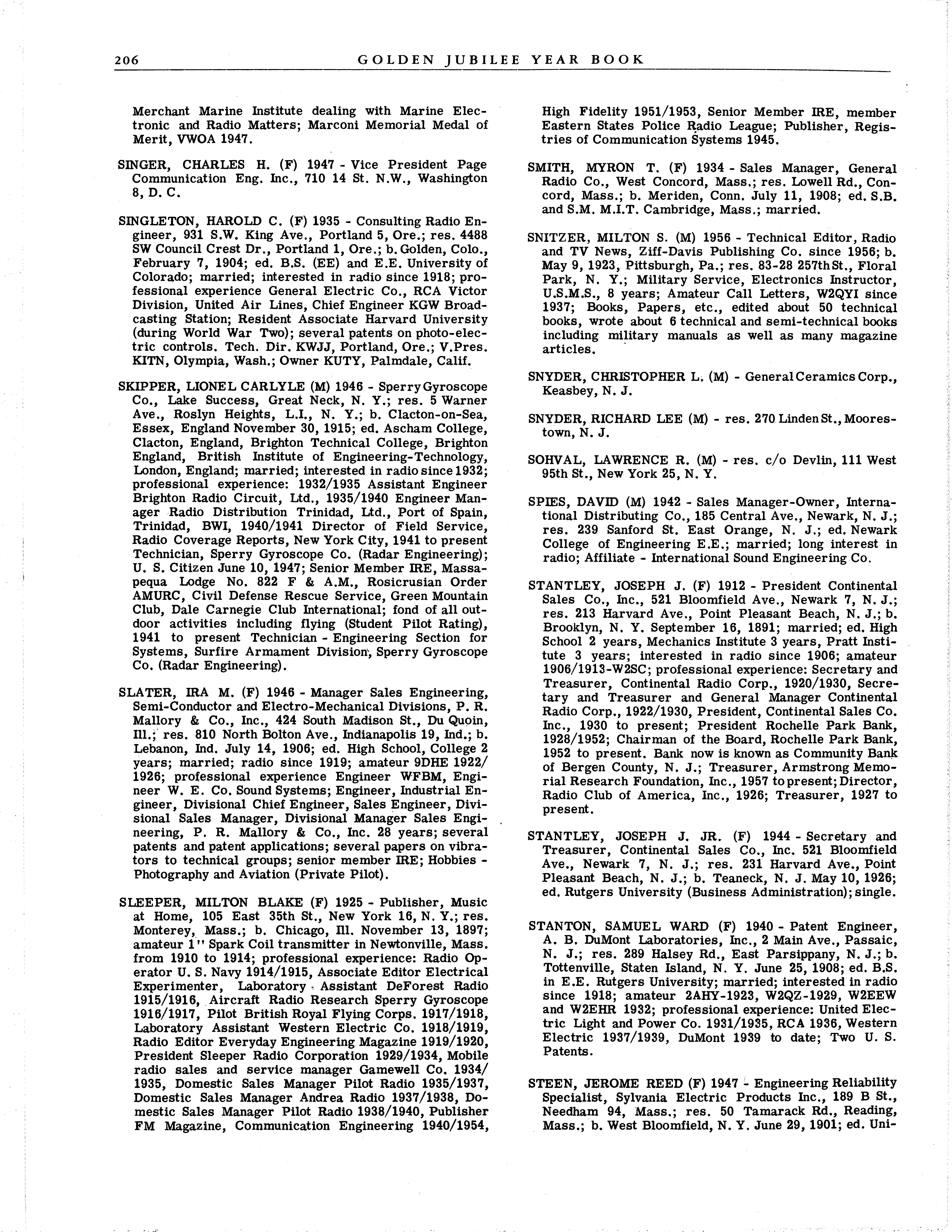
: ;
GOLDEN JUBILEE YEAR BOOK 206

versity of Wisconsin; married; interested in radio since 1923.
STEVENS, ARCHIE MCDONALD (F) 1928 - Radio Engineer, International Standard Electric Corporation, 67 Broad St., N.Y.C.; res. 539 Prospect Ave., Mamaroneck, N. Y.; b Glidden, Iowa September 22, 1887; ed. Glidden High School 1904, LeLand Stanford Jr. University 1909 A.B. in Engineering, post graduate courses in Columbia University; married; interested in radio since 1910; professional experience 1910/1913 Poulsen Wireless Tel. and Tel Co. San Francisco, 1913/1914 UniversalRadioSyndicate, London, Poulsen System, 1915/1921 Lt.Commander U.S.N.R F., U. S. Navy Lafayette Station, Bordeaux, France, 1922/1928 International Radio News Co., N. Y., 1928/1950 International Tel. and Tel. Corp. 1950/1952 Federal Tel. and Radio Corporation, 1952 to present International Standard Electric Corporation; Fellow (life member) IRE, Senior Member AIEE (life member), member Telephone Pioneers of America, member Armed Forces Communication Association.
STEVENS, HERBERT V. (M) 1959 - Radio Engineer; res. 63 Edson St., Buffalo 10, N. Y.; b. Buffalo, N. Y. 1904; ed. South Park High School, Buffalo Normal (2 yrs.), night school, Univ. of Michigan (2 summers & 2 falls), Adult Education 2 yrs., Cornell Univ Ext., Buffalo Museum, La Salle Ext University, Cleveland Institute of Radio Electronics, Buffalo Radio Institute, Eng. Soc of Buffalo P E Refresher Course; approximately 50,000 hours of formal and non-formal study; Range, Physics, Chemistry, atomic physics, mathematics, economics, dietics, music, art, literature, poetry, philosophy, psychology, astronomy, astrology, criminology, law, jurisprudence, political science, accounting, auditing, business, industrial arts; Hobby, answering correspondence courses and Regents High School Question and Answer Texts. Have 50 scrap-books; Amateur Call letters, W-2 GAF (ex. 8 AYT & W8 GAF); Correspondence Courses, CIRE, CREI, NRI, DeForest, Sprayberry, LaSalle Ext. Un., Alexander Hamilton Institute, etc. Have over 5,000 questions with their answers; Sports, swimming, golf, tennis, walking, cards, checkers, chess, discussion groups, weight lifting, etc.
STOCKMAN, WILLIAM E (M) 1947 - Research Engineer, American Machine & FoundryCo.,CentralResearch Lab., P.O. Box 889. Stamford, Conn.; res. 47 Cowing PL,Glenbrook, Conn.; b Stockholm, Sweden May 26, 1904; ed. equivalent to B.S.; amateur about seven years; professional experience: 25 years as a radio engineer.
STODOLA, E. KING (M) - Assistant to the President, Reeves Instrument Corp. East Gate Blvd., Roosevelt Field, Garden City, L.I., N. Y.; res. 118 Stanton St., Northport, L.I , N Y ; married; B S. in Electrical Engineering & Electrical Engineering degrees, Cooper Union Inst, of Technology.
STOKES, WILLIAM EARLDODGE JR (CM,F)1909 - Economist, self-employed, Lenox, Mass,; res. Thistlewood Farm, Lenox, Mass ; b N Y.C January 6, 1896; ed. Browning School, N.Y.C., Andover, Sheffield Scientific School, Annapolis, University of Chicago (Law School); married; interested in radio since 1909; early amateur stations in N.Y.C. and Monmouth Beach, N. J.; First President Junior Wireless Club and Senate Committee witness 1910;AssistantCommunicationsOfficer USSDelaware Grand Fleet World War One; Four early U. S. Patents in radio; American Institute of Mining andMetallurgical Engineers, Chicago Bar Association, Econometric Society, Berzelious (Yale), Alpha Setta Phi, American Mining Congress, Union Club (NY), University
(Wash.), Stock Exchange Lunch (NY), Lenox Club, Country Club of Pittsfield, Mid-Ocean Club, Royal Bermuda Yacht Club, Military: Naval Reserve Surface Division 1-14 LCDR USNR-R (Administration Officer); Publications: “Government Assistance to Small Gold Mines,” “ Free Power,” “Report of the Aviation CommitteeAIME,” “ Planetary Configurations and Stock Market Sentiment,” “Origin of the Pennyweight” and numerous technical publications for the Navy on Torpedo manufacture, “Survey of the U. S. Army Catalog System” for the Navy, “ Plan for a U S Navy Catalog System” (for the Navy), “ Electrostatic Origin of Ore Deposits;” Sports and Hobbies - Golf & Squash, Racquets family, stamps, sailing, education (Trustee etc.), Navy anticommunist Activities (various); Radio Club of America President 1909/1911.
STONE, CLARENCE GEORGE (F) 1925 - Consulting Engineer, Self-employed, Good Hill Rd., Weston, Conn.; res. same; b Detroit, Mich. December 10, 1888; ed. E.E and A.M. Columbia University, Professional Engineer since 1922; married; interested in radio since 1898; professional experience: taught physics at Columbia up to September 1952, also courses in Electronics and consulting work in this field; AIEE, IRE, American Physical Society.
STONE, G. EDGAR (F) 1935 - Machine Shop Owner, selfemployed, 607 Cedar St.; res. 413 West Main St., Boonton, N. J.; b. Charlton, Mass November 3, 1899; interested in radio since 1914; married; professional experience: 23 years as receiver design engineer, 10 years owner of machine shop specializing in mechanical parts for electronic equipment.
STYLES, THOMAS J. (F) 1915 - Secretary-Director, Armstrong Memorial Research Foundation, Inc., Philosophy Hall, Columbia University, New York 27, N. Y.; res. 160-01 84th Dr , Jamaica 32, N Y ; b. Ansonia, Conn., July 25, 1887; married; ed. Walworth Institute, Pace Institute, Columbia University, Sorbonne; radio amateur 1908-16 at Yonkers, N. Y.; operated station N. J National Guard, Sea Girt, 1911; licensed commercial radio operator 1912; seaplane radio operator, Naval Aviation Detachment, Palm Beach, Fla., 1917; Ensign, USNRF, Bureau of Engineering, Navy Department,1918/19;Bankers Trust Company, Paris, France, 1920/23; laboratory of Edwin H. Armstrong, Columbia University, 1924/54; Recording Secretary, Radio Club of America, Inc., 1916, Corresponding Secretary 1917/20, 1925/27, Director 1928/29.
SUYDAM, CLINTON H. (F) 1932 - International Tel. & Tel. Corp., N.Y.C.; res. 451 Heywood Ave., Orange, N. J.; ed. Stanford University A.B. 1918, E.E. 1925; b. Los Gatos, Cal. October 25, 1896.
SWINYARD, WILLIAM O. (F) 1941 - Radio/TV Engineer, Hazeltine Research, Inc. 325 W. Huron St., Chicago, HI.; res. 4948 Jerome Ave , Skokie, HI ; b. Logan, Utah July 17, 1904; ed. B.S. Utah State University, graduate studies Columbia and Northwestern; married; interested in radio 1924; professional experience: Hazeltine since 1930, Chief Engineer 1942 to 1957; V. P. & Director 1958; Technical papers: Measurement of AM and FM radio receivers in Pender-Mcllwain Handbook, Measurement of Loop Antenna Receivers IRE 1941; Member Chicago Radio Engineers Club, National Society of Professional Engineers, Lake Shore Club, Fellow IRE, Fellow AAAS; Eta Kappo Nu, Registered Professional Engineer, HI.
TALLEY, DAVID (F) 1949, Radio Engineer, International Tel. and Tel. Corp.; res. 130 Martense St., Brooklyn 26, N. Y.; b. N.Y.C.October 20, 1903; ed. E.E. from Brook-
: RADIO CLUB OF AMERICA, Inc. 207
; :
H !!
3
lyn Polytechnic Institute 1935; married; interested in radio since 1915; amateur since 1915, W2PF in 1919, extra first grade amateur license; professional experience: telephone engineer N. Y. Telephone Co. 1923 to 1946 except World War Two 1940/1945 as Lt. Colonel in Signal Corps, Telephone and Radio Engineer with International Tel. and Tel. Co. 1946/1951, Federal Tel. and Radio Corporation Govt. Contract Section 1951 to 1957, Telecommunications Operating Group of International Tel. & Tel.Corp., May 1957 to date; one patent on Signalling Systems; Senior Member IRE, member AIEE, ARRL, Radio Society of Great Britain, Reserve Officers Association of U.S. Military Order of World Wars, Vice President of N. Y. Chapter of Armed Forces Communications Assn., member Radio Club of Brooklyn, and Quarter Century Wireless Assn., Reserve Officer as Lt. Colonel in Signal Corps. USAR, engineered and installed mobile radio telephone systems in Buenos Aires 1948, Mexico City 1948, Havana 1949 and Cairo, Egypt in 1948.
TAYLOR, WILLIS H. JR. (F) 1925 - Patent Lawyer, Pennie, Edmonds, Morton, Barrows and Taylor, 247 Park Ave., New York 17, N. Y.; Chairman, Board of Trustees, Stevens Institute of Technology, Hoboken, N. J.
TENNIS, JOSEPH E. (M) 1955; Engineer, Radio Engineering Labs., res. 90-45 220 St., Queens Village, L. I., N. Y.; b. July 15, 1920, Brooklyn, N. Y.; ed. Brooklyn Technical High School, Pratt Institute; Clubs, IRE Member, Tau Beta Pi, Member.
THOMAS, LESLIE G. (M) 1928 - Management consultant, business address 610 E. Palisade Ave., Englewood, N. J.; res. Marcotte La., Tenafly, N. J.; b. London, England; ed. M.E.; married; interested in radio since 1912; professional experience: president Sheffco Mfg. Co., Palisades Park, N. J. and manufacturing executive, Vice President International Resistance Co., Philadelphia, General Manager Dejur-Amsco Corp., N.Y.C., Works Manager Fada Radio Co., Bronx 1926/1931; various patents on variable condensers.
THORP, WILBUR E. (F) 1948 - Electronic Engineer, Nortronics, Hawthorne, Cal.; res 2213 Chelsea Rd., Palos Verdes Estates, Cal.; b. Santa Cruz, Cal. July 6,1910; ed. B.S. in Engineering University of Cal.; married; interested in radio since 1923; professional experience:10 years Don Lee Television, Los Angeles, 3 years U.S. Navy Electronics Officer, Bureau of Aeronautics, 4 years Radio Engineering Laboratories as Development Laboratory Supervisor, 9 years Northrop Aircraft and Nortronics, present assignment, Supervisor of Radiative Systems Group; senior member IRE, Lt. Cmdr. United States Naval Reserve; hobby - Gardening.
TOEGEL, BURT JOSEPH (M) 1941 - Engineer, B. J. Toegel, Inc., 130 New St., res. 725 Park Ave., Plainfield, N. J.; b.Austria August 29,1901; ed. Public, Vocational, Night School; married; amateur since 1912, W2LI; professional experience: receiver design Engineer 1921 Garod Corp., Thomas A. Edison, Pilot Radio, Fada Radio, owner Coil Business since 1945; member Tri County Radio Club, Q.C.W.A., A.R.R.L. Certificate of Commendation U.S. Navy - Bureau of Ships - 1947
MICHAEL
TOTH, ALBERT F. (F) res 36-08 29th St., Long Island City, N. Y.; b. Hungary, September 4, 1902; ed. E.E. Polytechnic Institute of Brooklyn; RCA Director 1947/ 1957.
TUCKERMAN, LUCIEN P (F) 1928 - Radio EngineerTechnical Aide, Diamond Ordnance Fuze Laboratories, Washington 25, D.C.; res. 2500 Q St., N.W , Washington 7, D.C.; b. Wallingford, Conn. May 15, 1905; ed. Bell Telephone Labs. Electrical Communication Course;married; active in radio since 1923; professional experience: DeForest Radio Co., Kolster Radio Corp., Federal Telegraph Co., U.S. Navy Bureau of Ordnance, National Bureau of Standards; Commander U.S. Naval Reserve, Senior Member IRE, Member AIEE, SMPTE, Engineers Club of Washington, National Rifle Assn.; one patent “Peak Limiting Amplifier.’’ Registered Professional Engineer, District of Columbia.
TUXEN, NIELS (M) 1952 - Manager, Communications and Electronics Division, North American Philips Co., 100 East 42nd St., N.Y.C.; res. 22 Michaels La., Croton-onHudson, N. Y.; b. Copenhagen, Denmark, 1915; U.S. Citizen 1943; ed. Soroe Academy, Denmark graduated 1939 from Aarhus Electrotechnicum, Aarhus, Denmark (B.S.E.E.); married; amateur OZ9T 1931; ship’s radio operator Danish and British merchant marine World War Two; four years 9th Airforce in Europe; member Danish Engineers Club, N.Y.C.
ULM, ERNEST H. (F) 1950 - General SalesManager, Semiconductor Division, Sylvania, Woburn, Mass.; res. Winchester, Mass.; b. Ft. Dodge, Iowa January 8, 1916; ed. Carleton College A.B., Graduate work at University of Iowa and Northwestern Technological Institute; married; interested in radio since 1928; amateur license 1930; professional experience: Instructor in Radio and Electronics in High School and Vocational School and Army Signal Corps and Navy (Western Electric); member IRE, and AIEE.
ULRICH, VINTON K. (F) 1936 - Distributor Sales Manager, David Bogen Co., Inc., 29 Ninth Ave., New York 14, N. Y.; res. 1 Treadwell Ave., Madison, N. J.; b.Malden, Mass. August 12, 1914; ed. B.S. in Communications Engineering M.I.T. 1935; married; interested in radio since 1923; professional experience: Managing Editor “Radio Today” to 1939, to 1941 Sales Manager Hytronic Labs Division of Hytron, to 1945 Engineer in charge War Activities Hytron, to 1950 Manager Commercial Engineering Division Hytron, to 1953 Manager Renewal Sales Division National Union Radio; Senior Member IRE, Member AIEE and Lions International.
VAN BEUREN, JOHN M. (F) 1942 - President and Director of Research, Quan-Tech Laboratories, Morristown, N. J.; res. Morristown, N. J.; b. N.Y.C. March 4,1915; ed. Princeton University 1933/1936; married; interested in radio since 1931, amateur license (1933/1941); professional experience:Staff Advisory Engineer for Electronics, Thos. A. Edison Laboratory 1956/1957; Chief Research Engineer, Measurements Corp. 1939/1956; several patents on electronic devices; Hobby - Music and Hi-Fi; member IRE, Engineers Club, N.Y.C.
VAN DEN MEERSCHE, A. J. (M) 1930 - res. 22 St. Pieters AAlst Straat, Ghent, Belgium; b. Ghent, Belgium November 29, 1903; ed. E.E. University of Ghent; instructor University of Ghent; Associate IRE.
VAN RENSSELAER, HENRY C. (M) 1949 - Investment Counselor, The Bank of N. Y„ 48 Wall St., N.Y.C.; res. Rock Ridge, Greenwich, Conn.; b.Sao Paulo, Brazil May 17, 1920; ed. Kent School, Kent, Conn., Princeton University; married; interested in radio since 1933; amateur W1HSY, 1933; professional experience: Major U.S. Air Force, Communications and Radar, 1942/1946 and 1951/1952, Sales Manager Electronic Parts Division Al-
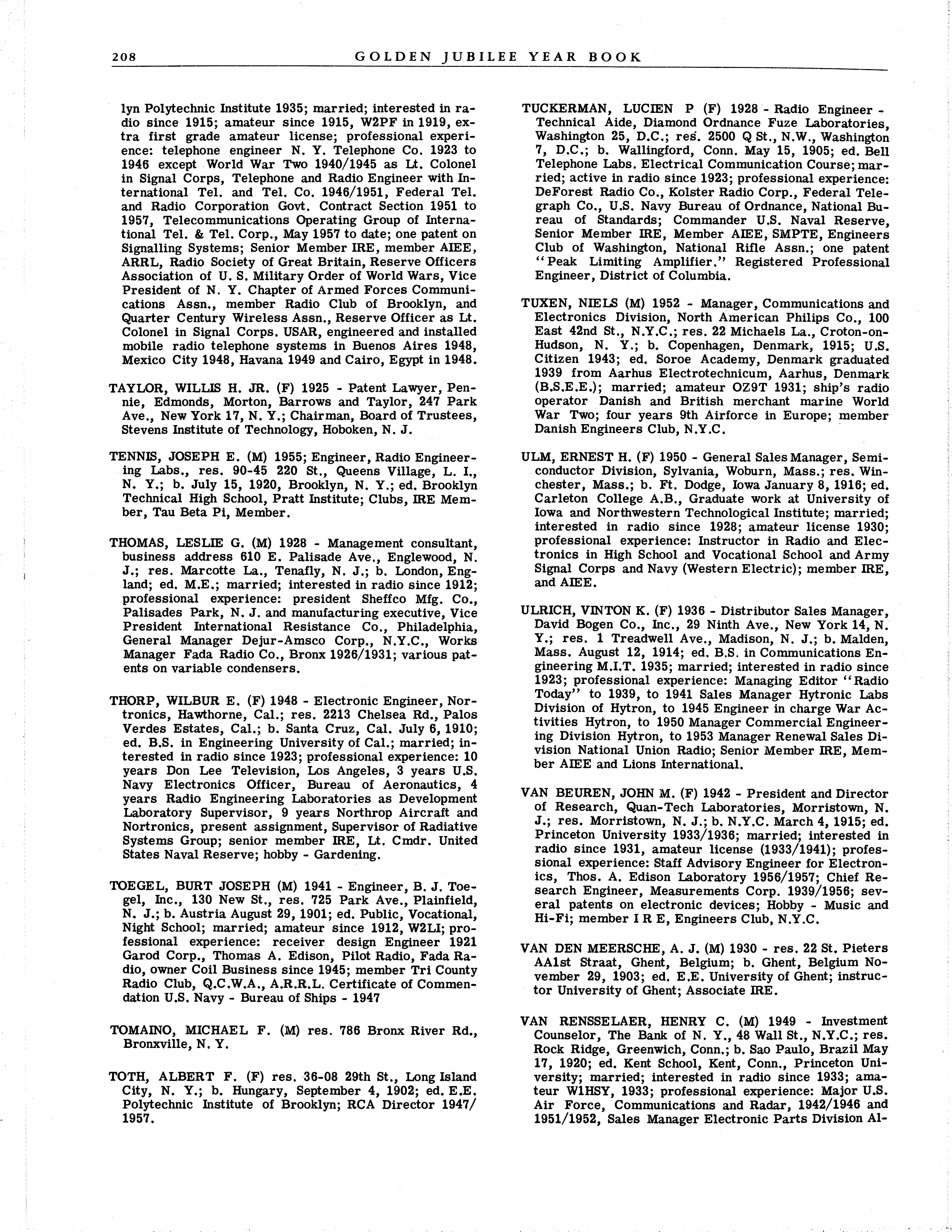
;
: GOLDEN JUBILEE YEAR BOOK 208
i
TOMAINO,
F. (M) res. 786 Bronx River Rd., Bronxville, N. Y.
len B.DuMont Laboratories 1947/1950; member Colonial Club, Princeton, N. J.; Hobbies - tennis, golf, skiing.
VOGEL, WILLIAM H., JR. (M) 1940 - Senior Project Engineer, Measurements, Div. of McGraw - Edison Co., Boonton, N. J.; res. 59 Crane St., Caldwell, N. J.; b. Brooklyn, N. Y. October 23, 1909; ed. Graduate Cornell University E.E. 1931; interested in radio since 1926; amateur W2BXM since 1931, member M.A R.S.AF2BXM; professional experience: television and FM transmitters', communication and test equipment 1945 to date; active service Air Force 1941/1945 Radar Officer; Member I.R.E.
VORPERIAN, HARRY (M) 1941 - Foreman in charge of Electronic Wiring Department, Aeroflex Laboratories, Inc., 34-06 Skillman Ave., Long Island City1, N. Y.; res. 210 Clinton Ave., Brooklyn 5, N. Y.; b. N.Y C. January 19, 1909; interested in radio since 1923, ed. Graduate Washington Irving High School, RCA Institutes and extra-curricula courses at Pa. University, Temple University and N. Y. University; professional experience: Electronic Technician with Federal Telecommunication Laboratories, Radio Engineering Laboratories and Aeroflex Research Laboratories; married.
WAIBH, DR. A LAFAYETTE (M) 1952, Dentist, self-employed, 509 Madison Ave., N.Y.C.; res. 785 Park Ave., N.Y.C.; b. N.Y.C. December 17, 1896; ed. College Dental and Oral Surgery of Columbia University; married; interested in radio since 1912; amateur since 1912, 2SP, 2BW since 1920; Past Director ARRL, Past President Radio Club, Past President N. Y. Radio Club, member IRE, member Armed Forces Com. and Elet.Soc., member U.S. Naval Institute, member ARRL, member Quarter Century Wireless Association.
WALSH, CRAIG (F) 1940 - President, Engineering Publishers, P. O. Box 2, Elizabeth, N.J ;res 14 North Ave., Elizabeth, N. J.; b. Elizabeth, N. J. November 29, 1912; ed Stevens Institute of Technology, Hoboken, N J , married; interested in radio since 1930; professional experience, Engineering Publishers, McGraw-Hill Book Co., Electrical Manufacturing magazine, Electronics magazine, Sylvania Electric Products Inc., Walsh Engineering Company; member Institute of Radio Engineers, American Institute of Electrical Engineers, and Standards Engineers Society.
WALSH, LINCOLN (F) 1934 - Consulting Engineer, Walsh Engineering Company and Caledonia Electronics and Transformer Corp., 34 DeHart PL, Elizabeth, N J.; res. 34 DeHart PL, Elizabeth 2, N J.; b. R. I. November 3, 1903; ed. Stevens Institute of Technology, M.E.1926, Post-Graduate Columbia, Brooklyn Polytechnic and Stevens; married; interested in radio since 1916; professional experience: Designer of transformers, high quality audio systems and radio receivers, Colonial (now Sylvania) Bell Telephone Laboratories and Hazeltine, RCA - Director - 1936; C.S.1941.
WARE, PAUL (F) 1921 - Pres., Ware Marine Products, Inc., Miami, Fla.; b. East Orange, N. J. June 26, 1893; ed. M.E. Stevens Institute of Technology 1917; wife, Josephine Varney; interested in radio since 1906, starting with amateur station at East Orange, N. J.; professional experience, marine wireless operator 1907/1912; second Lieut. Signal Corps during World War 1; manufactured Ware Neutrodyne receivers; invented INDUCTUNER and INPUTUNER for Mallory and DuMont respectively;sailed Atlantic Ocean in 17 days on Yacht ALOHA in 1912 averaging 8.06 knots; invented and presently manufacturing the Ware Automatic Pilot used on boats; hobbies - yacht-
ing and treasure hunting; Radio Club of America Director 1939/40; 44/50 - V.P. 1941 Pres. - 1942/43.
WASHINGTON, GEORGE JR. (F) 1951 - Retired, res. 10 Harter Rd., Morristown, N. J.; b. N.Y.C. August 6, 1899; ed. High School; married; interested in radio since 1921; Inventor of Photo-Electric Engraver known as the Fairchild Scan-o-graver; Director RCA 1957/58; Chairman 50th Anniversary Year Book Committee
WATSON, PAUL GRISTOCK (F) 1922 - Commander USNR
Retired, res. 27 Price St., West Chester, Pa.; b. West Chester, Pa. January 6, 1900; ed. High School and 1923 Pratt Institute E.E.; widower; interested in radio since 1912; amateur 3VB spark and 2CJU in Brooklyn while attending Pratt, station 4ZD-4XX at SavannahworkingDr. A. Hoyt Taylor at NKF; professional experience: commercial radio operator 1918/1923, Radio Inspector U. S. Shipping Board, N Y , U S Radio Inspector Savannah, Ga 1924/1926, Direction Finder Engineer RCA 1927/ 1928, Plant Engineer, Eastern Malleable Iron Co. Wilmington, Del. 1928/1940, Shop Superintendent U. S Navy Yard Philadelphia with Bank of Commander USNR 1940/ 1946; about 30 articles in Radio News, Pacific Radio, QST during 1919/1925 period, dropped out of radio in 1928 and entered ship construction (engineer) and participated in building over 100 ships in Philadelphia Navy Yard during World War Two; Life member TheAmerican Legion, Military Order of the World Wars, The Society of American Military Engineers, member DeForest Pioneers, Society of Naval Architects and Marine Engineers, The U. S Naval Institute; Hobby - Collecting of early vacuum tubes and old apparatus and parts;Awarded Navy Commendation Ribbon for “outstanding performance of duty” during World War Two.
WATTSON, HARRY B. (M) 1946 - res. 157 Prospect PL, Rutherford, N. J.; ed. Columbia University A.B. 1925, M.S. Harvard 1928; Sperry Gyroscope Co. Garden City, 1945.
WEBB, HARRY R. (M) 1958 - Supervisor of Instrument Depr., a combination of design, modification, calibration, repair of $250,000 of equipment, former Radio QTV instructor, Radio Engineering Labs., 5 years; res. 141-46 253 St., Rosedale 22, L.I., N. Y.; b. January 8,1918, Brooklyn, N. Y.; Military Service, 3-1/2 yrs., U. S. Army Signal Corps, Broadcast Engineer with Armed Forces Service; Amateur Call Letters, W2JOF, issued March 1936; Sports, Bowling, Amateur Radio, Ho Railroading.
WEED, EDGAR M. (F) 1950 - Technical Writer, Bell Telephone Laboratories, Whippany, N. J.; res. 53 Burnham Rd., Morris Plains, N. J.; b. Morris Township, N. J. March 15, 1907; ed. Morristown High School graduated 1925, Rutgers Extension Courses (Electronics); interested in radio since 1919; married; amateur W3JF in 1922, W3FSR and now K2BO; professional experience: Advertising Manager daily newspapers until 1943, Test Department Aircraft Radio Corp. Boonton, N. J.to 1945, Advertising Manager and TechnicalWriter Measurements Corp. Boonton, N. J. 1946/1952, joined Bell Labs. February 1, 1952; writer of many newspaper and magazine articles; member Morris Radio Club, former Northern District Director (Amateur radio) for N J.CivilDefense; Hobbies - radio, fishing; Radio Club of America Chairman of the Advertising Committee, 1953.
WEINBERG, SIDNEY (M) 1950 - Chief ProductionEngineer, Plant Manager, United Scientific Laboratories, Inc. 3515 37th Ave., Long Island City, N. Y.; res. 252-08 Cullman Ave., Little Neck, L.I., N. Y.; b. N.Y.C. January 2, 1909; ed B.S. in E.E. Cooper Union, Electronics Colum-
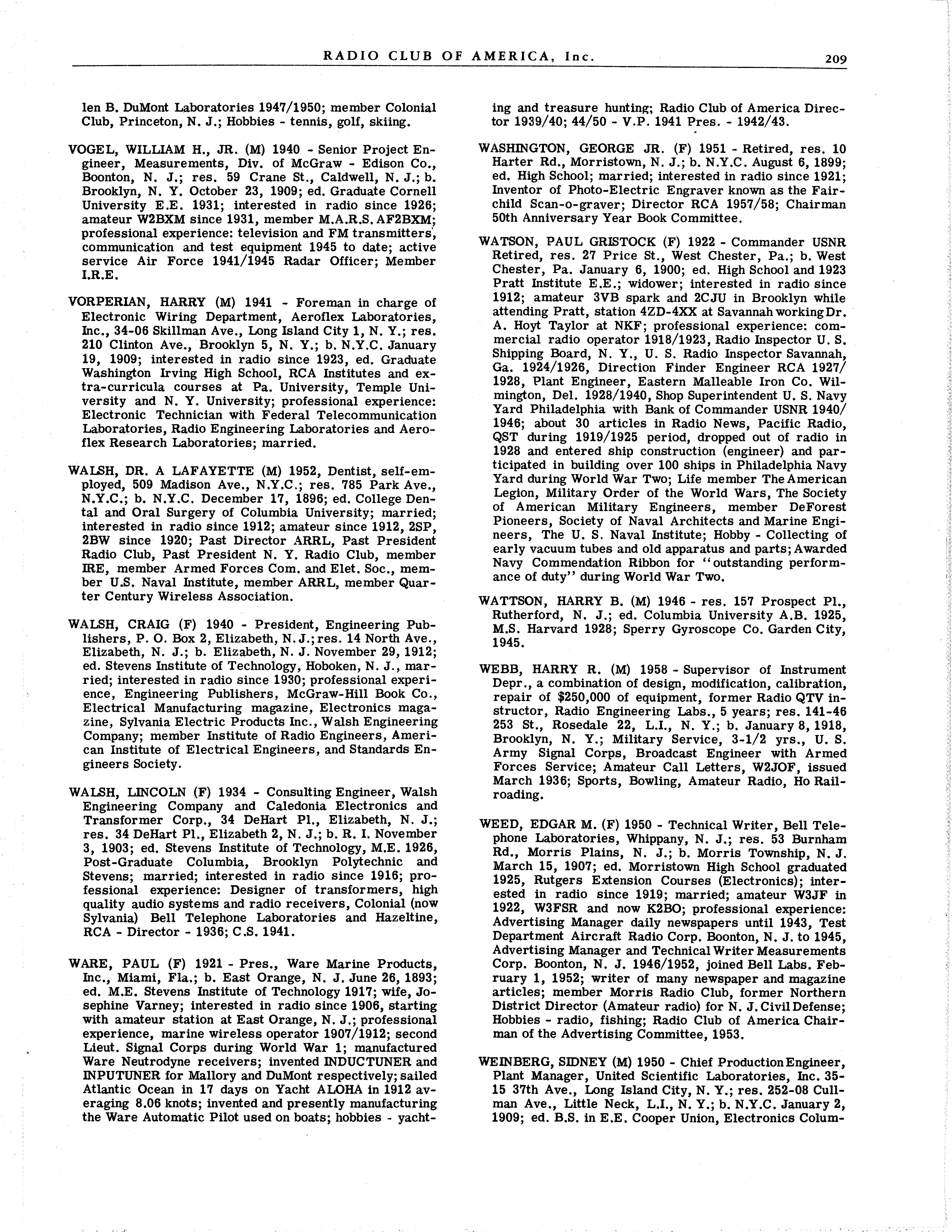
;
RADIO CLUB OF AMERICA, Inc. 209 :
i : ;
/
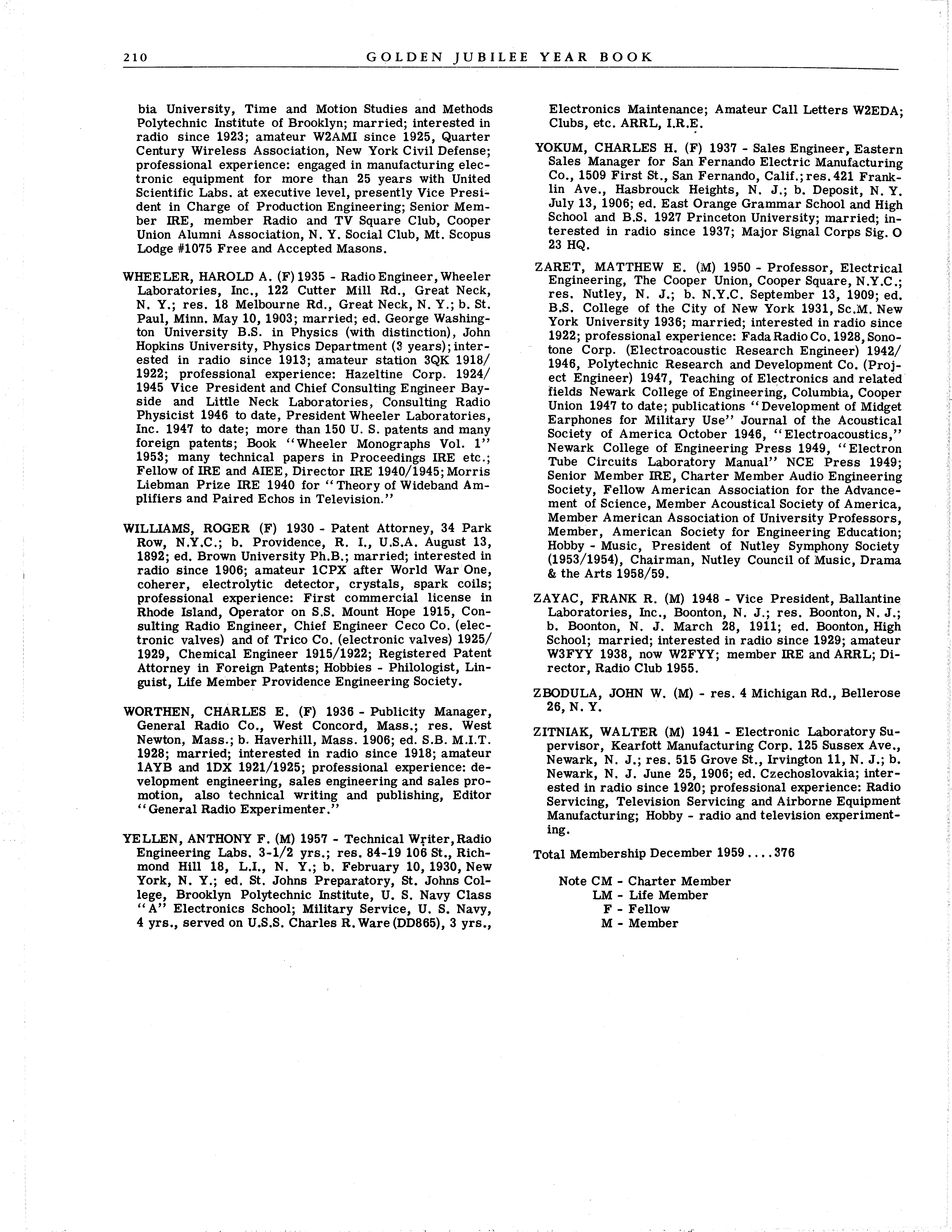
bia University, Time and Motion Studies and Methods Polytechnic Institute of Brooklyn; married; interested in radio since 1923; amateur W2AMI since 1925, Quarter Century Wireless Association, New York Civil Defense; professional experience: engaged in manufacturing electronic equipment for more than 25 years with United Scientific Labs, at executive level, presently Vice President in Charge of Production Engineering; Senior Member IRE, member Radio and TV Square Club, Cooper Union Alumni Association, N. Y. Social Club, Mt. Scopus Lodge #1075 Free and Accepted Masons.
WHEELER, HAROLD A. (F)1935 - RadioEngineer,Wheeler Laboratories, Inc., 122 Cutter Mill Rd., Great Neck, N. Y.; res 18 Melbourne Rd , Great Neck, N Y ; b.St. Paul, Minn. May 10, 1903; married; ed. George Washington University B.S. in Physics (with distinction), John Hopkins University, Physics Department (3 years)interested in radio since 1913; amateur station 3QK 1918/ 1922; professional experience: Hazeltine Corp 1924/ 1945 Vice President and Chief Consulting Engineer Bayside and Little Neck Laboratories, Consulting Radio Physicist 1946 to date, President Wheeler Laboratories, Inc. 1947 to date; more than 150 U S. patents and many foreign patents; Book “Wheeler Monographs Vol. 1” 1953; many technical papers in Proceedings IRE etc ; Fellow of IRE and AIEE, Director IRE 1940/1945;Morris Liebman Prize IRE 1940 for “Theory of Wideband Amplifiers and Paired Echos in Television.”
WILLIAMS, ROGER (F) 1930 - Patent Attorney, 34 Park Row, N.Y.C.; b. Providence, R I , U.S.A. August 13, 1892; ed. Brown University Ph.B.; married; interested in radio since 1906; amateur 1CPX after World War One, coherer, electrolytic detector, crystals, spark coils; professional experience: First commercial license in Rhode Island, Operator on S.S. Mount Hope 1915, Consulting Radio Engineer, Chief Engineer Ceco Co. (electronic valves) and of Trico Co. (electronic valves) 1925/ 1929, Chemical Engineer 1915/1922; Registered Patent Attorney in Foreign Patents; Hobbies - Philologist, Linguist, Life Member Providence Engineering Society.
WORTHEN, CHARLES E. (F) 1936 - Publicity Manager, General Radio Co., West Concord, Mass.; res. West Newton, Mass ; b. Haverhill, Mass 1906; ed S B M.I T 1928; married; interested in radio since 1918; amateur 1AYB and 1DX 1921/1925; professional experience: development engineering, sales engineering and sales promotion, also technical writing and publishing, Editor “General Radio Experimenter.”
YELLEN, ANTHONY F. (M) 1957 - Technical Writer,Radio Engineering Labs. 3-1/2 yrs.; res.84-19 106 St., Richmond Hill 18, L.I., N. Y.; b. February 10, 1930, New York, N. Y.; ed. St. Johns Preparatory, St. Johns College, Brooklyn Polytechnic Institute, U. S. Navy Class “A” Electronics School; Military Service, U. S. Navy, 4 yrs., served on U.S.S. Charles R.Ware(DD865), 3 yrs.,
Electronics Maintenance; Amateur Call Letters W2EDA; Clubs, etc. ARRL, I R.E
YOKUM, CHARLES H. (F) 1937 - Sales Engineer, Eastern Sales Manager lor San Fernando Electric Manufacturing Co., 1509 First St., San Fernando, Calif.;res.421 Franklin Ave., Hasbrouck Heights, N. J ; b. Deposit, N. Y. July 13, 1906; ed. East Orange Grammar School and High School and BS. 1927 Princeton University; married; interested in radio since 1937; Major Signal Corps Sig.O 23 HQ.
ZARET, MATTHEW E. (M) 1950 - Professor, Electrical Engineering, The Cooper Union, Cooper Square, N.Y.C.; res. Nutley, N. J.; b. N.Y.C. September 13, 1909; ed. B.S. College of the City of New York 1931, Sc.M New York University 1936; married; interested in radio since 1922; professional experience: FadaRadioCo.1928,Sonotone Corp. (Electroacoustic Research Engineer) 1942/ 1946, Polytechnic Research and Development Co. (Project Engineer) 1947, Teaching of Electronics and related fields Newark College of Engineering, Columbia, Cooper Union 1947 to date; publications “Development of Midget Earphones for Military Use” Journal of the Acoustical Society of America October 1946, “Electroacoustics,” Newark College of Engineering Press 1949, “Electron Tube Circuits Laboratory Manual” NCE Press 1949; Senior Member IRE, Charter Member Audio Engineering Society, Fellow American Association for the Advancement of Science, Member Acoustical Society of America, Member American Association of University Professors, Member, American Society for Engineering Education; Hobby - Music, President of Nutley Symphony Society (1953/1954), Chairman, Nutley Council of Music, Drama & the Arts 1958/59.
ZAYAC, FRANK R. (M) 1948 - Vice President, Ballantine Laboratories, Inc., Boonton, N. J ; res. Boonton, N. J.; b. Boonton, N. J. March 28, 1911; ed. Boonton, High School; married; interested in radio since 1929; amateur W3FYY 1938, now W2FYY; member IRE and ARRL; Director, Radio Club 1955.
ZBODULA, JOHN W. (M) - res. 4 Michigan Rd., Bellerose 26, N. Y.
ZITNIAK, WALTER (M) 1941 - Electronic Laboratory Supervisor, Kearfott Manufacturing Corp. 125 Sussex Ave., Newark, N. J.; res. 515 Grove St., Irvington 11, N. J.; b. Newark, N. J. June 25, 1906; ed. Czechoslovakia; interested in radio since 1920; professional experience: Radio Servicing, Television Servicing and Airborne Equipment Manufacturing; Hobby - radio and television experimenting.
Total Membership December 1959....376
Note CM - Charter Member
LM - Life Member
F - Fellow
M - Member
GOLDEN JUBILEE YEAR BOOK 210
:
-
Aceves, Julius G
Allen, George Y
Armstrong, Edwin H
Ayer, Oliver G
Baker, Thomas S
Ballantine, Stuart
Bingham, Wilbur Fisk
Brett, Harold M.
Brown, David Seymour
Browne, Walram
Burlingame, Bruce O
Capen, William H
Clark, Herbert A , Jr
Clark, LeRoy
Cooney,J K
DeVine, Alexander A.
Dunn, Gano
Ehrmann, GustavJ
Eltz, GeorgeJ
Ferris, Malcom
Forbes, Henry C
Glavin, Edward F
Godfrey, Dr. Charles C
Goulden, Stantley W.
Grebe, Alfred H.
Grinan,John F
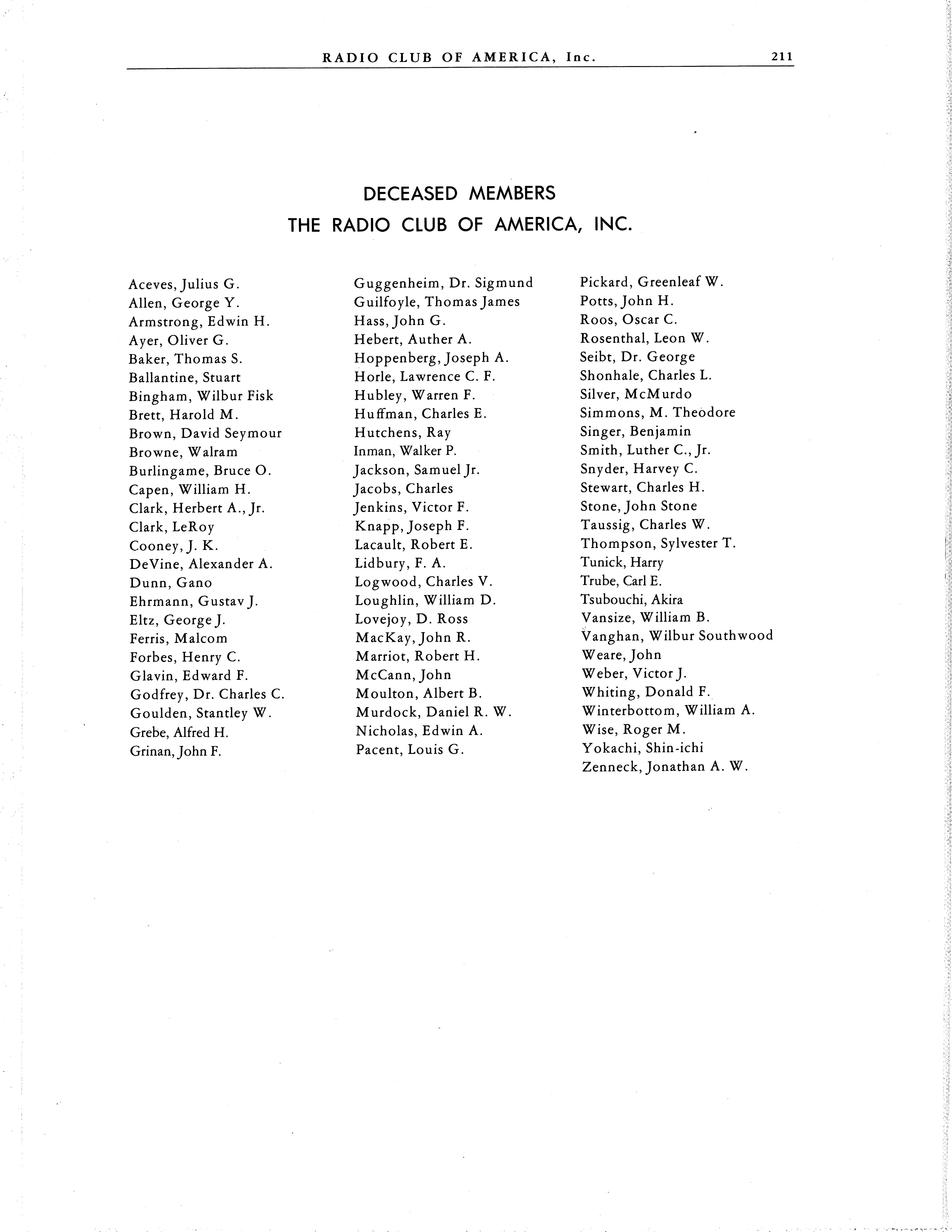
DECEASED MEMBERS
THE RADIO CLUB OF AMERICA, INC.
Guggenheim, Dr Sigmund
Guilfoyle, Thomas James
Hass, John G
Hebert, Auther A
Hoppenberg,Joseph A
Horle, Lawrence C. F.
Hubley, Warren F.
Huffman, Charles E.
Hutchens, Ray
Inman, Walker P
Jackson, Samueljr
Jacobs, Charles
Jenkins, Victor F.
Knapp, Joseph F.
Lacault, Robert E
Lidbury, F A
Logwood, Charles V
Loughlin, William D
Lovejoy, D. Ross
MacKay, John R
Marriot, Robert H.
McCann, John
Moulton, Albert B.
Murdock, Daniel R. W.
Nicholas, Edwin A
Pacent, Louis G
Pickard, Greenleaf W.
Potts, John H
Roos, Oscar C
Rosenthal, Leon W
Seibt, Dr George
Shonhale, Charles L
Silver, McMurdo
Simmons, M. Theodore
Singer, Benjamin
Smith, Luther C , Jr
Snyder, Harvey C
Stewart, Charles H.
Stone, John Stone
Taussig, Charles W.
Thompson, Sylvester T
Tunick, Harry
Trube, Carl E.
Tsubouchi, Akira
Vansize, William B
Vanghan, Wilbur Southwood
Weare, John
Weber, Victor J.
Whiting, Donald F
Winterbottom, William A.
Wise, Roger M
Yokachi, Shin-ichi
Zenneck,Jonathan A W
I i RADIO CLUB OF AMERICA, Inc 211 I I
5 1i $
' : : I ! % I I5 : : I I ; i i A I A J a a 1 f-? i |
CONSTITUTION OF THE RADIO CLUB OF AMERICA, INC.
ARTICLE I
NAME, OBJECT AND EMBLEM
SECTION 1. The name of this organization shall be The Radio Clubof America, Inc
SEC 2 Its object shall be the promotion of cooperation among those interested in scientific investigation and amateur operation in the art of radio-communication
SEC 3 The emblem of the Club shall be that shown in the margin This emblem shall be made in theform of a pin and may be purchased from the Treasurer
ARTICLE II MEMBERSHIP
SECTION 1 The membership shall consist of:
(a) Members
(b) Fellows
(c) Honorary Members
Fellows, Members or Honorary Members shall be entitled to all privileges of the Club except that Fellows only may hold officeor be elected to the Board of Directors
Honorary Members shall be presented with theClub pin
SEC 2 A Member shall be a male or female person, not less than seventeen years of age, who has been interested in the investigation of the principles of radio communication and in radio operation, either in its commercial or amateur aspects, for a period of at least one year.
SEC. 3. An Honorary Member shall be a person of high professional standing who is interested in the activities of the Club
SEC 4 A Fellow shall have been a member in the Club for five years or one whose contributions to the Radio Art are of such a nature as to qualify him In addition, the application for membership as "Fellow” shall be left to the discretion of the Board of Directors
SEC. 5. The emblem for Fellow shall be the reverse of that for Member i e , black insignia on a gold background
ARTICLE III
ADMISSIONS, EXPULSIONS AND RESIGNATIONS
SECTION 1 An applicant for admission to membership shall present the prescribed application, properly filled out, to the Corresponding Secretary The application shall contain the names of three Fellows or Members to whom theapplicant is personally known
SEC 2. Applications for membership shall be acted upon at the discretion of the Board of Directors
SEC 3 The Corresponding Secretary shall notify an elected candidate of his election and forward to him a statement of entrance fee and initial dues. 2X 2

)

SEC 4 Members found delinquent in their duties may be tried by the Board of Directors, and upon decision of the Board their names shall be submitted to the Club to determine their suspension or expulsion A three-quarters vote of the Club will be necessary to ratify such action of the Board
SEC 5 A member may resign his membership by a written communication to the Corresponding Secretary, who shall present the same to the Board of Directors; when, if all his dues have been paid, his resignation shall be accepted
ARTICLE IV
ENTRANCE FEE AND DUES
SECTION 1. The annual dues payable by Members shall be Three Dollars; for Fellows, Five Dollars The entrance fee payable by Members on election to membership shall be One Dollar. Honorary Members shall be exempt from payment of any dues or fees.
SEC. 2. The Annual dues shall be payable on the first day of each calendar year, in advance for the ensuing year It shall be the duty of the Treasurer to notify each Member or Fellow of the amount due.
SEC. 3. Every Member or Fellow, upon payment of his annual dues, shall be furnished with a membership card bearing the signature of the Treasurer
SEC 4 Persons elected to membership after July 1st of any year shall pay only one-half of the dues for that year.
SEC 5 Any Member or Fellow whose dues become two months in arrears shall be notified by the Treasurer. Should his dues then become four months in arrears, he shall again be notified by the Treasurer Should his dues then become six months in arrears he shall forfeit his connection with the Club. The Board of Directors may, however, for sufficient cause temporarily excuse from payment of annual dues any Member or Fellow or extend the time for payment.
SEC. 6. Every person admitted to the Club shall be considered as belonging thereto and liable for the payment of all dues (except as per Sec. 7 of this Article) until he shall have resigned, been expelled, or have been relieved therefrom by the Board of Directors.
SEC. 7. Any Member or Fellow not in arrears, upon payment of One Hundred Dollars shall be exempt for life from the payment of annual Dues.
ARTICLE V
OFFICERS
SECTION 1 The governing body of the Club shall be a President, a Vice-President, a Treasurer, a Corresponding Secretary, a Recording Secretary and thirteen Directors, who shall together constitute the Board of Eighteen Directors.
SEC. 2. The terms of all officers named in the preceding section shall be one year, shall begin at the first regular meeting of each year at which the results of the Annual Election are announced, and shall continue until successors are duly elected.
ARTICLE VI
GOVERNMENT
SECTION 1. The President shall have general supervision of the affairs of the Club He shall preside at meetings of the Club and of the Board of Directors at which he may be present, and shall be an ex-officio member of all committees
SEC. 2. The Vice-President shall assume all the duties of the President during the President’s absence from meetings or whenever the President is otherwise unable to perform such duties. In the event of the VicePresident’s inability to assume these duties a Chairman pro tem shall be appointed by those present at any meeting.
RADIO CLUB OF AMERICA, Inc. 213
I
SEC. 3. The Treasurer shall collect and receive all dues and fees and shall have custody of all funds of the Club. He shall issue membership cards to Members or Fellows upon payment to him of their dues. He shall make such payments for the Club as are provided for in the Constitution or such as shall be ordered by the Board of Directors He shall make an annual report of such at each meeting of the Board of Directors.
SEC. 4 The Corresponding Secretary shall conduct the correspondence of the Club other than that conducted by the Treasurer He shall keep full records of the correspondence conducted by him and make a report of such at each meeting of the Board of Directors.
SEC 5 The Recording Secretary shall duly record all proceedings of all meetings of the Club and the Board of Directors He shall have custody of all application blanks of persons admitted to membership and all other records of the Club.
SEC. 6 The Board of Directors shall manage the affairs of the Club in conformity with the provisions of the Constitution. It shall direct the care and appropriation of the funds of the Club; act upon applications for membership as heretofore provided; recommend Honorary Members; exercise discretionary power in the election to the grade of Fellow of Members or original applicants having the qualifications therefor (Art II, Sec 4) ; take measures to advance the interests of the Club, and generally direct its business. Six members of the Board of Directors shall constitute a quorum
SEC. 7. The President, within fourteen days after the conclusion of the Annual Election, shall appoint from the membership the following standing committees:
Committee on Papers, Committee on Publications, Membership Committee, Publicity Committee, Entertainment Committee, Committee on Affiliation, Year Book and Archives Committee.
ARTICLE VII
NOMINATION AND ELECTION OF OFFICERS
SECTION 1. At the Annual Meeting nominations for the offices of President, Vice-President, Treasurer, Corresponding Secretary, Recording Secretary and seven Directors shall be called for from the entire membership Members unable to attend in person the Annual Meeting at which the above nominations are called for may obtain from the Corresponding Secretary a prescribed blank form on which they may nominate candidates for any or all of the above offices. Such nominations must be in the possession of the Corresponding Secretary within ten days after the Annual Meeting at which nominations were called for Nominations made in this way must be three in number for any nominee to have him considered as such provided he has not already been nominated at the prescribed meeting At least twenty-one days before the first regular meeting of the calendar year the Corresponding Secretary shall submit to the membership the list of nominees for each office. The membership shall then submit a written ballot voting for officers and seven directors from the list of nominees submitted. A majority vote up to the time of the closing of the polls (forty-eight hours before the opening of the first regular meeting of the calendar year), shall elect
SEC 2 Six additional Directors, three of whom shall not have previously held office in the Club, nor have served on the Board of Directors, shall be elected by a majority vote of the newly constituted Board of Directors at its first meeting.
ARTICLE VIII MEETINGS
SECTION 1 The Annual Meeting of the Club shall be held within the first week in December, or as near thereto as may be possible, of each year
SEC. 2 Regular monthly meetings shall be held as ordered by the Board of Directors. If possible such meetings shall be held on the second Wednesday evening of each month excluding July and August At the first

;
GOLDEN JUBILEE YEAR BOOK 214

regular meeting of each calendar year the results of the election of Officers and seven Directors shall be announced and elected Officers shall be installed, and the Annual Reports of the previous year shall-be read
SEC. 3. The Board of Directors shall meet as soon as possible following the Annual Election and at such other times as are considered expedient by the President
SEC. 4. At the regular monthly meetings of the Club items of interest from the minutes of the Board of Directors may be read but no other business shall be conducted but that ordered by the Board of Directors. Any business of Club interest may be informally discussed after the formal adjournment of any meeting.
SEC. 5. At any meeting of the Board of Directors suggestions from the membership on matters appertaining to the welfare of the Club may be considered. Such suggestions shall at all times be encouraged by the Directors and they should be submitted in writing to the Corresponding Secretary, who will present the same at the Directors’ meeting next following their receipt by him.
ARTICLE IX
AMENDMENTS
SECTION 1. Proposed amendments to this Constitution must be reduced to writing and signed by not less than twelve Members or Fellows and be submitted to the membership who shall vote thereupon by letter ballot The amendment shall be adopted if seventy-five per cent of the votes received are in favor of such action, the polls having been open for at least one month after mailing to the qualified membership notices of the proposed amendments
f RADIO CLUB OF AMERICA, Inc 215
ACKNOWLEDGMENT
Grateful acknowledgment is made to the following sponsors who, by their generous contributions, helped make this Golden Anniversary Year Book possible:
LEON L ADELMAN, W2AFS
AEROVOX CORPORATION
ALTEC LANSING CORPORATION
AMERICAN RADIO RELAY LEAGUE, Inc.
AMY, ACEVES & KING, Inc.
ALFRED W. BARBER LABORATORIES
GEORGE E. BURGHARD
COLLINS RADIO COMPANY
COMPONENTS CORP.
CONTINENTAL SALES CO., Inc.
EITEL-McCULLOUGH, Inc. (Eimac)
ERIE RESISTOR CORPORATION
ROBERT FINLAY
GAWLER-KNOOP COMPANY
GENERAL RADIO COMPANY
PAUL GODLEY COMPANY
W. J. HALLIGAN, W9AC
HARVEY RADIO CO., Inc.
HAZELTINE CORPORATION
HOFFMAN ELECTRONICS CORPORATION
HOGAN FAXIMILE CORPORATION, a subsidiary of Telautograph Corporation
HARRY W. HOUCK
HUDSON WIRE COMPANY
INTERNATIONAL TELEPHONE and TELEGRAPH CORPORATION
ARTHUR H. LYNCH & ASSOCIATES, Inc.
McGRAW-HILL PUBLISHING COMPANY
MEASUREMENTS, a McGraw-Edison Division
GENERAL INSTRUMENT CORPORATION
BLILEY ELECTRIC CO.
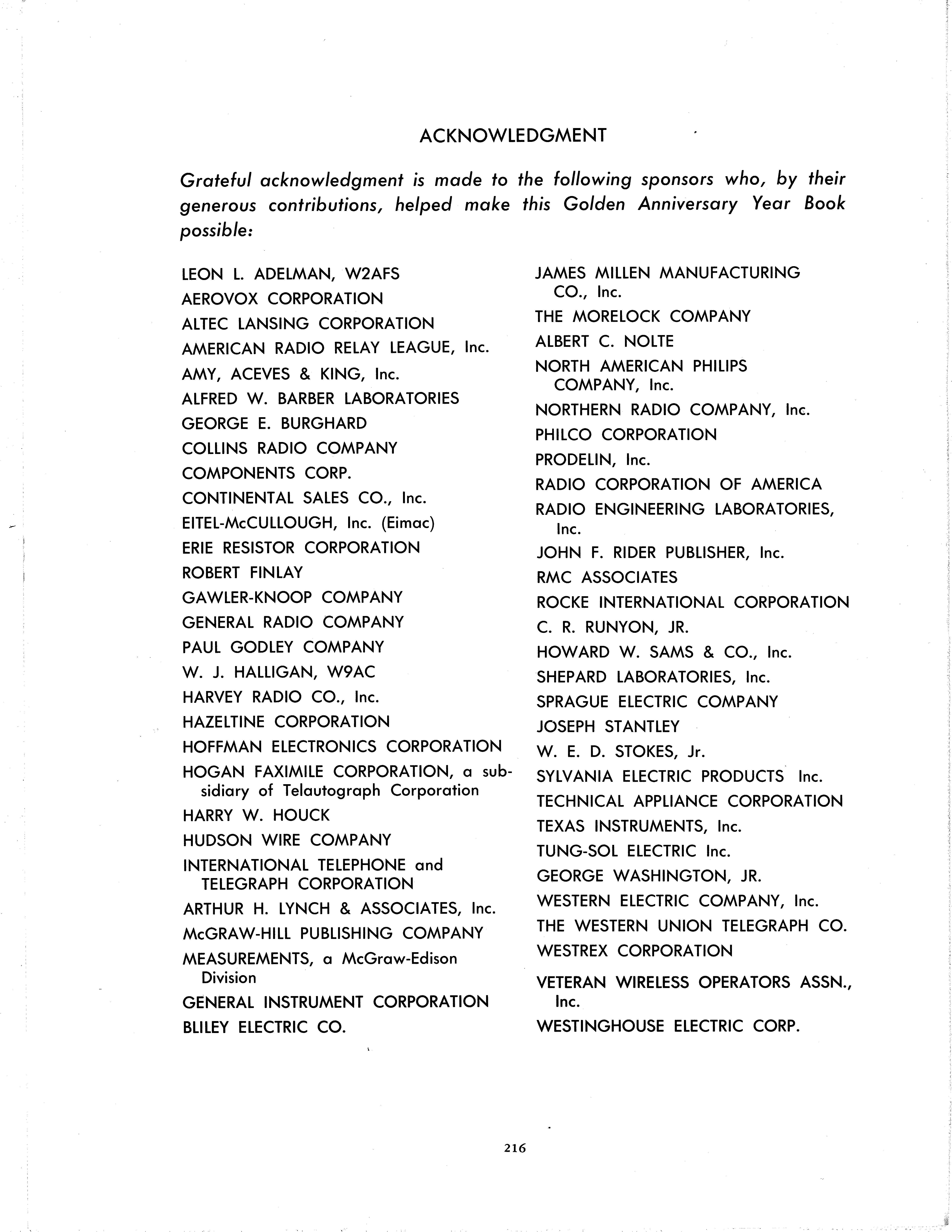
JAMES MILLEN MANUFACTURING CO., Inc.
THE MORELOCK COMPANY
ALBERT C. NOLTE
NORTH AMERICAN PHILIPS COMPANY, Inc.
NORTHERN RADIO COMPANY, Inc
PHILCO CORPORATION
PRODELIN, Inc.
RADIO CORPORATION OF AMERICA
RADIO ENGINEERING LABORATORIES, Inc.
JOHN F. RIDER PUBLISHER, Inc.
RMC ASSOCIATES
ROCKE INTERNATIONAL CORPORATION
C. R. RUNYON, JR.
HOWARD W. SAMS & CO , Inc.
SHEPARD LABORATORIES, Inc
SPRAGUE ELECTRIC COMPANY
JOSEPH STANTLEY
W. E. D. STOKES, Jr.
SYLVANIA ELECTRIC PRODUCTS Inc.
TECHNICAL APPLIANCE CORPORATION
TEXAS INSTRUMENTS, Inc.
TUNG-SOL ELECTRIC Inc.
GEORGE WASHINGTON, JR.
WESTERN ELECTRIC COMPANY, Inc.
THE WESTERN UNION TELEGRAPH CO.
WESTREX CORPORATION
VETERAN WIRELESS OPERATORS ASSN., Inc.
WESTINGHOUSE ELECTRIC CORP.
I:
!
: : i ;
216 !
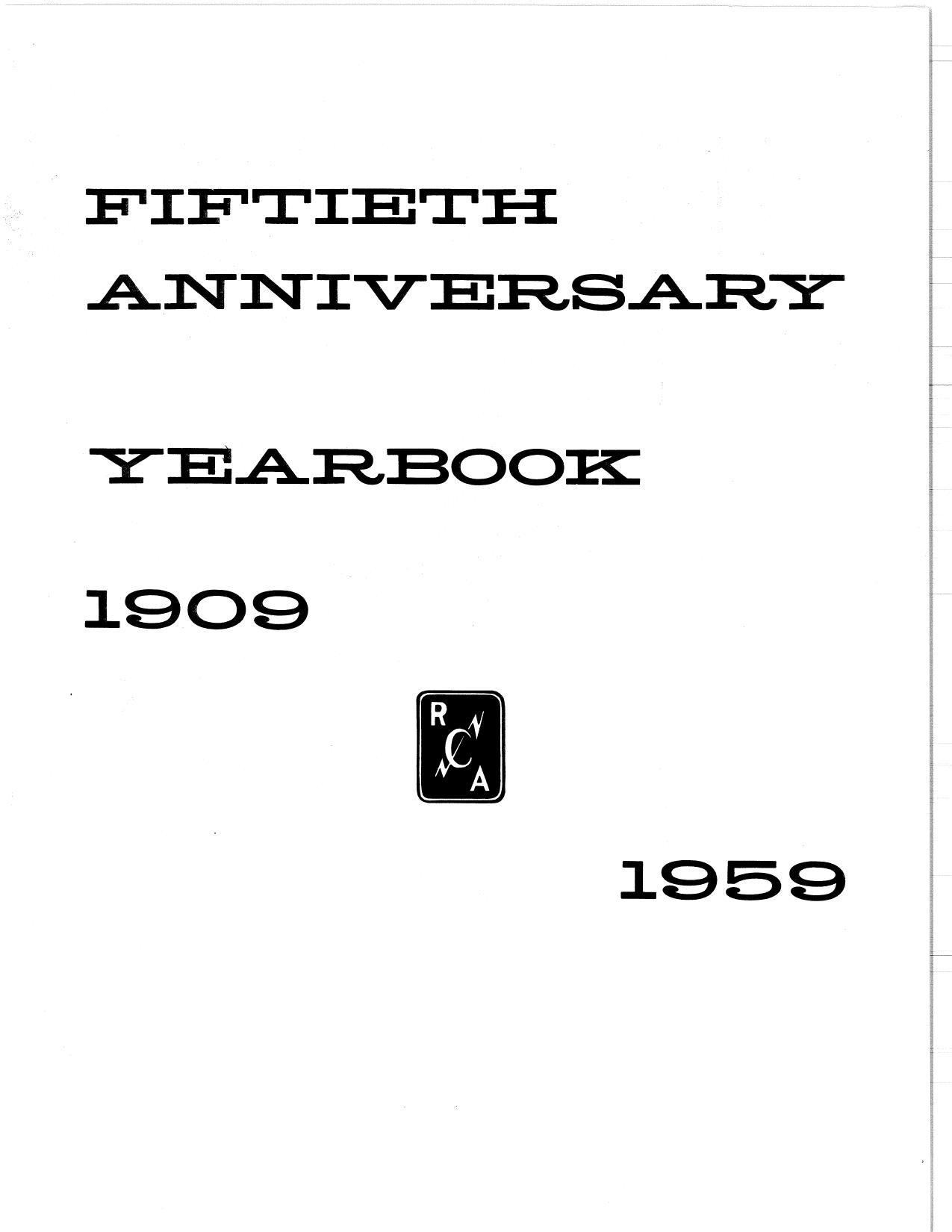
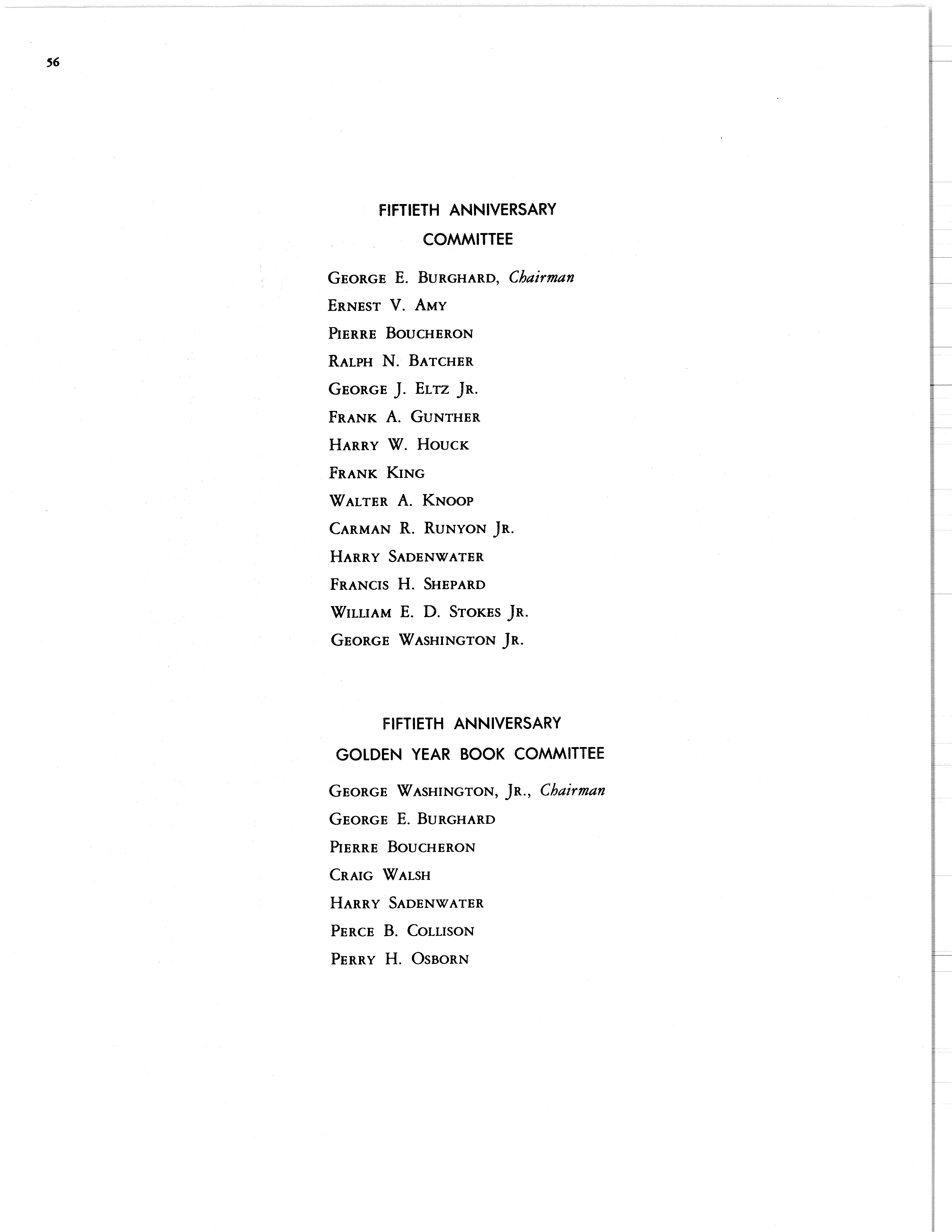


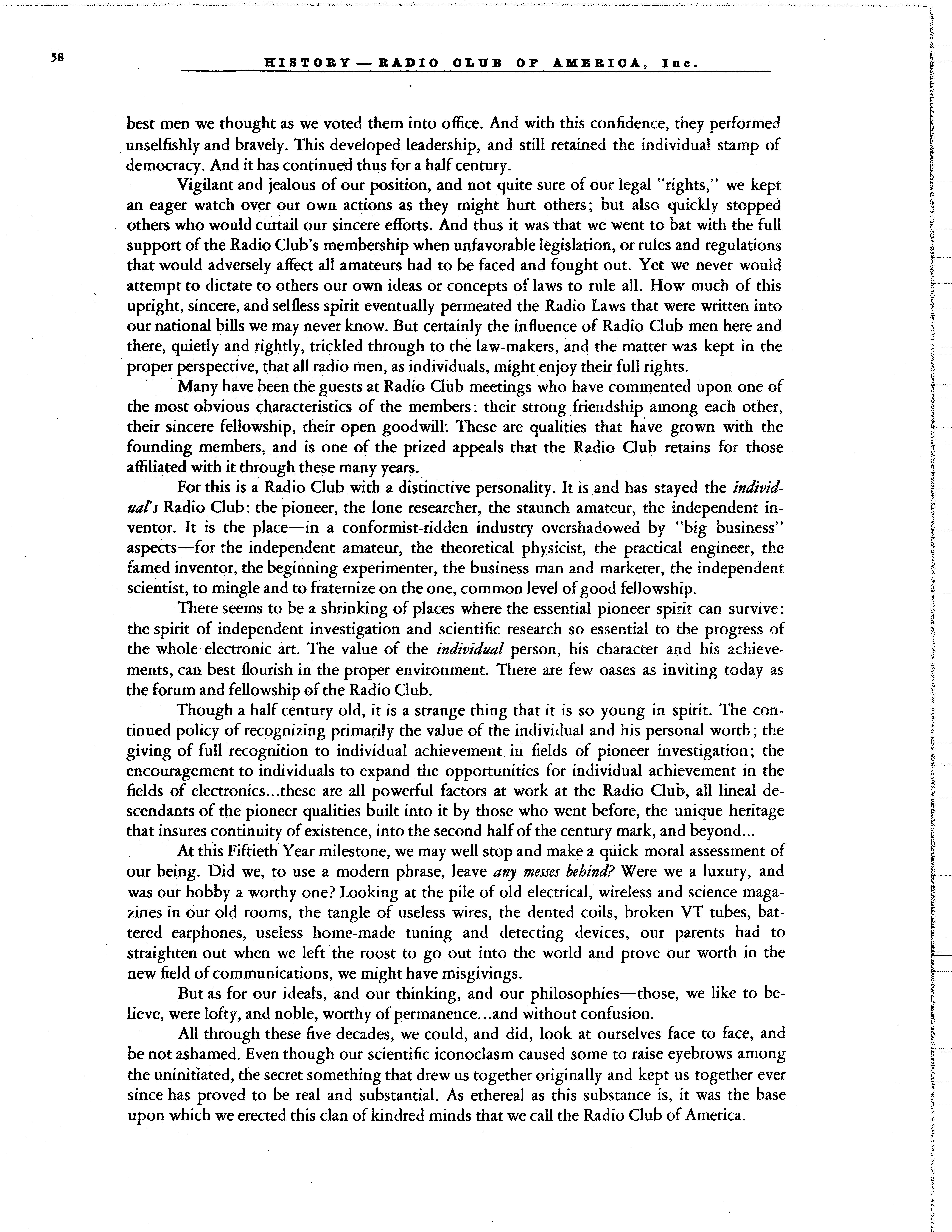

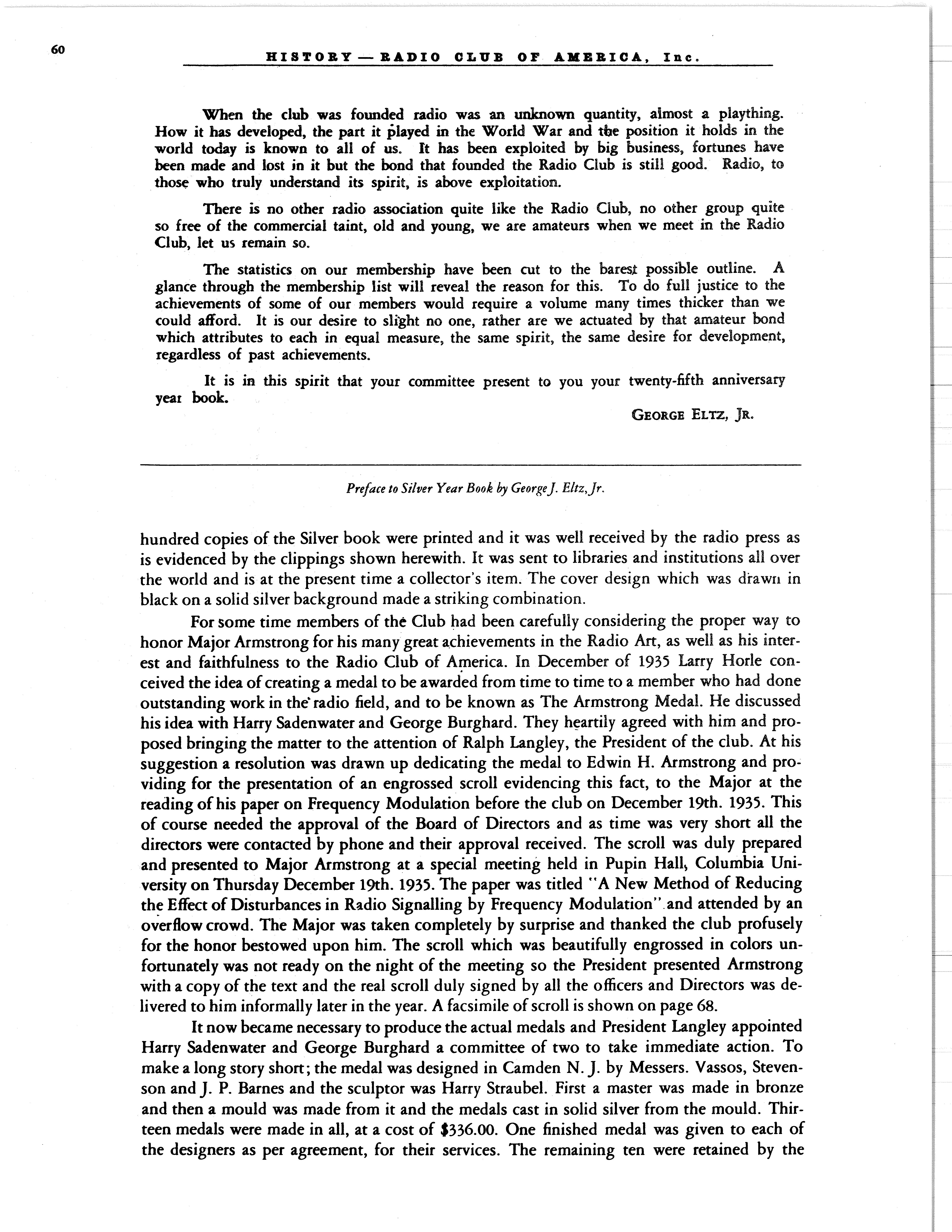

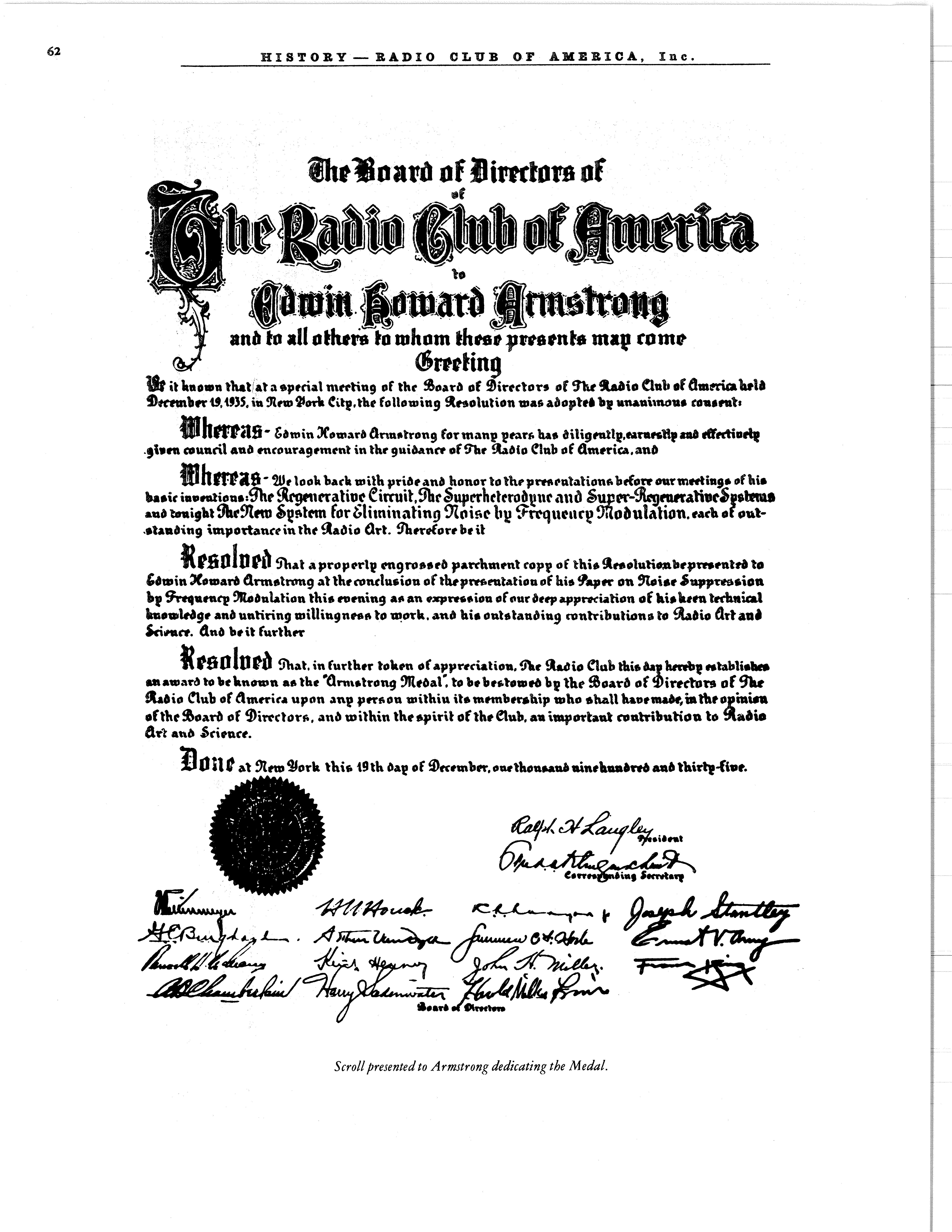
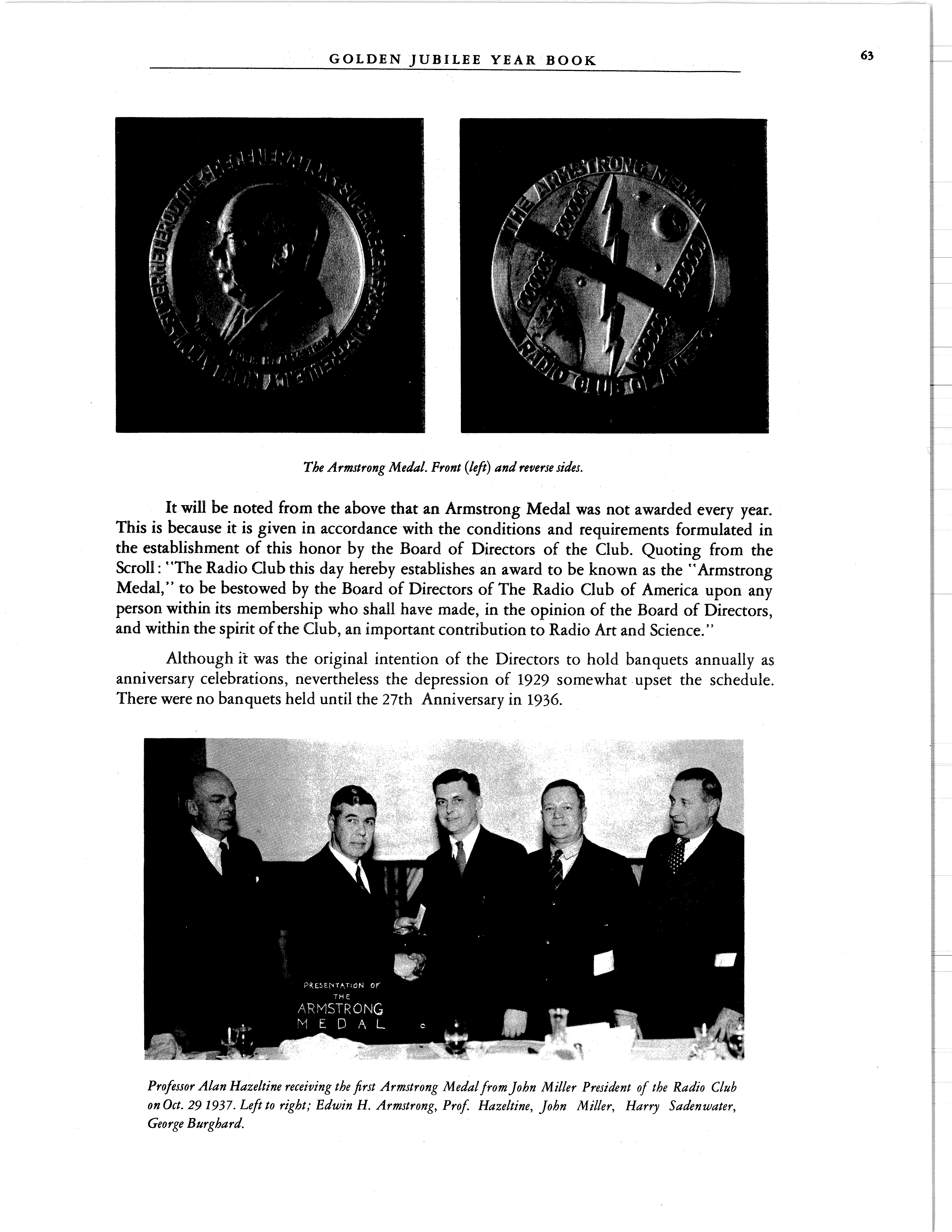
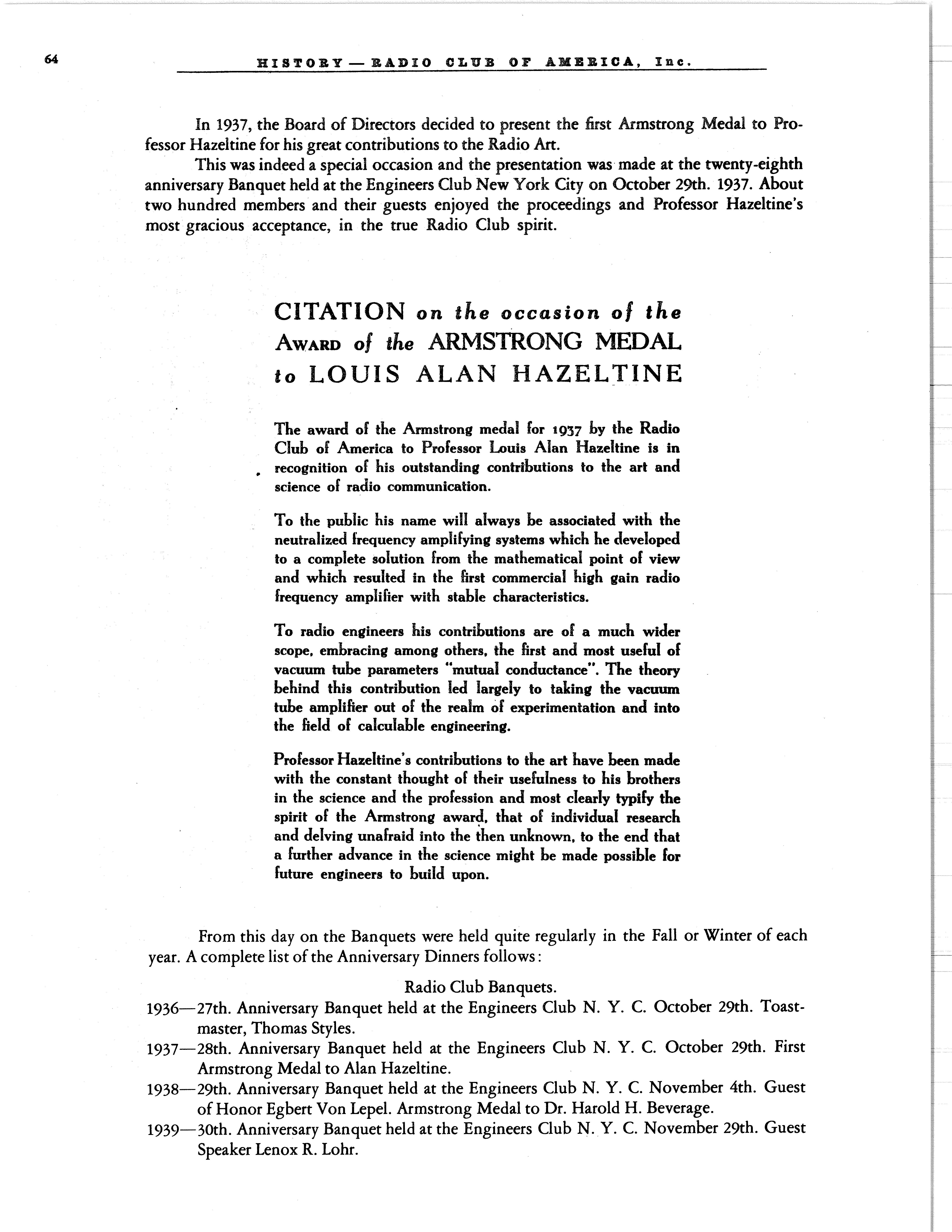
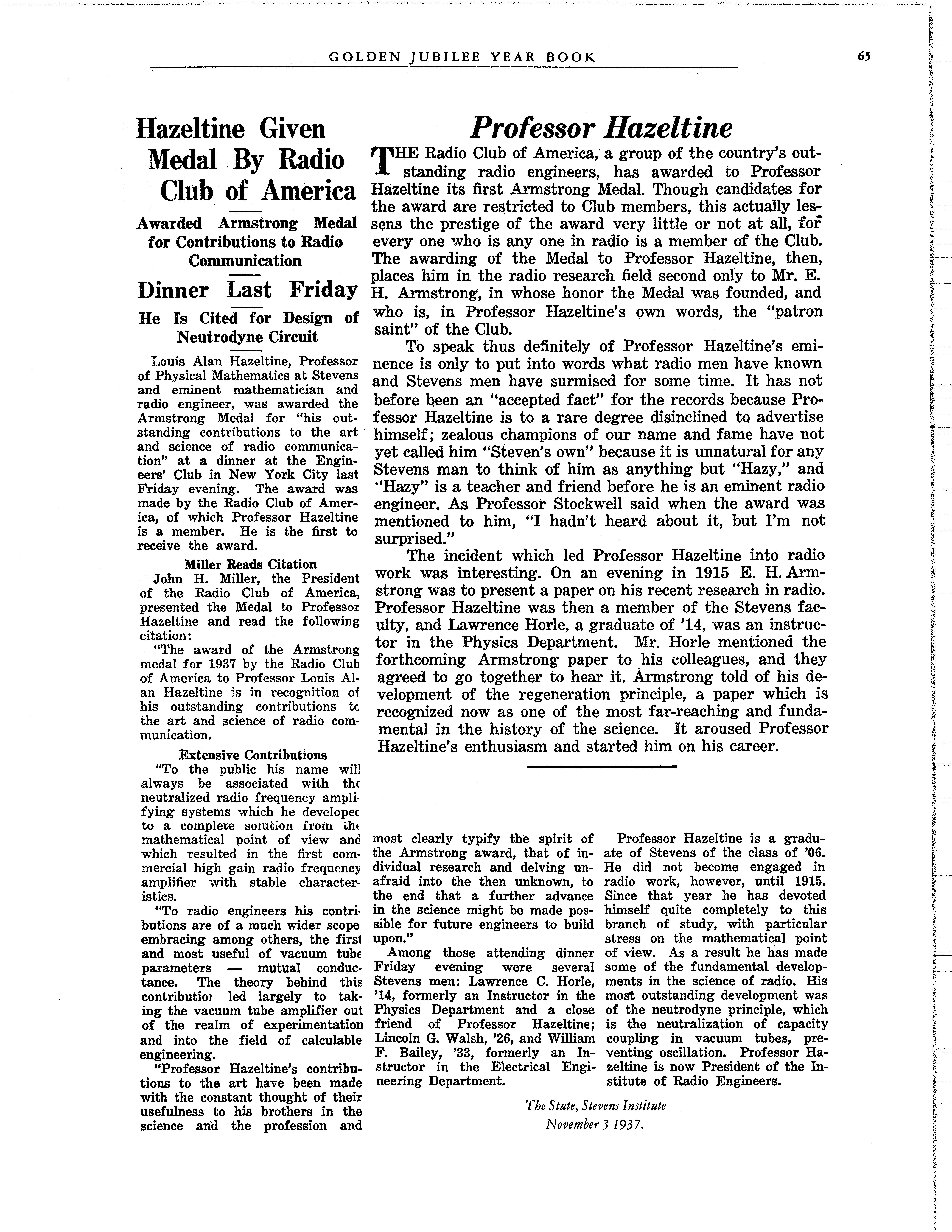
 Harold H Beverage
Harold H Beverage
